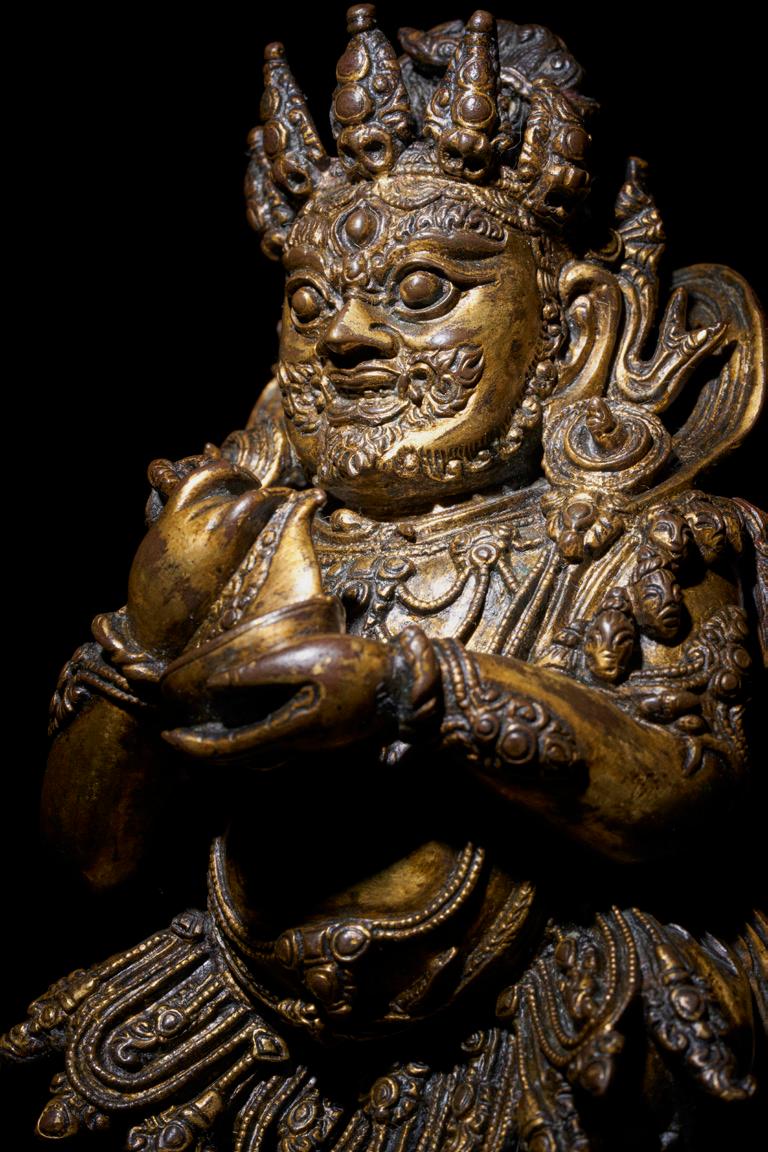

Important Chinese & Asian Art
02.11.2025, 11am
春和景明-重要中國與亞洲藝術
Part I (lots 1 – 294)
Part II (lots 295– 449)
Timed Online Auction Ends 03.11.2025, 2pm
Please note there will be a 30 minute intermission after Lot 124
thu 30 oct – sat 1 nov 2 Oxley Road, Hawthorn, VIC 3122
Please refer to our website for viewing times — leonardjoel.com.au
CONTACTS
luke guan
head of asian art 0455 891 888 luke.guan@ leonardjoel.com.au
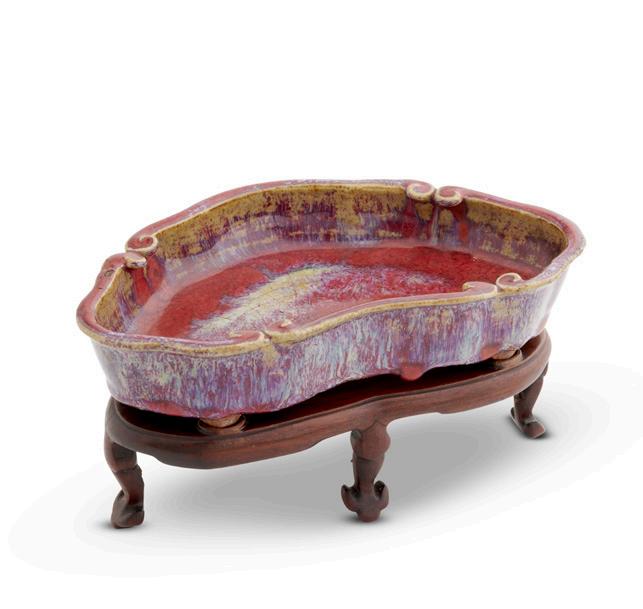
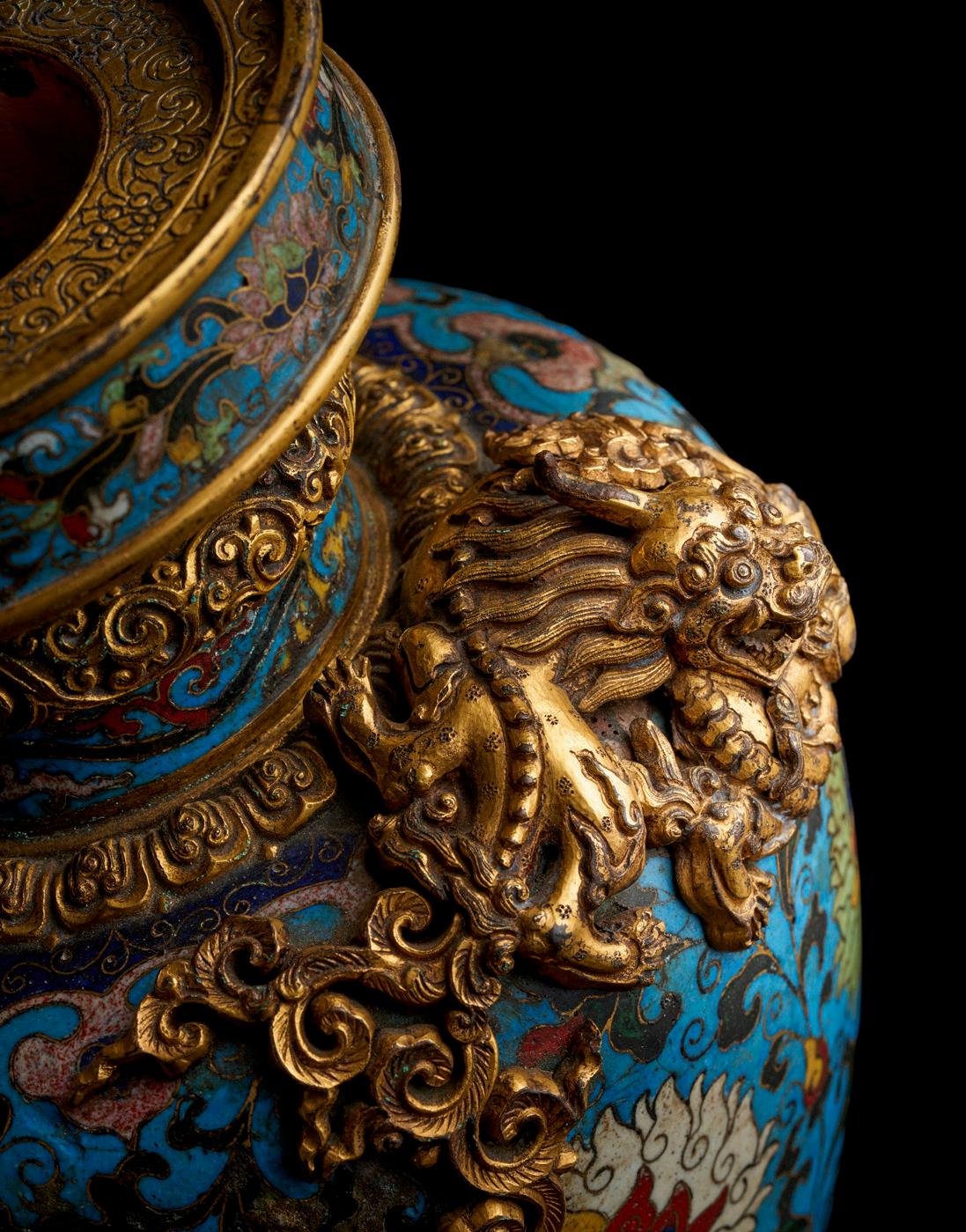
Important Chinese and Asian Art
Once again, it is the season of blossoms — and with it, we welcome the most exciting Important Chinese and Asian Art Auction of this year.
In the first session of this major sale (LOT 1–294), two notable single-owner collections stand out: the porcelain legacy collection of Ronald Melville Scott (1886–1968), a prominent figure from a distinguished family in South Australia (LOT 18–24), and the important jade collection from the estate of renowned Hong Kong architect Kwok, Thomas Wai Yan (LOT 187–201). We have carefully studied both collectors’ backgrounds and the structure of their collections, and we hope that as you browse through the catalogue, you will gain a sense of the discernment and vision of the serious Asian art collectors active in the 1980s — a golden era filled with opportunities and the allure of collecting.
Also noteworthy is the collection of Ming and Qing porcelain (LOT 1–17), acquired by a distinguished Melbourne gentleman during the late 1980s. All of these pieces will be offered with no reserve, presenting an exceptional opportunity for collectors.
The Himalayan Art section (Lots 80–97), introduced by Dr. David Templeman, Himalayan art scholar at Monash University, showcases a curated selection of important sculptures from Tibet, Nepal, and Gandhara. Of particular note is LOT 84, a finely crafted and powerfully expressive Pañjara Mahakala, which exemplifies the technical and artistic heights of Tibetan Buddhist sculpture. This section represents the highest calibre of Buddhist art ever presented by LEONARD JOEL and deserves close attention.
In addition, this sale features a strong selection across several key categories, including Ming and Qing porcelain, early ceramics, imperial court objects, and scholar’s studio pieces. Highlights include: lot 52 A Chinese flambé glazed ruyi-form brush washer, 18th century, was exhibited and published by Sydney L. Moss, London in 1974. lot 49 A rare celadon-glazed double-gourd vase, Qianlong mark and period (1736–1795); lot 70 A fine and important bronze tapir-form vessel xizun, Qianlong period (1736–1795); lot 75 A fine lapis lazuli vase, Qianlong period (1736–1795); lot 78 A fine cloisonné dragon-handled vase zun, Late Ming/Early Qing, 17th century; lot 112 A very rare xing white glazed jar and cover, Hanlin mark, Tang dynasty, 10th century; lot 158A A rare and important white porcelain moon jar, Joseon dynasty, 17th/18th century; lot 175 A rare painted conical bowl, jizhou ware, Southern Song dynasty (1127–1279).
One particularly remarkable highlight is a group of twenty fine pieces of classical Chinese furniture and scholar’s objects (LOT 237–256), consigned from a major private collection in Canberra. Exquisite in craftsmanship and form, these pieces offer a rare glimpse into the refined aesthetics of traditional Chinese halls and studios — showcasing ingenious joinery and masterful artisanship.
The second part of this major sale, “Asian Art Spring Edit” (LOT 295–449), will be held as an online-only session. This section presents a wider and more playful array of objects, including snuff bottles, antique accessories, tea and incense implements, and much more. We warmly welcome and thank you all for your enthusiastic participation!
又是一年繁花之時,我们也将如期迎来亚洲艺术年度最精彩的一场拍卖。
在本次大拍的第一部分「春和景明」(LOT 1-294)之中,南澳显赫家族 Ronald Melville Scott (1886–1968)瓷器遗产收藏 (LOT 18-24)和 香港著名建筑师 Kwok, Thomas Wai Yan (郭偉仁)重要玉器遗产收藏(LOT 187-201)是两个值得重視的单一 藏家板块。我们对藏家的经历和藏品体系都做了详细的梳理,希望大家可以从图录的浏览中,真正感受到曾经活跃于80年代的亞洲 藝術收藏家們的慧眼和見解,感受到那個藝術品收藏黃金年代的機遇和魅力。同樣值得關注的是本場拍賣(LOT 1-17)明清瓷器收 藏,來自墨爾本的一位傑出紳士購藏於80年代晚期。此部分拍品將全部無底價釋出。
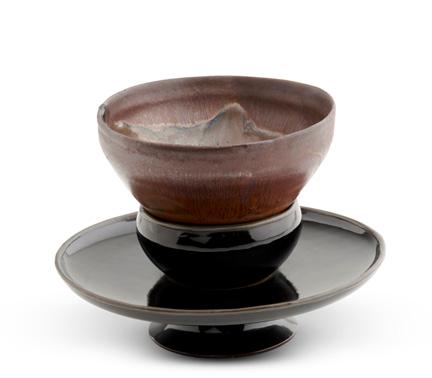
本次大拍的喜馬拉雅藝術板塊(LOT 80-97),由Monash University教授Dr David Templemen撰序,為大家選取了涵蓋西藏,尼 泊爾,犍陀羅等一系列重要造像藝術,其中LOT 84 大黑天Pañjara Mahakala製作複雜精美,怒目非凡,其藝術造詣展現出西藏佛 造像的巔峰技藝。此板塊呈現了LEONARD JOEL歷年來佛教藝術的最高品質,值得大家重點關注。
另外,此次大拍在明清瓷器,高古瓷器,宮廷陳設,文房雅玩部分均甄選了相當數量的重要拍品,包括LOT 52 清 十八世紀 窯變釉 如意式筆洗擁有倫敦著名古董商Sydney L. Moss 1974年展覽與出版的記錄;LOT 49 乾隆款及本朝豆青釉葫蘆瓶,LOT 78明末掐絲 琺瑯龍柄尊,LOT 112 “翰林”/“盈”字款唐邢窯白釉罐,LOT 70 清乾隆銅犀尊, LOT 158A 韓國朝鮮王朝17/18世紀月亮罐,LOT 175 ”月影梅“吉州窯大斗笠盞,LOT 75 清乾隆官造青金石仿古賞瓶等。
特別值得一提的是本場大拍徵集到堪培拉重要單一藏家釋出的精美中國古典家具及文房二十件(LOT 237-256),美輪美奐,可一窺 中式廳堂與書房之美,榫卯精妙,匠心深蘊。
本次大拍的第二部分「芳菲雅集」 (LOT 295-449)為線上競拍場次(Online Only)。此部分甄選了包括鼻煙壺,古代配飾,茶道 具/香道具等等更廣泛而有趣的諸多品類, 歡迎並感謝大家的積極參與! luke guan
head of asian art
Property of a distinguished gentleman, VIC., acquired in the late 1980s.
lots 1 – 17
*This section will be offered no reserves.
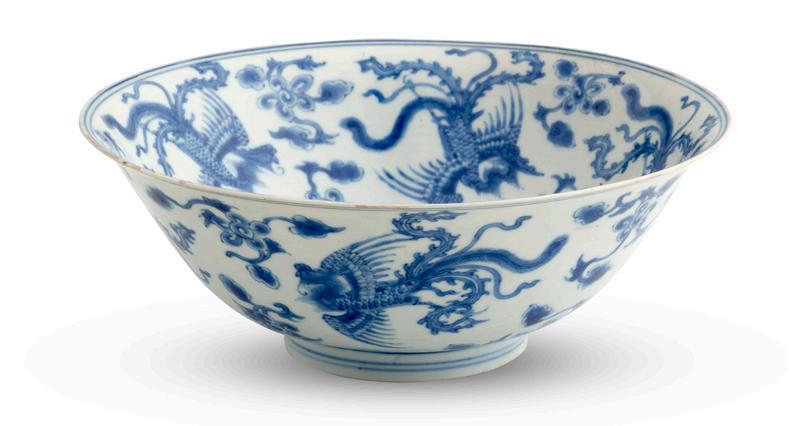

1 A CHINESE BLUE AND WHITE DISH, KANGXI SIX-CHARACTER MARK AND OF THE PERIOD (1662-1722)
20.7cm diameter
$800-1,200
清 「大清康熙年製」六字青花款及本朝 青花盤 此拍品不設底價。
2 A CHINESE BLUE AND WHITE PHOENIX BOWL, KANGXI PERIOD (1662-1722)
Finely painted to the interior with five phoenixes in flight, the exterior further decorated with four phoenixes, the base bearing an apocryphal Chenghua mark.
21.5cm diameter
$1,000-2,000
清康熙 青花鳳紋盌
盌內精繪五隻飛翔鳳凰,外壁飾四隻鳳凰,底部書 仿成化款。
此拍品不設底價。
3 A CHINESE BLUE AND WHITE VASE, KANGXI PERIOD (1662 - 1722)
19cm diameter
$800-1,200
清康熙 青花圖花紋瓶 此拍品不設底價。
4 A CHINESE BLUE AND WHITE ‘HUNDRED BOYS’ JAR, KANGXI PERIOD (1662-1722) With a hardwood cover.
A very similar blue and white ‘hundred boys’ jar is in the Franz Mayer Collection, Mexico City, USA.; also see a similar jar sold at Christie’s New York, 21 Mar. 2025, lot 1092.
34.5cm high
$3,000-5,000
清康熙 「百子圖」青花罐 附紅木蓋
此拍品不設底價。
類似青花百子圖罐藏於墨西哥城美國法蘭茲 梅耶 收藏;另見佳士得紐約,2025年3月21日,第1092 號拍品。
5 A PAIR OF CHINESE BLUE AND WHITE VASES, SHUNZHI PERIOD (1644-1661)
19.5cm high
$800-1,200
清順治 青花瓶一對
此拍品不設底價。
6 A CHINESE SOFT PASTE BLUE AND WHITE JAR AND COVER, KANGXI MARK, QING DYNASTY (1644 - 1911)
8.5cm high
$400-600
清 康熙款 漿胎青花蓋罐 此拍品不設保留價。
7 A CHINESE BLUE AND WHITE ‘BOYS’ JAR, QING DYNASTY, 17TH/18TH CENTURY 23cm high
$600-800
清 十七/十八世紀 「嬰戲圖」青花罐 此拍品不設保留價。
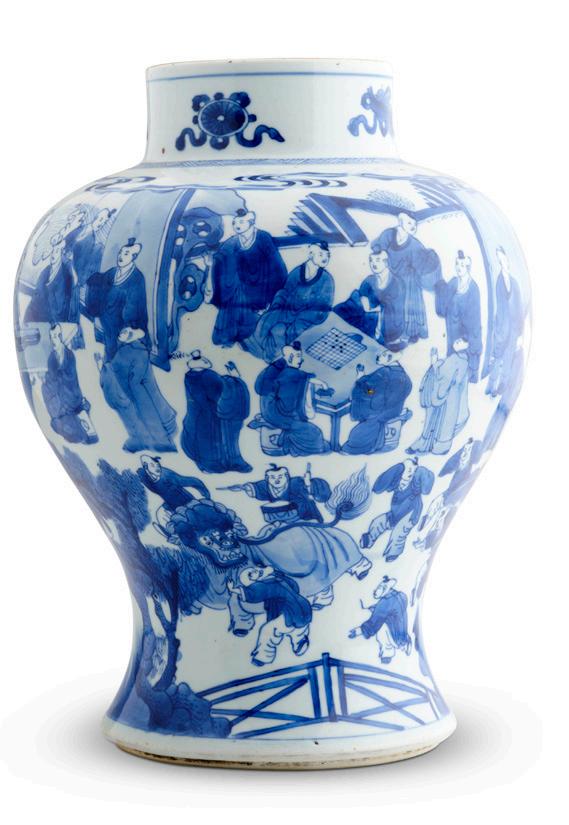


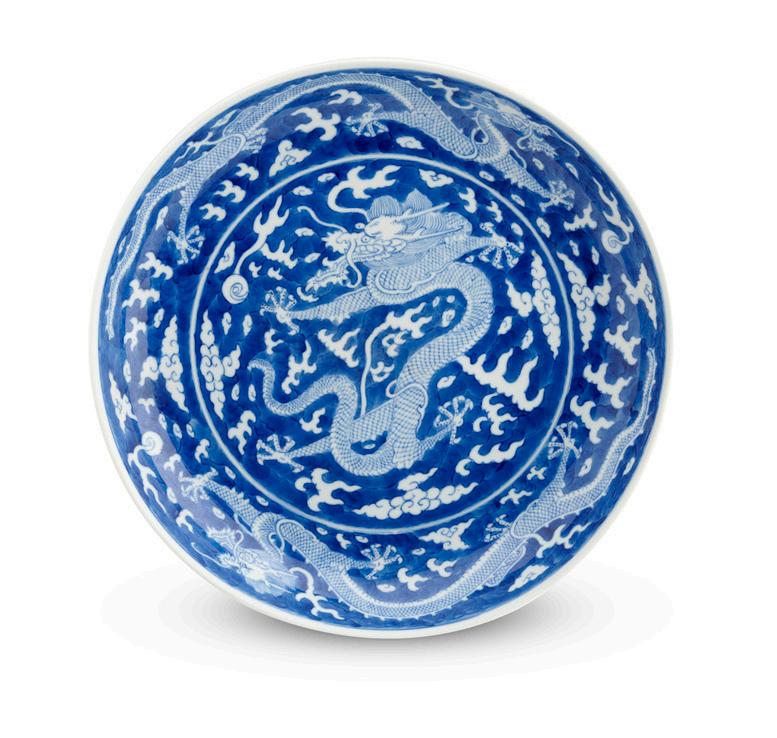
8 A CHINESE BLUE AND WHTIE ‘DRAGON’ DISH, TONGZHI UNDERGLAZE BLUE SIXCHARACTER MARK AND OF THE PERIOD (1862-74)
The interior dish centrally painted with a five-clawed dragon in pursuit of a flaming pearl amidst stylised clouds and flames, encircled by two similar dragons, the underside similarly painted above a band of lappets.
An almost identical dish see Bonhams London, 8 Nov. 2012, lot 55. 25.3cm diameter
$1,500-2,500
清 「大清同治年製」青花六字款及本朝 青花龍紋盤 盤心繪五爪龍戲火珠,周圍環繞兩條相似龍紋,盤 底亦繪龍紋並飾蓮瓣紋一周。
幾乎相同之拍品見邦瀚斯倫敦,2012年11月8日,第 55號拍品。
此拍品不設底價。
9 A CHINESE YELLOW-GROUND GREENENAMELLED ‘DRAGON’ BOWL, DAOGUANG SIX-CHARACTER SEAL MARK IN UNDERGLAZE BLUE AND OF THE PERIOD (1821-1850)
An almost identical dragon bowl from the same period, see Sotheby’s Hong Kong, 26th Nov., 2023, lot 920.
10cm diameter
$1,500-2,500
清 「大清道光年製」青花六字款及本朝 黃地綠彩 龍紋盌
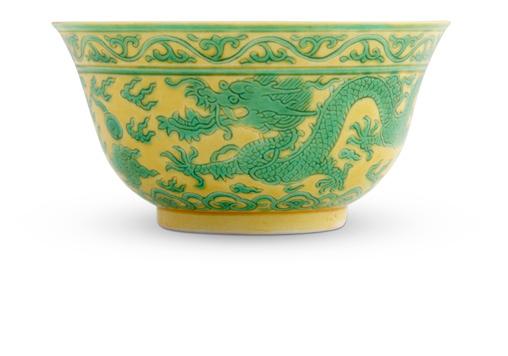

盌身黃釉地綠彩繪五爪龍紋,底書「大清道光年 製」青花六字款。另見一件幾乎相同之拍品,2023 年11月26日於香港蘇富比拍賣,拍品920。 此拍品不設底價。
10
A CHINESE CARVED LONGQUAN CELADON ‘FLORAL’ BOWL, NORTHERN SONG DYNASTY (960 - 1279)
19cm diameter
$800-1,200
北宋 龍泉窯青釉刻花盌 此拍品不設底價。
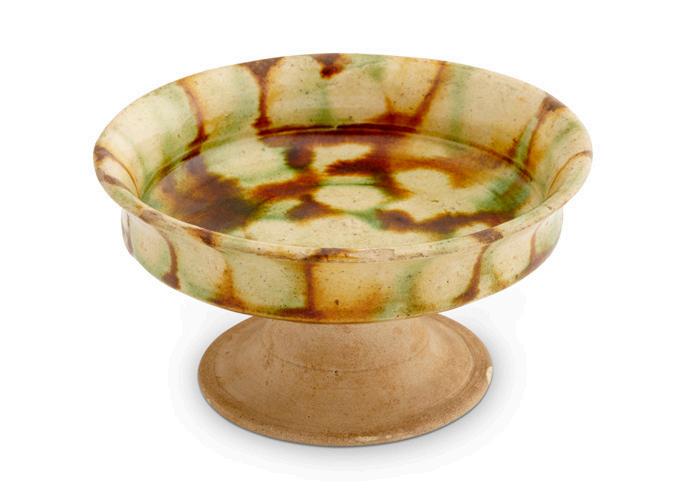
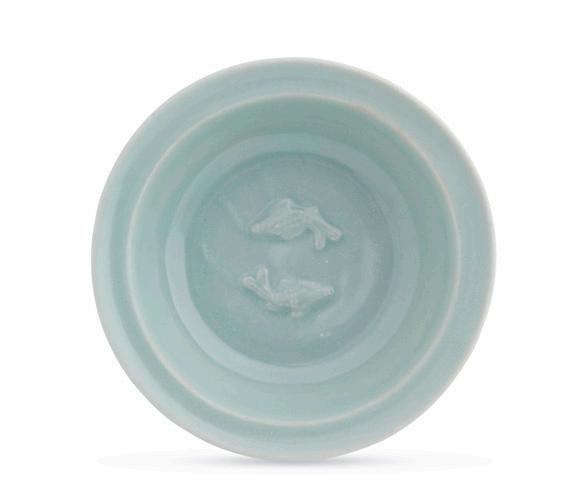
11
A CHINESE SANCAI-GLAZED BUFF POTTERY PEDESTAL DISH, TANG DYNASTY (618 - 907)
The circular dish with everted rim splashed with green, amber and cream glaze, supported on an unglazed pedestal foot.
12cm diameter
provenance
Bluett and Sons, London (label).
$1,000-2,000
*This lot will be offered no reserve.
唐 三彩高足盛盤 此拍品不設底價。
源流:
倫敦知名古董商Bluett and Sons (底部標籤)。
12 A SMALL CHINESE LONGQUAN CELADON BALUSTER JAR AND COVER, YUAN/MING DYNASTY, 14TH/15TH CENTURY
Similar small jar see Christie’s New York, 20 Sep. 2013, lot 1491.
12cm high
$1,000-2,000
元/明 龍泉窯青釉小罐連蓋 罐呈小型鼓腹式,配蓋,施青釉,釉色均勻。另見 相似拍品,2013年9月20日於紐約佳士得拍賣,拍 品1491。 此拍品不設底價。
13
TWO JIZHOU DARK GLAZE ‘MOON AND PRUNUS’ TEA BOWLS, SONG DYNASTY (960 - 1279)
11.2cm diameter and 11cm diameter
$1,500-2,500
宋 吉州窯黑釉「月影梅花」茶盌 一組二件 一組二件,盌身施暗釉,釉面呈現「月影梅花」圖 案,風格典雅。 此拍品不設底價。
14 A CHINESE LONGQUAN CELADON “KINUTA” DOUBLE FISH WASHER, SOUTHERN SONG DYNASTY (1127 - 1279)
13cm diameter
$1,000-2,000
南宋 龍泉窯粉青釉雙魚洗 此拍品不設底價。
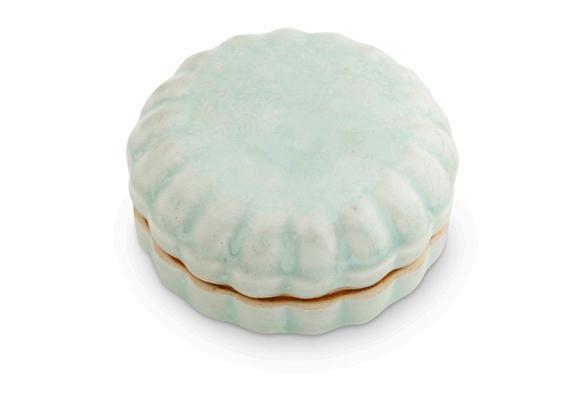
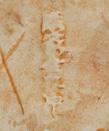
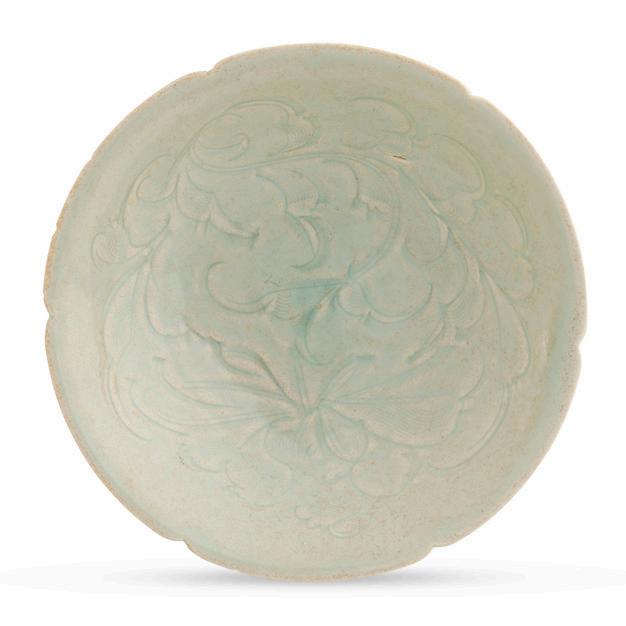
15
A CHINESE SMALL QINGBAI ‘FLORAL’ LOBED BOX AND COVER, SOUTHERN SONG DYNASTY (1127 - 1279)
The base has a moulded studio mark. 7cm diameter
$1,000-2,000
南宋 青白釉菊瓣盖盒 此拍品不設底價。
16
A CHINESE JUN BOWL TOGETHER WITH A JUN DISH, YUAN DYNASTY (1271- 1368) 15.5cm diameter (bowl); and 14.5cm diameter (dish)
$1,500-2,500
元 鈞窯盌及盤 一組 此拍品不設底價。
17
A CHINESE FOLIATE RIM CARVED QINGBAI ‘LOTUS’ DISH, SOUTHERN SONG DYNASTY (1127 - 1279)
A similar bowl sold at Christie’s New York, 22 Mar. 2024, lot 929. 20cm diameter
$1,500-2,500
南宋 青白釉刻蓮紋花口盤 盤口呈花瓣形,盤心刻蓮花紋,釉色青白清潤。另 見一件相似拍品,2024年3月22日於紐約佳士得拍 賣,拍品929。 此拍品不設底價。
Estate of Ronald M. Scott, and hence by descent
lots 18 – 24
Ronald Melville Scott (1886 – 1968) was a civil engineer who during World War I served in France in the First Field Company, Australian Engineers. He was Adelaide City Engineer (1924 – 1929) and then Melbourne City Engineer (1929 – 1931). In 1933 he was a founding partner of engineering consulting firm Scott and Furphy. He enhanced his distinguished professional career with his love of fine art which saw him become a discerning collector of fine Asian porcelain.
罗纳德·斯科特(Ronald Scott)于1886年6月24日出生在南澳大利亚的科利奇帕克(College Park)。他是保罗(Paul Thomson Scott)和妻子克拉拉(娘家姓沃特豪斯,Clara Watchorn Scott nee Waterhouse)的儿子,曾在王子阿尔弗雷德学院(Prince Alfred College)接受教育。
1901年至1913年,罗纳德完成了阿德莱德大学(Adelaide University)理学,应用科学,工程学三个学位,并获得了南澳矿业学 院(South Australian School of Mines)的院士资格。1915年,罗纳德成为英国土木工程师学会(Institution of Civil Engineers) 的会员。1911年,罗纳德参与了阿德莱德港(Port Adelaide)的有轨电车信托电站(Tramways Trust Power Station)的工 程。1912年,他进入首席工程师署(Engineer in Chief’s Department),担任土木工程师。
1916年,罗纳德加入了澳大利亚帝国部队(AIF),远赴法国服役并在战斗中负伤,晋升为中尉(Lieutenant)。战后,他回到首 席工程师署,他于1921年被晋升为首席预算员(Chief Estimator)。1924年5月,他被任命为阿德莱德市政工程师(City Engineer, Adelaide)。1929年1月,他又被推举为墨尔本市政工程师(City Engineer, Melbourne)。1933年,他成为工程顾问公司Scott and Furphy的创始合伙人之一,从此开创了他自己的工程咨询商业版图。
然而,在严谨的图纸之外,斯科特对亚洲艺术,尤其是中国瓷器情有独钟。或许正是工程师对结构与工艺的敏感,使他在瓷器的胎 釉、纹饰与烧造技艺中,看见了东方艺术的精妙逻辑与诗意表达。
在那个资讯尚不发达的年代,斯科特以一种探索者的姿态,穿梭于拍卖行、古董商与私人藏家之间,是那个时代精英人物精神追求 的缩影,也让今天的我们,有幸得以一窥他所珍视的艺术遗产。
18
A CHINESE BLUE AND WHITE PLAQUE, QING DYNASTY, 17TH CENTURY With a fitted wood stand.
$1,000-2,000
清 十七世紀 青花瓷板 配木底座
19 A PAIR OF CHINESE WHITE GLAZE’ANHUA’ DRAGON BOWLS, HONGZHI MARK, QIANLONG PERIOD (1736 - 1795) 11cm diameter
$2,000-3,000
清乾隆 弘治款 白釉刻暗花龍紋盌 一對
20 A CHINESE INCISED BLUE, WHITE AND GREEN ENAMEL DRAGON BOWL, KANGXI MARK, MID QING DYNASTY, 18TH CENTURY 13.8cm diameter
$1,000-2,000
清中期 十八世紀 康熙款 青花白地綠彩龍紋盌
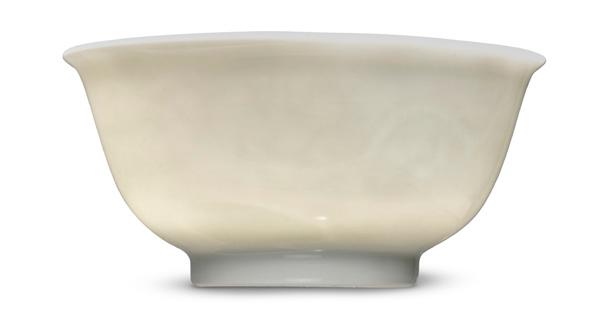

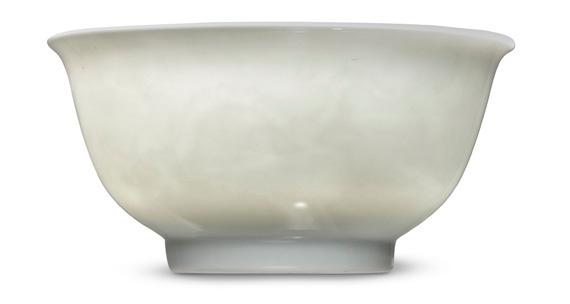



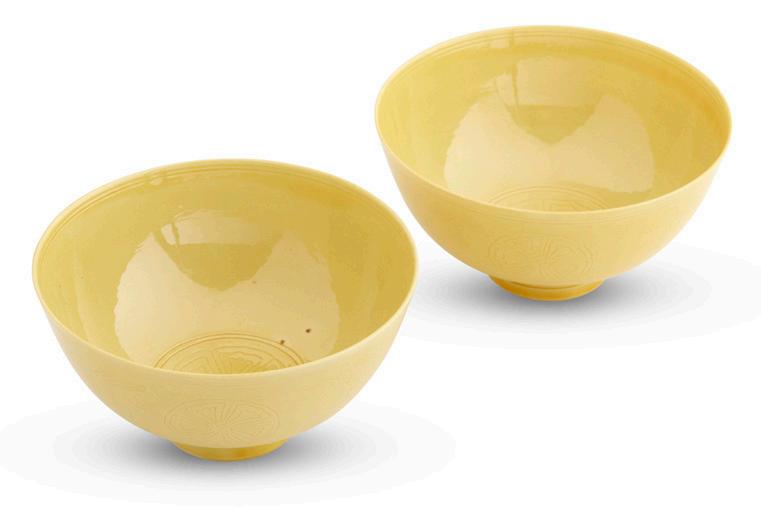

21
A PAIR OF YELLOW-GLAZED ‘MEDALLIONS’ BOWLS, KANGXI SIX-CHARACTER MARKS IN UNDERGLAZE BLUE WITHIN A DOUBLE CIRCLE AND OF THE PERIOD (1662-1722)
Each deep bowl is incised to the interior with a stylised floral medallion, and to the exterior with four medallions amid scrolling cloud motifs above a lappet border, all beneath a bright yellow glaze.
A closely related bowl is illustrated in R. Krahl and C. von Spee, Chinese Ceramics from the Gulexuan Collection, Germany, 2003, pp. 128–129, no. 97, and was previously sold at Christie’s London, 13 December 1976, lot 55. See also an almost identical bowl sold at Sotheby’s Hong Kong, 9 September 2025, lot 5104; another sold at Christie’s New York, 23 March 2023, lot 901; and a further example sold at Sotheby’s London, 15 June 2020, lot 18. An additional example is preserved in the Percival David Foundation and published in Illustrated Catalogue of Ming and Ch’ing Monochrome, London, 1973, no. A599. Bowls of this design continued to be produced into the Qianlong and Daoguang periods. 12cm diameter
$5,000-7,000
清康熙 「大清康熙年製」款及本朝 御製黃釉刻「 團花」紋盌 一對
盌內刻花卉團紋,外壁飾四組團花,間以雲紋及蓮 瓣紋,通體施明亮黃釉
類似器見 Krahl 與 von Spee 編《德國古樂軒收 藏中國陶瓷》, 2003 年,頁 128–129 ,編號 97 ;另見 1976 年 12 月 13 日倫敦佳士得拍賣,第 55 號 拍品; 2025 年 9 月 9 日香港蘇富比拍賣,第 5104 號; 2023 年 3 月 23 日紐約佳士得拍賣,第 901 號; 2020 年 6 月 15 日倫敦蘇富比拍賣,第 18 號;另 有一例藏於英國 Percival David 基金會,見《明清 單色釉圖錄》,倫敦, 1973 年,編號 A599 。此類 器形延續至乾隆及道光年間仍有製作。
22
A CHINESE CRACKLE-GLAZED BOTTLE VASE, QING DYNASTY, 18TH CENTURY 19cm high
$600-800
清 十八世紀 哥釉花瓶
23
A PAIR OF CHINESE BLUE AND WHITE CONICAL BOWLS, QING DYNASTY, SHUNZHI/KANGXI PERIOD, 17TH CENTURY 17.5cm diameter
$600-800
清順治/康熙 十七世紀 青花斗笠盌 一對
24
A CHINESE BLUE AND WHITE ‘SANDUO’ BOWL, TRANSITIONAL PERIOD, 17TH CENTURY
The base is with a “Yu” character square mark. 18cm diameter
$1,000-2,000
明末清初 「玉」字款 青花「三多」紋盌
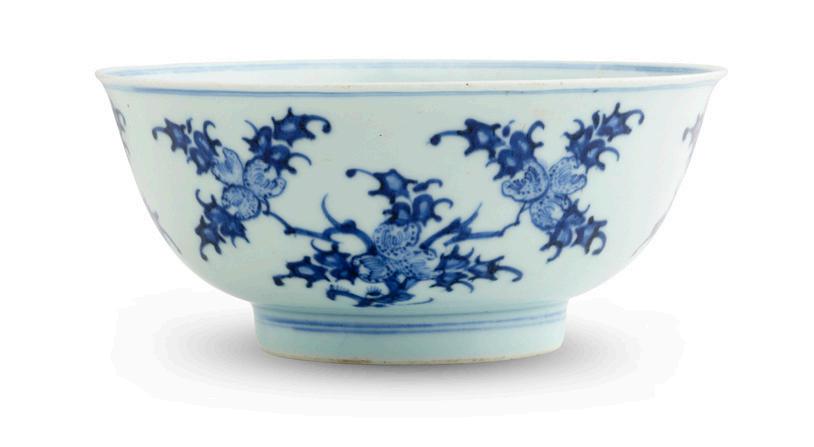

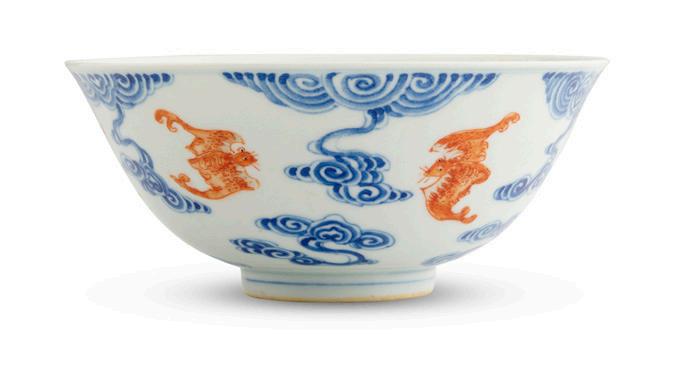

25
A CHINESE BLUE AND WHITE AND IRON RED DECORATED BOWL, XUANTONG MARK AND OF THE PERIOD XUANTONG SIXCHARACTER MARK AND OF THE PERIOD (1908-1911)
15.7cm diameter
$2,000-3,000
清 「大清宣統年製」款及本朝 青花礬紅 「蝙蝠祥 雲」紋盌
26
A CHINESE SANCAI ENAMEL CARVED BOX AND COVER, QING DYNASTY (1644 - 1911)
7.2cm diameter; 2.5cm high
$600-800
清 三彩雕瓷蓋盒
27
A WHITE GLAZED DOG, 18TH CENTURY 17cm wide; 10.2cm high
$1,000-2,000
十八世紀 白釉犬
28
A CHINESE FAMILLE ROSE TURQUOISE GROUND BRUSH POT, YONGZHENG MARK, LATE QING /REPUBLIC PERIOD, EARLY 20TH CENTURY 15cm high
provenance
Bernheimer Collection (label to the base).
$2,000-3,000
清末 / 民國初期 雍正款 粉彩松石綠地筆筒 源流: Bernheimer 收藏(底部標籤)。
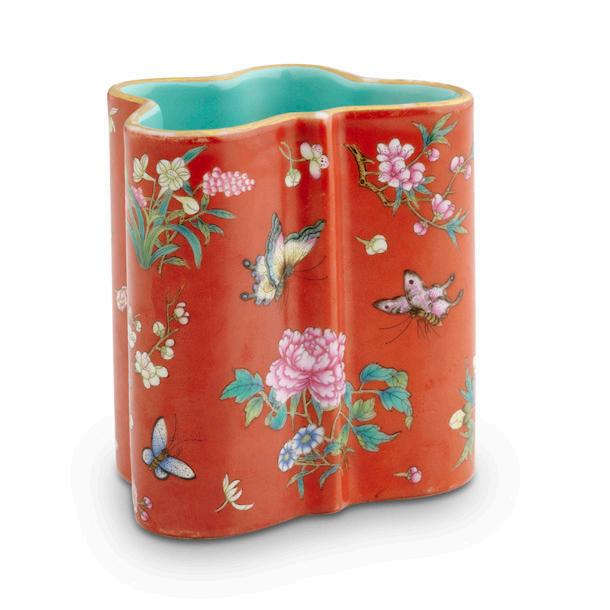

29 A CHINESE CARVED YELLOW GLAZED WASHER, SIGNED WANG BINRONG, QING DYNASTY, 19TH CENTURY
A similar washer, see Christie’s New York, 27 Mar. 2025, lot 60.
10cm long; 6.5cm wide; 4.5cm high
$800-1,200
清同治 「王炳榮款」黃釉浮雕馬槽洗
30
A CHINESE FAMILLE-ROSE ‘BIRDS AND FLOWERS’ BOWL, GUANGXU SIXCHARACTER IRON RED MARK AND OF THE PERIOD (1875 - 1908)
17.2cm diameter
$1,500-2,500
清 「大清光緒年製」款及本朝 粉彩花卉紋盌
31
A CHINESE RUBY RED GROUND FAMILLEROSE BUTTERFLY FORMED BRUSH POT, QIANLONG SIX-CHARACTER IRON RED SEAL MARK, LATE 19TH /EARLY 20TH CENTURY
8.5cm high
$1,000-2,000
清晚期/民国早期 「大清乾隆年製」款 珊瑚红地粉 彩「百蚨」笔筒
32 A CHINESE CRACKLE-GLAZED POMEGRANATE-FORM VASE, QIANLONG MARK, QING DYNASTY (1644 - 1911)
17.5cm high
$2,000-3,000
清 乾隆款 哥釉石榴瓶
33 A CHINESE FAMILLE-ROSE DISH, GUANGXU SIX-CHARACTER IRON RED MARK AND OF THE PERIOD (1875 - 1908)
18.8cm diameter
$1,000-2,000
34
A CHINESE MING-STYLE INCISED AND GREEN ENAMELLED “DRAGON” VASE, MEIPING, MID-QING DYNASTY, 17TH/18TH CENTURY
The vase is rising from a slightly flared foot to a high rounded shoulder, surmounted by a short neck and lipped rim, boldly incised and brightly enamelled in green with two pairs of dragons pursuing the flaming pearls, above two further dragons among scattered cloud scrolls, and with traces of lightly incised anhua decoration.
Compare to a similar vase dated to Kangxi period, see Christie’s Hong Kong, 3 Dec. 2021, lot 2940. Also see a similar vase dated to Qianlong period, see Christie’s London, 13 Nov. 2001, lot 132.
33.4cm high
provenance
An old private collection, acquired in the 90s. The base is with a Christie’s label, label number: MB23918.
$5,000-8,000
清 17 世紀/18 世紀 青花龙紋瓶
35 A CHINESE WHITE GLAZED MYTHICAL BEAST QINLIN, QING DYNASTY (1644 - 1911)
An impressed studio mark to the base, it’s with a fitted Zitan stand.
10.9cm high
$1,500-2,500
清 白釉麒麟摆件


36 A CHINESE BLUE GLAZED TRIPOD CENSER, MING DYNASTY, 16TH/17TH CENTURY 16cm high; 15cm diameter
provenance
The British Antique Dealers Association (label to the base).
Joshua McClelland Print Room, Carlton, VIC. The Estate of C. J. W. Farfor
A private collection, Melbourne.
$1,000-2,000
明 藍釉三足爐 源流: 英國古董商協會(底部標籤); 墨爾本Joshua McClelland 藝廊; C. J. W. Farfor 遺產; 墨爾本私人收藏。
37 A FINE CHINESE SLIP-DECORATED TURQUOISE-GLAZED VASE, QIANLONG MARK, QING DYNASTY (1644 – 1911) 27cm high
$2,000-3,000
清 乾隆款 松石綠釉瓶



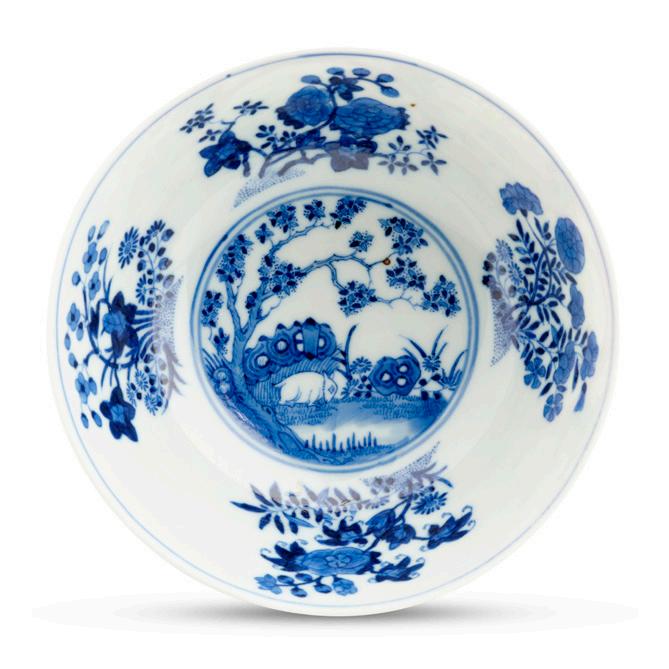
38
A CHINESE FAMILLE ROSE PINK-GROUND SGRAFFIATO ‘MEDALLION’ BOWL, DAOGUANG SIX-CHARACTER SEAL MARK IN UNDERGLAZE BLUE AND OF THE PERIOD (1821-1850)
The bowl is decorated on the exterior with four roundels, flanked by stylised floral sprays reserved on a bright pink sgraffito ground. The interior is decorated in underglaze blue with four floral groupings encircling a central medallion which contains a scene of a rabbit in a landscape of trees and rocks.
Similar examples see, Christie’s Hong Kong, 29 Nov 2024, lot 1318; Christie’s New York, 24 Sep 2021, lot 793.
15cm diameter
provenance
A private collection, Sydney, acquired from Allan Rae in the 90s.
$20,000-30,000
清「大清道光年製」青花篆書款及本朝 粉地粉彩軋 道開光花卉紋碗紋盌 源流: 悉尼私人收藏,1990年代購自 Allan Rae。
39
A PAIR OF CHINESE TURQUOISE GROUND FAMILLE-ROSE BOWLS, GUANGXU SIXCHARACTER IRON RED MARK AND OF THE PERIOD (1875 - 1908)
16cm diameter
$1,000-2,000
清 「大清光緒年製」六字紅彩楷書款及本朝 松石綠 釉粉彩宮碗
40 A CHINESE ROBIN’S EGG GLAZED ELEPHANT HANDLE VASE, QIANLONG MARK
15.9cm high
$2,000-3,000
清 乾隆款 青釉象耳瓶
41 A CHINESE BLUE GLAZED HIGH-FOOT CHILONG DRAGON FOLIATE RIM CUP, QING DYNASTY (1644 - 1911)
10cm high
$1,000-2,000
清 祭藍釉高足堆塑螭龍花口盃
42 A LARGE PAIR OF CHINESE WHITE GLAZED BOWLS, MING DYNASTY, 15TH/16TH CENTURY
51.2cm diameter; 25.8cm high
provenance
Sotheby’s label.
$6,000-8,000
明代 十五/十六世紀 白釉大盌一對 源流:蘇富比標籤
43 A CHINESE GE-GLAZED CENSER, POSSIBLY MING DYNASTY
With an old Japanese wood box and a Japanese silver cover.
14cm wide; 9cm high
$5,000-7,000
明或以後 哥釉香爐 配日製銀蓋及舊木盒
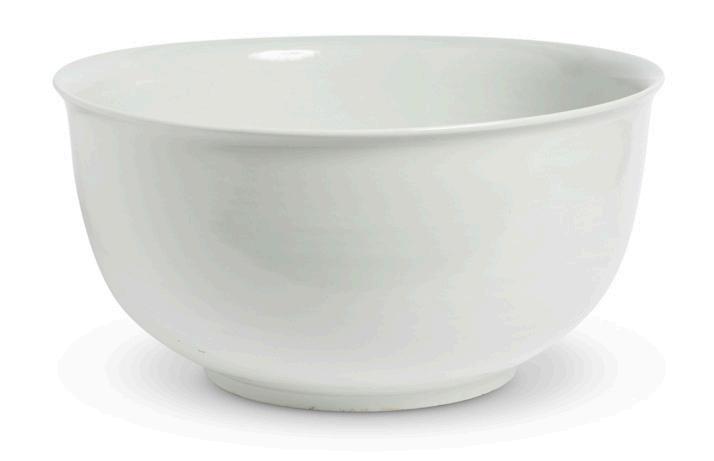
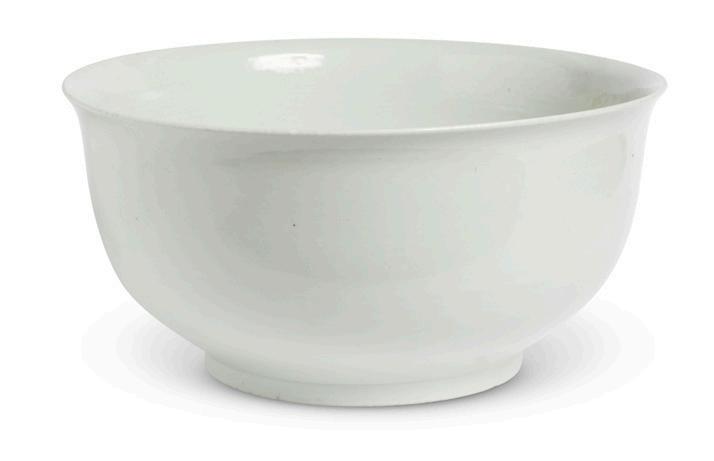
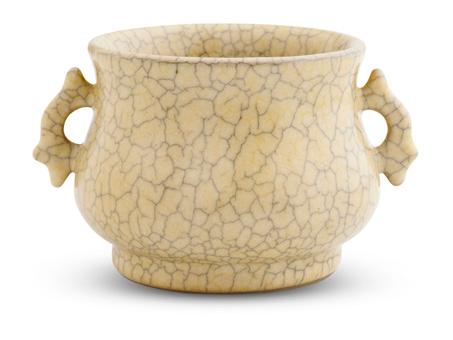


44
A CHINESE WHITE GLAZE WINE CUP, KANGXI SIX-CHARACTER MARK IN UNDERGLAZE BLUE WITHIN A DOUBLE CIRCLE AND OF THE PERIOD
The finely potted cup with steep rounded sides rising from a short foot ring, the interior finely decorated with four characters in underglaze blue. It’s with a Japanese wooden box.
A similar cup with fish decoration on the interior, see Bonhams London, 13 May 2010, lot 270. 6cm diameter; 4.3cm high
$2,500-3,500
清 康熙款及本朝 白釉盃
45 A CHINESE CRACKLE GLAZED AND COPPER RED DECORATED PEACH FORMED EWER, QIANLONG MARK
21cm wide. 16cm high
$3,000-5,000
清 乾隆款 冰裂紋紅彩桃形執壺
46
A CHINESE GE-GLAZED VASE, MING/QING DYNASTY
With an old Japanese wood box. 22cm high
$5,000-7,000
明/清 哥釉瓶
47
A CHINESE POWDER BLUE GLAZED WASHER, DAOGUANG SIX-CHARACTER UNDERGLAZE SEAL MARK, QING DYNASTY (1644 - 1911)
18cm diameter
$1,000-2,000
清 道光款 祭祀藍釉洗
48
A CHINESE CELADON GLAZED AMPHORA, QING DYNASTY (1644 - 1911)
35cm high
$2,000-3,000
清 天青釉雙龍尊
A RARE CHINESE CELADON-GLAZED DOUBLE-GOURD VASE, QIANLONG SEAL MARK IN UNDERGLAZE BLUE AND OF THE PERIOD (1735-1796)
The vase is finely potted with a compressed globular lower bulb rising from a countersunk base to a slightly smaller upper bulb, surmounted by a slender, elongated neck with narrow mouth. The vessel is evenly covered in a soft, translucent celadon glaze of attractive tone.
Double-gourd vases, also known as dajiping (“vase of great fortune”), carry auspicious symbolism, as the gourd is traditionally associated with fertility, abundance, and good fortune.
A closely related vase of the same size was included in the Exhibition of Qing Imperial Porcelain of the Kangxi, Yongzheng, Qianlong Reigns, The Chinese University of Hong Kong, 1995, no. 69. Further comparable examples are published in Chinese Porcelain: The S.C. Ko Tianminlou Collection, vol. I, Hong Kong, 1987, pl. 106; and in Qing Imperial Monochromes: The Zande Lou Collection, Hong Kong, 2005, p. 118, no. 42. A similar vase, preserved with its original small cover, from the Jingguantang Collection, was sold at Christie’s Hong Kong, 3 November 1996, lot 571, and again 28 October 2002, lot 723. Additional examples were sold at Christie’s Hong Kong, 31 May 2010, lot 2012; Christie’s New York, The Gordon Collection, 24 March 2011, lot 1135; and Christie’s Hong Kong, 28 May 2014, lot 3308.
The elegant form and soft glaze of the present vase, together with the aforementioned examples, appear to represent a Qing dynasty reinterpretation of earlier Longquan celadon double-gourd vases of the Song dynasty, such as the one illustrated in Mayuyama, Seventy Years, vol. I, Tokyo, 1976, p. 166, no. 484. 32.8cm high
provenance
A British private collection; inherited by the father of the present owner, possibly originally acquired by his mother in the late 19th/early 20th century. Bonhams London, 6 Nov., 2014, lot 184.
$35,000-55,000
清「乾隆年製」四字青花篆書款及本朝 豆青釉葫
蘆瓶
源流:
英國私人收藏;由前藏家其父親繼承,傳於19世紀
末或20世紀初由前藏家之祖母所得。
邦瀚斯倫敦,2014年11月6日,拍品編號184
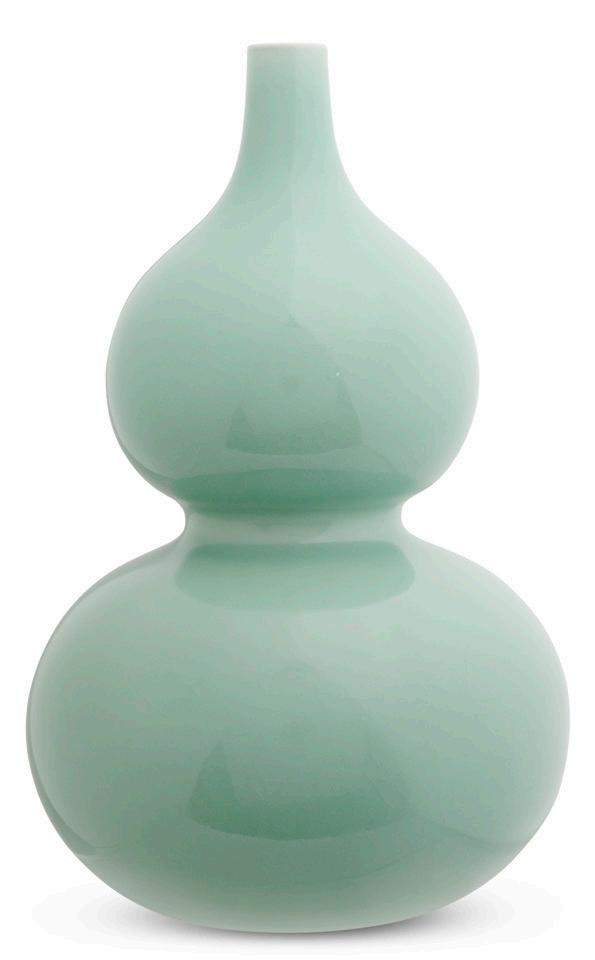


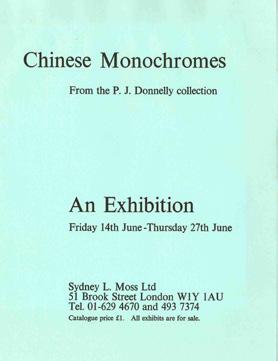

50
A CHINESE PEACH BLOSSOM GLAZE VASE, KANGXI MARK, GUANGXU PERIOD (18751908)
20.5cm
$800-1,200
清光緒 康熙款 豇豆紅釉柳葉瓶
51
A PAIR OF CHINESE APPLE GREEN GLAZED CUPS, YONGZHANG MARK, QING DYNASTY (1644 - 1911)
6.7cm diameter; 4cm high
provenance
A private collection, Sydney.
$4,000-6,000
「雍正年製」款 綠釉盃 一對
52
A CHINESE FLAMBÉ GLAZED RUYI FORM BRUSH WASHER, 18TH CENTURY
The washer is with moulded scrolling rim, decorated in a streaked red, cream and lavender glaze. It’s with a fitted carved hongmu stand. 20.5cm wide
provenance
P. J. Donnelly (1908-1978) Collection, London.
Sydney L. Moss, London, 1974.
Christie’s London, 19th June 2003, lot 241. Raymond and Victoria Tregaskis Oriental Art, Sydney.
exhibitions
London, Sydney L. Moss, Chinese Monochromes From the P. J. Donnelly Collection, 14th June - 27th June, 1974.
literature
Sydney L. Moss, Chinese Monochromes From the P. J. Donnelly Collection, An Exhibition, 14th June27th June, 1974, Plate 3.
$10,000-20,000
清 十八世紀 窯變釉如意式筆洗
源流:
P. J. Donnelly(1908–1978)舊藏,倫敦;Sydney L. Moss,倫敦,1974年;佳士得倫敦,2003年6月19 日,拍品編號241;Raymond and Victoria Tregaskis Oriental Art,悉尼。
展覽:
倫敦,Sydney L. Moss,《中國單色釉瓷器展》 ,1974年 出版: 《中國單色釉瓷器展》,圖版3。
53 A CHINESE GE-GLAZED VASE, QING DYNASTY (1644 - 1911)
$2,000-3,000
清 哥釉瓶
54 A PAIR OF CHINESE FAMILLE ROSE TURQUOISE GROUND HEXAGONAL FLOWERPOTS, POSSIBLY REPUBLIC PERIOD, EARLY 20TH CENTURY
18.8cm cm wide; 11.5cm high
$15,000-25,000
或為民國
松石綠地粉彩六角花盆 一對
A LARGE AND VERY FINE CHINESE FAMILLE-ROSE BALUSTER VASE, YONGZHENG MARK, REPUBLIC PERIOD, EARLY 20TH CENTURY
44cm high
provenance
From the Private Collection of the Late John Weller. John Weller was born in 1935, who was a passionate and discerning collector of furniture, art, and Chinese porcelain. Educated at Scotch College and later qualifying as an accountant with Dalgetys, John’s lifelong interest in the arts was sparked during an overseas trip in 1966, where he began acquiring European furniture and Chinese porcelain. Encouraged by his friend and neighbour, Mr. Kurt Albrecht, he developed his enthusiasm into a serious and sustained pursuit, combining the decorative with the scholarly.
Over the decades, John assembled a notable collection, sourcing pieces both from his travels abroad and from leading local antique dealers in Melbourne, with whom he maintained close friendships. His acquisitions were guided by a keen eye, curiosity, and a deep respect for craftsmanship and history. Alongside his collecting, John built an extensive library, reading widely for both knowledge and enjoyment, and enriching his understanding of art, culture, and civilisation.
A true student of the arts, John Weller’s collection reflects his dedication, connoisseurship, and delight in surrounding himself with objects of beauty and meaning.
Sotheby’s Melbourne, 27 & 28 May 2008, lot 82. $15,000-25,000
民國 「大清雍正年製」款 粉彩大瓶 瓶形碩大,施粉彩繪花卉紋飾,色彩柔和,底書「 大清雍正年製」款,為民國時期佳作。 源流:
出自已故約翰・威勒私人收藏
約翰・威勒(John Weller)生於1935年,是一位充滿 熱情且目光獨到的家具、藝術與中國瓷器收藏家。 他早年就讀於Scotch College,之後於Dalgetys取得 會計師資格。威勒對藝術的終生熱愛源於1966年的 一次海外旅行,當時他開始購藏歐洲家具與中國瓷 器。在其好友兼鄰居庫爾特・阿爾布雷希特(Kurt Albrecht)的鼓勵下,他逐步將興趣發展為嚴謹而持 久的追求,並在收藏中兼顧裝飾性與學術價值。 數十年間,威勒組建了一個頗具規模的收藏體系, 既有來自海外旅行的購藏,也有從墨爾本重要古董 商處所得之品,並與這些古董商保持著深厚情誼。
他的藏品均以敏銳的眼光、旺盛的好奇心以及對工 藝與歷史的深切尊重為指引。同時,威勒還建立了 龐大的圖書館,廣泛閱讀以增進知識與樂趣,進一 步深化其對藝術、文化與文明的理解。
作為真正的藝術探索者,約翰・威勒的收藏不僅體現 了其專注與鑑賞力,也展現了他對於以美與意義之 物環繞自身的由衷喜悅。
蘇富比墨爾本,2008年5月27–28日,拍品編號82。
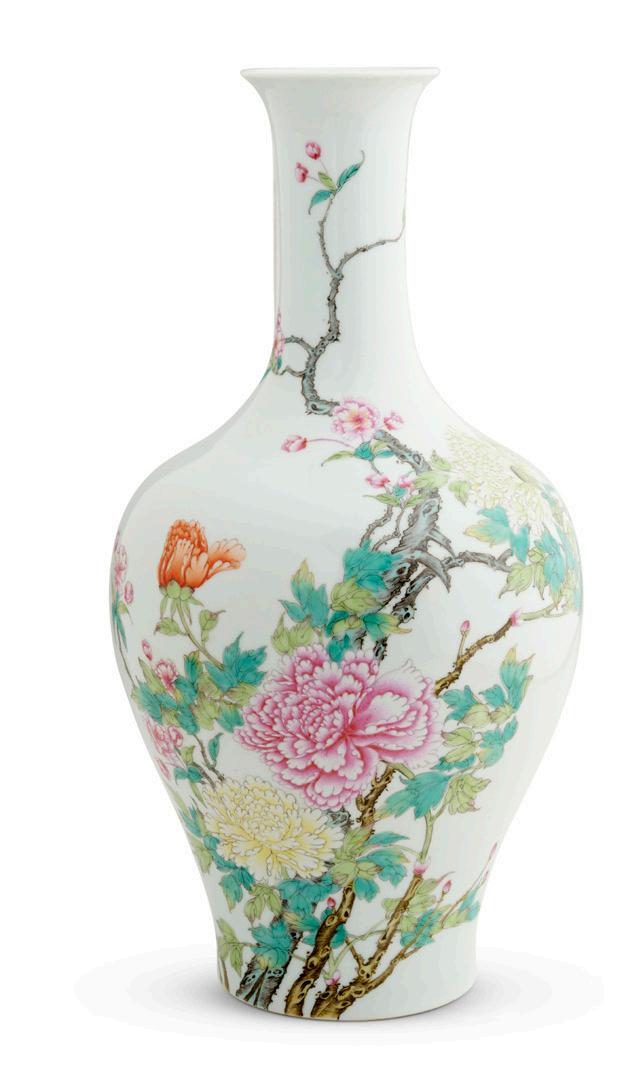

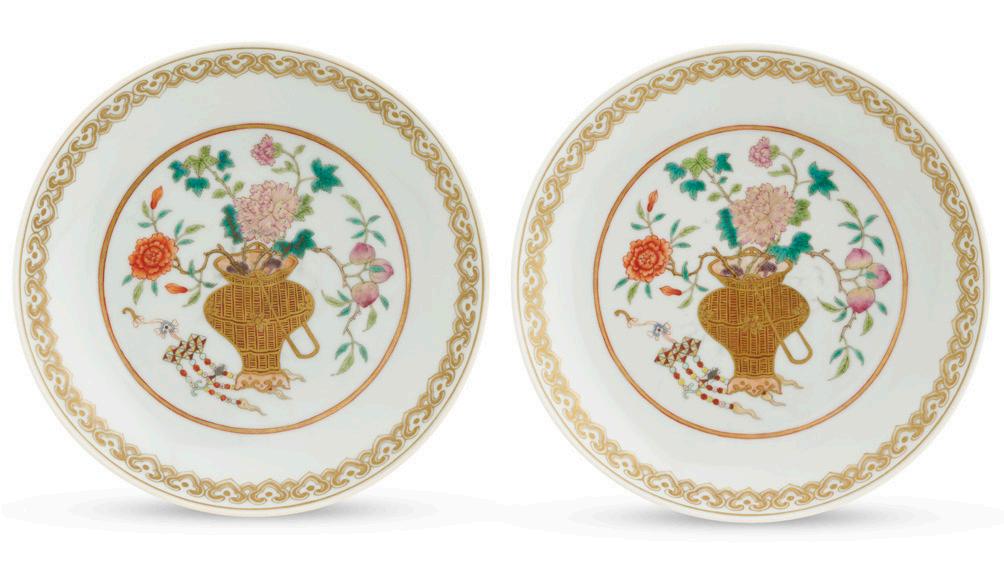


56
A CHINESE FAMILLE ROSE ‘HUNDRED BATS’ VASE, GUANGXU SIX-CHARACTER MARK IN IRON RED AND OF THE PERIOD (1875-1908)
The vase is decorated with a dense pattern of ironred bats in flight amidst multi-coloured ‘lingzhi’ clouds above a petal-lappet band on the globular body and below a ruyi band on the tall waisted neck, and with a band of lotus sprays alternating with gilt shou characters on the shoulder above a gilded relief border.
Similar examples, see Christie’s New York, 20 Sep. 2013, lot 1389 & 1390. Also see, Bonhams, London, 17 May 2012, lot 359.
39cm high
$2,000-3,000
清「大清光緒年製」款及本朝 粉彩「百福」紋瓶 瓶身密佈礬紅蝙蝠,飛翔於彩色靈芝雲間,球腹 下飾瓣紋,頸部上飾如意紋,下飾金彩壽字與蓮 花紋。
類似器見2013年9月20日紐約佳士得拍賣,第1389與 1390號拍品;另見2012年5月17日倫敦邦瀚斯拍賣, 第359號拍品
57 A CHINESE SMALL BLUE GLAZED CUP, QING DYNASTY (1644-1911) Hanqingzhai four-character underglaze blue mark on the base.
6cm high
$3,000-5,000
清 「涵清齋製」款 祭藍釉小盃
58 A PAIR OF CHINESE FAMILLE-ROSE ‘FLORAL’ DISHES, DAOGUANG SIX-CHARACTER SEAL MARKS IN IRON RED AND OF THE PERIOD (1821-1850)
Each dish is finely decorated with a central medallion enclosing a flower basket issuing leafy branches of peony, chrysanthemum and peaches, surrounded by a ruyi-head border below the rim, the exterior with iron-red bats in flight amidst colourful cloud scrolls. The pair is with a fitted box.
An almost identical pair sold at Bonhmas Hong Kong, 29 May 2024, lot 317. 15cm diameter
provenance
A private collection, SA. $7,000-9,000
清 「大清道光年製」六字礬紅款及本朝 粉彩描金花 卉紋盤 一對
盤心飾花籃,籃中盛開牡丹、菊花與壽桃,周圍繪 如意雲頭紋,盤外壁飾紅彩蝙蝠與彩雲紋。配原裝 盒。

59 A CHINESE FAMILLE ROSE VASE, BY WANG
QI (1884-1937)
Tao Zhai two character iron red studio mark on the base. With a fitted box and a fitted stand. 27cm high
$1,000-2,000
民國 王琦粉彩人物瓶 《陶齋》款 瓶身繪人物故事,底部書「陶齋」紅彩款,配原裝 盒及底座。王琦為「珠山八友」之一,擅長粉彩人 物,筆法細膩,色彩雅致。
60 A CHINESE FAMILLE ROSE VASE BY CHENG YITING EARLY 20TH CENTURY
The vase is finely decorated with bird and flowers, inscribed, signed and two red seals of Chen Yiting. The rounded red artist mark on the base. It’s with a fitted stand.
Cheng Yiting was a prominent porcelain painter active during the Republic period in China, renowned for his mastery of famille rose (fencai) enamels, especially in depictions of figures and court ladies. Known for his refined brushwork and soft, elegant palette, he skilfully incorporated traditional gongbi (meticulous) techniques into porcelain painting. His works often featured historical figures, ladies, and birds-and-flowers, frequently accompanied by poetic inscriptions that reflected a literati aesthetic. Although not always listed among the core members of the “Eight Friends of Zhushan”, Cheng is closely associated with the group and played a significant role—alongside artists such as Wang Qi, Wang Dafan, and He Xuren—in shaping the artistic excellence of Republican-era Jingdezhen porcelain. His works remain highly prized by collectors today. 25.5cm high
$5,000-7,000
民國 程意亭 粉彩花鳥詩文瓶 瓶身繪花鳥圖,筆法細膩,色彩柔雅,並題詩文, 署「程意亭」款,鈐二方紅印,底部亦有紅色圓形 印章。配原裝底座。
程意亭為民國時期著名粉彩瓷繪畫家,擅長人物與 仕女題材,尤精花鳥,筆法工整,色調雅致,常以 工筆技法入瓷繪,並配以文人詩句,風格高雅。雖 未列入「珠山八友」核心成員,然與王琦、王大 凡、何許人等齊名,對民國景德鎮粉彩藝術發展貢 獻卓著,作品深受藏家推崇。

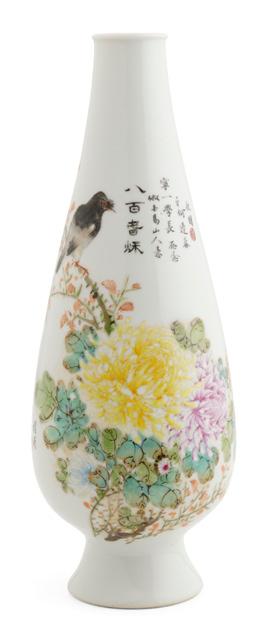




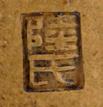
other notes
61
A SET OF CHINESE BAMBOO-FORM YIXING TEAPOT AND FOUR CUPS BY LU WENXIA (B. 1966)
The Teapot is modelled as a section of bamboo with a smaller section forming the spout and another section forming the large curved handle, with a small ladybug on the handle, the cover with a snail-form finial; the interior of the cover with two seals ‘Lu’ and ‘Wenxia zhi (Made by Wenxia)’, and the base with a single square seal ‘Lu Wenxia yin (Seal by Lu Wenxia).
A similar teapot by the same artist sold in the auction, see Christie’s New York, The Collection of Florance and Herbert Irving, 26 Mar. 2019, lot 22. Teapot: 19cm wide;18.3cm high
provenance
An important private collection, Melbourne.
Lu Wenxia, a female artist, was born in 1966 in Yixing, Jiangsu province. She began her career as a disciple of the Yixing pottery master Xu Xiutang (maker of lots 6 and 50). Lu respects the Yixing pottery-making traditions but also innovates in her presentation of classic subjects. She is known as a master of capturing details from daily life and objects. Her approach to imitating bamboo, one of the most common classical subjects within Chinese art, is unique and lively. Lu’s pieces depict the imperfections of the bamboo by recreating the natural wormholes and decay on the surface. Lu often adds a tiny ladybug onto the bamboo, positioned as if it is about to fly away, to represent the transience of time and life; this ladybug has become a signature of the artist. Some of her other naturalistic works are in the collection of Freer Gallery of Art and Arthur M. Sackler Gallery, Smithsonian Institution, Washington, D.C., Asian Art Museum, San Francisco. and in the collection of Ziguangge, Beijing.
$1,000-2,000
盧文霞
62
A SET OF BAMBOO-FORM YIXING TEAPOT AND TWO CUPS BY LU WENXIA (B. 1966)
One side of the teapot is incised with a landscape scene, while the reverse bears an inscription and the signature of Lu Wenxia. The base is impressed with a seal mark reading Lu Wen Xia Zhi Yin. The cover also bears two artist seals. The two accompanying cups are similarly decorated with landscape scenes and each bears a seal marks on the side and on the base.
Similar works by the same artist sold in the auction, see Christie’s New York, The Collection of Florance and Herbert Irving, 26 Mar. 2019, lot 37 and lot 66. 15.5cm wide; 11.8cm high
provenance
An important private collection, Melbourne.
other notes
Lu Wenxia, a female artist, was born in 1966 in Yixing, Jiangsu province. She began her career as a disciple of the Yixing pottery master Xu Xiutang (maker of lots 6 and 50). Lu respects the Yixing pottery-making traditions but also innovates in her presentation of classic subjects. She is known as a master of capturing details from daily life and objects. Her approach to imitating bamboo, one of the most common classical subjects within Chinese art, is unique and lively. Lu’s pieces depict the imperfections of the bamboo by recreating the natural wormholes and decay on the surface. Lu often adds a tiny ladybug onto the bamboo, positioned as if it is about to fly away, to represent the transience of time and life; this ladybug has become a signature of the artist. Some of her other naturalistic works are in the collection of Freer Gallery of Art and Arthur M. Sackler Gallery, Smithsonian Institution, Washington, D.C., Asian Art Museum, San Francisco, and in the collection of Ziguangge, Beijing.
$1,000-2,000
盧文霞
63
A CHINESE FRAMED FAMILLE-ROSE PORCELAIN PANEL, LATE QING/REPUBLIC
PERIOD, EARLY 20TH CENTURY
53.4 x 41.3cm
$600-800
晚清/民國 粉彩人物肖像瓷板畫
64
A CHINESE CLOISONNE ELEPHANT FEET TRIPOD CENSER, QIANLONG MARK, QING DYNASTY (1644 - 1911); 14.8cm high
$3,000-5,000
清 乾隆款 掐絲琺瑯三足象足爐
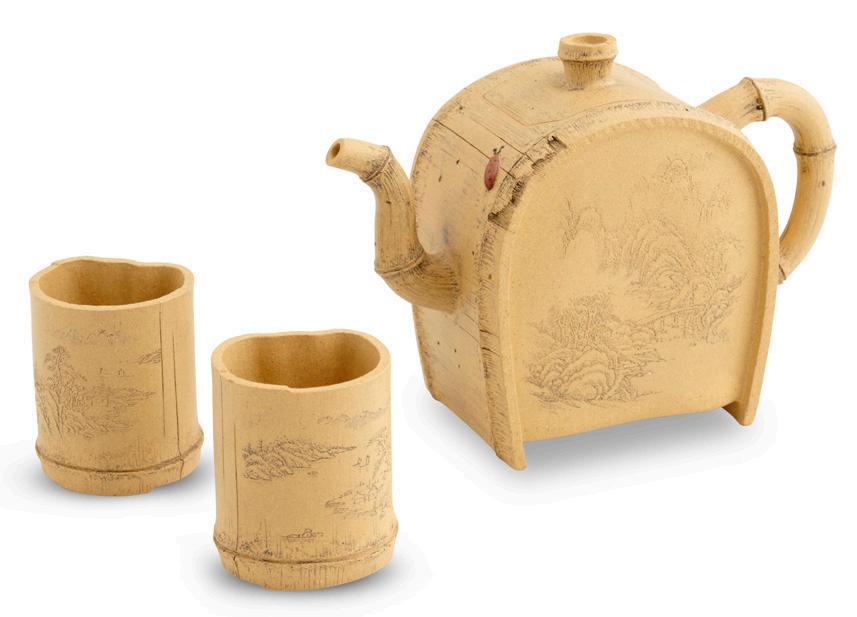




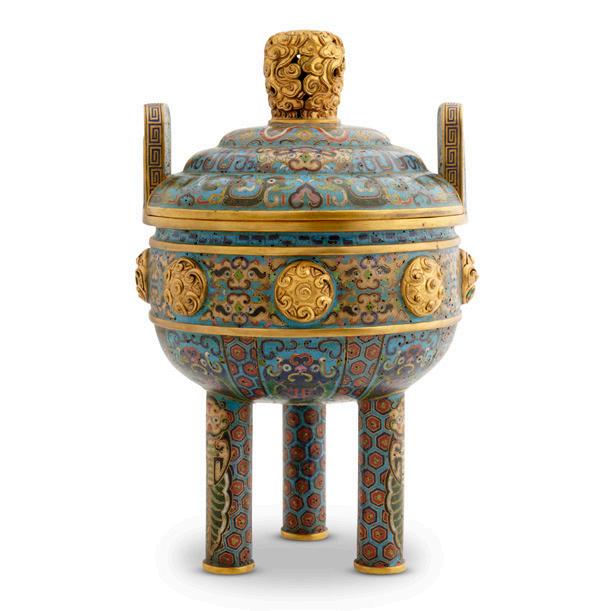
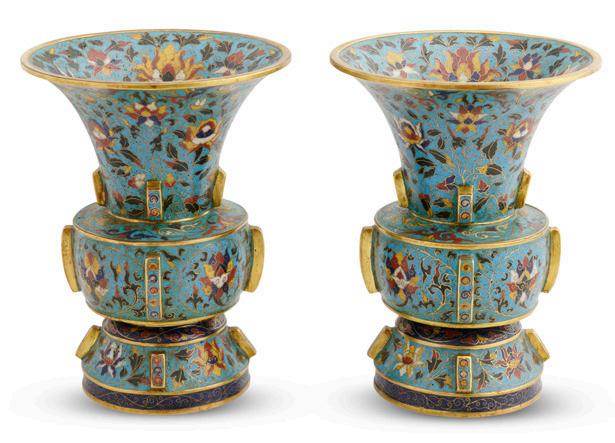
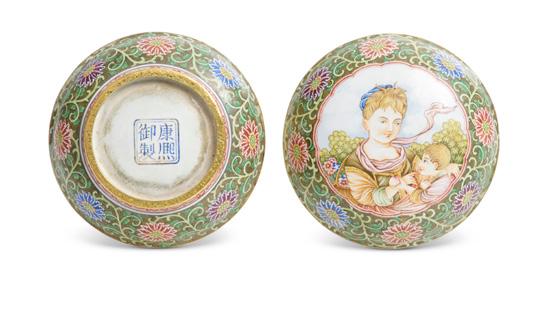
65
A CHINESE CLOISONNE TRIPOD CENSER AND COVER, DING, QIANLONG MARK, QING DYNASTY (1644 - 1911)
27.8cm high
$3,000-5,000
清 乾隆款 掐絲琺瑯三足鼎式香爐及蓋
66
A PAIR OF CHINESE CLOISONNE GU SHAPED VASES, QING DYNASTY (1644 - 1911) The base of each vase is engraved with a double vajra mark.
Each 19cm high; 14.5cm diameter
provenance
Collection of Millicent A. Gogers (according to the sticker on the base).
$5,000-7,000
清 掐絲琺瑯觚形瓶 一對
67
A CHINESE PAINTED ENAMEL
FANGLANGCAI ON GILT BRONZE COSMETIC BOX AND COVER, KANGXI FOURCHARACTER MARK, LATE 19TH CENTURY OR EARLIER
5.3cm diameter
provenance
The Estate Collection of Oscar Saldarriaga (Colombia, b. 1947)
Oscar Saldarriaga was a distinguished textile trader, active during the height of Colombia’s thriving textile industry in the 1970s and 1980s. His career frequently took him to China, where he developed a deep admiration for Chinese culture, artistry, and craftsmanship. Over the decades, Saldarriaga assembled an important collection of fine art and Chinese works of art, each piece thoughtfully acquired during his travels.
$600-800
清 康熙款 19世紀或更早 粉彩蓋盒
68
A SMALL CHINESE PAINTED ENAMEL ON GLASS “BOYS” BOTTLE, QIANLONG FOUR CHARACTER MARK AND POSSIBLY OF THE PERIOD (1736 - 1795)
5.5cm high
provenance
The Estate Collection of Oscar Saldarriaga (Colombia, b. 1947)
Oscar Saldarriaga was a distinguished textile trader, active during the height of Colombia’s thriving textile industry in the 1970s and 1980s. His career frequently took him to China, where he developed a deep admiration for Chinese culture, artistry, and craftsmanship. Over the decades, Saldarriaga assembled an important collection of fine art and Chinese works of art, each piece thoughtfully acquired during his travels.
$800-1,200
乾隆款 或為本朝 琉璃洋彩彩嬰戲圖小瓶
A CHINESE ARCHAISTIC CARVED MOTTLED
JADE DISC BI, MING DYNASTY (1368 - 1644)
One side of the disc was carved with four chilong dragons, the other side was decorated with “guwen” pattern. It’s mounted on a wooden stand, with a gilded key-fret border along the rim. At the centre, framed by a pair of kui dragons, is the classic “Three” character mark. In the I Ching, the number three corresponds to the “Qian” trigram; combined with the surrounding dragons, it forms an allusion to “Qianlong” subtly reinforcing the emperor’ s authority while showcasing the ingenuity and skill of the craftsman.
11cm diameter
other notes
The jade bi is one of the earliest and longest-used types of ancient Chinese jade objects. The Zhou Li (Rites of Zhou) records: “Make six ritual vessels from jade to observe rites toward Heaven and the Four Directions: use the blue bi for Heaven, the yellow cong for Earth, the green gui for the East, the red zhang for the South, the white hu for the West, and the black huang for the North.” The Strategies of the Warring States notes that “the King of Chu sent envoys with a hundred chariots to present a luminous bi,” and the Zuo Zhuan records that King Gong of Chu used a bi in sacrifices to the assembled deities. Such references highlight the special significance of the jade bi in ancient Chinese culture. Beyond its ritual function, it symbolized power and played an important role in political exchanges. Its influence, prevalence, and wide distribution make it the most prominent type among ancient jade objects.
The Erya · Shiqi records: “If the central hole is larger than the body it is called a bi; if the body is larger than the central hole it is called a yuan; if the body and hole are equal it is called a huan.” Early jade bi, as one of the “six ritual vessels” in traditional China, were simple and unadorned, with plain surfaces and relatively irregular craftsmanship. During the Spring and Autumn and Warring States periods, however, bi began to feature a variety of decorations, including cloud patterns, grain motifs, animal and bird designs. These decorations became increasingly elaborate and intricate, adding elegance and refined charm to what had been a very simple form.
The Qianlong Emperor of the Qing dynasty was renowned for his love of antiquity, favouring simplicity, elegance, and classical forms, which inspired a vogue for antiquarian imitation. Craftsmen, guided by centuries of inherited skill and experience, selected fine jade to recreate objects imbued with the spirit of ancient times. The present jade bi is a notable example: the material is warm and lustrous, cut according to the principle that “Heaven is round,” forming a circular ring.
provenance
An old private collection, Tokyo, acquired in the early 80s.
$12,000-25,000
明 仿古玉璧
清代乾隆帝以好古、嗜古聞名,偏重古樸文雅,帶 動了仿古的風潮。匠人門以古為師,通過傳承千 百年來錘煉出來的高超手藝和豐富經驗,用精美的 玉料還原出充滿遠古風韻的玉器。此件玉璧便是 其中一例,用料質地溫潤,以 “ 天道曰圓 ” 的觀念 開料,呈現圓環狀的外形,表面浮雕五條姿態各異 的螭龍,身形矯健靈動。背面則鐫有經典的穀紋裝 飾,這種多見於春秋戰國時期玉器上的古老紋樣象 征農耕文明的豐收祈願,亦反映萬物復甦的自然崇 拜,體現了中國古代文化的審美。
器配木座,邊緣處描金回紋,中心部在一對夔龍的 簇擁下顯現出經典的 “ 三 ” 字款。 “ 三 ” 字在周易的 八卦中象征 “ 乾 ” 位,與兩側的龍紋相結合,正好 組成 “ 乾隆 ” 的寓意,可謂 “ 處處見聖威 ” ,隱喻之 中凸顯巧匠工思。請參閱香港蘇富比 2019 年 4 月 3 日, 第 3506 拍品的嵌古玉紫檀插屏,中心部位亦 有 “ 三 ” 字款。

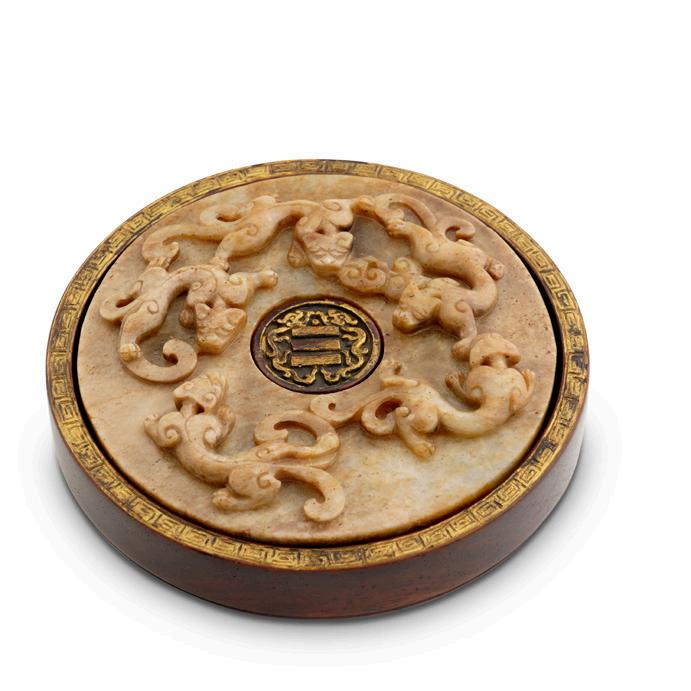
A VERY FINE AND IMPORTANT CHINESE BRONZE TAPIR-FORM VESSEL XIZUN, QING DYNASTY, QIANLONG PERIOD (1736 - 1795)
The finely cast creature stands four-square, its mouth slightly agape beneath a curled snout, with pointed ears set behind arched, flame-like brows, supporting a Zun formed vessel upon its back. It is presented on a finely carved fitted hongmu stand.
This vessel offers a playful yet erudite reinterpretation of archaic bronze forms, embodying both reverence for antiquity and the projection of imperial authority. Its silhouette and decoration derive from Warring States prototypes (475-221 BC), which display comparable forms and motifs.
The identity of the animal has long been debatedvariously described as a mythological beast, rhinoceros, or tapir. The latter is now regarded as the most plausible, with archaeological evidence suggesting that tapirs, though long extinct in China, inhabited the region as early as 200,000 BC.
Such archaistic bronzes stem from the antiquarian revival of the Northern Song, championed by Emperor Huizong (960-1127), whose Xuanhe Bogu tulu (Illustrated Catalogue of Antiques) includes a tapir-shaped vessel. The fashion for zoomorphic bronzes continued through the Yuan, Ming, and Qing dynasties, culminating in the monumental Xiqing gujian (Catalogue of Xiqing Antiquities), commissioned by the Qianlong Emperor and completed under Liang Shizheng (1697-1763) in 1751. This encyclopedic work epitomised the emperor’s vision of restoring the “ancient ways” and the moral virtue associated with antiquity.
Comparable examples include a cloisonné enamel tapir-form zun, Qianlong mark and period, in the National Palace Museum, Taipei, published in Enamel Ware in the Ming and Ch’ing Dynasty, Taipei, 1999, no. 43; and a Ming dynasty gold- and silver-inlaid tapir vessel in the Cernuschi Museum, Paris (acc. no. M.C.583). See also a bronze tapirform xizun, Qianlong mark and period, sold at Christie’s London, 3 November 2020, lot 90; and a related gold- and silver-inlaid tapir zun, 17th/18th century, sold at Christie’s New York, 13 February 2018, lot 108. 30cm high; 23cm wide
provenance
Spink & Son Ltd., London (labels to the base of the vessel and to the fitted stand).
$50,000-70,000
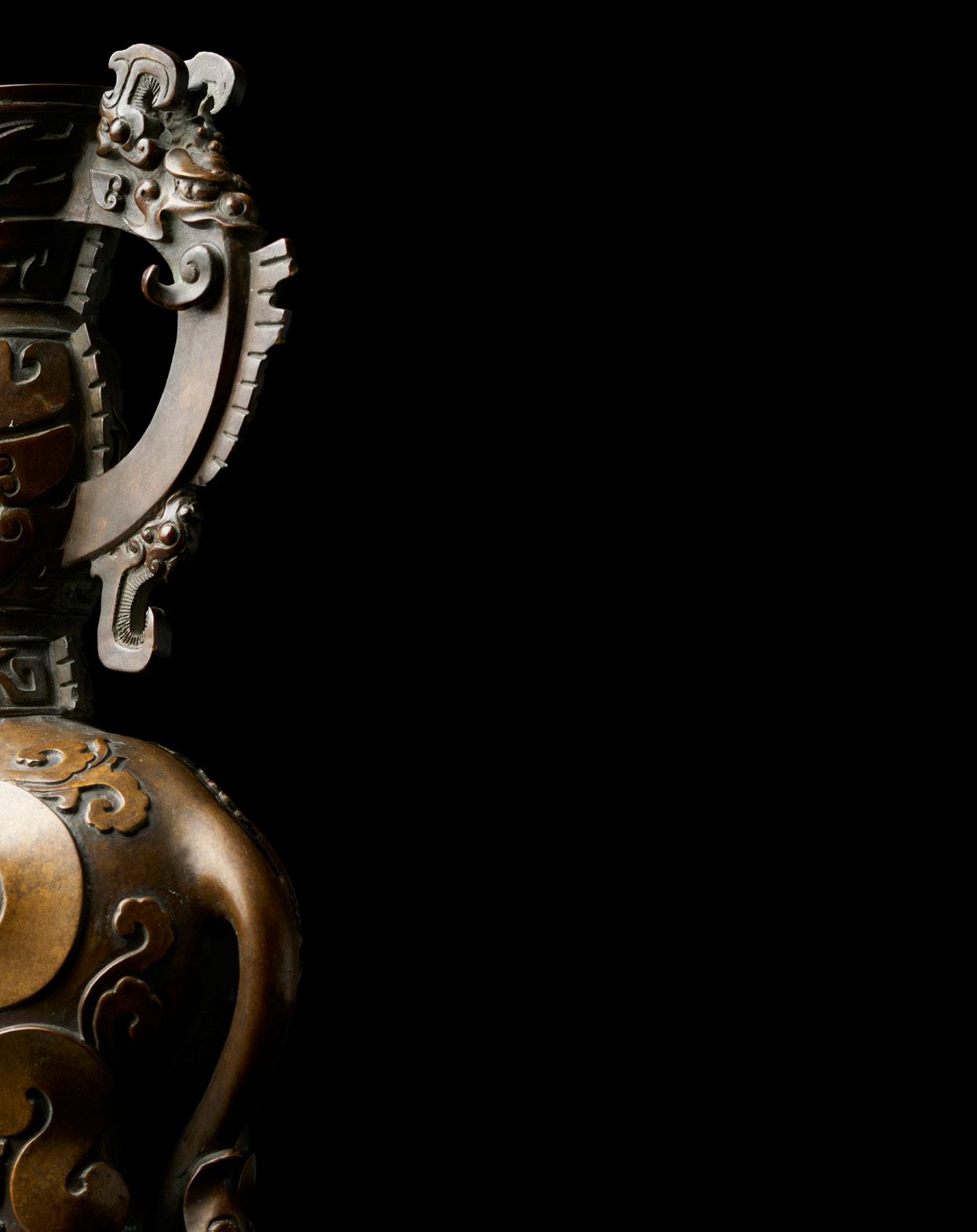
清乾隆 銅犀尊 配紅木底座
此器鑄造精良,神獸四足穩立,口鼻微張,耳尖後 伏於火焰狀眉下,背負尊形器,置於紅木座上。
其形制源自戰國青銅原型,既承古意,又寓帝王威 儀。關於獸形歷來說法不一,或為神獸、犀牛,今 則多認為為貘。考古證據顯示,雖貘早已在中國絕 跡,然早於二十萬年前即棲息於此地。
此類仿古器始於宋徽宗(960–1127)提倡的古器復 興,《宣和博古圖錄》載有貘形器例。其風尚延續 至元明清,乾隆帝尤為推崇,命梁詩正於1751年編 纂《西清古鑑》,收錄多件同類。
可參考之例包括:臺北故宮乾隆款掐絲琺瑯貘形尊 (《明清琺瑯器》,1999,編號43);巴黎賽努 奇博物館明代錯金銀貘形尊(館藏編號 M.C.583) ;另見倫敦佳士得2020年11月3日拍賣會(拍品90 )乾隆款銅貘形犧尊,以及紐約佳士得2018年2月 13日拍賣會(拍品108)十七/十八世紀錯金銀貘 形尊。
源流: 倫敦Spink & Son Ltd.(器底及座附標籤)。
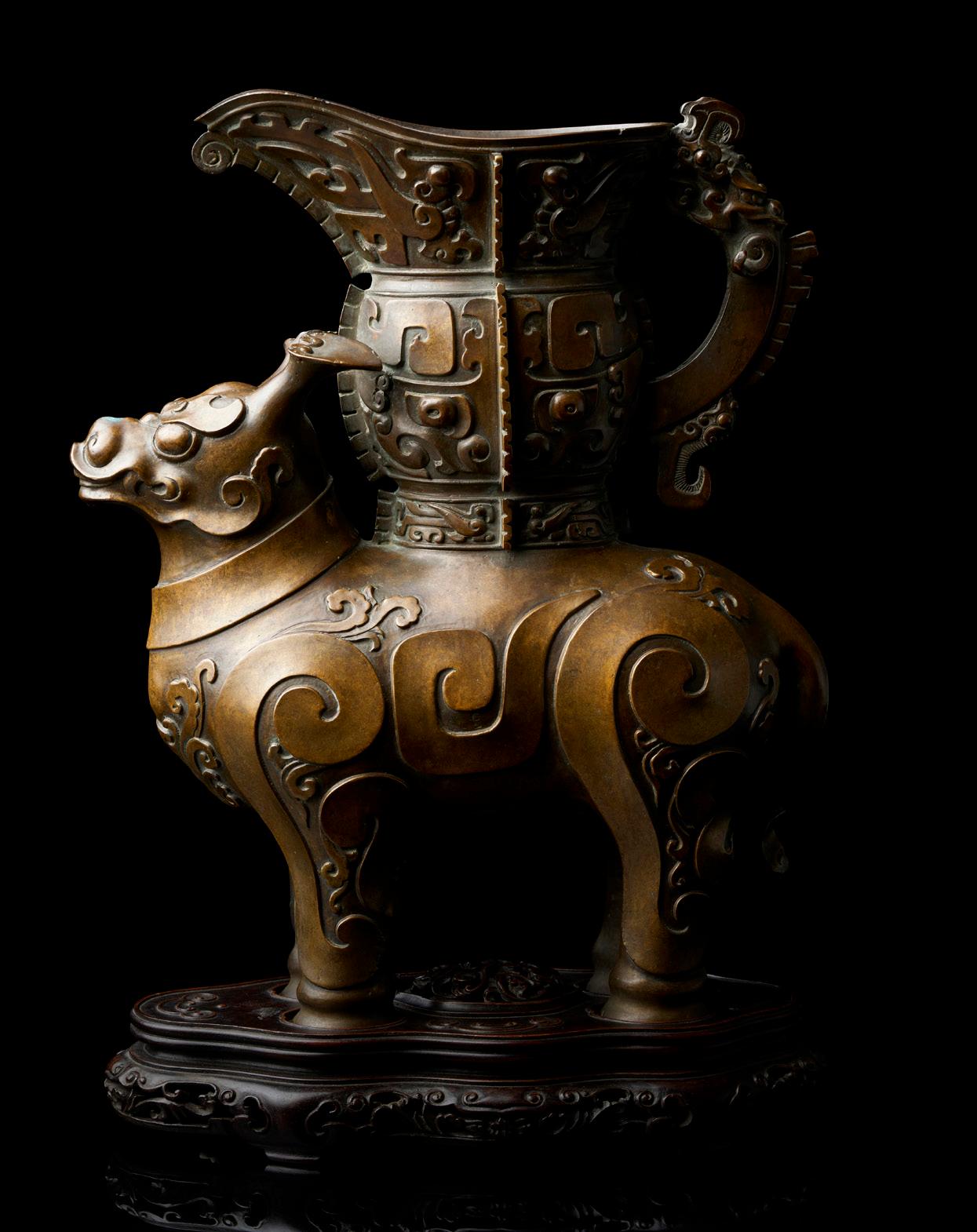
71 A CHINESE CINNABAR LACQUER TIXI DECORATED VASE, XUANDE MARK
With an old ivory cover, and a fitted box. 14.5cm high
$4,000-6,000
宣德款 剔犀漆瓶
瓶身層層雕刻漩渦紋,漆色深紅,工藝繁複。配舊 象牙蓋及盒。
72 A FINE CHINESE CINNABAR CARVED LACQUER RUYI FORMED BOX AND COVER, QIANLONG PERIOD (1736 - 1795)
The cover is finely carved through thick layers of cinnabar lacquer to depict one of the either immortals-Tian Guaili in the river landscape. 14 x 11cm
provenance
J. T. Tai & Co.
An old private collection, New Zealand.
J.T. Tai (Tai Jun Tsei, 1911-1992), born Dai Fubao, was one of the most influential dealers of Chinese antiquities in the 20th century, second only to C.T. Loo in shaping Western collections of Chinese art. After starting in his uncle’s antique shop in Wuxi, Tai opened his own gallery in Shanghai before fleeing to Hong Kong in 1949 and later establishing J.T. Tai & Co. in New York in 1950 with support from C.T. Loo. His clients included prominent collectors such as Avery Brundage and Arthur M. Sackler, and his gallery played a key role in building major American museum collections. Tai was also a noted philanthropist, founding the J.T. Tai & Co. Foundation in 1983. His collection has been featured in numerous important sales at Sotheby’s and Christie’s.
$6,000-8,000
清乾隆 剔紅如意形蓋盒
盒蓋以厚剔紅漆雕刻河岸仙人場景,描繪八仙之一 铁拐李,工藝精湛,層次分明。
源流:
戴潤齋;
新西蘭私人舊藏。
73 A CHINESE GILT BRONZE ENGRAVED AND SEMI-PRECIOUS STONE INLAID BONSAI, MID-QING DYNASTY, 18TH/19TH CENTURY
The baibao qian (inlaid treasure) bonsai from the Qing imperial palace represent a pinnacle of imperial decorative art. Inspired by natural potted landscapes, they were reimagined by palace workshops as luxurious, permanent display pieces. Made with gilt-bronze planters and inlaid with a rich variety of materials such as jade, turquoise, coral, agate, ivory, and kingfisher feather. Their compositions depict miniature landscapes of rocks, blossoms, and birds in vivid detail and auspicious symbolism.
Unlike living bonsai, which emphasize natural vitality, these inlaid treasure bonsai embody ideals of permanence, abundance, and auspicious fortune. They were displayed in palace halls, temples, and the private apartments of the emperor and empress, serving as symbols of prosperity, longevity, and harmony.
The Palace Museum in Beijing preserves a significant group of these works, notable for their scale, technical refinement, and opulent materials, offering important insight into Qing court aesthetics and craftsmanship. For comparable examples, see two in the Palace Museum collection, nos. gu00125948 and gu00126610.
26cm high; with a fitted box.
provenance
A private scholar’s collection, VIC.
$4,000-6,000
清中期 銅鎏金「嵌百寶」盆景擺件 此件嵌百寶盆景為清宮「百寶嵌」工藝之代表,乃 宮廷陳設藝術之巔峰。其靈感源自自然盆景,經宮 廷造辦處匠人重新演繹,製作成可永久保存之華麗 陳設品。器身以鎏金銅盆為基,嵌以玉石、松石、 珊瑚、瑪瑙、象牙及翠鳥羽毛等珍貴材料,構成山 石、花木、禽鳥等微型景觀,形象生動,寓意吉 祥。
與強調生機的真盆景不同,嵌寶盆景體現的是永 恆、富足與祥瑞之理想,常陳設於殿堂、佛堂及帝 后寢宮,象徵繁榮、長壽與和諧。
北京故宮博物院藏有一批此類作品,規模宏大, 工藝精湛,材質華美,充分展現清代宮廷美學與 工藝水準。可參考故宮藏品編號 gu00125948 與 gu00126610。
源流: 維州私人學者舊藏。
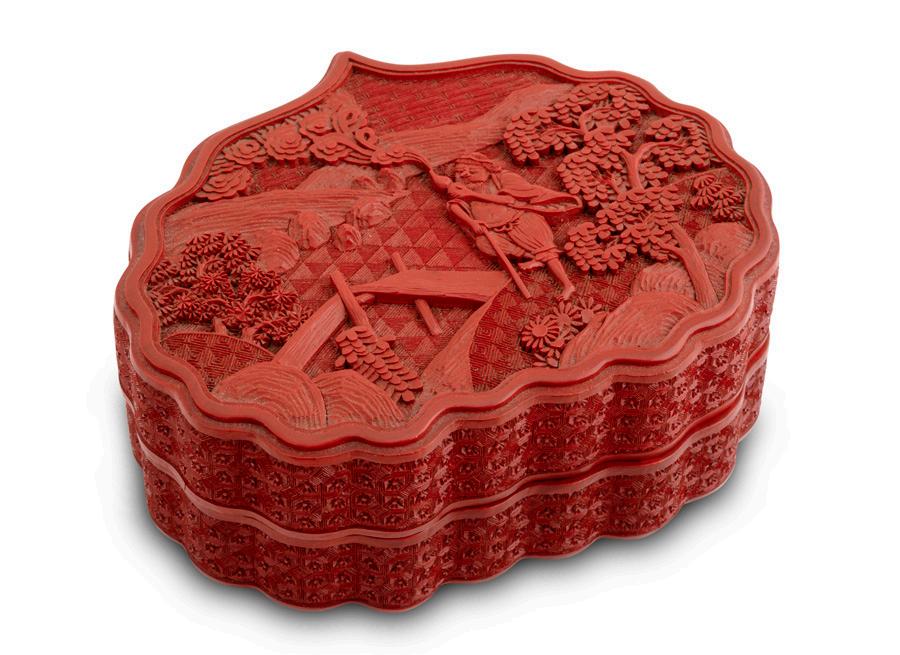
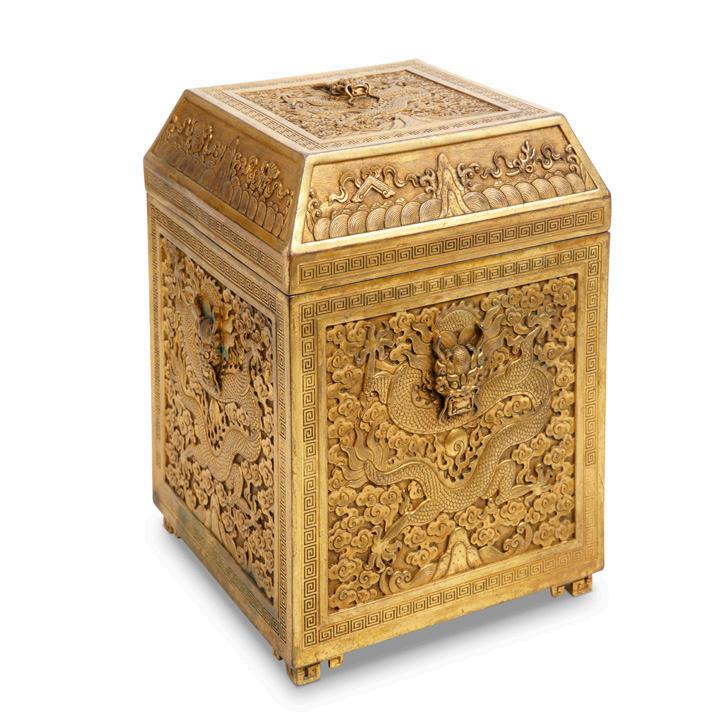

74
A CHINESE GILT BRONZE “DRAGON” BOX AND COVER, QIANLONG FOUR CHARACTER CAST MARK AND POSSIBLY OF THE PERIOD (1736 - 1795)
22.3cm high; 15.5cm wide; 15.5cm deep
provenance
The Estate Collection of Oscar Saldarriaga (Colombia, b. 1947)
Oscar Saldarriaga was a distinguished textile trader, active during the height of Colombia’s thriving textile industry in the 1970s and 1980s. His career frequently took him to China, where he developed a deep admiration for Chinese culture, artistry, and craftsmanship. Over the decades, Saldarriaga assembled an important collection of fine art and Chinese works of art, each piece thoughtfully acquired during his travels.
$1,500-2,500
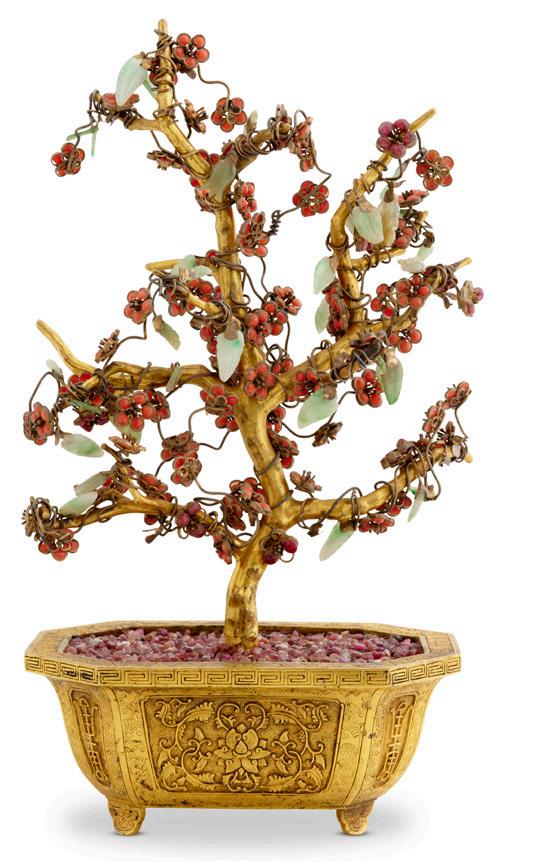
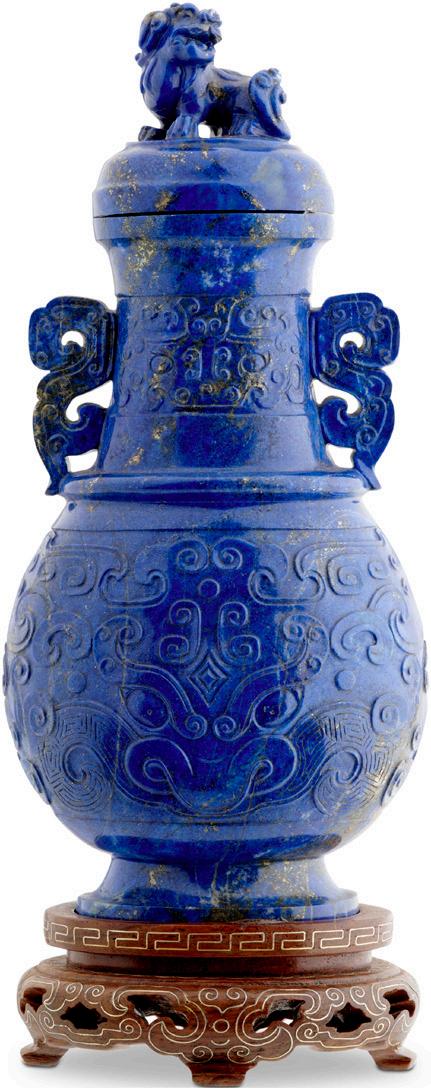
75
A VERY FINE CHINESE LAPIS LAZULI VASE, QIANLONG PERIOD (1736 - 1795)
The vase is finely carved in low relief with taotie masks on each side of the body and neck, flanked by a pair of dragon handles. The cover is surmounted by a lion finial, and the vase is with a fitted wood stand with gilt-silver inlay.
This work is distinguished by its rarity, exceptional quality of carving, and impressive size, requiring a substantial block of lapis lazuli to achieve such a monumental form.The design takes inspiration from antiquity, reflecting the Qianlong Emperor’s ambition to “restore the ancient ways.” By urging craftsmen to draw on archaic prototypes, the Emperor encouraged works of art that combined sincerity and simplicity with refinement and elegance. The present vase reinterprets the archaic bronze hu shape with eighteenth-century innovation and sophistication. Comparable examples include a larger lapis lazuli vase (32.5 cm high), formerly in the An Yu Xuan Collection, sold at Bonhams Hong Kong, 29 May 2023, lot 122; and a lapis lazuli phoenix-form vase, sold at Christie’s Hong Kong, 1 June 2011, lot 3967. 19cm high
provenance
An important private collection, Sydney, acquired in the mid-1990s by the present owner while working with Golay Buchel, the Swiss gem and jewellery company with global operations across more than 17 countries.
Golay Buchel, in addition to its extensive gem trade, maintained a distinguished department of Chinese and Japanese antiques, with a collection valued at approximately 7 million CHF. In the mid-1990s, under the direction of its then-chairman, the department was dissolved, and the collection was dispersed through private sales and a series of auctions at Salle Drouot, Paris, in 1995 and 1996.
The present vase was among several works the present owner personally selected and retained from this collection.
$15,000-25,000
清乾隆 青金石仿古雕賞瓶及蓋
瓶身及頸部浮雕饕餮紋,兩側飾龍耳,蓋頂雕獅 鈕。此器以大塊青金石雕成,工藝精湛,體量宏 大,設計仿古,體現乾隆皇帝「復古」理念。原配 嵌銀絲底座。
類似器見: 2023 年 5 月 29 日香港邦瀚斯拍賣,第 122 號拍品(安玉軒舊藏); 2011 年 6 月 1 日香港佳 士得拍賣,第 3967 號拍品(鳳凰形青金石瓶) 源流:
澳洲悉尼重要私人收藏, 1990 年代中期購自瑞士 Golay Buchel 珠寶公司。
76
A CHINESE GREEN JADE CARVED SEATED
FIGURE OF BUDDHA
With a fitted carved hongmu stand.
17cm high
provenance
The Estate Collection of Oscar Saldarriaga (Colombia, b. 1947)
Oscar Saldarriaga was a distinguished textile trader, active during the height of Colombia’s thriving textile industry in the 1970s and 1980s. His career frequently took him to China, where he developed a deep admiration for Chinese culture, artistry, and craftsmanship. Over the decades, Saldarriaga assembled an important collection of fine art and Chinese works of art, each piece thoughtfully acquired during his travels.
$1,000-2,000
碧玉雕阿彌陀佛坐像
77 A VERY FINE CHINESE LAPIS LAZULI MUGHAL STYLE “RAM” HANDLE CUP, 18TH/19TH CENTURY
16cm wide; 4.8cm high
provenance
The Estate Collection of Oscar Saldarriaga (Colombia, b. 1947)
Oscar Saldarriaga was a distinguished textile trader, active during the height of Colombia’s thriving textile industry in the 1970s and 1980s. His career frequently took him to China, where he developed a deep admiration for Chinese culture, artistry, and craftsmanship. Over the decades, Saldarriaga assembled an important collection of fine art and Chinese works of art, each piece thoughtfully acquired during his travels.
$4,000-6,000
清 十八/十九世紀 青金石雕莫臥兒王朝風格羊首 把杯
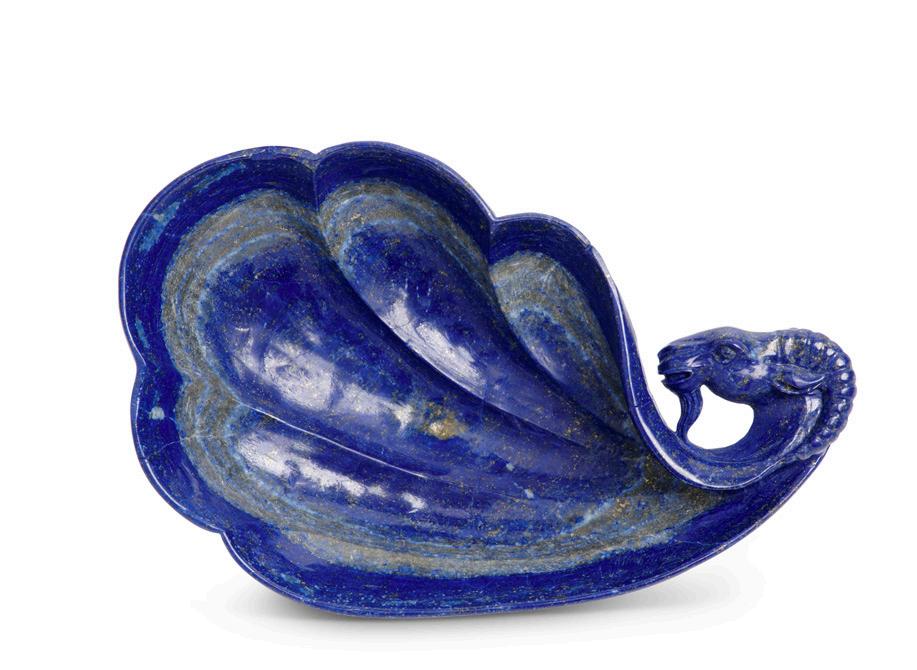
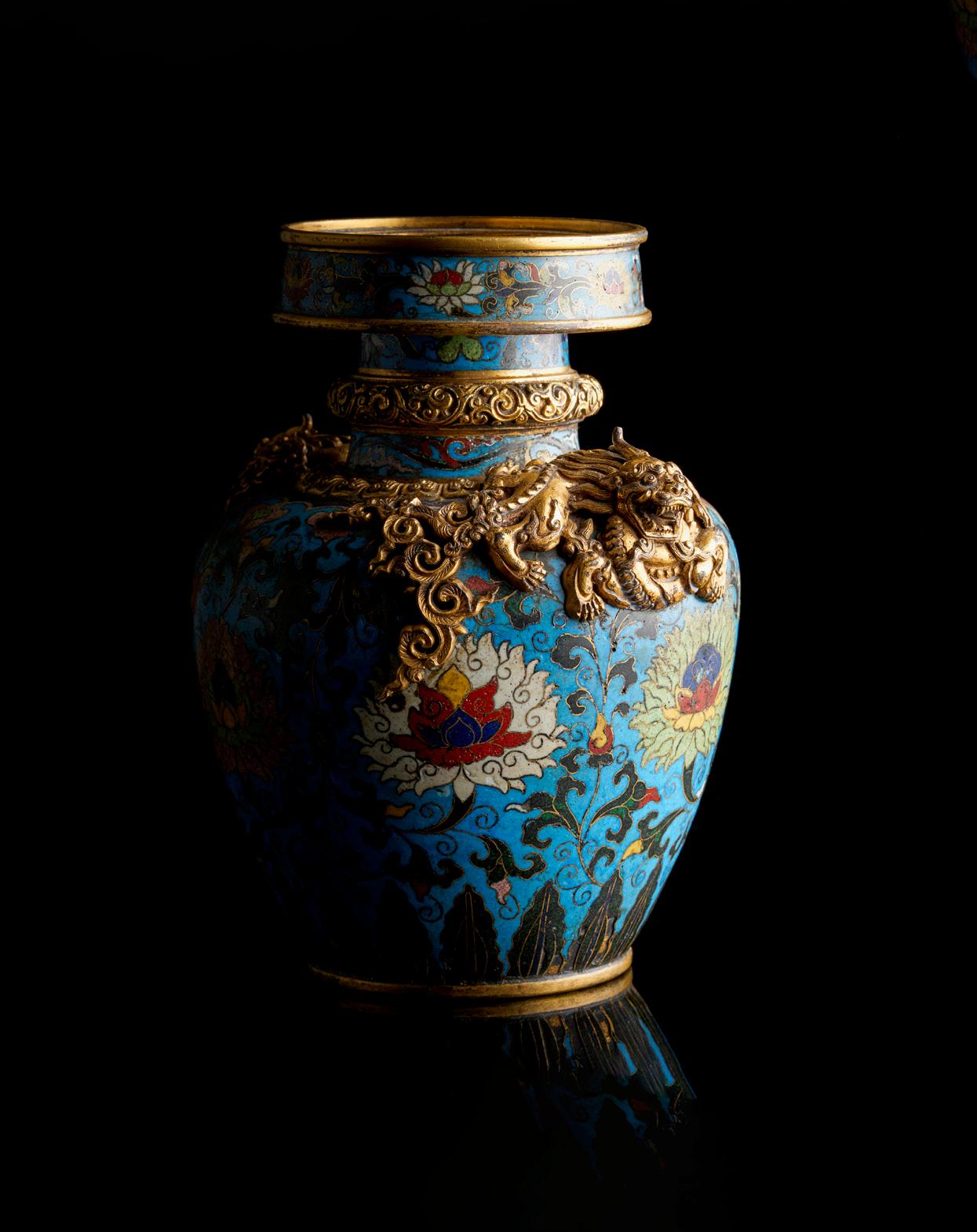
78 A FINE CHINESE CLOISONNE DRAGON HANDLED VASE ZUN, LATE MING/EARLY QING DYNASTY, 17TH CENTURY
The base is engraved with a double vajra mark. 22cm high
$15,000-25,000
明末清初 十七世紀 掐絲琺瑯龍柄尊
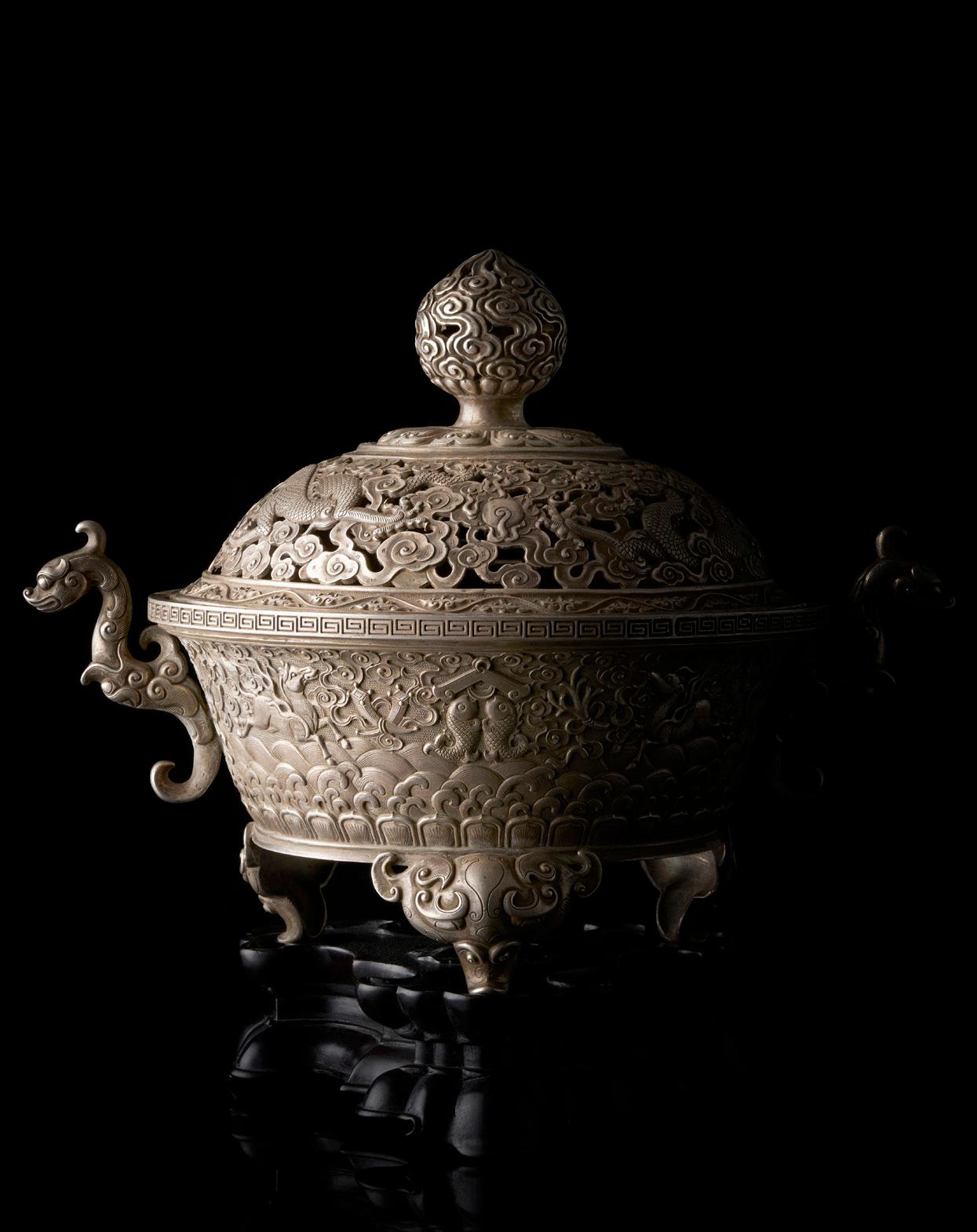
79 A RARE AND FINE CHINESE SILVER CENSER AND COVER, QIANLONG MARK POSSIBLY OF THE PERIOD (1736 - 1795)
The cover of the censer is decorated in openwork with two dragons chasing flaming pearls, the body is flanked by a pair of chilong handles and finely decorated with the Eight Buddhist Treasures and sea-horse motifs above sea weave and an upright lotus-petal band, supported on taotie-shaped feet, Qianlong mark to the base, with a finely carved zitan stand.
28.5cm wide; 25cm high; weight: 2685g $25,000-35,000
清乾隆 「乾隆年製」款 純銀香爐連蓋 配紫檀座 蓋鏤空雙龍戲珠,爐身兩側螭龍耳,飾八寶、海 馬、海水紋及仰蓮瓣紋,足為饕餮形,底刻「乾隆 年製」款,配雕工精美紫檀座。

Himalayan Arts from Various Owners
lots 80 – 97
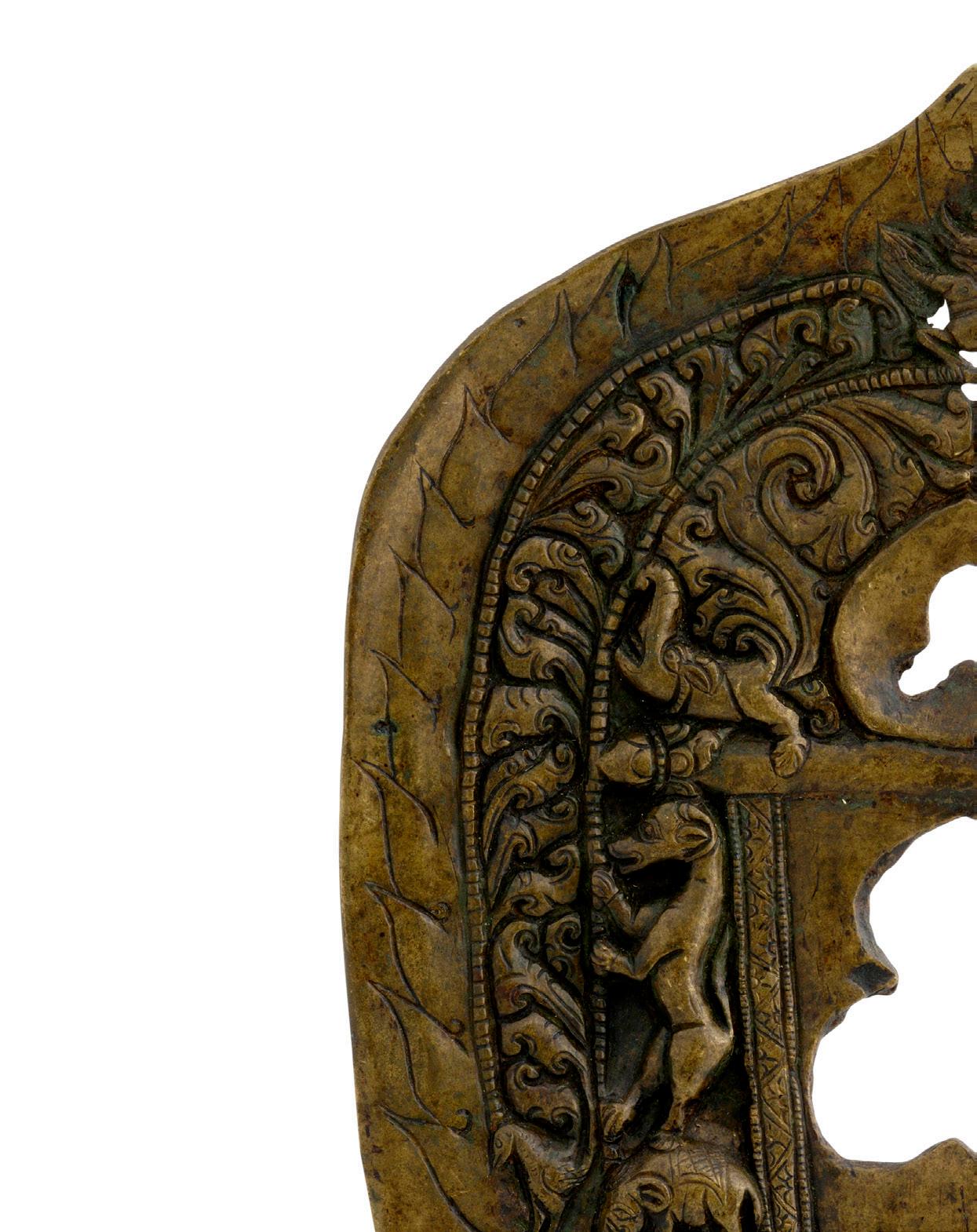
I have been closely linked with Tibetan sacred art and literature for over 60 years and to this day am still amazed at the profound beauty found in images such as these. Such images are not meant to be anything other than mirrors of ourselves showing us as we potentially can be. The development of bronze image-making in Tibet seems to have commenced about the 8th century, but earlier talismanic objects date from 1000 years before that. Tibetan artists learned their art under bronze-casting masters from Kashmir and Swāt (in modern-day North-west Pakistan). The strong Nepalese influence from the 8th century (especially in wood carving and later in bronze) added immeasurably to the making of a Tibetan artistic tradition and Nepalese artists were present in Tibet from those earliest days right up to the 17-18th centuries. The bronzes in this Catalogue reflect some of these earlier influences which are especially noted in aspects such as the uniquely Nepalese way of depicting a gaze which looks inwards and outwards at the same time as well as attention to a flawless thick gold covering of the image. It believe that the images I have selected to discuss here represent high-points of Tibetan art and that we are fortunate to be in their presence.
Shakyamuni Buddha
Western Tsang region of Tibet 12-14th cent. Bronze with gilding - slight traces of pigment. This impressively large image of the Buddha sits with poise and a sense of focus as he calls the earth to witness his Enlightenment. Elements of the image’s style - especially the slightly elongated body and the florid lotus base clearly point to this identification and dating. As is typical of such images, his robe is shown as clinging to his body and is almost undecorated. Images from this place and period are often shown sitting slightly crookedly on their bases due to careless handling. The image’s blessed-items, usually held in the lotus base, are absent. The cast-bronze aureole - which does not belong to this piece - is of about the same date as the Buddha it accompanies and shows two mythic animals (vyala) standing on the backs of two supporting elephants. Above them are two makara ‘sea-creatures’ who bestow wealth.
Image: Lot 80
Shakyamuni Buddha
Khasa-Malla Period. 14-15th cent. Bronze with gilding and pigments. This delightful and diminutive image shows the Buddha - Shakyamuni - touching the earth with his left hand to witness his Enlightenment. The Buddha looks slightly downward and sits on an elaborate lotus base. His fine robes, modest facial expression and relatively thick gold application over the body are typical of the style developed in far Western Nepal where, between the late 13th and 15th centuries, the Khasa Malla rulers encouraged artisans to create extremely unique Buddhist images, many of which were sent as tribute throughout Tibet. The base still possesses what appears to be the original seal and its blessed contents are therefore still intact. Such pieces often have a small application of red paint on the rear of the lotus base which serve to identify their place of origin.
Image: Lot 82
我與西藏宗教藝術及文獻密切相關已逾六十年,直至今日, 仍對這些影像中所展現的深邃之美感到讚歎。這些影像的意 義不在於其他,而是作為鏡子,映照出我們自身的潛能。
西藏青銅造像的發展大約始於8世紀,但早期護符類器物可追 溯至千年前。西藏藝術家多師承來自喀什米爾及斯瓦特(現 巴基斯坦西北部)的青銅鑄造大師。自8世紀起,尼泊爾的 強烈影響(尤其在木雕及後來的青銅造像上)極大地豐富了 西藏藝術傳統,尼泊爾藝術家自最早期即活躍於西藏,直至 17至18世紀。
本目錄中的青銅造像反映了這些早期影響,尤其表現在尼泊 爾特有的凝視方式 既向內又向外 以及對厚重鎏金的 精細處理。本人相信,這些入選的作品代表了西藏藝術的高 峰,我們有幸能親眼目睹。
釋迦牟尼佛
西藏昌西地區,12-14世紀,青銅鎏金,略帶彩料痕跡 此佛像宏偉端莊,呼地證悟之姿態莊重。造型特徵 略長 的身形與華麗蓮座 指示其產地與年代。衣紋貼身,幾乎 無裝飾。此地區此時期佛像常因搬運不慎而座位略歪。蓮座 內的供品現已缺失。
附屬青銅光背非原配,但與佛像同時期,呈現兩隻神獸 (vyala)立於象背,上方有兩隻海龍(makara),象徵 賜福與財富。
圖號:Lot 80
釋迦牟尼佛
喀薩-馬拉時期,14-15世紀,青銅鎏金彩繪
此小巧可愛的佛像描繪釋迦牟尼以左手觸地以證悟。佛身微 俯,坐於精美蓮座之上。其衣紋細緻、面容端莊,厚重的鎏 金覆蓋體現了西尼泊爾偏西地區(13至15世紀末期)藝術風 格,喀薩-馬拉統治者鼓勵工匠創作獨特佛像,並常作朝貢送 至西藏。蓮座仍保有原始印章,內含供品亦完整。此類作品 蓮座背面常有紅色塗料標記,以示產地。
圖號:Lot 82
不明喇嘛像
西藏,1400-1499年,青銅鑲銀金眼
此喇嘛無銘,但可能屬薩迦派,其特徵為厚重法衣與羊毛披 肩,後身長衣褶亦與同期薩迦像相似。鑲嵌銀金眼使其目光 直視觀者。衣紋覆蓋精妙,左肩衣襟小皺褶精巧,衣紋均勻 圍於大腿。右臂下垂觸地,顯示此喇嘛亦已證悟。
圖號:Lot 83
大黑天(Pañjara Mahakala)
中藏,1450年,青銅鎏金
此強力且活躍的“亭護者”形式的瑪哈嘎拉,是西藏重要護 法神之一,護持修習《喜金剛密續》的修行者免遭障礙。
此精美造像瑪哈嘎拉蹲坐於象徵一切障礙的俯伏之上,面容 與姿勢展現憤怒,但內心寧靜,旨在消除修行者的內在障 礙。血-filled skull cup及手中的小斧象徵斬除無明,頭盔五角 標誌代表五智圓滿。
此件青銅鑄造顯示西藏工藝之高超。略早於此時期,尼泊爾 工匠阿尼哥(Aniko)曾受邀至元朝皇宮製作佛像,該造像可 能源自西藏薩迦寺的鼎盛時期。
圖號:Lot 84
無量壽佛(Amitayus) 長壽之神
喀薩-馬拉時期,14-15世紀,青銅鎏金彩繪 此珍貴佛像代表喀薩-馬拉王國藝術創造力之巔峰。現知此類 作品不多,但陸續被發現,通常以蓮座背面紅色標記辨識。 此佛像技藝高超,推測曾作為供奉西藏寺院(如丹萨替寺) 的禮物。無量壽持長壽瓶,注視信徒之行止,可賜永生。底 座呈金剛杵裝飾,可見移開後的卷軸祈壽經文,內含多位供 奉者祈求,包括財富與和諧之神Vasundhara。
圖號:Lot 85

Unknown Lama
Tibet (1400-1499)
Bronze with electrum inlaid eyes.
This Lama is unidentified by inscription but probably belonged to the Sakya tradition which often portrays their Lamas with heavy robes and an woollen cape. The long robe-pleats at the rear are also found in Sakya images from the period. The effect of the electrum inlaid eyes makes him appear as if he is looking directly at the viewer. His robes are overlaid with great skill and the detail of the small ruffle at his left shoulder is quite charming as is the unusual manner in which the robe has been curled evenly around his thighs. His lowered right arm in the pose of touching the earth reminds the viewer that this Lama had also reached a state of
Enlightenment.
Image: Lot 83
‘The Great Black One.’ Sanskrit -Panjara Mahakala Central Tibet, 1450 C.E. Bronze with gilding.
This powerful and highly active form of Mahakala known as the ‘Protector of the Pavilion’ is one of Tibet’s great protective deities whose wrath is intended to protect those practicing the Hevajra Tantra from all hindrances.
In this stunningly elaborate and perfectly made image Mahakala is seen squatting on a figure who represents all the hindrances to be overcome. His wrath is clear from both his face and his pose…but that wrath is tranquil at heart and is always directed to the practitioner’s own inner hindrances. This is symbolized by the blood-filled skull cup and chopper he holds - the chopper being symbolic of severing ignorance away from one’s inner wisdom. The skull cup contains wisdom which is depicted as blood. Mahakala has mastered all five forms of wisdom which is reflected in the five-pointed emblems in his crown.
This remarkable piece of bronze casting demonstrates how advanced Tibetans were in their workmanship. Slightly before the period in which this image was created Aniko, a Nepalese artisan working in Tibet, was summoned to the Yuan court of China to make images for the Emperor. It is likely that this image might have originated at the great Sakya monastery during the height of its power in Tibet.
Image: Lot 84
Amitayus - Deity of Long-Life.
Khasa-Malla Period. 14-15th cent. Bronze, gilding and pigment.
This most precious and important image marks the high point of creativity achieved in the Khasa-Malla kingdom of western Nepal. There are relatively few of these images known but more are coming to notice and are usually identified by the red paint found on the rear of the base.
The great skill brought to the image suggests that it might have been a gift-offering to a Tibetan monastery such as Densatil which possessed many such images.
Amitayus is known as the deity who bestows long-life and holds the vase which contains the blessed water which gives it. He looks with directly at the worshipper and sees their past and future deeds and can grant eternal life…or not.
The image is flawless and of particular interest is the vajra-decorated base-plate which has been dislodged revealing many scrolls containing prayers for long life. Not seen are the piece of wood (the ‘life-wood’) which goes from the base of the image’s spine to the top of the head, small cloth bags containing semi-precious stones, etc. and the base plate contains several donorrequests including one to Vasundhara - the bringer of wealth and harmony.
Image: Lot 85
dr david teMPleMan Monash universitY
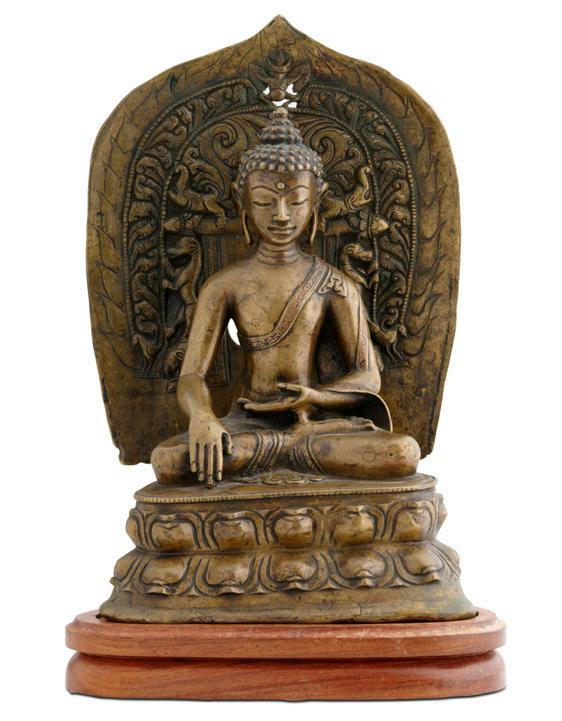
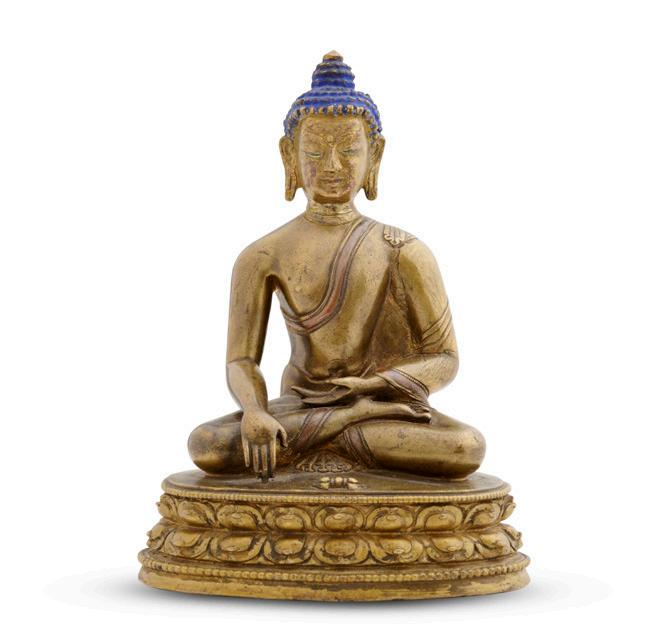
80
A RARE AND FINE WESTERN TIBETAN BRONZE AND COPPER-INLAID SEATED SHAKYAMUNI BUDDHA, 12TH/14TH CENTURY
This figure is seated in vajrasana on a lotus base, his right hand in humisparamudra, his left hand resting on his lap and with a separate mandorla behind him. The back of the Buddha inscribed with Tibetan scripts.
For a similar but smaller example (18cm high), see Christie’s New York, 21 March 2008, lot 592. Another related gilt smaller (14cm high) example, was sold at the same house on 21 September 2007, lot 185.
It’s with an original authentication certificate issued by Hollywood Galleries, Hong Kong, 27th January, 1999 (Certification No. 609).
Hollywood Galleries, Hong Kong, 1999, with certificate No. 609
25cm high (Buddha); 24.6cm high (mandola)
$4,000-$6,000
provenance
A private old collection, Toorak, acquired from Hollywood Galleries, Hong Kong, 27 Janurary, 1999, with an original certificate (No. 609).
$4,000-6,000
西藏西部十二至十四世紀 銅錯紅銅釋迦牟尼佛坐 像 附背光
佛陀結跏趺坐於蓮座,右手觸地印,左手禪定印, 背光另鑄,背部刻有藏文銘文,鑄工精細,保存完 好,為十四世紀藏傳佛教造像珍品。 源流: 墨爾本圖拉克資深私人舊藏,1999年購於香港東寶 齋藝廊,附帶原始證書(編號609)
81 A RARE AND FINE WESTERN TIBETAN BRONZE AND COPPER-INLAID SEATED AKSHOBHYA BUDDHA, 14TH/15TH CENTURY
The figure is seated in vajrasana on a lotus base, the vajra in front, his right hand in humisparamudra, and his left hand resting on his lap, the back is incised with a Tibetan script.
A very similar Buddha without lotus base from the same period, formerly in Robert H. Ellsworth collection, see Christie’s New York, 21 Sep. 2007, lot 180; another gilt example, see the same house, 16 Sep 2008, lot 522; A copper alloy Lama dated from the same period, see Bonhams New York, 14 March 2017, lot 3263.
It’s with an original authication certificate issued by Hollywood Galleries, Hong Kong, 27th January, 1999 (Certification No. 610).
16cm high
provenance
A private old collection, Toorak, acquired from Hollywood Galleries, Hong Kong, 27 January, 1999, with an original certificate (No. 610).
$4,000-6,000
西藏西部十四/十五世紀銅錯紅銅阿閦佛坐像 佛像結跏趺坐於蓮座,右手觸地印,左手禪定印, 座前置金剛杵,背部刻藏文銘文,造型莊嚴,為十 四/十五世紀藏傳佛教造像之佳例。
源流:
墨爾本圖拉克資深私人舊藏,1999年購於香港東寶 齋藝廊,附帶原始證書(編號610)
A FINE AND RARE KHASA MALLA
KINGDOM GILT BRONZE SEATED BUDDHA
SHAKYAMUNI, 14TH/15TH CENTURY
The figure is seated in vajrasana on a lotus-base with his right hand lowered in the bhumisparshamudra while the left is resting on his lap, wearing monastic garment including a mantle covering his left shoulder secured with a small section draped over this shoulder in the shape of a swallow’s tail, his face displaying a serene expression with downcast eyes below arched eyebrows running into his nose-bridge, raised urna at his fore-head, blue-coloured curled hair-dress continuing into the ushnisha and topped with a lotus-bud, resealed.
A similar bronze is preserved on the collection of the Hermitage published in ‘108 Images of Buddha‘, Museum of Anthropology and Ethnography (Peter the Great Kunstkamera), St. Petersburg, 2014, pp. 118-119, no. 5942-131.
12.8cm high
provenance
From a private collection, Bavaria, acquired from Schoettle East Asian Art 1969, no. 4672. An important private collection, NSW.
literature
Schoettle Ostasiatica, Stuttgart, Autumn 1969, no. 4672, p. 36
$5,000-7,000
卡薩瑪拉王國(14–15世紀,尼泊爾西部)銅鎏金釋 迦牟尼佛坐像
佛像結跏趺坐於蓮座之上,右手施觸地印,左手安 於膝上,身披袈裟,左肩覆以燕尾形披肩,面容寧 靜,雙目低垂,眉弓連鼻樑,額心飾白毫,青色螺 髮高聳成螺髻,頂飾蓮苞,底部封板。
類似作品藏於聖彼得堡人類學與民族學博物館(庫 恩斯特卡梅拉),出版於《佛陀的一百零八種形 象》,2014年,頁118–119,編號5942-131。
源流:
德國巴伐利亞私人收藏,1969年購自Schoettle東方
藝廊;
新南威爾士重要私人收藏。
出版:
Schoettle Ostasiatica,斯圖加特,1969年秋季,編 號4672,頁36。
83 A TIBETAN ELECTRUN AND COPPER-INLAID BRONZE FIGURE OF A LAMA, 15TH CENTURY
The figure’s eyes are inlaid with electrun, while the edges of the robe are highlighted with copper. The present bronze most likely portrays an important early lama, created during a period when Buddhism was flourishing and expanding in Tibet. The elaborate use of precious-metal inlays indicates that it was a significant commission. Notably, the curved edges of the shirt beneath the robe point to its early date, as square-edged shirts became the norm from the fourteenth century onward.
A very similar example, see Christie’s New York, 22 Sep 2021, lot 402.
13cm high
$3,000-5,000
西藏 十五世紀 銅錯銀嵌紅銅喇嘛像
類似例見紐約佳士得,2021年9月22日,拍品402 號。
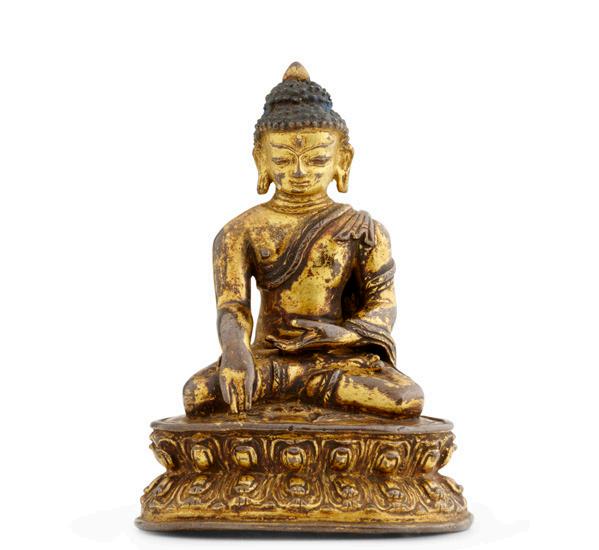
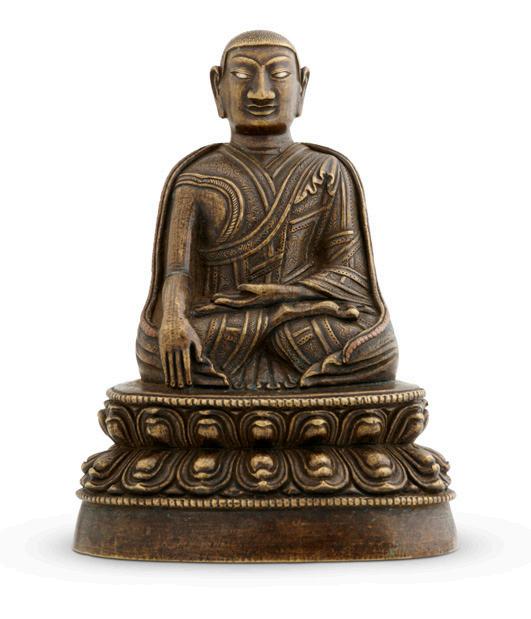
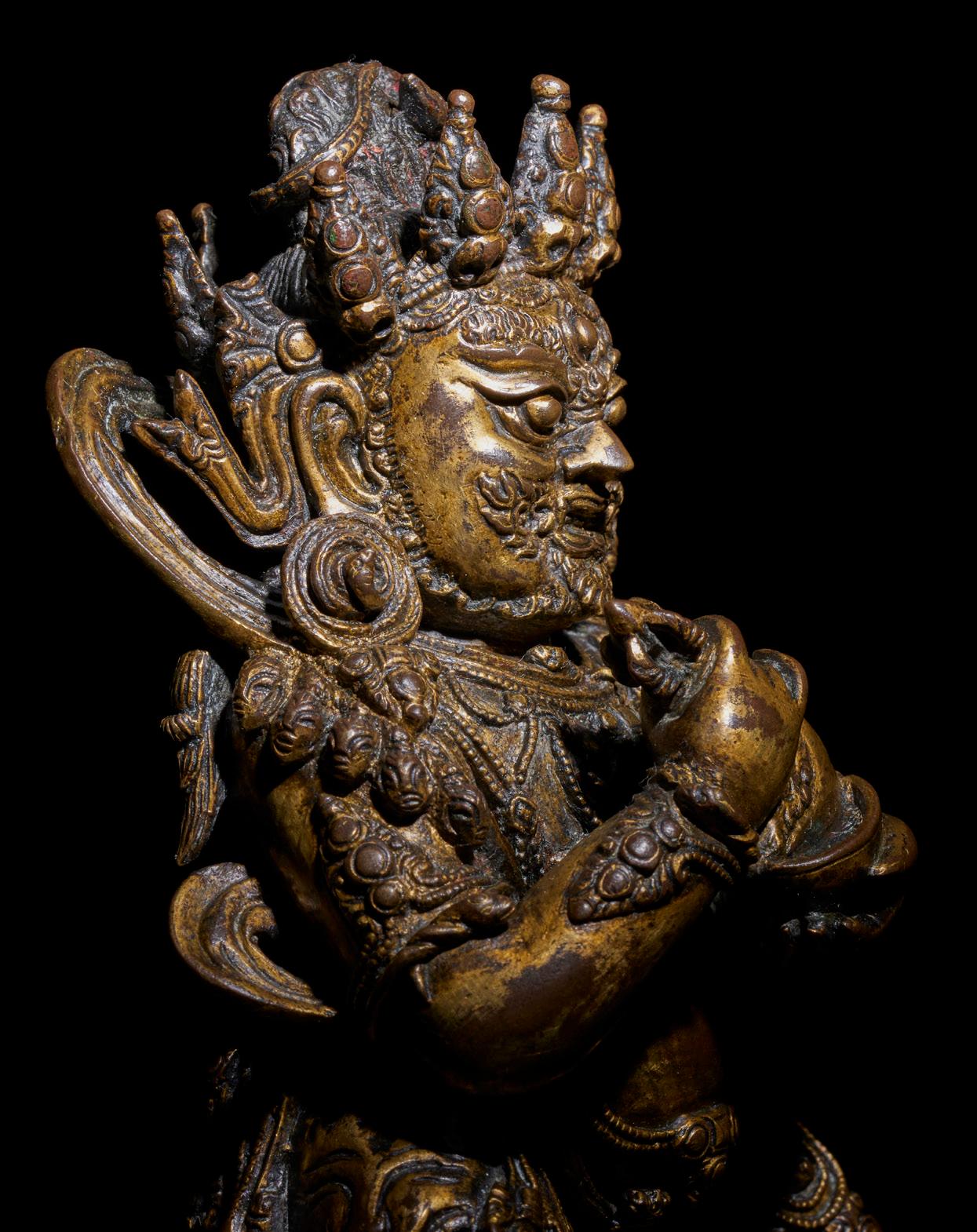
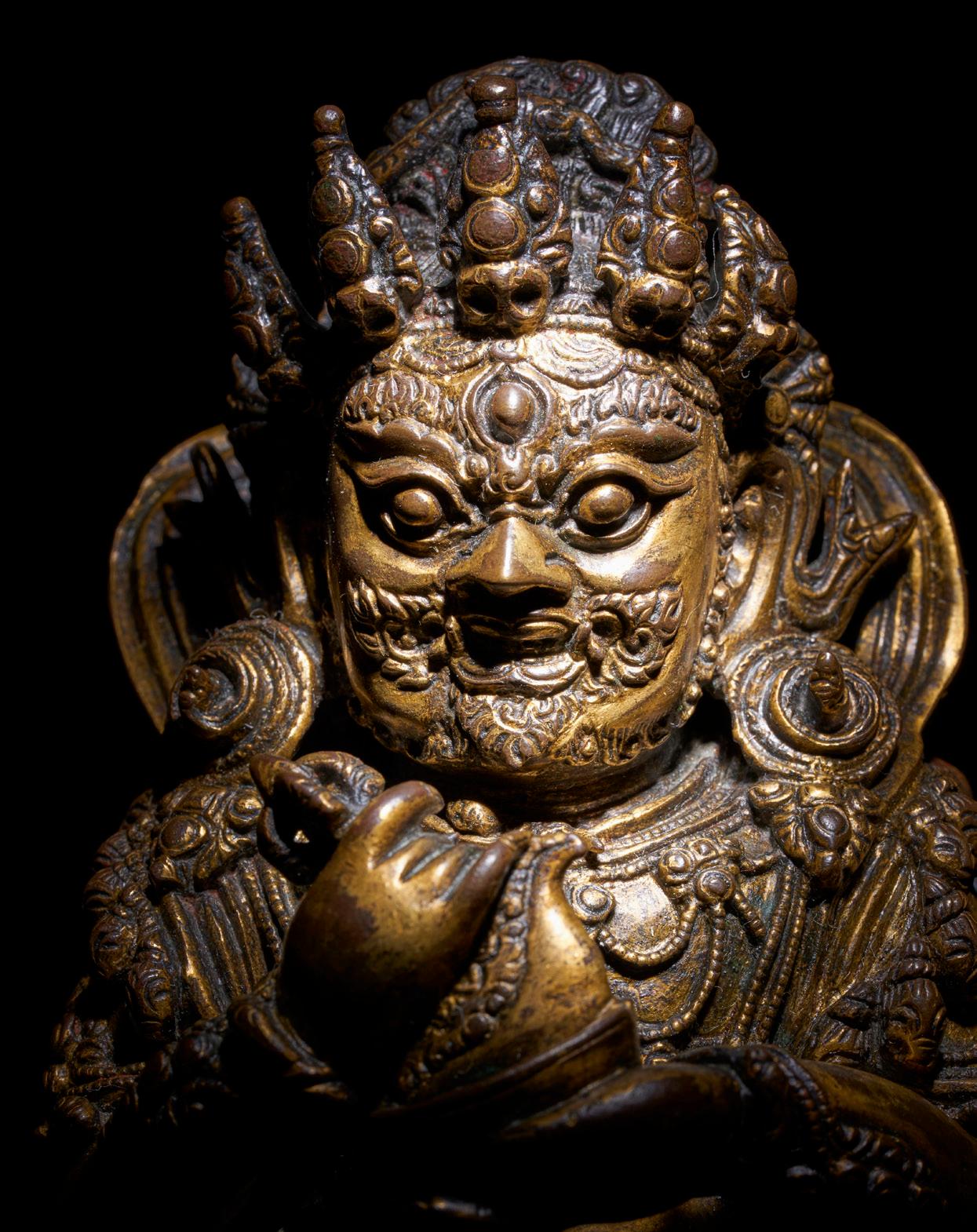
A RARE AND EXCEPTIONAL CHINESE GILTBRONZE SEATED FIGURE OF PANJARNATE MAHAKALA, MING DYNASTY, YONGLE/ XUANDE PERIOD, EARLY 15TH CENTURY
The crowned deity stands on a supine figure atop a double-lotus throne, wearing an elaborate apron and holding a skull cup in one hand. Finely cast with intricate detailing throughout. Panjarnata Mahakala is frequently, though not invariably, depicted balancing a baton (Gandhi) in the crooks of his arms-a feature from which all other manifestations of Mahakala are believed to originate. Nonetheless, even in the absence of the baton, the deity’s single face and two-armed wrathful form, wielding a kartri (ritual chopper) and kapala (skull cup), clearly identifies him as Panjarnata Mahakala, the revered “Lord of the Pavilion.” He serves as the principal protector of the Hevajra Tantra cycle within the Sakya School, and his iconography and ritual practices are documented in Chapter 18 of the Vajra Panjara Tantra, as well as Chapters 25 and 50 of the Mahakala Tantras.
Although the present figure lacks an inscribed reign mark, its style closely aligns with the imperial gilt-bronze sculpture produced during the Yongle and Xuande periods. A closely related gilt-iron figure bearing a Yongle mark is housed in the Palace Museum, Beijing, and published in Splendours from the Yongle and Xuande Reigns of China’s Ming Dynasty: Classics of the Forbidden City, Beijing, 2012, p. 247, no. 133. Another comparable Yongleperiod gilt-bronze figure is in the collection of the Potala Palace, Lhasa, illustrated in The Times and the Styles of Statues of Buddha in Chinese Buddhism, Beijing, 2010, p. 216, fig. 234. Further comparisons include a similar Panjarnata Mahakala figure, of nearly identical posture and attributed to the Yongle-Xuande period, which was sold at Christie’s Hong Kong on 30 May 2018, lot 2863, for HKD 12,100,000 (approximately AUD 2,365,900). Another slightly larger gilt-bronze example from the same period was sold at Christie’s Hong Kong on 29 May 2019, lot 2707, for HKD 9,245,000 (approximately AUD 1,807,665). Most notably, a larger example (72.5 cm high) bearing a Xuande mark was sold at Sotheby’s Hong Kong on 26 November 2024, lot 3815, for HKD 40,800,000 (approximately AUD 7,977,583). 19cm high; 14cm wide
provenance
The Julian Sterling Collection from the private collection of Robert Bleakley, Specialist of Tibetan and Indian art, Sotheby’s London, 1978-1982. Founding CEO and chairman of Sotheby’s Australia, 1982 - 1998.
Mossgreen Asian Art, Melbourne, 18 November 2013, Lot 177.
$120,000-200,000

明 永樂/宣德 銅鎏金般闍那尊大黑天坐像
此尊神像戴冠,立於仰臥人像之上,座於雙層蓮座 之上,身著華麗裙飾,一手持骷髏盃,鑄造精美, 細節繁複。
般闍那尊大黑天常見(但非必然)於臂彎處持杖 (Gandhi),此特徵被認為是其他大黑天化身的 起源。即使未持杖,其單面雙臂忿怒形象,持卡崔 (法斧)與卡缽拉(骷髏盃),仍可明確辨識為「 亭閣之主」般闍那尊大黑天。此尊為薩迦派《喜金 剛續》主要護法,其形象與儀軌記載於《金剛亭閣 續》第十八章及《大黑天續》第二十五與第五十 章。
雖此尊未刻年款,其風格與永樂、宣德年間宮廷 銅鎏金像極為相近。北京故宮藏一件永樂款鎏金 鐵像,刊載於《明代永宣盛世:故宮經典》,北 京,2012年,第247頁,編號133。布達拉宮藏另一 件永樂期銅鎏金像,見《中國佛教造像的時代與風 格》,北京,2010年,第216頁,圖234。 另有一件姿態幾近相同、斷代為永宣年間之般闍 那尊大黑天像,2018年5月30日於香港佳士得拍 賣,拍品2863,成交價港幣12,100,000元(約澳幣 2,365,900元)。2019年5月29日,另一件稍大之同 類像於香港佳士得拍賣,拍品2707,成交價港幣 9,245,000元(約澳幣1,807,665元)。最為矚目者, 為一件高72.5公分、具宣德款之大型像,2024年11 月26日於香港蘇富比拍賣,拍品3815,成交價港幣 40,800,000元(約澳幣7,977,583元)。
源流: 朱利安・斯特林收藏,原屬羅伯特・布萊克利私人收 藏,倫敦蘇富比西藏與印度藝術專家,1978–1982 年。澳洲蘇富比創辦人兼首席執行官,1982–1998 年。
墨爾本Mossgreen亞洲藝術,2013年11月18日,拍品 177。
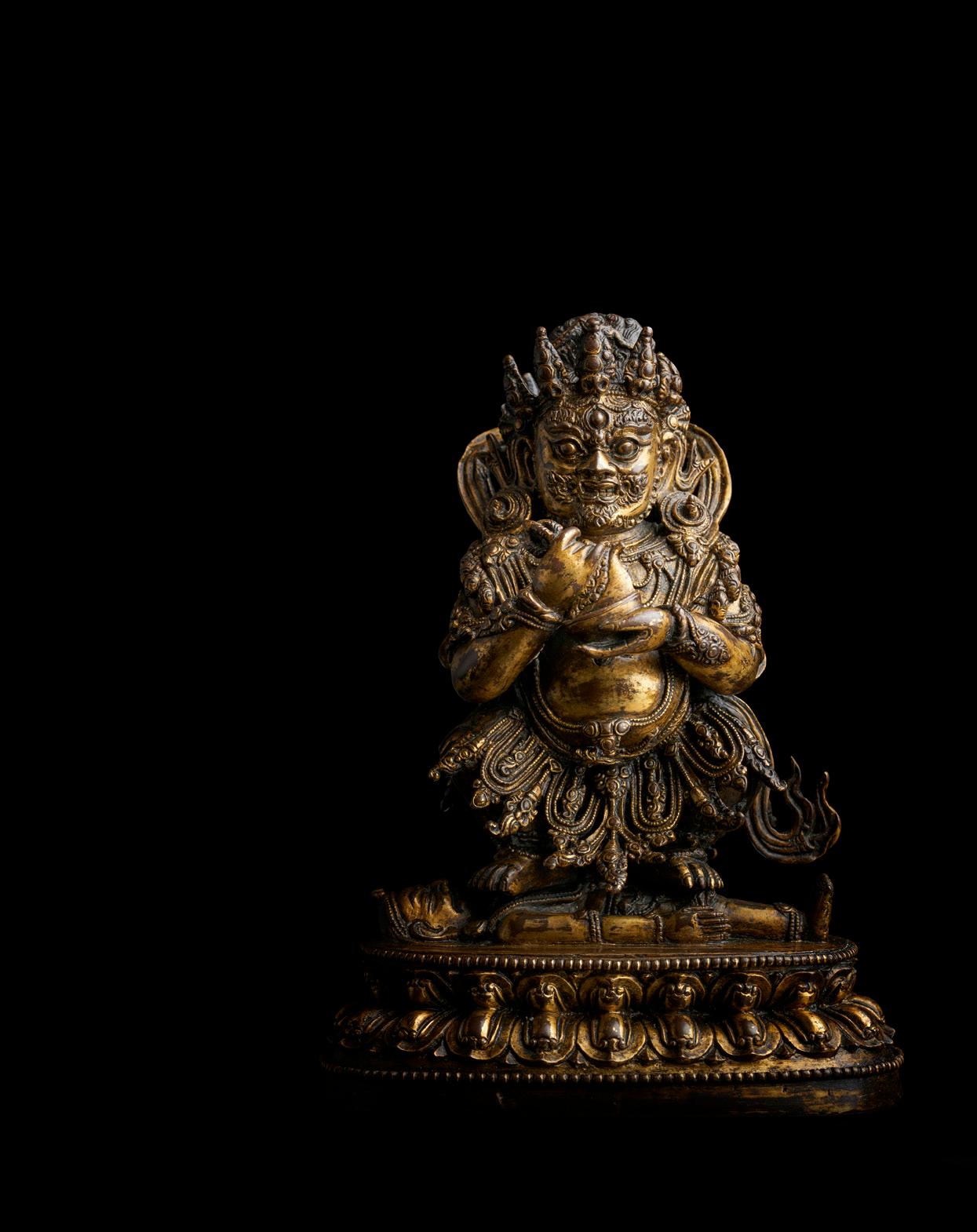
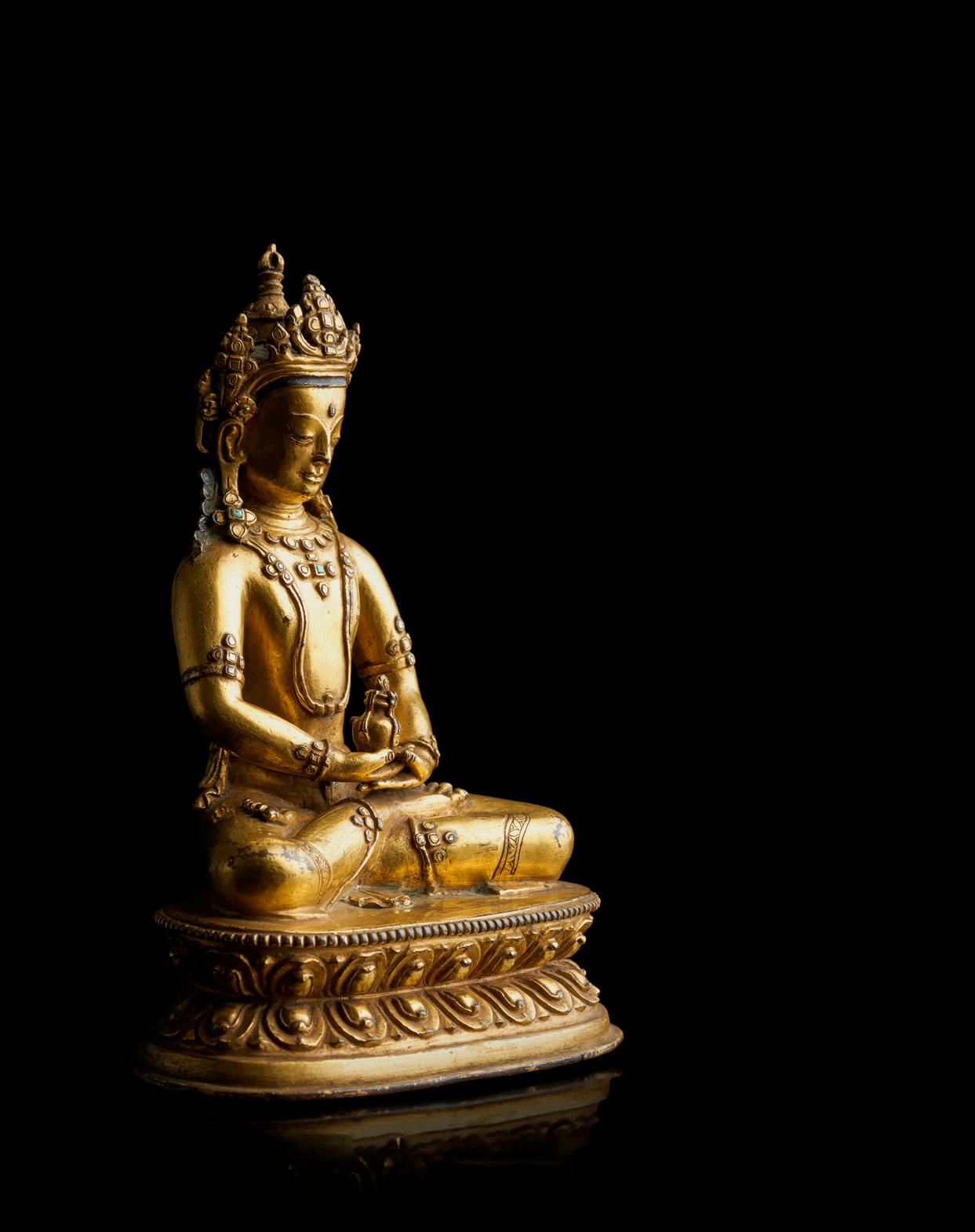
85
A VERY FINE AND RARE KHASA MALLA KINGDOM GILT BRONZE SEATED AMITAYUS BUDDHA, 14TH/15TH CENTURY
The deity is seated in dhyanasana on a double-lotus throne, hands in meditation mudra cradling a kalasa in the lap. The figure is richly adorned with beaded jewellery and large turquoise-inlaid earrings, the serene countenance marked by an urna beneath a five-point foliate tiara. The underside is incised with a double-vajra and left unsealed, preserving the original scroll-filled consecration cavity.
A much smaller seated figure of shadakshari dated to the same period, see Sotheby’s Hong Kong, 31 May 2019, lot 619.
20.5cm high
provenance
From a private Tasmanian collection, passed down by descent.
Bonhams Sydney, 22 March, 2015, lot 400.
$50,000-70,000
卡薩瑪拉王國(14–15世紀,尼泊爾西部)銅鎏金無 量壽佛坐像
佛像結跏趺坐於雙層蓮座之上,雙手結禪定印,懷 抱寶瓶,面容寧靜,頭戴五葉寶冠,飾以串珠與綠 松石耳環,底部未封,內藏原始裝藏,極為罕見。 源流:
塔斯馬尼亞私人舊藏,家族傳承;邦瀚斯悉 尼,2015年3月22日,拍品編號400。

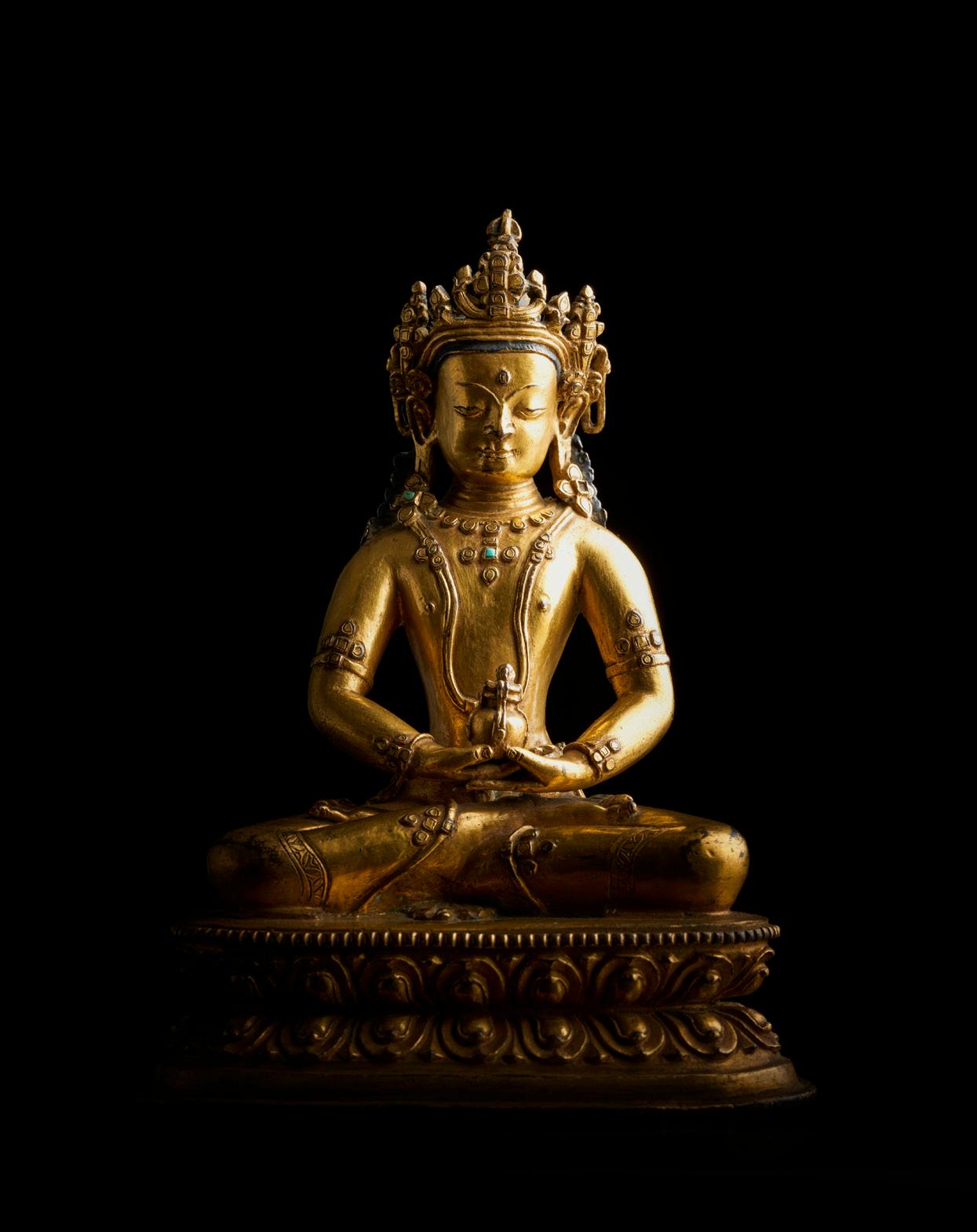
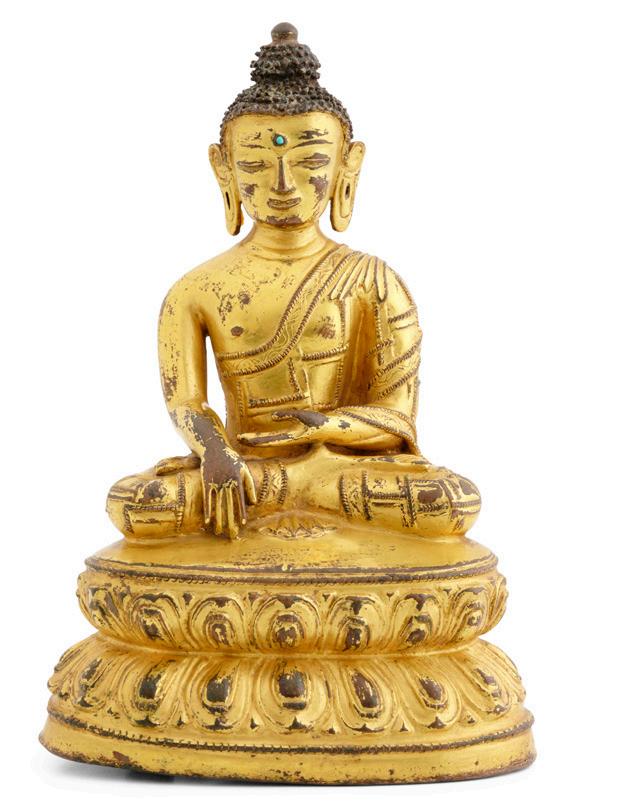
86 A FINE CENTRAL TIBETAN GILT-BRONZE SEATED FIGURE OF BUDDHA SAKYAMUNI, 15TH CENTURY
The Buddha is shown touching the earth calling the earth to witness his Enlightenment. This is the most seminal moment in Buddhism. The Buddha’s robes are shown in considerable detail - especially on the rear side where the ‘patchwork’ effect is shown. Indian ascetics were supposed to wear cast-off clothes for their robes to counter a sense of pride. As with many Buddha images his head is blue to reflect the cosmic vastness of his Enlightenment. This crisp and very finely made image still has its original sealed base showing a crossed power-bolt symbol and its blessed contents are still intact. (By Professor David Templeman, Monash University, Melbourne) 19cm high provenance
From an important private collection. Mossgreen Asian Art, Melbourne, 19 Nov. 2013, lot 176.
$30,000-50,000
十五世紀 西藏銅鎏金佛像
此尊佛像作觸地印,召大地見證其成道,此乃佛教 歷史上最具意義之時刻。佛衣刻畫細膩,尤其背部 袈裟呈現「拼接」效果。印度苦行者當穿舊衣作袈 裟,以抑制驕慢之心。與多數佛像相同,佛頭塗 藍,以象徵其覺悟的宇宙廣大。此尊造像線條清 晰、工藝精湛,底座仍為原封狀態,印有交叉金剛 杵符號,其內聖物完整未損。(墨爾本蒙納士大學 David Templeman教授)
源流:
Mossgreen,2013年11月19日,拍品編號176
87 A SINO-TIBETAN GOLD LACQUER ON SANDALWOOD CARVING OF YAMANTAKA, QING DYNASTY, 18TH CENTURY 15.8cm high
$5,000-7,000
清 十八世紀 漢藏風格金漆檀香木雕大威德金剛像
88 A TIBETAN GILT-BRONZE LOTUS BASE, MING DYNASTY (1368 - 1644)
15cm wide; 10cm high
$1,000-2,000
明 銅鎏金蓮花座
89 A SINO-TIBETAN GILT-LACQUERED BRONZE SEATED FIGURE OF GREEN TARA, LATE MING DYNASTY, 16H/17TH CENTURY
28cm high
$1,000-2,000
明晚期 銅漆金綠度母坐像
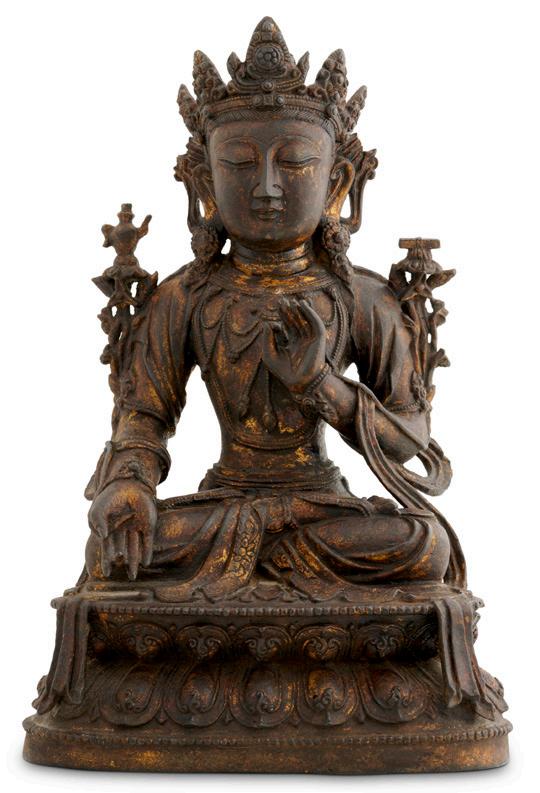
90 A LARGE AND FINE SINO-TIBETAN GILTLACQUERED BRONZE SEATED FIGURE OF AVALOKITESVARA, MING DYNASTY, 15TH/16TH CENTURY
32.5cm high
provenance
A private collection, Kyoto.
$6,000-8,000
明 十五/十六世紀 銅漆金觀音坐像
91 A LARGE NEPALESE BRONZE CAST FIGURE OF EIGHTEEN ARMED DANCING TARA, 16TH/17TH CENTURY
37.5cm high
$5,000-7,000
十六至十七世紀 尼泊爾銅鑄 十八臂樂舞度母像

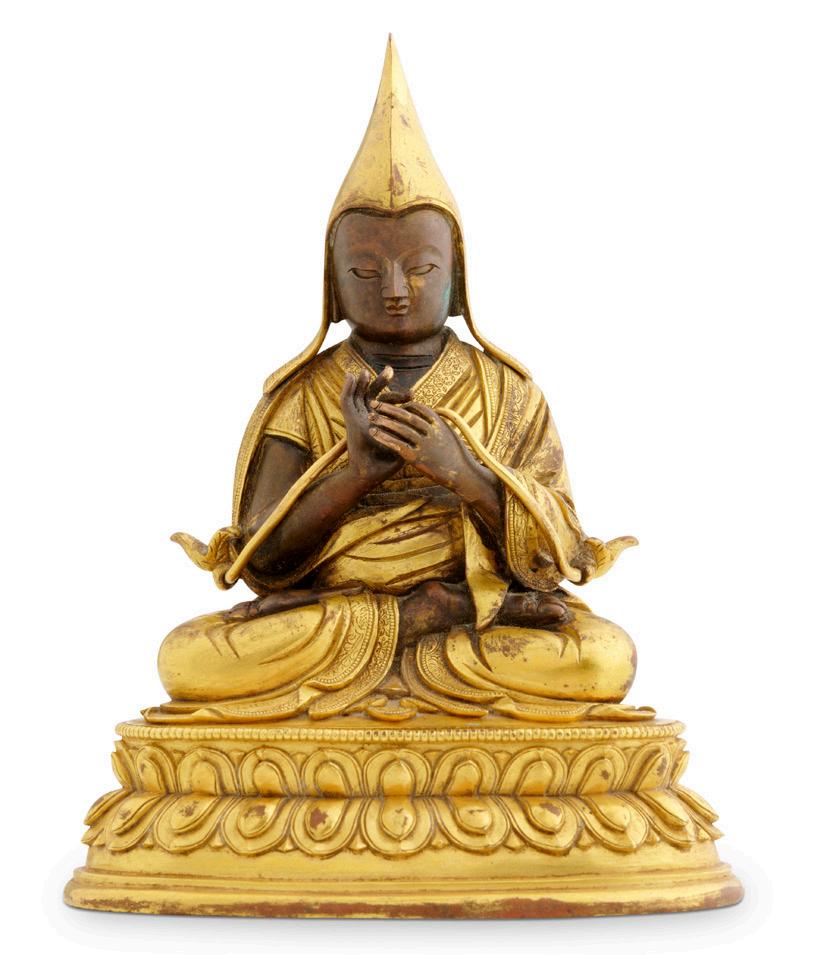
A SINO-TIBETAN GILT-BRONZE SEATED TSONGKHAPA, QIANLONG PERIOD (17361795)
A finely cast gilt-bronze figure of Tsongkhapa (13571419), shown in the gesture of teaching, with lotus stalks supporting the Perfection of Wisdom and the sword of wisdom. He wears the pointed scholar’s hat with long lappets, characteristic of the Gelug tradition he founded. The figure is crisply detailed and well balanced, with the sealed base preserving its original consecration.
15.5cm high
provenance
A private collection, Sydney.
$9,000-12,000
清乾隆 漢藏風格 銅鎏金宗喀巴坐像
此尊鎏金銅像為宗喀巴(1357–1419),作說法手
印,肘部蓮莖托持《般若波羅蜜經》經卷與斷除無 明之劍。頭戴蓮花型長耳帽,為其所創格魯派僧師 之典型服制。造像線條清晰、比例均衡,底座封 合,保持原始加持完好。
93
A NEPALESE GILT-BRONZE SEATED FIGURE OF NAMASANGITI, MID-LATE 19TH CENTURY/EARLY 20TH CENTURY 12cm high
provenance
A private collection, Sydney. $800-1,200
尼泊爾 十七/十八世紀 銅鎏金佛坐像
94 A CENTRAL TIBETAN BRONZE FIGURE OF YAMATAKA, 18TH CENTURY
The multi-headed six-armed Yamantaka is modelled in a striding stance upon a lotus base, with two of his hands crossed in front of his consort, holding a varja crescent and a skull cap. An elephant skin is draped around his back and his waist is tied with a chain of skulls.
This is just one of the forms in which Yamantaka‘Lord Slayer of Death’ - is depicted. In this powerful and motion-filled image we see Yamantaka clasping his consort Yamari in sexual union. However as with all things in tantric imagery this is not a sexual depiction but a representation of how the perfect union between the female aspect of wisdom and the male aspect of power are perfectly unified in the state of Enlightenment. In achieving this state what we regard as ‘death’ is fully overcome.
The items held in the many hands are all symbols for the mental states needed to fulfill the practice and he tramples all manner of symbolic hindrances under his feet - including all manner of animal life and minor non-Buddhist gods.
The image is very active and must be imagined seen in a Tibetan temple under flickering butter-lamp light where his power might appear to come ‘alive.’ The image’s base is sealed meaning it still possesses its original spiritual blessing and power. 19.8cm high
provenance
A private collection, Sydney. $8,000-12,000
藏中 十八世紀 銅大威德明王及明妃立像 此像所示,僅為大威德明王(Yamantaka,意譯「 降伏死主者」)諸多形態之一。於此動勢強烈、 充滿力量的造像中,大威德明王與明妃耶摩里 (Yamari)結合而立。然依密教圖像之義,這並 非世俗意義上的性愛描繪,而是象徵智慧(女性面 向)與力量(男性面向)於覺悟境界中圓滿合一。 於此圓滿合一之境界中,所謂「死亡」亦被徹底超 越。
其多臂所持之器,皆為修行圓滿所需心境之象徵; 其雙足踐踏各種象徵性障礙,包括諸多動物形象及 非佛教小神祇。此像氣勢動盪逼人,須想像其在西 藏寺院中,於酥油燈忽明忽暗的光影下觀之,其神 力幾乎彷彿栩栩欲生。造像底部仍為封合狀態,顯 示其原始供養聖物仍然完好,並持續保有靈驗與加 持力。(墨爾本蒙納士大學David Templeman教授)
95 A TIBETAN BRONZE ACAIALA, EARLY 19TH CENTURY 16.5cm high
$2,000-3,000
西藏 十九世紀早期 銅大黑天像
96 A EAST TIBETAN BRONZE SEATED MONK, EARLY 19 CENTURY 15.7cm high
$2,000-3,000
西藏東部 十九世紀早期 銅高僧坐像
97 A PAIR OF LARGE NAPLES STANDING FIGURES OF TARA, 18TH/19TH CENTURY 84.5 cm and 81cm high
$1,000-2,000
尼泊爾 十八/十九世紀 銅鎏金嵌寶石度母立像一對
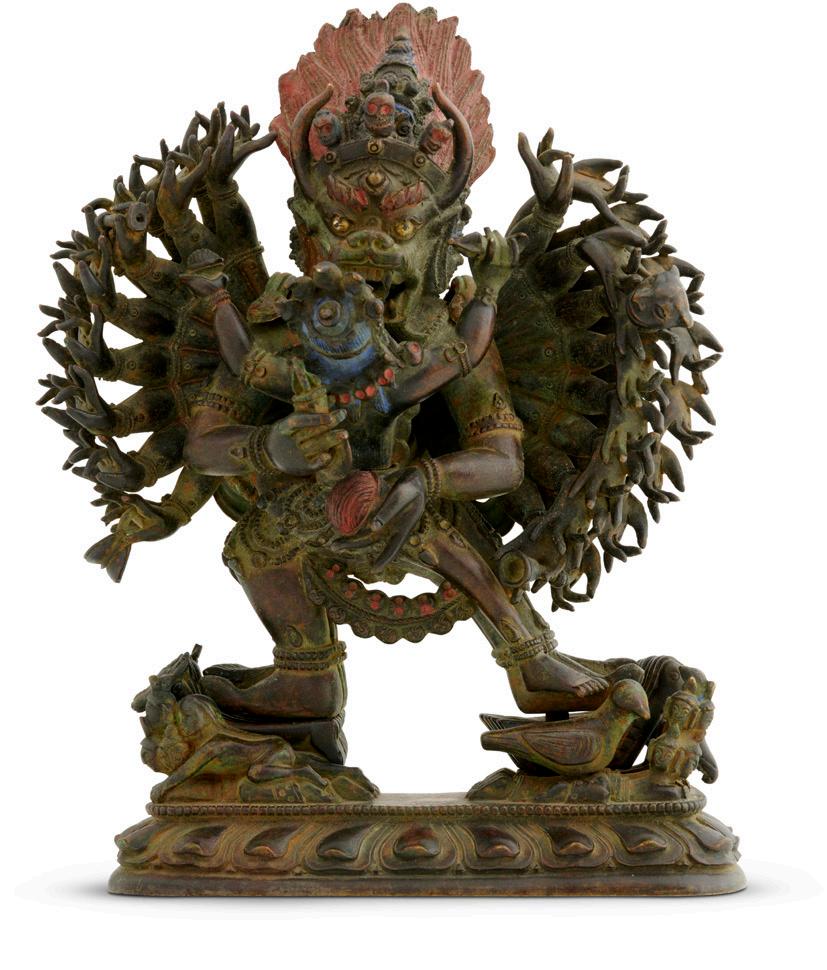
98 A GANDHARA GREY SCHIST STONE CARVING OF A MEDITATING BUDDHA AND TWO BODHISATTVAS, 3RD/4TH CENTURY
30cm high
$4,000-6,000
三/四世紀 犍陀羅 灰片岩雕禪定佛與二菩薩像
佛陀結跏趺坐於蓮座之上,雙目微闔,神情寧靜, 兩側侍立菩薩,衣褶自然,具濃厚希臘化風格,為 犍陀羅藝術代表作。
99
A KHMER SANDSTONE SEATED BUDDHA WITH NAGA, BAYON PERIOD,13TH CENTURY With an authentication certificate from Beyond The Masks, Thailand, 21st April, 2005, certificate no.: 2331/78.
31cm high
provenance
A private collection, VIC., acquired from Beyond The Masks, Bangkok, Thailand, with an authentication certification (no. 2331/78), 21st, April, 2005.
$600-800
柬埔寨 十三世紀 巴戎時期 高棉砂岩那迦護佛坐像
100 A RARE CHINESE BUDDHIST MARBLE TORSO, NORTHERN QI DYNASTY (550 - 557)
15.5cm high; 18.5cm on stand.
provenance
A private collection, A.C.T., acquired from Raymond and Victoria Tregaskis Oriental Art, Sydney. (with a copy of the original invoice, invoice no.: 0888)
$600-800
北齊 大理石佛身
源流:
澳洲堪培拉私人收藏,購自悉尼 Raymond and Victoria Tregaskis Oriental Art(附原始發票副本, 發票編號0888)
101
A LARGE GILT-LACQUER AND POLYCHROME BRONZE SEATED BUDDHA, POSSIBLY
15TH/16TH CENTURY
43cm high
provenance
Acquired from an old temple in Kyoto, Japan.
$8,000-12,000
或為十五至十六世紀 金漆彩繪銅佛坐像
源流:
京都古寺院舊藏
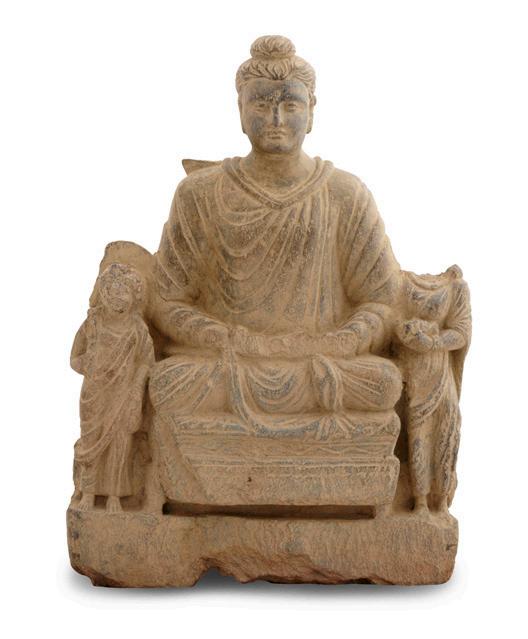
102
A FINE THAI BRONZE SEATED BUDDHA, SUKHOTHAI PERIOD (1238 - 1438)
11cm high
provenance
A private collection, A.C.T., acquired from Raymond and Victoria Tregaskis Oriental Antiques, Sydney, 2012.
$1,000-2,000
泰國 素可泰王朝 銅佛坐像
源流:
澳洲堪培拉私人收藏,2012年購自悉尼 Raymond and Victoria Tregaskis Oriental Antiques
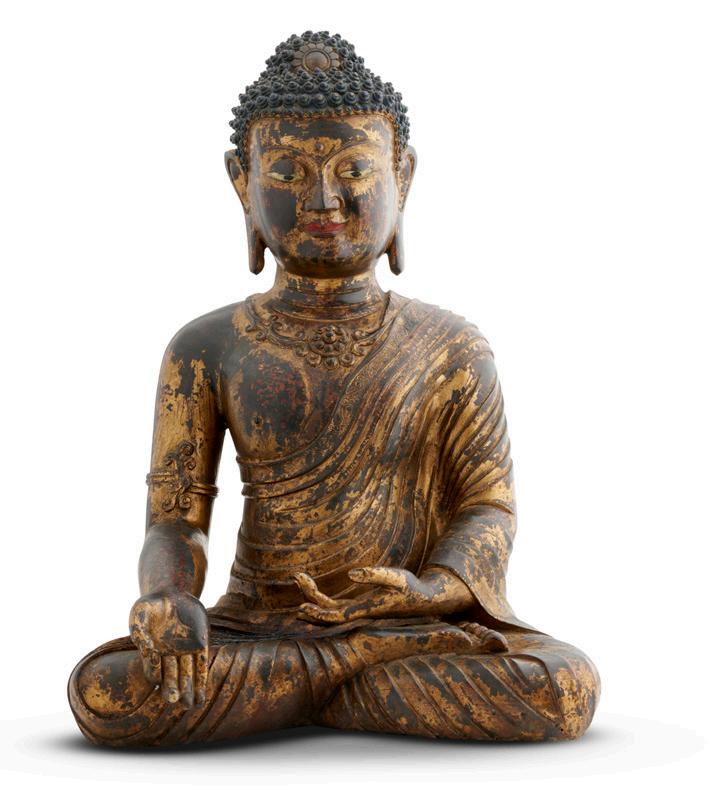
103 A LARGE CHINESE INLAID POLYCHROMELACQUERED WOOD SEATED FIGURE OF WATER AND MOON GUANYIN, MING DYNASTY, 16TH/17TH CENTURY
123cm high
provenance
Collection of Judith Heaven and the late Barrie Heaven, S.A.
A private collection, S.A.
$2,000-3,000
明 十六/十七世紀 木雕彩漆水月觀音坐像
源流:
南澳茱蒂絲・希文伉儷暨已故巴利・希文私人珍藏。
南澳私人收藏
104 A CHINESE GILT BRONZE SEATED FIGURE OF WATER AND MOON GUANYIN, POSSIBLY SONG DYNASTY
12cm high
$4,000-6,000
或為宋/金 銅鎏金水月觀音坐像
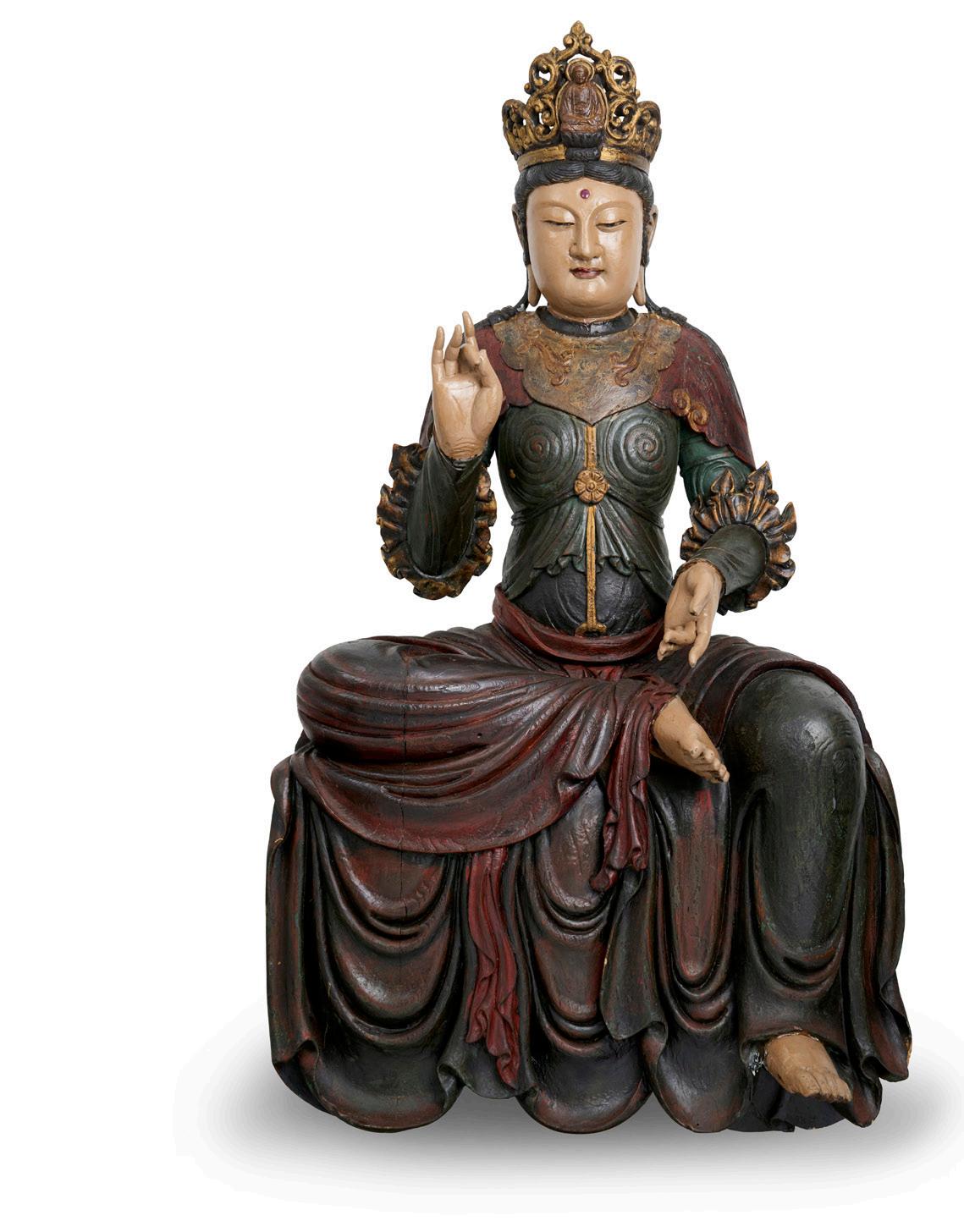

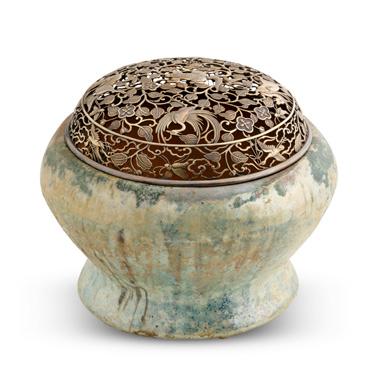
108
A CHINESE GREEN-GLAZED JAR, HAN DYNASTY (206 B.C. - 220 A.D.) with an old Japanese silver cover finely decorated in openwork with mythical beasts and scroll design; and with a Japanese wood box. 18.5cm diameter
provenance
Manno Musuem, Osaka, Japan (by repute)
$5,000-7,000
105
A CHINESE PAINTED POTTERY STANDING FIGURE OF AN OFFICIAL, NOTHERN WEI DYNASTY (386 - 535 A.D.)
With a wood stand.
27.3cm high
$600-800
北魏 彩陶仕官立俑 配木底座
106
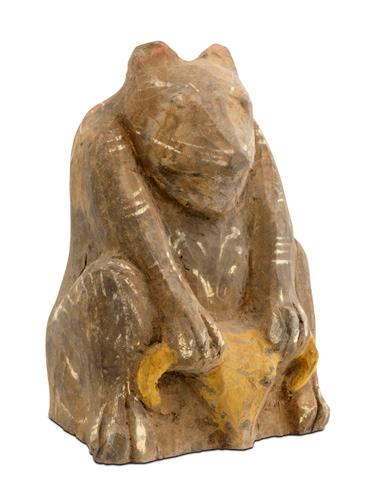
A CHINESE PAINTED POTTERY FIGURE OF A SEATED BEAR, HAN DYNASTY (206 B.C. - 220 A. D.)
For a similar example, please see J.J. Lally & Co., Early Dynastic China, New York, 1996, no.1.
19cm high
$2,000-3,000
漢 彩繪陶熊
陶質,熊作坐姿,形象生動,表面施彩,保存 良好。可參考J.J. Lally & Co.《Early Dynastic China》,紐約,1996年,編號1。
107
A LARGE CHINESE BLACK POTTERY OX, TANG DYNASTY (618 - 907)
21cm wide
provenance
Capital Gallery Hong Kong. A private collection, Sydney.
$3,000-5,000
唐 黑陶牛 源流:
香港長安美術; 悉尼私人收藏
漢 綠釉罐
配日本銀蓋,鏤空雕飾神獸與卷草紋,並附日本木 盒,保存完好,具古樸風韻。
109
A CHINESE XIANGZHOU CREAMY-WHITE GLAZED IRON DECORATED HANDLED JAR, SUI DYNASTY (581 - 618) 7.8cm diameter
provenance
A private collection, Hong Kong.
$2,000-3,000
隋 相州白釉褐彩提梁罐 源流: 香港私人收藏
110
A CHINESE XING CELADON CUP, SUI DYNASTY (581- 618)
10.2cm diameter; 7cm high
$500-800
隋 邢窯青瓷盃
111
A PAIR OF CHINESE WHITE GLAZED CUPS, TANG DYNASTY (618 - 907)
7.7cm diameter ; 5.8cm high and 7cm diameter; 5.5cm high
provenance
A private collection, Hong Kong.
$1,500-2,500
唐 白釉盃 一對 源流: 香港私人收藏
112
A VERY RARE CHINESE XING WHITE GLAZED JAR AND COVER, HANLIN MARK, TANG DYNASTY, 10TH CENTURY
The robustly-potted ovoid body is rising from a flat base to a short flaring neck, covered overall in an even white glaze, the similarly glazed domed cover surmounted by a knop finial, the base inscribed hanlin mark. With a fitted box.
Xing ware, produced in Hebei during the Tang dynasty (618-907), is renowned for its refined white glaze and technical sophistication. Two marks-Ying and Hanlin-are closely associated with court-commissioned Xing wares. The Ying mark is generally understood as shorthand for Da Ying Ku, meaning the “Repository of Great Abundance,” the palace storehouse to which jars would have been sent as tribute. In contrast, pieces bearing the Hanlin mark are much rarer. This mark denotes the prestigious Hanlin Academy, an elite institution of the imperial court, and implies either an imperial commission or use in official or scholarly contexts rather than ordinary domestic consumption. Together, these marks highlight the exceptional craftsmanship of Xing kilns and their close connection to Tang imperial administration.
A particularly distinctive feature of this jar is the faint traces of the Ying mark beneath the later Hanlin inscription, suggesting that the craftsman may have initially intended to inscribe it with Ying but, for unknown reasons, ultimately replaced it with the Hanlin mark.
Another almost identical jar also with Hanlin mark, in the PBS Arts Foundation, see A Symphony of Colours: Chinese Ceramics From Six Dynasties to Yuan Dynasty, 2024, pp.174 – 175. 19.5cm high
provenance
Collection of Ben Ng., Pan Pacific Arts Co., Hong Kong.
Collection of Allan Rae, Sydney.
$35,000-55,000
唐 十世紀 邢窯白釉「翰林」款蓋罐 器形碩壯,橢圓腹由平底起,頸部短而外撇,通體 施均勻白釉,蓋呈圓頂形,頂飾鈕,底部刻「翰 林」款。附盒。
邢窯為唐代(618–907年)河北著名窯口,以其潔 白釉色與高超技藝著稱。常見「盈」與「翰林」兩 款,前者為「大盈庫」簡稱,為宮廷貢品所藏之 處;後者則極為罕見,代表翰林院,為帝王近臣與 文士機構,顯示此類器物或為御製,或供文士使 用,非尋常民間器。兩款皆彰顯邢窯與唐代宮廷之 密切關係與卓越工藝。
此罐尤為特出之處,在於「翰林」款下隱約可見「 盈」字痕跡,或為工匠原擬刻「盈」款,後改為「 翰林」,其原因未明。
一件與此蓋罐相似的作品,同樣底部刻有「翰林」 款,現藏於桃花源藝術基金會,見其2024年出版的 《彩:六朝至元代的中國瓷器》,頁:174-175。
源流:
宋瓷古美術,香港; 悉尼Allan Rae收藏。 112
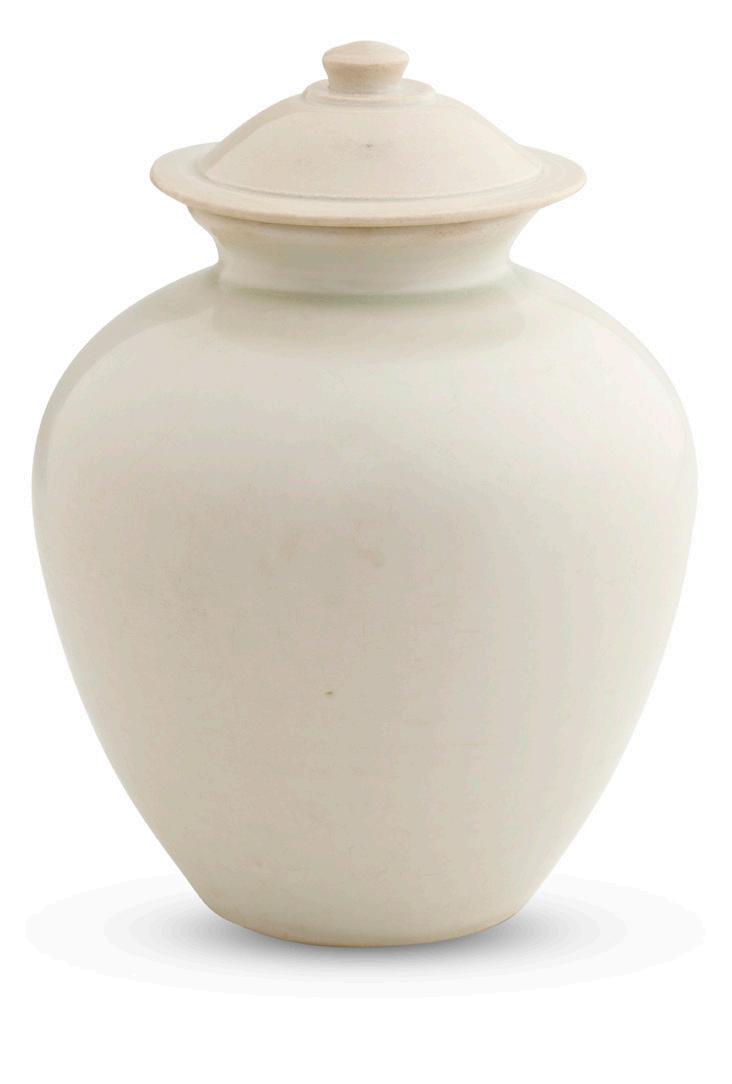
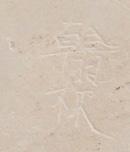

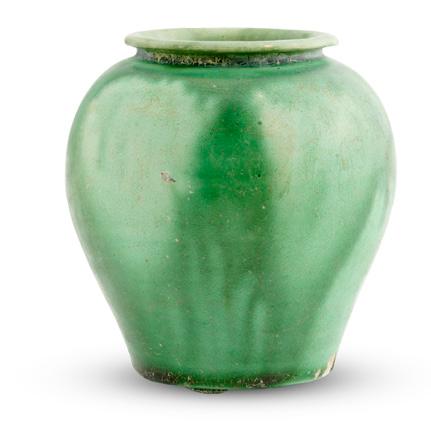

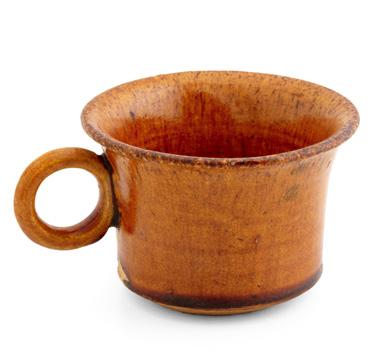
113
A PAIR OF CHINESE WHITE GLAZED CUPS, TANG DYNASTY (618 - 907)
7cm diameter; 5.2cm high
provenance
A private collection, Hong Kong.
$1,000-2,000
唐 白釉盃 一對 源流: 香港私人收藏
114
A RARE GONGXIAN WHITE RIM DARK GLAZED BOWL, ZISUBO, TANG DYNASTY (618 - 960)
9cm diameter; 4.3cm high
$3,500-5,500
唐 淄素缽
115
A CHINESE GREEN-GLAZE JAR, TANG DYNASTY (618 - 907)
7.5cm high
$1,000-2,000
唐 綠釉罐
116
A CHINESE YELLOW-GLAZED HUREN FORMED WHISTLE, TANG DYNASTY (618907)
6cm high
provenance
A private collection, Hong Kong.
$2,000-3,000
唐 黃釉胡人哨 源流: 香港私人收藏。
117
A CHINESE YELLOW GLAZED CUP, TANG DYNASTY (618 - 907)
7.2cm diameter; 5cm high
provenance
A private collection, Hong Kong.
$3,000-5,000
唐 黃釉盃 源流: 香港私人收藏
118
A VERY RARE CHINESE AMBER-GLAZED POTTERY ‘DRAGON’ RHYTON CUP, TANG DYNASTY (618 - 907)
See Bonhams London, 11 May 2021, lot 63 for a similar rhyton cup with a duck form.
14.5cm wide; 7cm high
$18,000-35,000
唐 黃釉龍首來通杯
119
A CHINESE XIANGZHOU CREAMY WHITE GLAZED BUTTERFLY BOX AND COVER, TANG DYNASTY (618 - 907)
6.8cm diameter
provenance
A private collection, Hong Kong.
$6,000-8,000
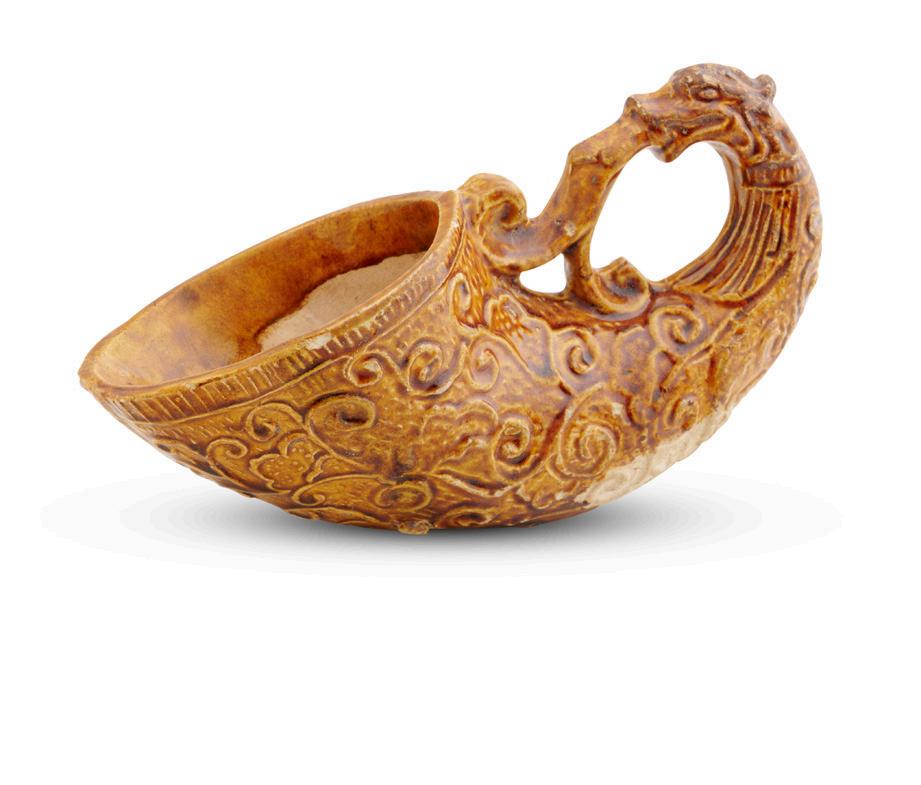
唐 相州窯白釉點褐彩 「蝴蝶」蓋盒
源流:
香港私人收藏
120
A CHINESE YUEYAO CELADON BOX AND COVER, TANG DYNASTY (618 - 907) 11cm diameter; 9.8cm high
provenance
A private collection, Hong Kong.
$6,000-8,000
唐 越窯青釉蓋盒
源流:
香港私人收藏
121
A SMALL CHINESE YUE YAO CELADON BOX AND COVER, TANG DYNASTY (618 - 907)
5.2cm diameter
provenance
A private collection, Hong Kong.
$2,000-3,000
唐 越窯青釉小蓋盒
源流:
香港私人收藏
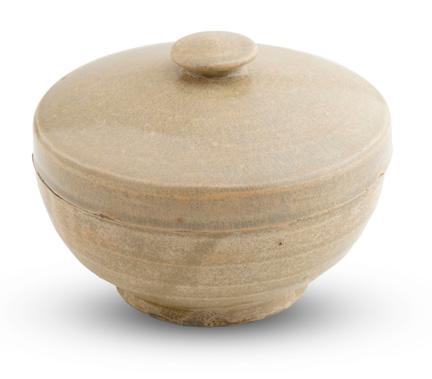
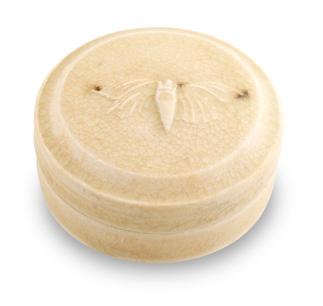

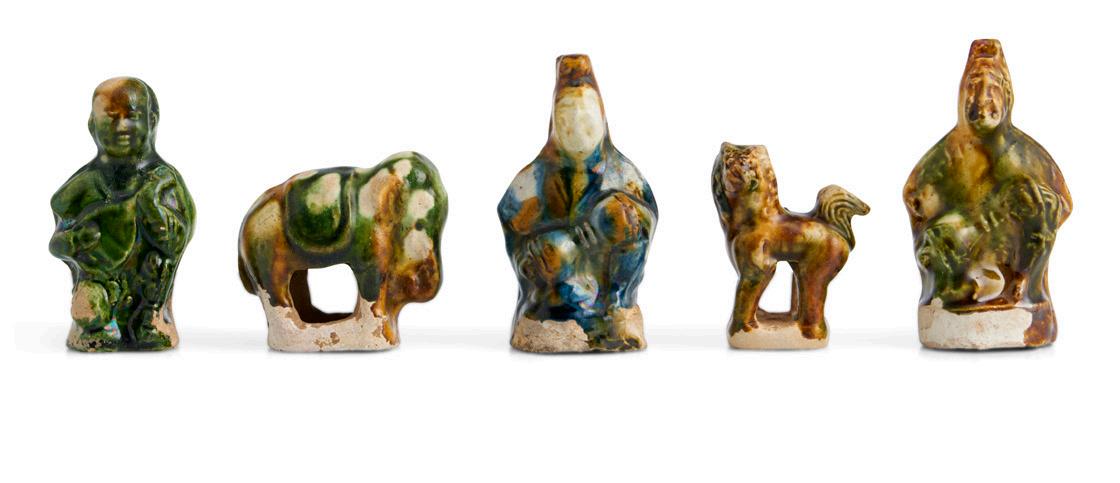

122
A CHINESE SANCAI GLAZED CUP, TANG DYNASTY (618 - 907)
5cm high
provenance
A private collection, Hong Kong.
$5,000-7,000
唐 三彩盃 源流: 香港私人收藏。
123
A GROUP OF FIVE CHINESE SANCAI MINIATURES, TANG DYNASTY (618 - 907)
Largest: 7.5cm high
$4,000-6,000
唐 三彩迷你樂師俑與獸俑五件一組
124
A RARE CHINESE YELLOW-GLAZE FIGURE OF A DWARF, TANG DYNASTY (618 - 907) with a Japanese wood box. 10.2cm high
$700-800
唐 黃釉侏儒俑 附日本木盒
125
A CHINESE BLUE AND WHITE PHOENIX AND PEONY JAR, KANGXI PERIOD (1662 - 1722)
21cm diameter; 15cm high
provenance
A private collection of a lady, Canberra, acquired in Beijing China between 1976 and 1981.
$1,000-2,000
清康熙 青花鳳穿牡丹紋罐
源流:
坎培拉女士私人收藏,1976至1981年間購藏北京。
126 A PAIR OF CHINESE BLUE AND WHITE ‘PHOENIX’ JARS, KANGXI PERIOD (1662 - 1722) 12cm high
provenance
A private collection of a lady, Canberra, acquired in Beijing China between 1976 and 1981.
$800-1,200
清康熙 青花鳳紋罐 一對
源流:
坎培拉女士私人收藏,1976至1981年間購藏北京。
127
A CHINESE BLUE AND WHITE ‘SQUIRREL AND VINE’ MELON-SHAPED JAR CHINA, WANLI PERIOD (1573-1619)
The jar is potted in lobed form, decorated with fruiting vines and a squirrel, with stiff leaf bands to the shoulder and lower body, the neck with a geometric band.
A similar example see Christie’s New York, 28 Mar 2024, lot 157.
16cm high
provenance
A private collection of a lady, Canberra, acquired in Beijing China between 1976 and 1981.
$1,500-2,500
明萬曆 青花松鼠葡萄紋瓜形罐
此罐呈瓜形,施青花繪松鼠與葡萄紋,肩部與下腹 飾以硬葉紋,頸部繪幾何紋。高16公分。類似例見 2024年3月28日紐約佳士得拍賣,拍品編號157。
源流:
坎培拉女士私人收藏,1976至1981年間購藏北京。

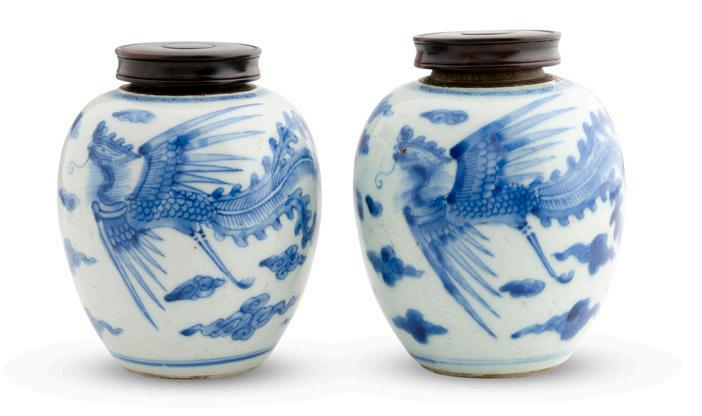
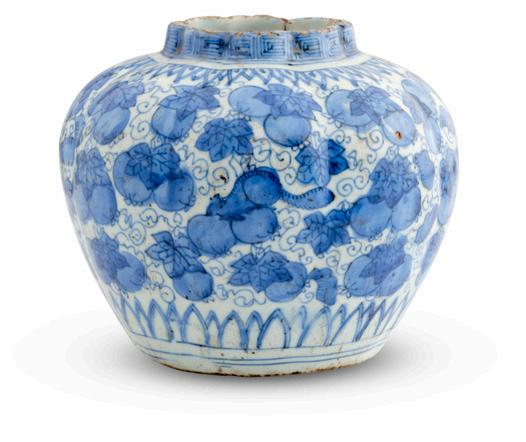
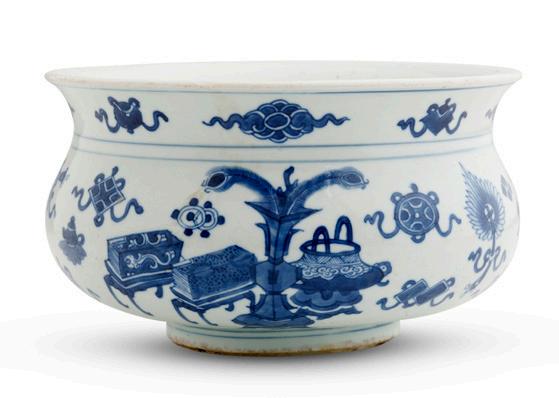
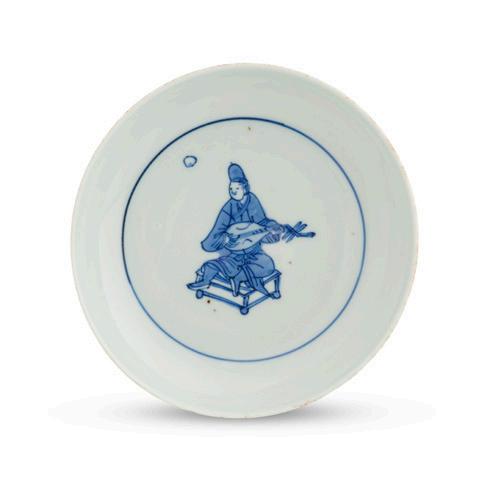
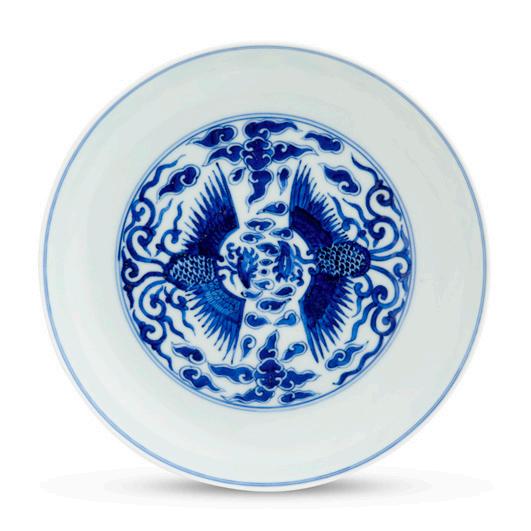
128
A CHINESE FAMILLE ROSE ‘SANDUO’ FOLIATE RIM BOWL, 19TH CENTURY
The base is with a four-character apocryphal chenghua mark in iron red.
20.3cm diameter
provenance
A private collection of a lady, Canberra, acquired in Beijing China between 1976 and 1981.
$800-1,200
十九世紀 「成化年製」款 「多子多福多壽」粉彩 花口盌
源流:
坎培拉女士私人收藏,1976至1981年間購藏北京。
129
A CHINESE BLUE AND WHITE ‘ONE HUNDRED ANTIQUES’ CENSER, KANGXI PERIOD (1662 - 1722)
It’s of bombe form, the sides painted in inky cobalt with a selection of antiquities and beribboned ‘eight auspicious emblems’ all between single bands above and below, the neck with further beribboned symbols alternating with floral boughs between single-band borders, the recessed base with a double circle.
A similar example, see Bonhams Los Angeles, 16 Dec. 2021, lot 36; also see Sotheby’s New York, 15 Sep. 2018, lot 1025.
20.4cm diameter; 12cm high
provenance
A private collection, VIC.
$1,000-2,000
清 康熙 青花博古紋香爐
130
A CHINESE BLUE AND WHITE SAUCER, TIANQI PERIOD (1621 - 1627)
Finely decorated on the interior with a seated musician playing lute, an underglaze blue studio mark to the base.
14cm diameter
provenance
Gladys Shead Collection.
A private collection, ACT., acquired from Raymond and Victoria Tregaskis Oriental Antiques, 17 Feb. 2000 (With copy of the original receipt, receipt no.0761)
$1,000-2,000
明天啟 青花人物紋小碟 源流:
Gladys Shead Collection;
澳洲堪培拉私人收藏,於2000年2月17日購自悉尼 Raymond and Victoria Tregaskis Oriental Antiques( 附原始發票副本,發票編號0761)
131
A CHINESE BLUE AND WHITE PHOENIX DISH, GUANGXU SIX-CHARACTER UNDERGLAZED BLUE MARK AND OF THE PERIOD (1875 - 1908)
18.5cm diameter
$2,000-3,000
清 「大清光緒年製」款及本朝 鳳紋盤
132
A CHINESE BLUE AND WHITE DISH, KANGXI PERIOD (1662 - 1722)
16.4cm diameter
$600-800
清康熙 青花盤
133 A SMALL CHINESE BLUE AND WHITE DRAGON CUP, GANGXU SIX-CHARACTER UNDERGLAZE MARK AND OF THE PERIOD (1875 - 1908)
6cm diameter; 4cm high
$800-1,200
清 「大清光緒年製」款及本朝 青花小盃
134
A CHINESE BLUE AND WHITE BIRD AND FLOWER JAR, SHUNZHI PERIOD (1644 - 1661)
26cm high
$1,500-2,500
清順治 青花花鳥紋罐
135 A LARGE CHINESE BLUE AND WHITE DISH, YUTANGJIAQI MARK, SHUNZHI PERIOD (1644-1661)
The dish is finely painted with the ‘The Disturbance at the Temple Altar’ scene from The Story of the Western Wing, the base inscribed with a fourcharacter Yutang Jiaqi seal mark within a double circle.
A dish with similar decoration, is published in The Many Faces of Life: Porcelain of the 17th Century, Blue and White Porcelain with Narrative Scenes, Part I, table 2, no. 1, p. 22. An other similar dish dated to the same period, see Bonhams London, 10 July 2006, lot 105.
35.5cm diameter
provenance
A private collection, Toronto, Canada.
$6,000-8,000
清順治 青花「西廂記 祭壇風波」圖大盤,御堂 佳器款
盤面精繪《西廂記》中「祭壇風波」場景,底部雙 圈內書「御堂佳器」四字印款。
類似器見《多面人生:十七世紀青花敘事瓷》,第 一部,表二,編號 1 ,頁 22 ;另見 2006 年 7 月 10 日 倫敦邦瀚斯拍賣,第 105 號拍品 源流:
加拿大多倫多私人收藏
136
A CHINESE BLUE AND WHITE JAR, KANGXI PERIOD (1662 - 1722)
25cm high
provenance
An important private collection, Melbourne. $3,000-5,000
清康熙 青花山水高士紋罐
137
A CHINESE BLUE AND WHITE DRAGON VASE, KANGXI MARK, QING DYNASTY (1644 - 1911)
10cm high
$1,000-2,000
清 康熙款 青花龙紋瓶
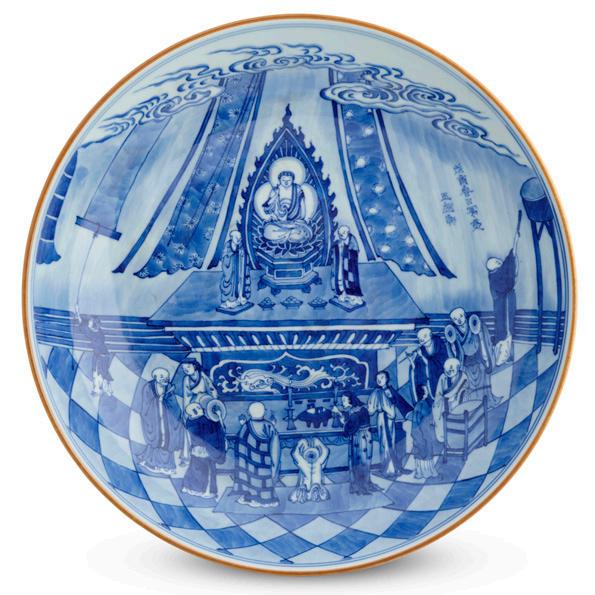
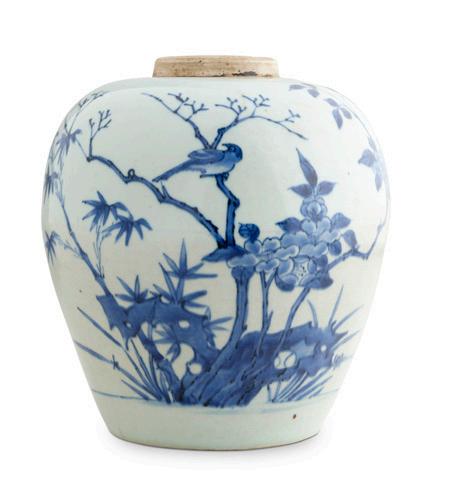
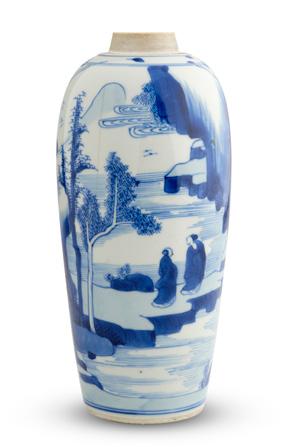
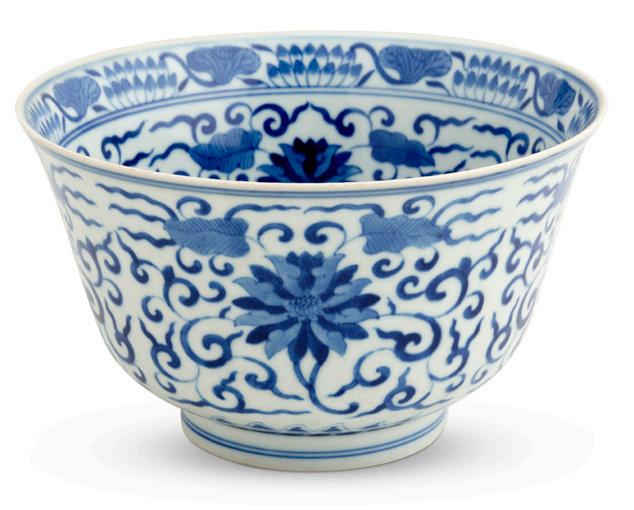
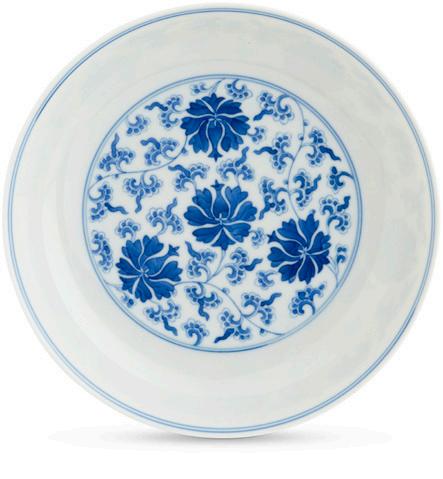
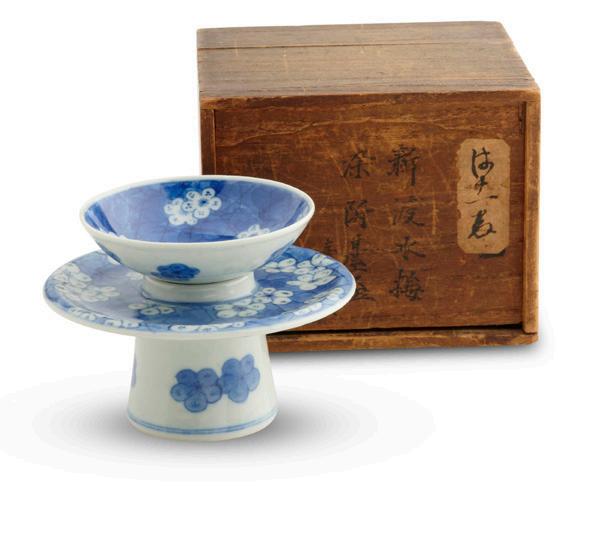
138
A CHINESE BLUE AND WHITE DISH, QIANLONG SIX-CHARACTER UNDERGLAZE SEAL MARK AND OF THE PERIOD (1736 - 1795)
The dish is decorated in the center with a stylized design of three mallow blooms encircling a central bloom, all borne on an undulating foliate stem within double lines repeated at the rim, the exterior with a similar continuous floral scroll.
A similar dish, see Sotheby’s New York, 19 Mar. 2014, lot 469.
20cm diameter
$6,000-8,000
清「大清乾隆年製」款及本朝 青花盤 盤形端正,青花發色濃艷,底書「大清乾隆年製」 六字款,為乾隆時期官窯器
139 A RARE AND FINE CHINESE BLUE AND WHITE CUP AND CUP STAND, JIAQING MARK AND OF THE PERIOD (1796 - 1820)
Both the cup and the cup stand are finely decorated with cracked-ice and prunus, the base of the cup is with a four-character jiaqing mark, the stand is with a six-character jiaqing mark. It’s with an old Japanese wood box.
Overall: 10cm high
provenance
An old private family collection, Kyoto, Japan. Kunryudo Ltd., Tokyo, Japan, with an original purchase receipt.
$2,500-3,500
清 嘉慶款及本朝 青花冰梅紋盃及盃托一組 盃底四字款,托底六字款,配舊日本木盒 源流: 日本京都老家族舊藏; 日本東京薫隆堂,附原始購買收據
140
A FINE AND LARGE CHINESE BLUE AND WHITE “FLORAL” BOWL, TONGZHI SIXCHARACTER MARK IN UNDERGLAZE BLUE AND OF THE PERIOD (1862-1874) 20cm diameter; 11.5cm high
provenance
A private collection, Sydney. $10,000-20,000
清 「大清同治年製」青花六字款及本朝 青花花卉
紋盌
盌形碩大,青花發色濃艷,繪花卉紋飾,構圖繁而 不亂,底書青花「大清同治年製」六字款,為同治 官窯佳器。
源流:
悉尼私人收藏
141
A CHINESE BLUE AND WHITE DRAGON VASE, YUAN DYNASTY (1271 - 1368)
24cm high
$2,000-3,000
元 青花龍紋瓶
142
A CHINESE BLUE AND WHITE AND COPPERRED VASE, GUANG XU SIX-CHARACTER UNDERGLAZE BLUE MARK AND OF THE PERIOD (1875 - 1908)
26cm high
$2,500-3,500
清「大清光緒年製」款及本朝 青花釉裏紅賞瓶 瓶身以青花與釉裏紅繪飾祥雲與龍紋,色彩對比鮮 明,底書「大清光緒年製」六字款,為光緒官窯佳 作。
143
A CHINESE BLUE AND WHITE BRUSH POT, POSSIBLY TRANSITIONAL PERIOD, 17TH CENTURY
18.2cm high
$3,000-5,000
或為明清過渡期 青花筆筒
144
A LARGE CHINESE BLUE AND WHITE DISH, YUTANGJIAQI MARK, SHUNZHI PERIOD (1644-1661)
The dish is finely painted with the ‘Honored Homecoming’ scene from The Story of the Western Wing, the base inscribed with a four-character Yutang Jiaqi seal mark within a double circle.
A smaller dish (33.2 cm in diameter) with nearly identical decoration is published in The Many Faces of Life: Porcelain of the 17th Century, Blue and White Porcelain with Narrative Scenes, Part I, no. 46, pp. 108–109. Another closely related example of the same period was sold at Bonhams London, 10 July 2006, lot 105.
36.7cm diameter
$6,000-8,000
清順治 「御堂佳器」款 青花「西廂記 榮歸故里」 圖大盤 類似器見《多面人生:十七世紀青花敘事瓷》,第 一部,編號46,頁108–109;另見2006年7月10日倫 敦邦瀚斯拍賣,第105號拍品。
145 A FINE CHINESE BLUE AND WHITE BOWL, DAOGUANG SIX-CHARACTER SEAL MARK IN UNDERGLAZE-BLUE AND OF THE PERIOD (1821-1850)
The exterior is finely decorated with auspicious animals amid cresting waves, while the interior is centered with a depiction of a flying dragon. 21.4cm diameter; 9cm high
$2,500-3,500
清 「大清道光年製」款及本朝 青花龍紋盌
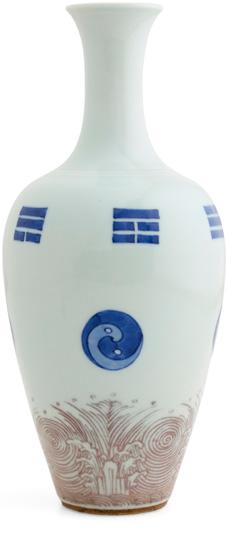
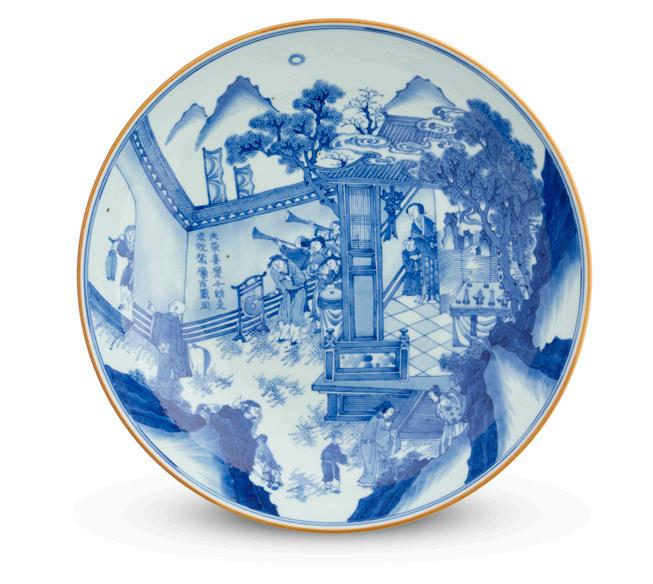
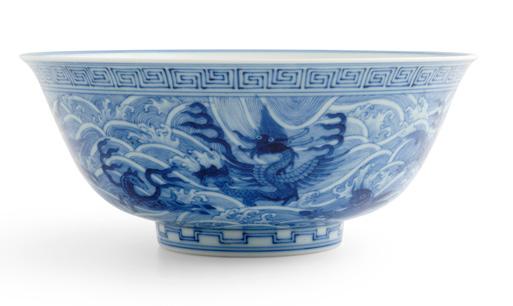
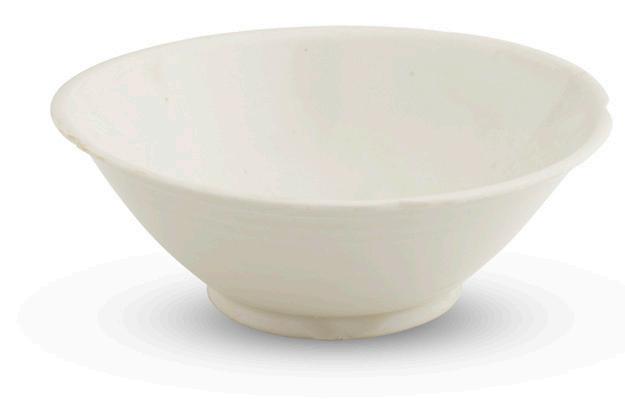
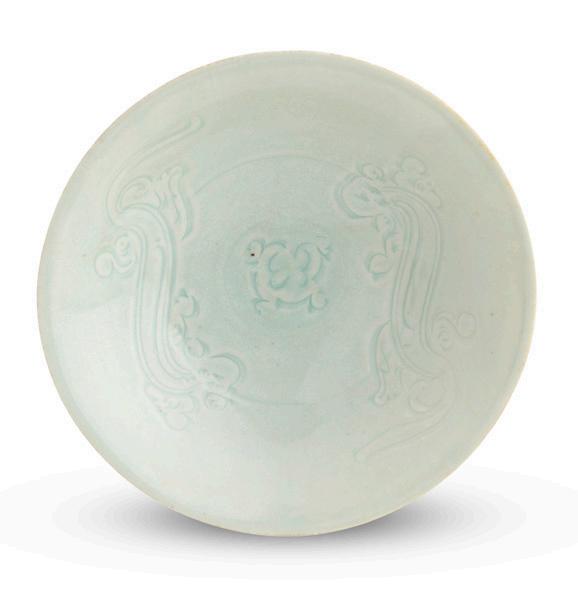
149
146
A LARGE AND RARE CHINESE DING WHITE GLAZE FOLIATE RIM BOWL, FIVE DYNASTIES (907 - 979)
With a fitted box.
A very similar but restored example, are now collected in Cultural Relics Institute Hebei Provence, see, Palace Museum Comp., Ding Ware, p. 62, no. 18. 19cm diameter; 7cm high
provenance
Blitz Oriental Art, Amsterdam. Capital Gallery, Hong Kong.
An important private collection, Sydney.
$25,000-35,000
五代 定窯白釉花口大盌 配盒。
類似但經修復之器現藏於河北省文物研究所,參見 《故宮定窯瓷器全集》,頁62,編號18。
147
A PAIR OF CHINESE CARVED QINBAI BOWLS, SOUTHERN SONG DYNASTY (1127 - 1279)
17.5cm diameter
provenance
A private collection, Hong Kong.
$2,000-3,000
南宋 影青刻花盌 一對
源流: 香港私人收藏。 146
148 A CHINESE QINGBAI MORTAR, SONG DYNASTY (960 - 1279)
20.5cm diameter
$800-1,200 宋 青白研磨盌
149 A VERY FINE CHINESE QINGBAI CARVED DRAGON CONICAL BOWL, SONG DYNASTY (960 - 1279)
The bowl is exquisitely potted with wide flaring sides rising from a small foot ring. The interior is finely carved with two chilong dragons encircling a flower. It is covered overall with a pale blue glaze appearing lucid in areas where it pools. It’s with a fitted box. 19.3cm diameter
provenance
A private collection, Hong Kong.
$10,000-20,000
宋 影青刻雙龍紋斗笠盞 源流: 香港私人收藏。
150 A SET OF CHINESE QINGBAI EWER WITH COVER AND A FLOWER SHAPED WARMING BOWL
Overall 27.5cm high
$5,000-7,000
青白釉執壺及蓋 與花形溫盌 一組二件
151
A CHINESE QINGBAI VASE WITH IRON SPOTS DECORATION, SONG DYNASTY (960 - 1279)
With a Japanese wooden box. 11.3cm high
$800-1,200
宋 青白點褐彩箸瓶
152
A CHINESE QINGBAI CARVED MEIPING VASE, POSSIBLY SONG/YUAN DYNASTY 30cm high
$15,000-25,000
或為宋 / 元 青白釉梅瓶
153
A CHINESE DING WHITE GLAZED LOTUS BOWL, NORTHERN SONG DYNASTY (9671127)
Similar example, see Christie’s New York, 22 Mar. 2019, lot 1275. 8.4cm diameter; 6.5cm high
provenance
Capital Gallery, Hong Kong. A private collection, Sydney. $6,000-8,000
北宋 定窯刻蓮瓣盌 類似器見: 2019 年 3 月 22 日紐約佳士得拍賣,第 1275 號拍品 源流: 香港長安美術;悉尼私人收藏
154
A LARGE CHINESE CIZHOU BOWL, JIN DYNASTY, 12TH/EARLY 13TH CENTURY
It’s freely painted on the interior with a spray of grasses below a wide band bordered by double line borders, all on a white slip under a clear glaze falling in an irregular line on the exterior to expose the pale ware.
21cm diameter; 8.5cm high
provenance
A private collection A.C.T., acquired from Raymond and Victoria Tregaskis Oriental Antiques, Sydney (No. 2161).
$1,500-2,500
金 磁州窯白地刻花大盌 源流:
澳洲堪培拉私人收藏,購自悉尼 Raymond and Victoria Tregaskis Oriental Antiques(編號2161)
155
A CHINESE JIEXIU WHITE GLAZED CUP, NORTHERN SONG DYNASTY (967 - 1127)
7.8cm diameter; 6.8cm high
provenance
A private collection, Hong Kong.
$4,000-6,000
北宋 介休窯白釉盌
源流:
香港私人收藏
156
A RARE CHINESE CIZHOU CARVED SLIP DECORATED MEIPING VASE, NORTHERN SONG DYNASTY (960 - 1127)
28cm high
provenance
Capital Gallery, Hong Kong.
A private collection, Sydney.
$15,000-25,000
北宋 磁州窯白地刻線條紋梅瓶 源流:
香港長安美術; 悉尼私人收藏。
157
A CHINESE WHITE GLAZED VASE, POSSIBLY TANG DYNASTY OR LATER
With a Japanese wood box. 18.5cm high
$5,000-7,000
或為唐或以後 白釉瓶 配日本木盒
158
A CHINESE ONGQUAN CELADON DRAGON VASE
22cm high
$5,000-7,000
龍泉窯青釉龍瓶

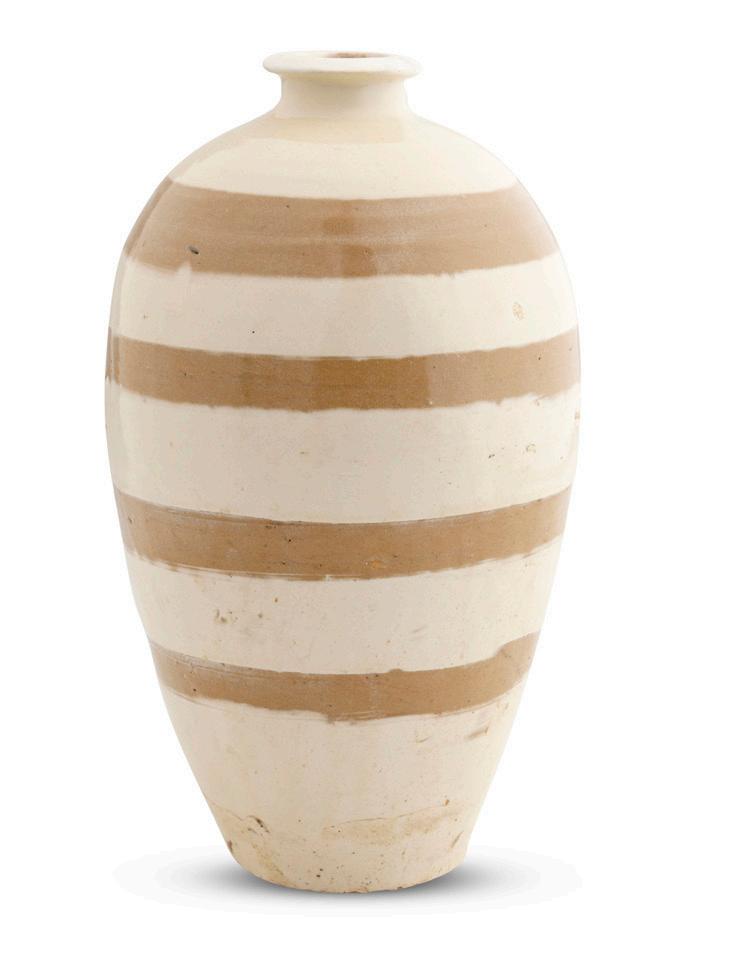
As Bright as Moon: Korean Moon Jar (Dal Hangari, 달항아리), 17th–18th
Century

Produced in the 17th and 18th centuries during the Joseon dynasty (1392–1910) by anonymous potters at the Bunwon 分院 kilns near Seoul, moon jars served primarily as storage containers and occasionally as vases for monumental floral arrangements at banquets and ceremonies. Known in Korean as dal hangari (달항아리)—literally “moon jars”—these vessels have become symbols of Korean identity, emblematic of a uniquely Korean aesthetic. Vessels of varied size and shape are often referred to collectively as “moon jars.”
Undecorated, moon jars rely on taut form and subtle glaze for aesthetic effect. Short and of nearly uniform diameter, their mouths and footrings are small relative to the bulging midsection, creating near-perfect bilateral symmetry. The footring is generally vertical, while the lip is slightly everted in late seventeenth- and early eighteenth-century examples.
Moon jars are formed from two hemispherical halves, each wheel-thrown in porcelain clay. Once dried to the proper state, the halves are joined rim to rim using a porcelain slurry, which binds them in the unfired state and encourages fusion during firing. At the appropriate stage of dryness, the foot ring is cut, the mouth opened, and the lip shaped. Bisque firing (素燒) between 700° and 1000° C hardens the clay, removing moisture and organic matter, stabilizing the vessel. Glaze is applied to the entire jar, except for the bottom of the foot ring, which is left unglazed to prevent adhesion to kiln furniture. High-temperature firing between 1250° and 1400° C transforms the body into hard, translucent white porcelain with a lustrous, transparent glaze.
The weight of the two hemispheres and the jar’s bulging centre often caused slight deformities during firing, such as leaning, sagging, or dimpling at the joint. Koreans embraced these irregularities, valuing them as integral to the jar’s character. While perfectly shaped jars are prized, modern connoisseurs also appreciate natural deformities as expressions of the clay and kiln’s “will,” endowing each jar with a unique personality.
Seventeenth- and eighteenth-century moon jars were typically white to off-white, sometimes with a subtle blue tint from the kiln atmosphere. Tiny brown or black specks appear due to clay impurities, ash, or soot. Over time, localized blushes ranging from pink to caramel and dark brown develop, often due to liquids stored within, including wine, oil, vinegar, or soy sauce. Wear such as scratches, chips, and glaze fissures further attest to a jar’s history, which modern collectors prize as evidence of enduring character.
Only a small number of large moon jars survive today, with approximately twenty known worldwide. Notable auction examples include a 45.1 cm jar sold at Christie’s New York on 21 March 2023 (lot 177) and another (45cm high) at the same house on 18 March 2025 (lot 333, sold for USD 2,833,000). An almost identical example is held in the Victoria and Albert Museum, London (The Samsung Gallery of Korean Art: Korean Art and Design, pp. 71–72, FE.32-1983). Four additional large jars are in American collections: Museum of Fine Arts, Boston (50.1040); Harvard Art Museums, Cambridge, MA (1991.609); Asian Art Museum, San Francisco (B60P110+); and Honolulu Museum of Art (7733.1). Medium-sized moon jars (30–40 cm) appear in the Metropolitan Museum of Art, New York (1979.413.1); Cleveland Museum of Art (1983.28); Art Institute of Chicago (2001.413); Birmingham Museum of Art, AL (2002.4); and the Asian Art Museum, San Francisco (F2011.12.4).
Large, globular jars were produced in Korea as early as the Three Kingdoms period (57 BC–AD 668), evidenced by low-fired earthenware in the National Museum of Korea (Jeung 343), Harvard Art Museums (1988.420), and Metropolitan Museum of Art (1981.401). However, the iconic moon jar emerged with the Joseon dynasty and the establishment of highquality porcelain production. Following China’s example, Korean potters manufactured porcelain during the Goryeo dynasty (918–1392), as seen in a Goryeo melon-shaped ewer-and-basin set in the Museum of Oriental Ceramics, Osaka (no. 00251). White wares were initially overshadowed by celadons.
With the establishment of Joseon in 1392, royal patronage shifted to porcelain, reflecting NeoConfucian ideals of purity and refinement. Bunwon kilns near Seoul became preeminent, producing court porcelain from the mid-1460s until privatization in the 1880s. Although Chinesestyle underglaze decorations were occasionally produced, Korean taste favored simple white wares, which embodied integrity and understated elegance. Scholar Yi Gyu’gyeong (1788–1856) observed, “The greatest merit of white porcelain lies in its absolute purity. Any effort to embellish it would only undermine its beauty.” White porcelain symbolized the Confucian gentleman (junzi), akin to the white robes of Joseon elites, as illustrated in Kim Hong-do’s Portrait of Seo Jiksu (1735–1811) and Yi Myeong’gi (National Museum of Korea, Deoksu 5688, Treasure 1487).
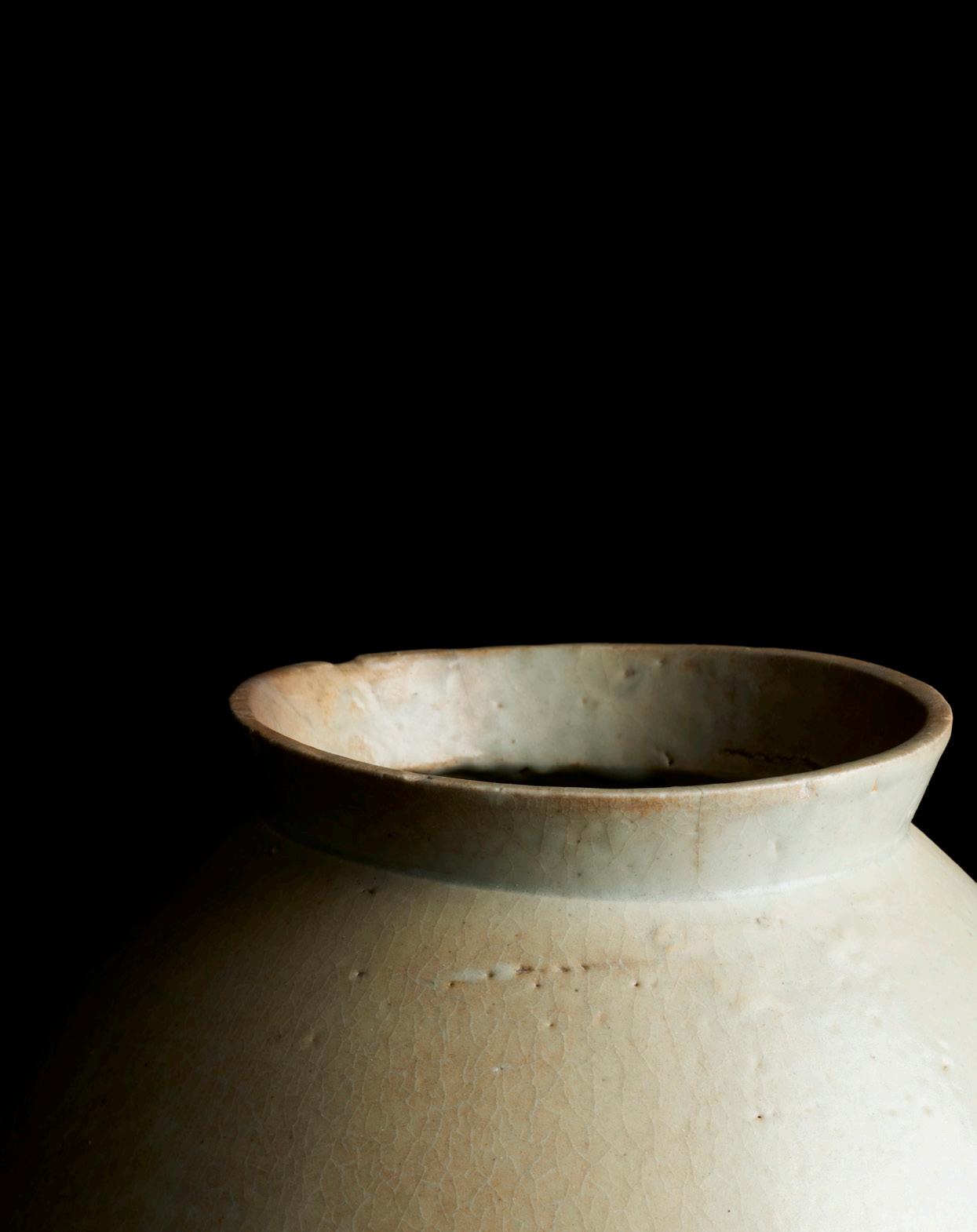
Interest in moon jars grew internationally in the twentieth century, promoted by Japanese critic and Mingei founder Yanagi Sōetsu (1889–1961) and contemporaries Kawai Kanjirō, Hamada Shōji, and Bernard Leach. In Korea, painter Kim Whanki (1913–1974) first recognized their aesthetic value, collecting jars and incorporating them into his representational works of the 1940s and 1950s, which depicted Korean landscapes, the moon, and jars. His peer To Sangbong (1902–1977) similarly depicted moon jars as flower vases or art objects. Kim and his circle coined the term dal hangari (달항아리), distinguishing these jars from earlier generic terms.
As uniquely Korean creations, moon jars became symbols of national identity, particularly after Japanese colonization and the Korean War. Contemporary potters—including Park Young Sook (b. 1947), Park Boo Won (b. 1938), Kwon Daesup (b. 1952), Lee Dongsik, and Kim Seyong (b. 1946)—continue to recreate the form. Artists such as Choi Young Wook (b. 1964) and Kang Ikjoong (b. 1960) incorporate moon jars into hyperrealistic or symbolic compositions, while the 2018 Pyeongchang Winter Olympics cauldron by Kim Youngse (b. 1950) evokes the moon jar form. Even in contemporary popular culture, BTS leader Kim Nam Joon (RM, b. 1994) demonstrates personal engagement with moon jars by Kwon Daesup.
Early Chosŏn white porcelains are rare, prized for their snow-white color and subtle blue tones. Scholar-official culture, deeply influenced by China, demanded austerity, ritual propriety, and refined aesthetics, evident in ceramics for court, Confucian ceremonies, and domestic use. Despite interruptions from the Japanese invasions of the 1590s and subsequent economic depression, production resumed by the early eighteenth century, with royal kilns at Punwon-ni as centers of excellence. Surviving seventeenth- and eighteenth-century jars exemplify Korea’s preference for plain, undecorated forms, sometimes exhibiting irregular oval profiles, central seams, or glaze pooling, all contributing to their character.
The continued fascination with moon jars reflects Korea’s evolving dialogue with national identity. Combining historical significance with contemporary resonance, locally and internationally appreciated in both fine art and popular culture, moon jars are among the rare works of art to transcend cultural boundaries and achieve iconic status as a symbol of Korea.
皎若明月: 韓國月亮罐 (Dal Hangari, 달항아리),十
七至十八世紀

158A
A RARE AND IMPORTANT KOREAN WHITE PORCELAIN MOON JAR, JOSEON DYNASTY, 17TH/18TH CENTURY
The vase is of ovoid form with tall circular foot and everted neck, applied overall with a transparent glaze of blue cast with random pink suffusions and random large craquelure.
37cm high
provenance
A private collection, Japan.
Raymond and Victoria Tregaskis Oriental Antiques, Sydney, acquired in Japan in 2011.
$15,000 – 25,000
韓國 朝鮮王朝十七至十八世紀 月亮罐 源流: 日本私人收藏。
已故澳大利亞著名中國藝術古董商Raymond and Victoria Tregaskis Oriental Antiques, 2011年夠藏於 日本。
此月亮罐製於朝鮮王朝(1392–1910)十七至十八世紀,由首爾附近的分院(Bunwon)窯口不知名的陶工燒 製。這些器物主作儲存容器,有時也作為宴會與典禮中大型花藝陳設的花瓶。韓語稱為dal hangari(달항아리) ,直譯即「月亮罐」,英文名稱亦源自此。月亮罐如今已成為韓國身份象徵,代表韓國獨有的美學價值。不同尺 寸和形制的器物通常統稱為「月亮罐」。
月亮罐無裝飾,其美感主要依賴造型的張力與釉色的細膩。器口與足座較短且直徑相近,使上、下半部幾乎呈雙 側對稱。足座通常垂直,而十七世紀末至十八世紀上半期的月亮罐口唇略外翻。
月亮罐由兩個半球形部分構成,每半球在陶輪上以瓷土製作成大碗形。待半球乾至適當狀態後,將其口緣對口堆 疊,用少量水調和的瓷土漿糊連接,使其在生坯狀態下結合並利於燒製時融合。乾燥至適當程度後,切削足座、 開口並整形口唇。待全乾後,進行700°至1000°C的素燒(bisque firing,素燒),以去除水分與有機物,使軟 陶轉化為堅硬、耐用且多孔的陶體。接著施釉於內外全器,唯底足不施釉以防燒結於窯具上。最終高溫燒成,通 常介於1250°至1400°C,使器身轉為堅硬、不透水、半透明白瓷,釉面光潤透明。
由於兩半球的重量及器身鼓起的造型,燒成時常出現輕微變形。例如稍側傾、中段接合處有微凸或凹陷,或因重 力下垂而呈現明顯鼓起。此類不規則並非刻意,而被朝鮮人視為器物特質的一部分。雖然造型完整、燒製精良的 月亮罐受人珍視,現代藏家亦欣賞天然不規則性,如彎曲、下垂或鼓起,視為陶土與窯爐的「意志」,賦予每件 月亮罐獨特個性。
十七至十八世紀月亮罐初燒時多呈白色或乳白色,釉色透明,有時因窯爐氣氛呈現淡藍色。釉面上常有微小褐 色或黑色斑點,源於陶土雜質、燒製時的灰燼或煤煙,以及窯爐氣氛細微變化。隨著時間推移,許多十八世紀 月亮罐局部呈現從粉紅、黃色、焦糖到深褐的色暈。部分月亮罐可能原用於儲存穀物或乾物,多數則盛放液體, 如酒、油、醋或醬油。內釉裂紋可能使液體滲入,形成色暈。除色澤變化外,多數月亮罐還可見磨損、刮痕、崩 口、裂紋及凹痕。藏家珍視這些痕跡,視為器物歷史與持久特質的證據。
作為實用器具,月亮罐傳統上並不被收藏為藝術品,現存數量極少。全球大型月亮罐約二十件。知名拍品包 括2023年3月21日佳士得紐約拍出的高45.1公分月亮罐(lot 177),及2025年3月18日同拍賣行的另一件(lot 333,45公分高, 成交價:2,833,000美金)。倫敦維多利亞與艾伯特博物館藏有近似月亮罐(The Samsung Gallery of Korean Art: Korean Art and Design, pp. 71–72, FE.32-1983)。美國則有四件大型月亮罐收藏於: 波士頓美術館(50.1040)、哈佛藝術博物館(1991.609)、舊金山亞洲藝術博物館(B60P110+)及檀香山藝 術博物館(7733.1)。中型月亮罐(30–40公分)收藏於紐約大都會藝術博物館(1979.413.1)、克里夫蘭美術 館(1983.28)、芝加哥藝術學院(2001.413)、阿拉巴馬伯明翰美術館(2002.4)及舊金山亞洲藝術博物館 (F2011.12.4)。
韓國早在三國時代(西元前57年至西元668年)即生產大型圓罐,現存低溫陶器見於國立中央博物館(Jeung 343)、哈佛藝術博物館(1988.420)及大都會藝術博物館(1981.401)。然現代經典月亮罐的形成則需等待朝 鮮王朝及瓷器興起。遵循唐代中國的技法,韓國在高麗時代(918–1392)已開始製瓷,如大阪東洋陶瓷美術館藏 高麗瓜形壺盆組(00251號)。白瓷初期曾被青瓷掩蓋。
朝鮮建國後,皇家扶持由青瓷轉向瓷器,體現儒家理想,將瓷器定為宮廷首選。首爾附近的分院窯成為高品質白 瓷生產中心,自1460年代中期至1880年代私有化,為王室及高官製作瓷品。雖偶有中國式彩繪作品,但朝鮮人偏 好純白無紋,象徵純潔、端正與內斂。十九世紀學者李圭景(1788–1856)曾言:「白瓷最大美德在於其絕對純 淨,任何裝飾只會破壞其美。」白瓷亦象徵儒家君子(junzi),如朝鮮士大夫白衣所示,見於金弘道的《徐直修 肖像》(1735–1811)及李明基(國立中央博物館,德壽5688,寶物1487)。
二十世紀月亮罐的國際關注始於日本評論家、民藝運動創始人柳宗悅(1889–1961)及其同時代的藝術家-- 河 井寬次郎、濱田庄司與伯納德·里奇。在韓國,畫家金煥基(1913–1974)首識月亮罐之美,開始收藏並在 1940–1950年代以寫實手法描繪韓國景物、月亮及月亮罐。其同行都相鳳(1902–1977)亦以月亮罐為題,或作 花瓶,或作藝術陳設。金氏與其圈子創造「달항아리」(dal hangari)一詞,區別於早期通稱大罐(큰 항아리) 或中國式名稱大壺、元壺、大罐。
月亮罐作為獨特韓國創作,成為民族象徵,尤其在日本殖民及韓戰後更具意義。當代陶工如朴英淑(1947–)、 朴武元(1938–)、權大壽(1952–)、李東植、金世永(1946–)持續重現其造型。藝術家崔永旭(1964–)與 姜益中(1960–)分別將月亮罐融入超寫實及象徵畫作,2018平昌冬奧火炬亦取月亮罐造型。流行文化中,BTS隊 長金南俊(RM,1994–)亦曾擁抱權大壽製月亮罐,表達個人情感。
早期朝鮮白瓷珍稀,因雪白色與淡藍色調而受重視。士大夫文化深受中國影響,講求簡樸、禮制與雅致,此在宮 廷、儒教典禮及日常器物中可見。即便1590年代日寇入侵及經濟衰退,至十八世紀初生產恢復,分院窯成為優 秀中心。現存十七、十八世紀月亮罐展現韓國對素雅無紋造型的偏好,有時呈現橢圓不規則、中央接縫或釉色堆 積,均增添器物特質。
月亮罐的持久魅力反映韓國對民族認同的持續探索。歷史價值與當代品味兼具,受國內外藝術界與流行文化推 崇,月亮罐是少數跨越文化邊界並成為韓國象徵的藝術品之一。
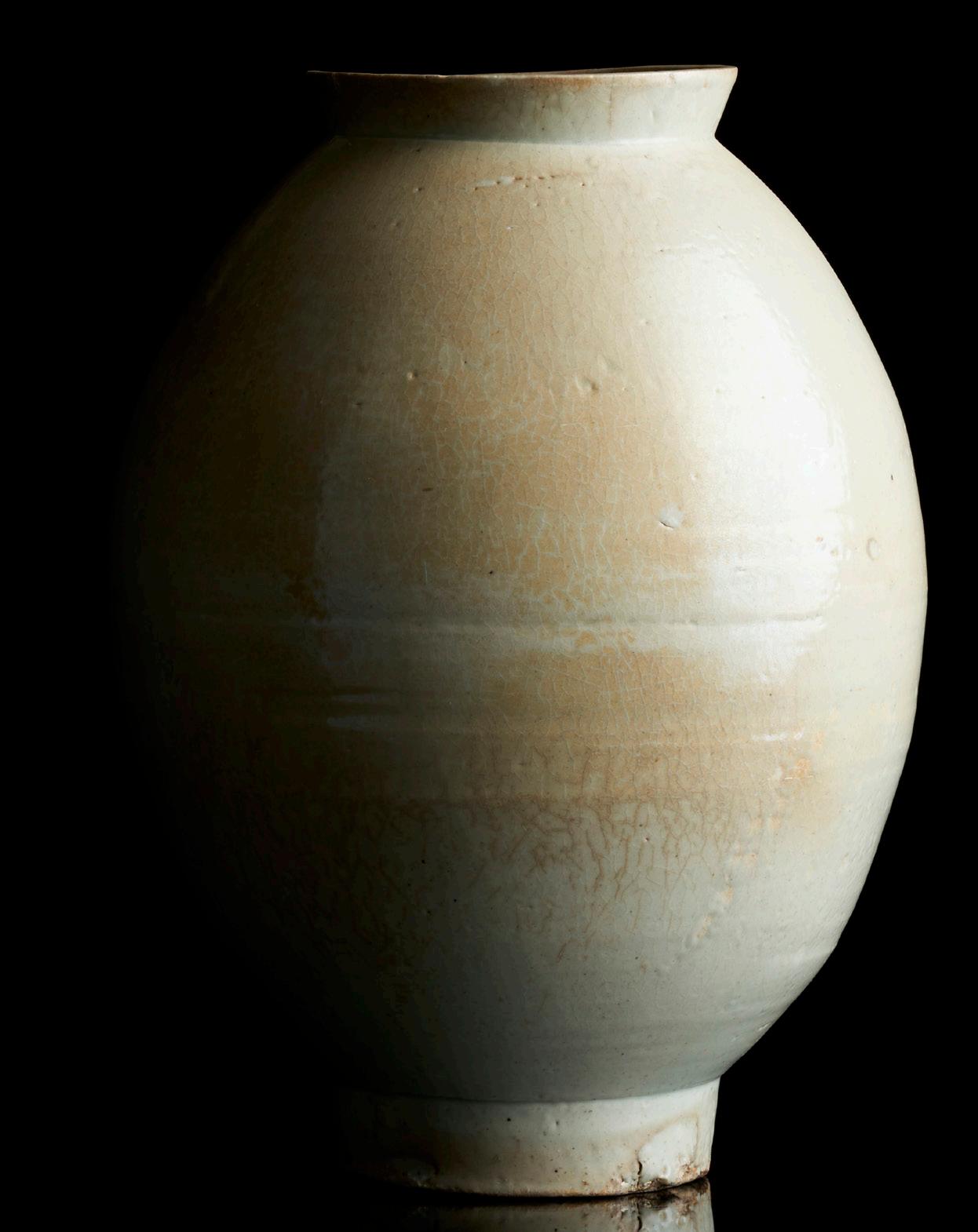
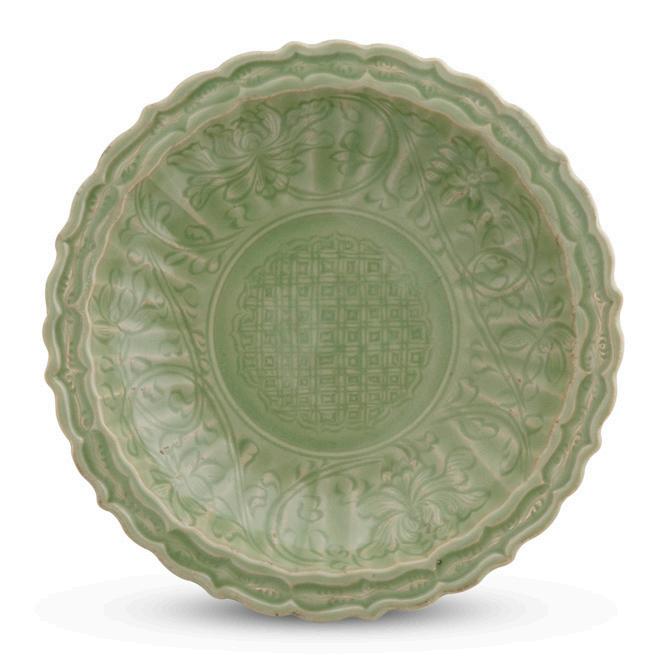
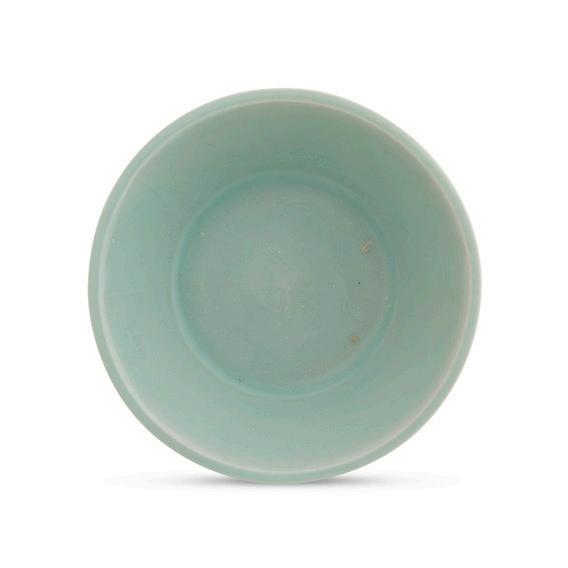
159
A VERY FINE CHINESE LONGQUAN CELADON FOLIATE RIM DISH, YUAN/MING DYNASTY, 13TH/14TH CENTURY
Thickly potted and incised with a classic scroll on the rim flange, lotus scrolls on the gently curving walls, and a cash-and-trellis diaper medallion in the well, the lotus scrolls repeated around the exterior, all beneath an olive-green glaze, the recessed base within the foot ring showing russet firing. It’s with a Japanese wood box.
25.5cm diameter
provenance
A private collection, Tokyo, Japan.
$5,000-7,000
元至明 龍泉窯青釉花口盤 配日本木盒 源流: 日本東京私人收藏。
160
A KOREAN CELADON DUCK FORMED WATER DROPPER, GORYEO PERIOD, 12TH CENTURY
6cm high
provenance
Bonhams Sydney, 4-25 Sep. 2024, lot 98.
$3,500-5,000
韓國 十二世紀 高麗青瓷鴨形水注
161
A CHINESE LONGQUAN CELADON „KINUTA“ BRUSH WASHER, SOUTHERN DYNASTY (1127 - 1279)
Diameter 13.4cm
provenance
The Estate of Sue Hewitt, Sydney (1941-2024) $2,500-3,500
南宋 龍泉窑粉青釉笔洗 源流: Sue Hewitt 遺藏( 1941–2024 )

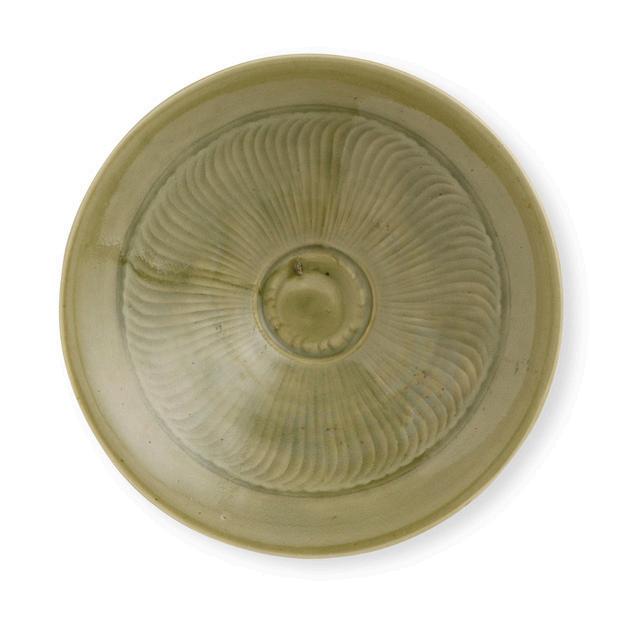
162
A RARE CHINESE YUEYAO CELADON JAR, NORTHERN SONG DYNASTY (960 - 1127)
The octagonal section jar decorated with shaped reserves containing sprays of peony blossom and foliage, surrounded by incised scrolling foliage, with incised lotus petal design around the neck. The whole covered in a olive-grey-green coloured glaze. Pontil marks to the base from the firing. 11.5cm high, 14cm diameter
provenance
The Estate of the Late Walter Hochstadter and Alice Chu, acquired by Walter Hochstadter prior to 1997 hence by descent. Walter Hochstadter was a well known and distinguished dealer of Chinese art, born in Krumbach (Germany) in 1914. In the late 1930’s he emigrated to the United States and died in Melbourne, Australia in 2007. He was a member of the Oriental Ceramic Society (USA) from 1953-1982. A large number of the Hochstadter collection was sold at Christies New York, 18th/19th March 2009, with a piece lot 518 reaching 2 million US dollars. Walter Hochstadter (候时塔) and Alice Leonard Joel, Melbourne, 3rd March 2021, lot 12. $3,000-5,000
北宋 越窯青釉刻花八方嘟嚕瓶
163
A VERY FINE CHINESE LONGQUAN
CELADON VASE, SOUTHERN SONG
DYNASTY (1127 - 1279) with a fitted box.
Similar examples, see Christie’s New York, 22nd Sep. 2023, lot 1019; and Christie’s Hong Kong, 2 May 2025, lot 988. 15cm high
provenance
Capital Gallery, Hong Kong. A private collection, Sydney.
$15,000-25,000
南宋 龍泉窯青釉瓶 配盒。
類似器見: 2023 年 9 月 22 日紐約佳士得拍賣,第 1019 號; 2025 年 5 月 2 日香港佳士得拍賣,第 988 號 源流: 香港長安美術;悉尼私人收藏
164
A LARGE CHINESE LONGQUAN CELADON DISH, MING DYNASTY (1644 -1911)
35.4cm diameter
$800-1,200
明 龍泉窯青釉大盤
165
A VERY RARE AND FINE CHINESE YAOZHOU CELADON CONICAL BOWL, NOTHERN SONG DYNASTY, CIRCA 11TH CENTURY It’s covered with an even olive green glaze. 19cm diameter
provenance
A private collection, ACT., acquired from Raymond and Victoria Tregaskis Oriental Arts, 26/05/2007 (with original receipt, receipt no. 0429.
$6,000-8,000
北宋 耀州窯青釉刻蓮瓣紋大斗笠盞 源流:澳洲堪培拉私人收藏,2007年5月26日購自 Raymond & Victoria Tregaskis東方藝廊(附原始收 據,編號0429)
166
A FINE CHINESE YAOZHOU CELADON CONICAL TEA BOWL, NORTHERN SONG DYNASTY (960-1127)
The bowl is covered with a beautiful even olive green glaze. 11.5cm diameter
provenance
Bluett & Sons, London.
A private collection, ACT., acquired from Joshua McClelland Print Room, Melbourne, 15/11/2004. (with the original receipt)
$2,500-3,500
北宋 耀州窯青釉斗笠茶盌
源流:
Bluett & Sons ,倫敦;
堪培拉私人收藏, 2004 年 11 月 15 日購自墨爾本 Joshua McClelland 版畫室(附原始收據)
167 A LARGE CHINESE LONGQUAN DOUBLE FISH DISH, SOUTHERN SONG DYNASTY (1127 - 1279)
19cm diameter
provenance
A private collection, A.C.T., acquired from Raymond and Victoria Tregaskis Oriental Antiques, Sydney (with original invoice, invoice no. 0385).
$2,000-3,000
南宋 龍泉窯青釉雙魚洗
源流:
澳洲堪培拉私人收藏,購自悉尼 Raymond and Victoria Tregaskis Oriental Antiques(附原始發票,
發票編號0385)
168 A CHINESE DING TEA BOWL STAND, FIVE DYNASTIES (907 - 979)
15cm diameter
provenance
K. Y. Fine Art, Hong Kong. Collection of Allan Rae, Sydney.
$2,500-3,500
五代 定窯盞托
源流:
香港繼遠古美術。
悉尼Allan Rae 收藏。
169 A GROUP OF RARE CHINESE DING SEATED FIGURES, JIN DYNASTY (1115 - 1234) With a fitted box. The largest figure: 8.5cm high
provenance
K. Y. Fine Art, Hong Kong.
$8,000-12,000
金 定窯人物坐俑「全家福」一組
配盒;
源流:
香港繼遠古美術
170 A CHINESE HENAN DARK GLAZED IRON STRIPE DECORATED BOWL, JIN/YUAN
DYNASTY, 13TH/14TH CENTURY
16.5cm diameter
provenance
A private collection, ACT., acquired from Raymond and Victoria Tregaskis Oriental Antiques, 20/8/2005. (with original receipt, receipt no. 0455.
$1,500-2,500
金/元 河南黑釉鐵鏽斑盌
源流:
堪培拉私人收藏,2005年8月20日購藏 Raymond and Victoria Tregaskis Oriental Antiques(附原始收 據,編號0455)。
171 A CHINESE HENAN DARK GLAZED IRON STRIPES DECORATED BOWL, JIN/YUAN
DYNASTY, 13TH/14TH CENTURY
18.5cm diameter
provenance
A private collection, ACT., acquired from Raymond and Victoria Tregaskis Oriental Antiques, 20/8/2005. (with original receipt, receipt no. 0455.
$2,000-3,000
金/元 河南黑釉鐵鏽斑盌
源流:
堪培拉私人收藏,2005年8月20日購藏 Raymond and Victoria Tregaskis Oriental Antiques(附原始收 據,編號0455)。

172
A RARE CHINESE JIAN RUSSET GLAZED HARE’S FUR TEA BOWL, SOUTHERN SONG DYNASTY (1127 - 1279)
With a fitted box.
The result of C-Link Research & Development Ltd. thermoluminescence test no. 6118NE02 is consistent with the dating of this lot. 12.3cm diameter; 6.5cm high $5,000-7,000
南宋 建窯兔毫盞 附盒 經香港中科熱釋光測試 (編號6118NE02),結果與本拍品年代相符。
173
A CHINESE BROWN LACQUER CIRCULAR BOWL STAND, ZHANTUO, SONG DYNASTY (960-1279)
The cup stand is raised on a hollow splayed circular foot, supporting a circular flange with gently upturned edges bound with metal, encircling the plain globular receptacle rising to an incurved rim, covered entirely with lacquer of rich brownish black tone. It’s with an old Japanese wood box. The function of a bowl stand is comparable to that of a saucer. Since steaming bowls of tea were made without handles, they were placed on stands when served-both to prevent the recipient’s fingers from being scalded and to provide stability for bowls, which often had narrow bases. A related example of a plain brown lacquer bowl stand, raised on a slightly higher foot ring, was excavated in Yixing, Jiangsu province, and is published in Zhongguo Meishu Quanji: Lacquerware, vol. 8, Beijing, 1989, no. 93. For comparable examples, see Christie’s Hong Kong, 29 November 2017, lot 3047, and another sold at the same house, 27 November 2013, lot 3553. See also a brown-lacquered example, Christie’s, 9 October 2020, lot 106.
16cm diameter; 8cm high
$8,000-12,000
宋 黑漆盞托
174
A CHINESE JIZHOU ‘PRUNUS’ BOWL, SOUTHERN SONG DYNASTY (1127 - 1279)
Its everted rim carefully formed with a raised ridge on the interior and slightly recessed edge on the exterior, its wide well cursorily painted with a flowering prunus branch beneath a crescent moon in buff coloured slip against a dark chocolate brown ground slip that extends onto the exterior walls, stopping unevenly above the foot.
Similar example, see Sotheby’s London, 8 Nov., 2023, lot 309. 11cm diameter
provenance
A private collection, A.C.T., acquired from Joshua McClellan Print Room, 20th April 2005 (with the copy of original invoice).
$2,000-3,000
南宋 吉州窯黑釉「月影梅」盏 可參考:倫敦蘇富比2023年11月8日,拍品309號。
源流:
澳洲堪培拉私人收藏,2005年4月20日購自 Joshua McClellan Print Room(附原始發票副本)
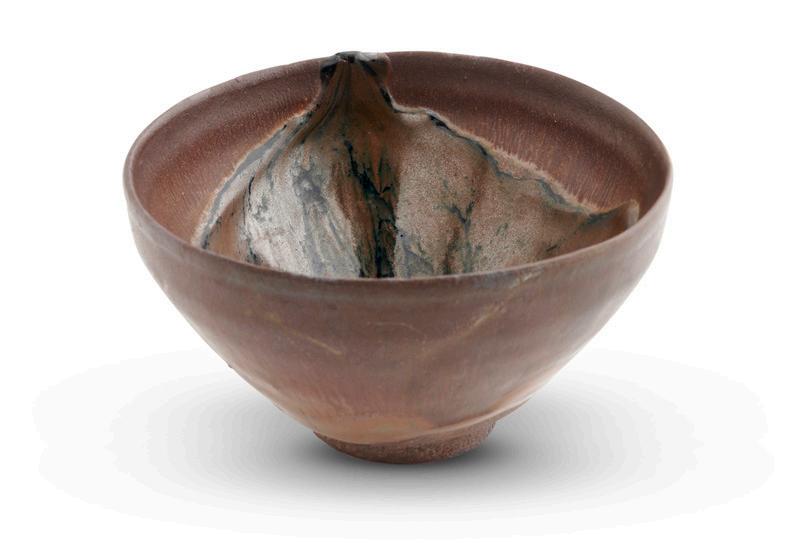
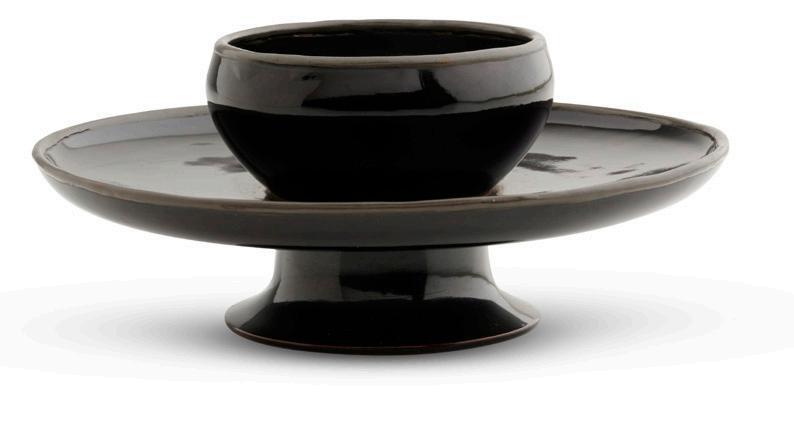
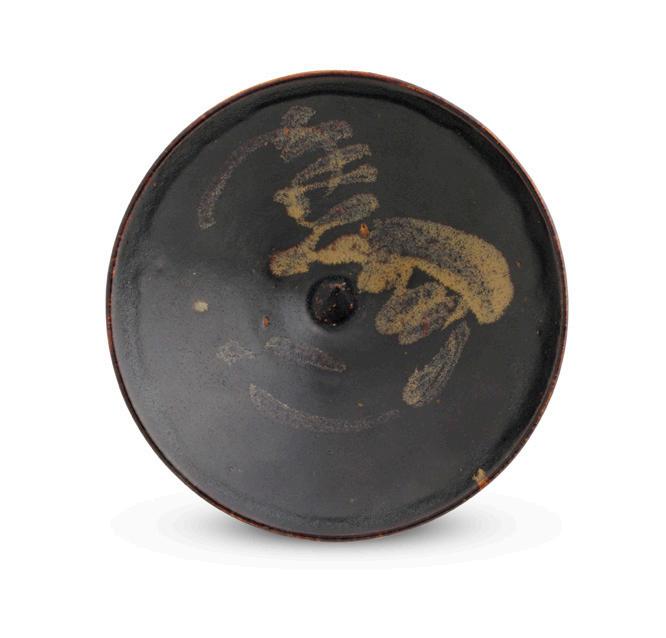
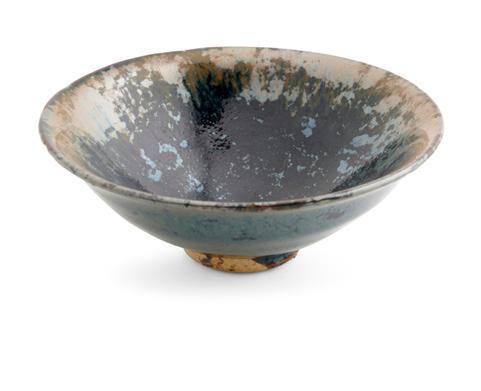
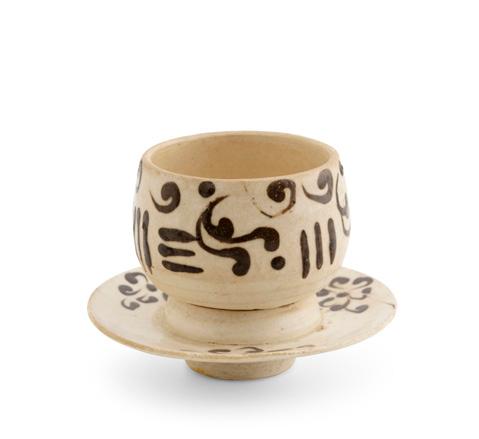
175
A RARE CHINESE JIZHOU PAINTED CONICAL BOWL, SOUTHERN SONG DYNASTY (1127 - 1279)
With widely flared sides, covered inside and out with a blackish-brown glaze ending on the exterior in an irregular line above the foot and fluidly painted on the interior in buff with a “shou” character.
A similar bowl, see Christie’s New York, 18 Mar., 2009, lot 332. Another similar example, see Bonhams London, 12 May 2016, lot 25. 14.3cm diameter
provenance
A private collection, A.C.T., acquired from Raymond and Victoria Tregaskis Oriental Antiques, Sydney (with copy of original invoice).
$8,000-12,000
南宋 吉州窯黑釉「月影梅」大斗笠盏
176
A CIZHOU BLACK-GLAZED BOWL WITH WHITE RIM, JIN DYNASTY, 12TH CENTURY
With a Japanese wood box. 10.1cm diameter
provenance
A private collection, ACT., acquired from Raymond and Victoria Tregaskis, Sydney, 6/7/2016. (with original receipt)
$3,000-5,000
金代 十二世紀 磁州窯黑釉白口盌 源流:澳洲堪培拉私人收藏,2016年7月6日購自 Raymond & Victoria Tregaskis東方藝廊(附原始收 據)
177
A RARE CHINESE YAOZHOU/DANGYANGYU DARK GLAZED CONICAL BOWL, NORTHERN SONG DYNASTY (960 - 1279) 12.5cm diameter
provenance
Capital Gallery, Hong Kong. A private collection, Sydney.
$4,000-6,000
北宋 耀州/當陽峪窯黑釉斗笠盞 源流:
香港長安美術;悉尼私人收藏
178
A CHINESE DANGYANGYU WARE WHITE GLAZE WITH DARK DECORATED CUP AND STAND, SONG DYNASTY (960 - 1279)
Cup: 5.5 diameter; Stand: 9.5cm diameter
provenance
Capital Gallery, Hong Kong. A private collection, Sydney.
$5,000-7,000
宋 當陽峪窯白釉褐彩盃及盃托 源流:
香港長安美術;悉尼私人收藏

179
A CHINESE JIAN HARE’S FUR TEA BOWL, POSSIBLY SOUTHERN SONG DYNASTY (1127 - 1279)
Together with a carved cinnabar lacquer stand, possibly Ming Dynasty and old Japanese wood boxes. The covers of the boxes inscribed by Tamura Haruhira.
12.2cm diameter
provenance
The collection of Tamura Haruhira (according to the inscriptions on the boxes).
A private collection, Japan.
other notes
The bowl is paired with a carved red lacquer stand (zhantuo), a form of tea implement designed for use with bowls. As depicted in Emperor Huizong’s Gathering of Scholars handscroll, bowl stands were crafted to match the size of tea bowls. In the mural paintings from the Yuan-dynasty tomb of Feng Daozhen in Datong, Shaanxi, figures are shown holding bowl stands, while bowls, tea jars, and stands appear on tables, indicating their integral role in the tea service from at least the Song dynasty. Stands were made in a wide variety of forms and materials, including porcelain, lacquer, gold, and silver.
$8,000-12,000
南宋或以後 建窯兔毫茶盌 配雕漆盞托及舊日木盒
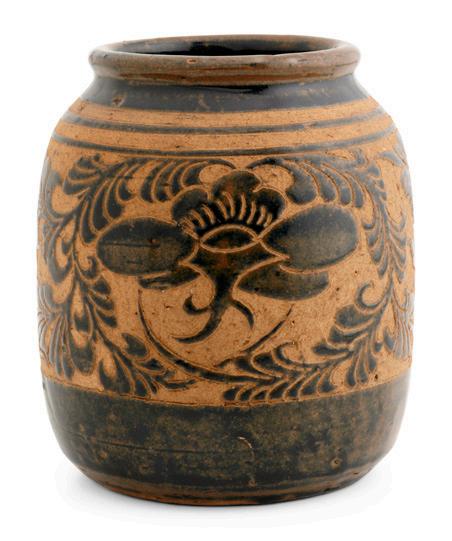
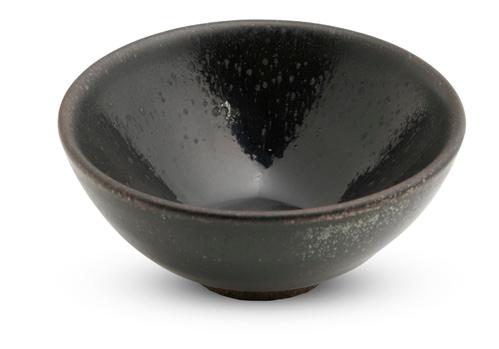
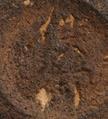
180
A CHINESE XIXIA WARE CIZHOU CARVED ‘FLORAL’ JAR, JIN DYNASTY, 13TH CENTURY 15.5cm high; 12cm diameter
provenance
Capital Gallery Hong Kong. A private collection, Sydney. $10,000-20,000
金 十三世紀 西夏磁州窯刻花卉紋罐 源流: 香港長安美術; 悉尼私人收藏。
181 A VERY RARE CHINESE JIAN OIL SPOT BUBBLE BOWL, GONGYU MARK, SOUTHERN SONG DYNASTY (1127 -1279)
9.3cm diameter
provenance
An old private collection, Japan. Yurinkan Antiques, Osaka, Japan.
$8,000-12,000
南宋 「供御」款 建窯油滴泡泡盌 源流: 日本私人收藏; 大阪有鄰館古美術,附原始購買收據
182
A CHINESE JIAN HARE’S FUR TEA BOWL, POSSIBLY SOUTHERN SONG DYNASTY OR LATER with a Japanese red lacquer stand and old Japanese double boxes. 12cm diameter
$5,000-7,000
南宋或以後 建窯兔毫茶盌 配日製紅漆盞托及舊日 雙層木盒
183 A CHINESE HENAN RUSSET-SPLASHED DARK-GLAZED TRUNCATED MEIPING VASE, NORTHERN SONG (960 - 1127)
For a related truncated meiping with sparse russet dots, see Sekai toji zenshu, op. cit., p. 246, fig. 106. Compare also a larger example (19 cm.) of narrower form with sharp mouth rim and irregular russet splashes, Meiyintang Collection, illustrated in R. Krahl, Chinese Ceramics from the Meiyintang Collection, vol. III, pt. II, London, 2006, p. 505, no. 1510. See also a 19.7 cm. vase with sloping shoulders and tapered foot, National Museum of Korea, published in Song Ceramics, Osaka, 1999, p. 123, no. 85; another in the Miyoshi Kinenkan, Ashikaga, in Sekai toji zenshu, vol. 12: Song, Tokyo, 1977, no. 246; and a related example sold at Christie’s New York, 20 September 2024, lot 1022.
11.5cm high
provenance
A private collection, Hong Kong.
$7,000-9,000
北宋 河南黑釉褐斑嘟嚕瓶 源流: 香港私人收藏
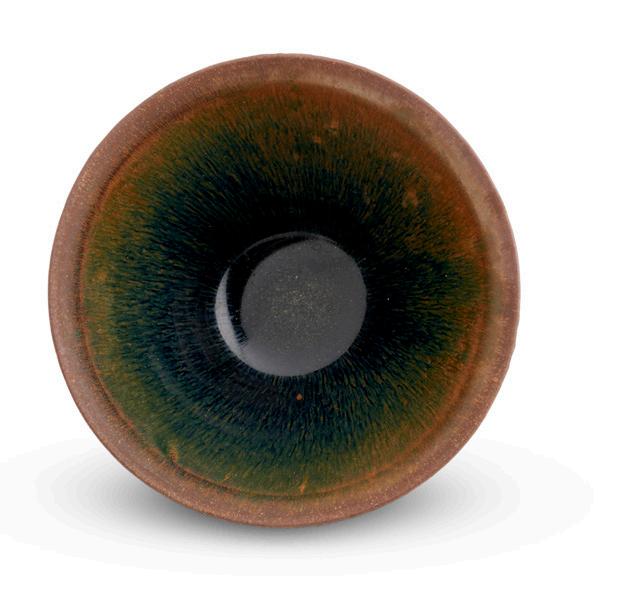

184
A CHINESE JIAN HARE’S FUR CONICAL BOWL, SONG DYNASTY (960 - 1279)
12.5cm diameter
provenance
A private collection, Hong Kong.
$6,000-8,000
宋 建窯兔毫斗笠盞
源流:
香港私人收藏
185
A FINE CHINESE JIAN HARE’S FUR TEA BOWL, POSSIBLY SOUTHERN SONG
DYNASTY (1127 - 1279)
12.2cm diameter; 6.5cm high
provenance
A private collection, Hong Kong.
$4,000-6,000
或為南宋 建窯兔毫茶盌
源流:
香港私人收藏
186
A CHINESE JIANWARE HARE’S FUR CONICAL BOWL, SOUTHERN SONG
DYNASTY (1127 - 1279)
13.7cm diameter
$1,000-2,000
南宋 建窯兔毫斗笠盞
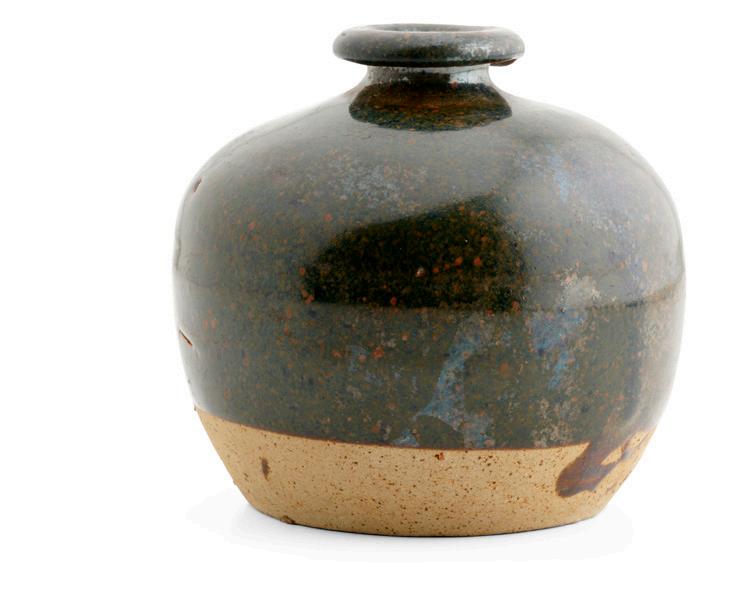
The
Estate of W.Y. Thomas Kwok (1944- 2017), acquired in Hong Kong in the 80s.
Born in Macau in 1944.
lots 187 – 201
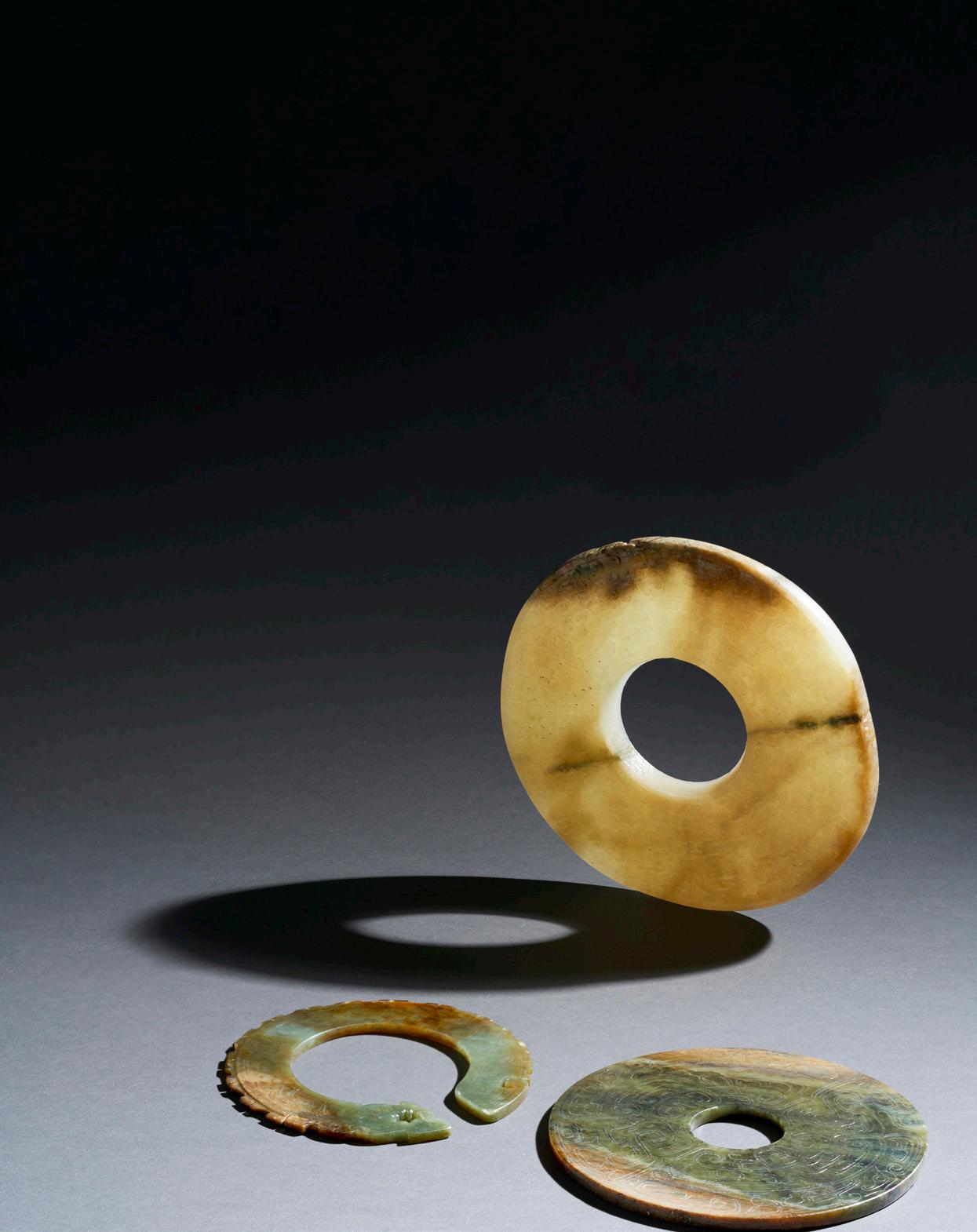
Born in Macau, Mr. Kwok studied architecture in Melbourne and built a four-decade career with Wong & Ouyang, shaping Hong Kong’s skyline. His collecting began with Japanese occupation stamps (1941–1945), issued during Japan’s wartime administration of Hong Kong and other territories. Gradually, his passion shifted to jade, inspired by visits to auction houses.
At the time, Hong Kong’s auction scene was emerging—Sotheby’s debuted in 1973, Christie’s in 1986. By the late 1980s, Kwok was attending smaller sales, joining the city’s first generation of serious collectors. His jade holdings embody not only technical excellence and cultural symbolism but also the personal evolution of a connoisseur whose interests bridged philately, architecture, and Chinese art heritage.
郭偉仁先生(Kwok, Thomas Wai Yan)1944年出生於澳門,青年時在墨爾本攻讀建築專業並開啟了建築設計的事 業。1984年,Thomas加入香港著名建筑师事务所WONG & OUYANG (HK) LIMITED 王歐陽(香港)有限公司 担任董事,并于1992至1995年间,担任香港注册建筑师委员会主席。在1980年前后,苏富比和佳士得首次进入香 港。郭偉仁先生对于玉器收藏的热情随之得到了滋养,逐渐形成了自己的品味和收藏体系。郭偉仁先生是香港最 早开始收藏的初代收藏家之一。
187
A RARE AND LARGE CHINESE JADE DRAGON FORMED PENDANT, SHANG DYNASTY (1600-1650 B.C.)
The neatly rendered Chen shaped eye, the upturned and hooked nose tip, the treatment of the teeth between the upper and lower jaws, the flanges along the back, the backward-curving tail, as well as the incised hook-and-sickle motifs and the carving of pseudo-yang lines on the body, all indicate that this dragon-shaped jade pendant is a characteristic example of late Shang dynasty craftsmanship. With a fitted box.
Compare with a much smaller coiled dragon pendant (4 cm) from the same period, sold at Christie’s New York, 18 March 2009, lot 282. Other smaller related examples, excavated from the tomb of Fu Hao at Anyang, Henan province, are published in Yinxu Yuqi (The Jades from Yinxu), 1982, pl. 2, nos. 600 and 469. Another example, formerly in the McKim Collection, is illustrated in Jessica Rawson, Chinese Jade from the Neolithic to the Qing, British Museum, 1995, p. 211, no. 12:4. See also a closely related pendant published by Wu Hung and Brian Morgan in Chinese Jades from the Mu-Fei Collection, Bluett & Sons, London, 1990, no. 15.
11cm diameter
$10,000-20,000
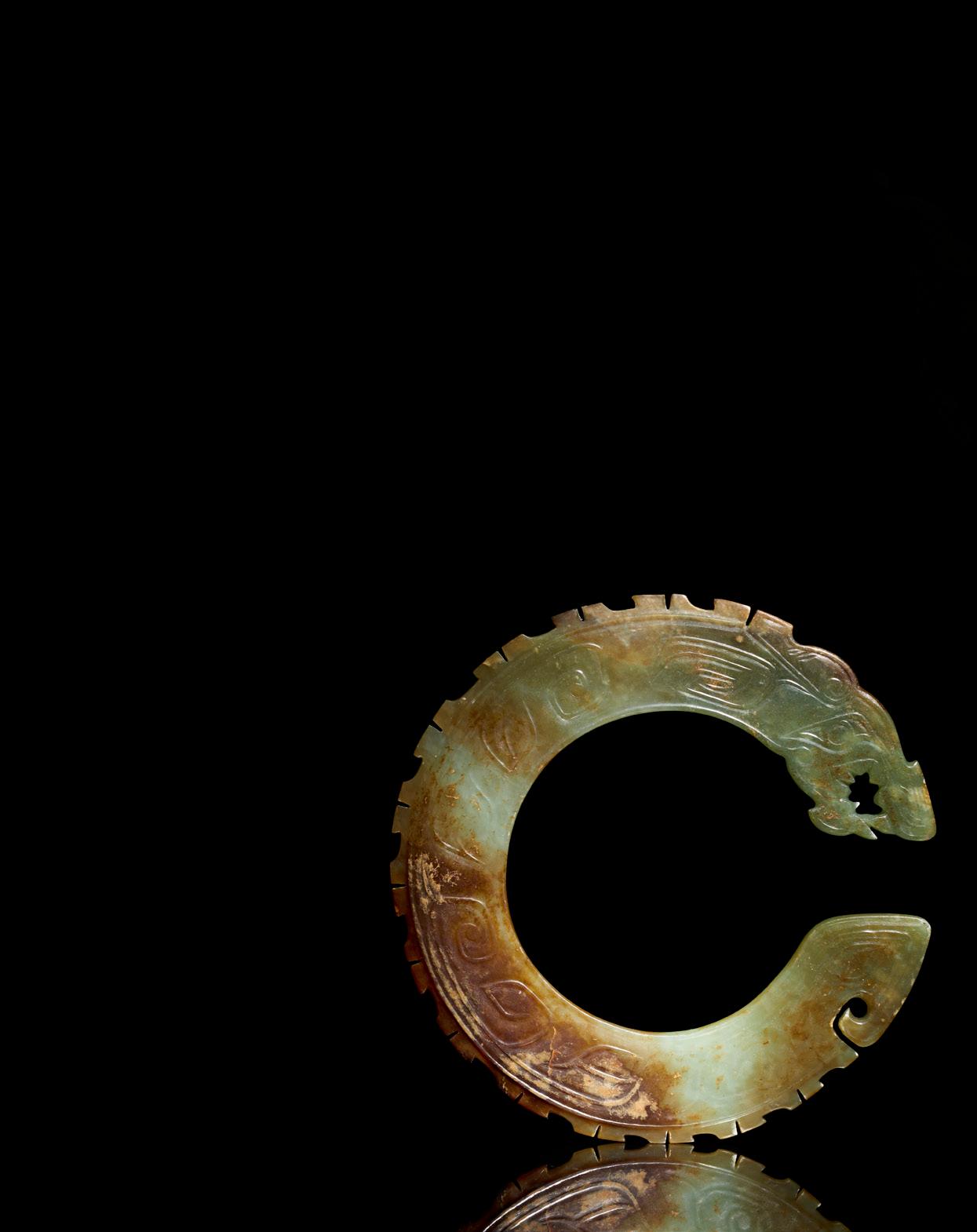
商 白玉雕龍紋珮
眼部呈辰形,鼻端上翹並鉤形,上下顎間牙齒刻劃 清晰,背部有脊棱,尾部向後彎曲,身上刻有鉤鐮 紋與仿陽紋,具典型晚商玉雕風格。配盒 類似小型盤龍珮( 4 公分)見: 2009 年 3 月 18 日紐 約佳士得拍賣,第 282 號;另見安陽婦好墓出土之 相關器例,刊於《殷墟玉器》, 1982 年,圖版 2 , 編號 600 與 469 。
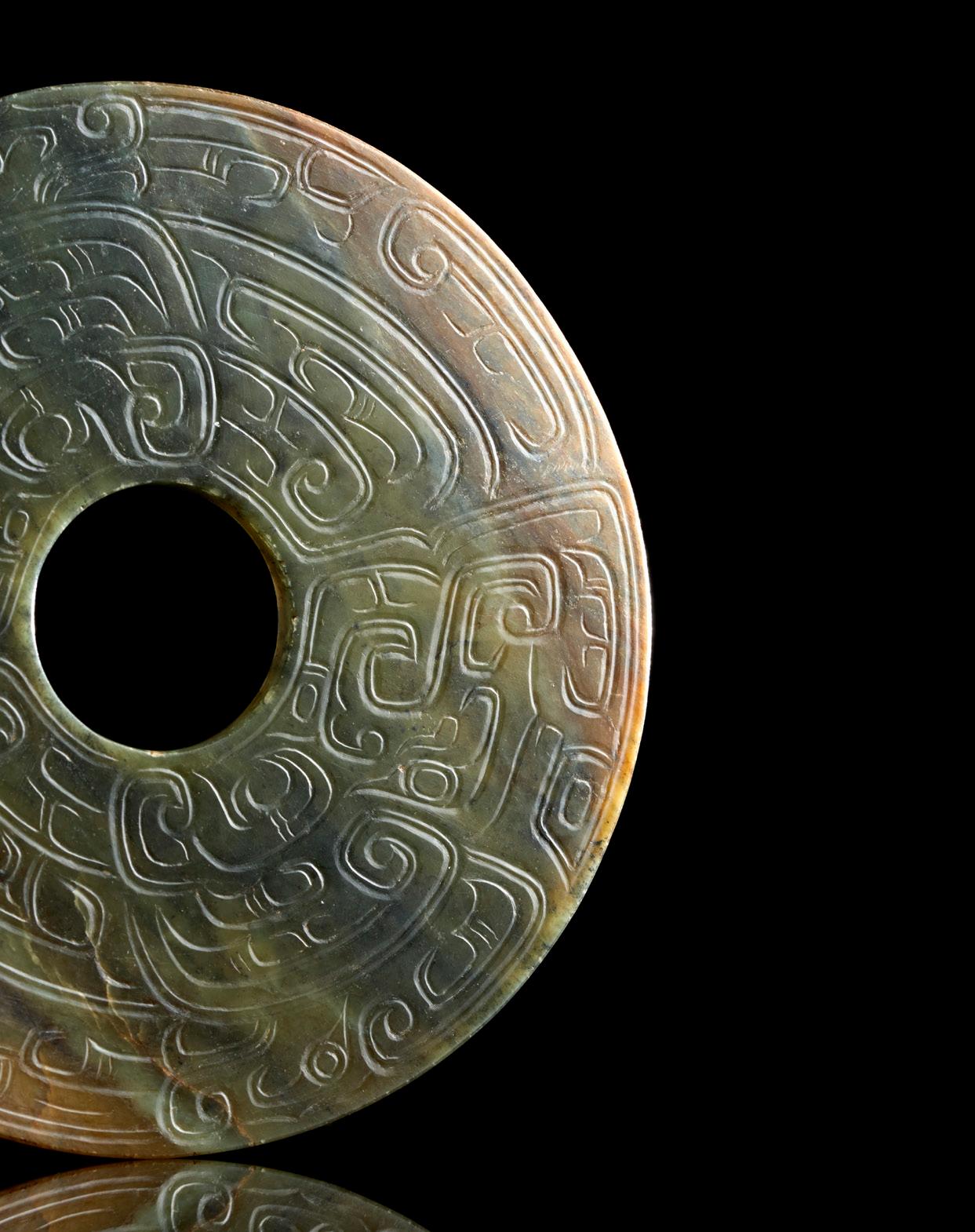
188 A CHINESE CELADON JADE „DRAGON“ DISC, BI, MID-WESTERN ZHOU DYNASTY, CIRCA MID-10TH-MID-9TH-CENTURY BC
The jade disc is carved on both sides with profiles of dragon heads and joined by scroll motifs. The contours and details are rendered with double-line grooves. It’s with a fitted box.
A much smaller related example (6.1cm diameter) sold at Christie’s Hong Kong, 28 Nov. 2018, lot 2730. W.Y. Thomas Kwok 遺藏,198 0年代初購於&# 39321;港 12.5cm diameter
$6,000-8,000
西周中期「龍紋」雙面雕 青玉璧
雙面雕龍首側面,間以卷草紋,線條以雙槽刻劃, 配盒。
類似小型器例(直徑 6.1 公分)見: 2018 年 11 月 28 日香港佳士得拍賣,第 2730 號拍品。
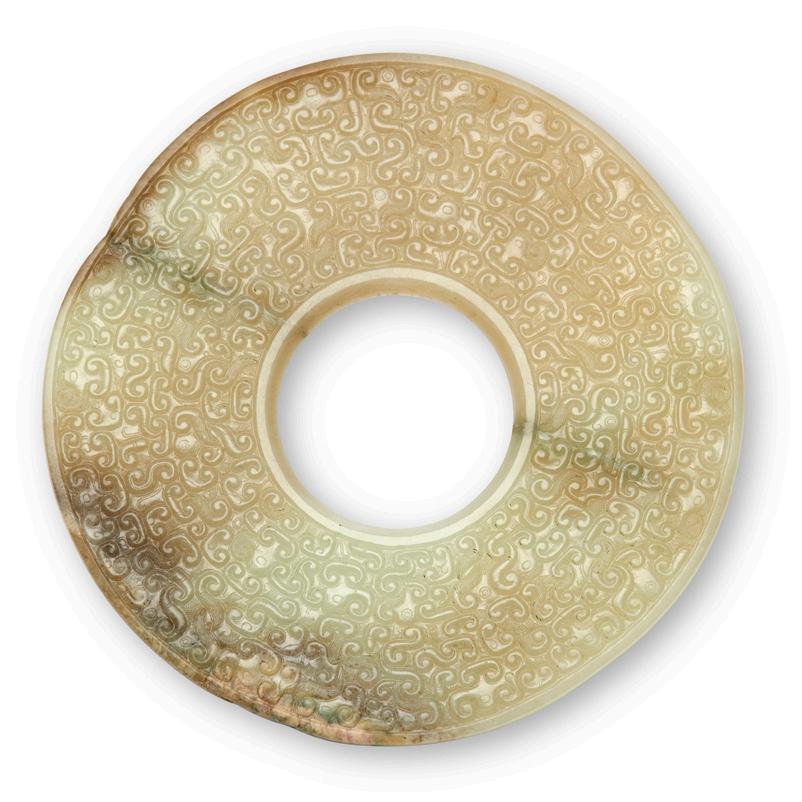
189
189
A RARE AND FINE CHINESE WHITE JADE
„DRAGON“ DISC BI, LATE SPRING AUTUMN PERIOD - EARLY WARRING STATES PERIOD, CIRCA 570 - 400 BC
Both sides of the disc are finely carved in low relief with interlock dragons. With a fitted box. Similar interlocking dragon motifs are commonly seen on bronze vessels from the Spring and Autumn period. Comparable jade bi disc, see Christie’s Hong Kong, 3 Dec 2021, lot 2724.
15.5cm diameter
other notes
The craftsmanship of the jade bi itself suggests earlier origins, indicating that it was likely a Neolithic relic later reworked during the Spring and Autumn or Warring States period, with the addition of the interlocking dragon motif.
$8,000-12,000
春秋晚期至戰國早期 約公元前 570 –400 年 白玉雕 「龍紋」璧 雙面浮雕交纏龍紋,配盒。
此類交龍紋常見於春秋時期青銅器,類似玉璧 見: 2021 年 12 月 3 日香港佳士得拍賣,第 2724 號 拍品。
備註:
此玉璧雕工顯示其可能為新石器時代遺物,後於春 秋或戰國時期加刻龍紋再製
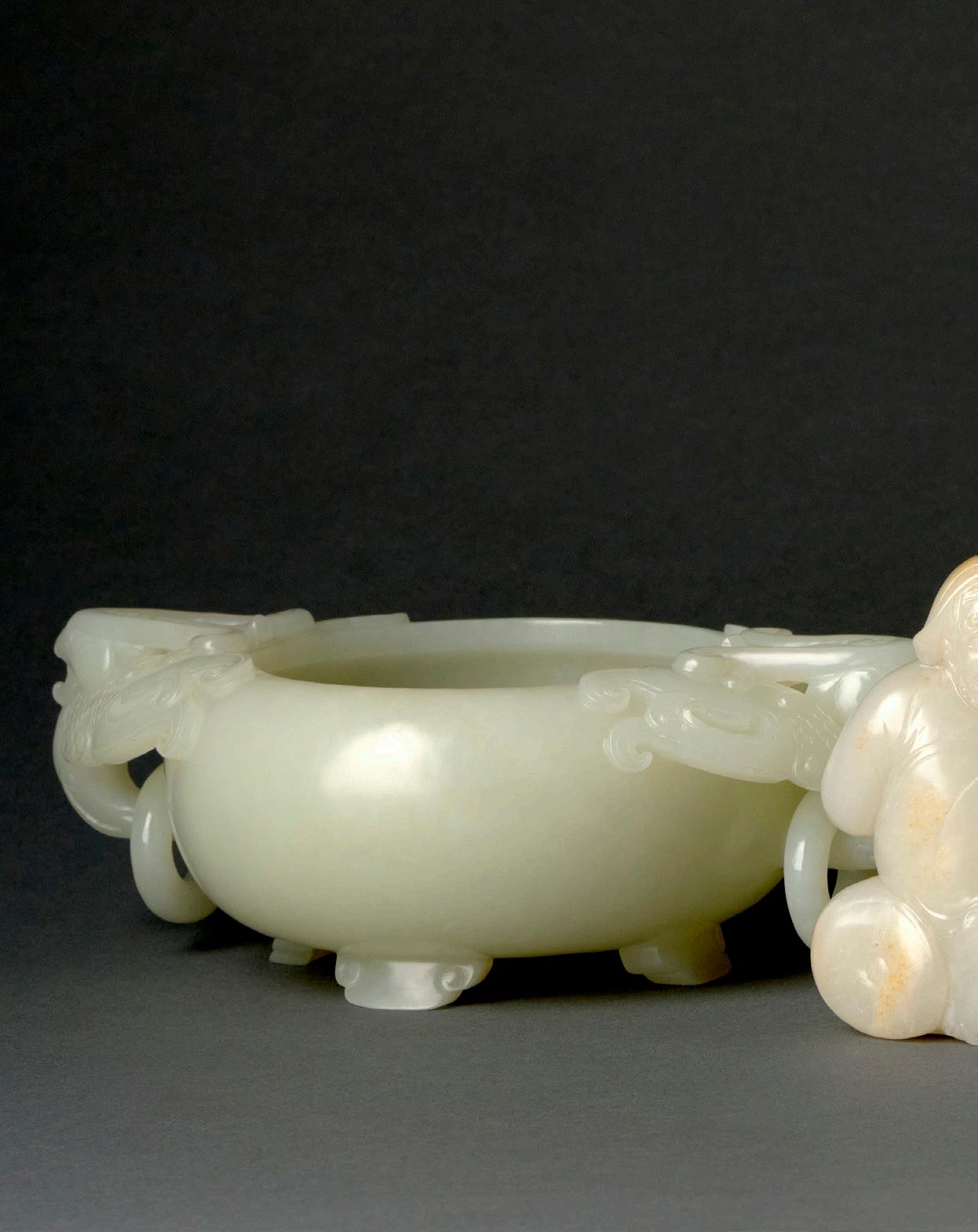
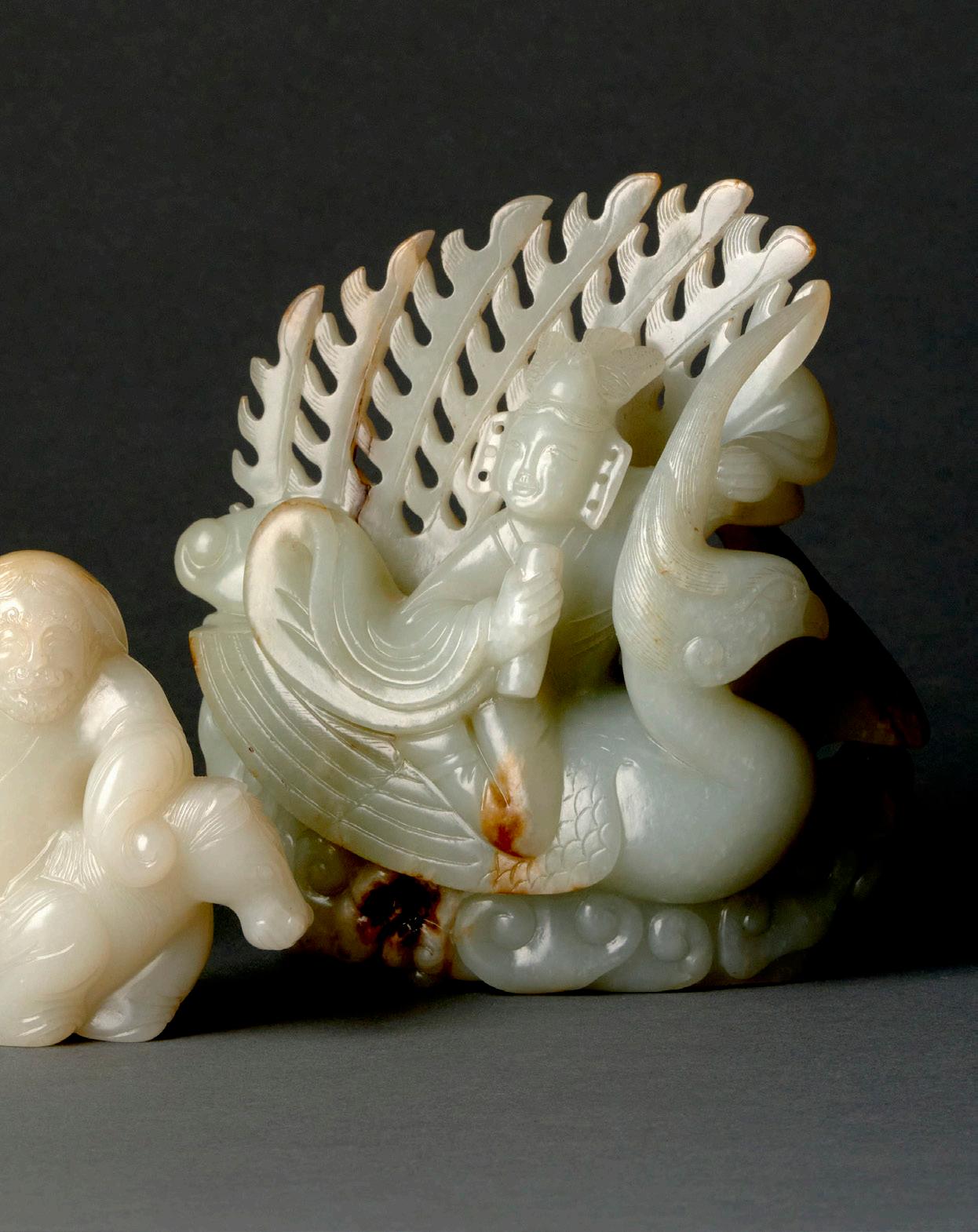
A RARE AND FINE WHITE JADE “HORSE AND FOREIGN GROOM” GROUP, YUAN/MING DYNASTY, 14TH - 16TH CENTURY
The powerful recumbent animal is carved with its head turned sharply over its back, featuring flared nostrils and bulging eyes beneath a pair of alert ears and a flowing incised mane. Its tail rests along the left flank, with the left foreleg raised and the remaining legs tucked beneath the body. A foreign groom is shown resting against its right side. With a fitted box. Jade carvings of foreign figures are extremely rare, with most known examples dating from the Tang to Ming dynasties. For comparable figures, see Christie¡¯s New York, 13 September 2018, lot 903, and Sotheby¡¯s London, 8 December 2022, lot 249.
For a related jade group depicting a horse and groom, see Christie¡¯s Hong Kong, 30 May 2024, lot 2987. A jade horse carved in a similar pose was sold at Bonhams London, 11 November 2010, lot 26. 10cm wide; 6cm high
$5,000-8,000

元至明 白玉雕「胡人簽馬」擺件
臥馬回首,鼻翼張揚,雙目突出,耳朵豎立,鬃毛 刻劃細緻,尾巴沿左側垂落,左前腿抬起,其餘腿 收於身下,右側倚一番使人物。配盒。
玉雕番人極為罕見,常見於唐至明代。類似器
見: 2018 年 9 月 13 日紐約佳士得拍賣,第 903 號; 2022 年 12 月 8 日倫敦蘇富比拍賣,第 249
號; 2024 年 5 月 30 日香港佳士得拍賣,第 2987 號。
191
A RARE AND LARGE CHINESE PALE WHITE JADE CARVING OF MAGU RIDING A PHEONIX, JIN/MING DYNASTY, 13TH/15TH CENTURY
It‘s finely carved with a magu wearing a phoenix crown and riding a phoenix with the left hand is holding it‘s long crest, the right hand holding a scroll, amongst ruyi head clouds.
Compare to a jade phoenix formed hair ornament, which has similar features of this present phoenix, the tail feathers are also carved in openwork, see Christie’s New York, 19 Mar 2015, lot 619. In addition, also see, the phoenix form hair ornament illustrated by James C. Y. Watt, Chinese Jades from the Collection of the Seattle Art Museum, 1989, p. 63, no. 37.
13cm high; 12.5cm wide
$5,000-8,000
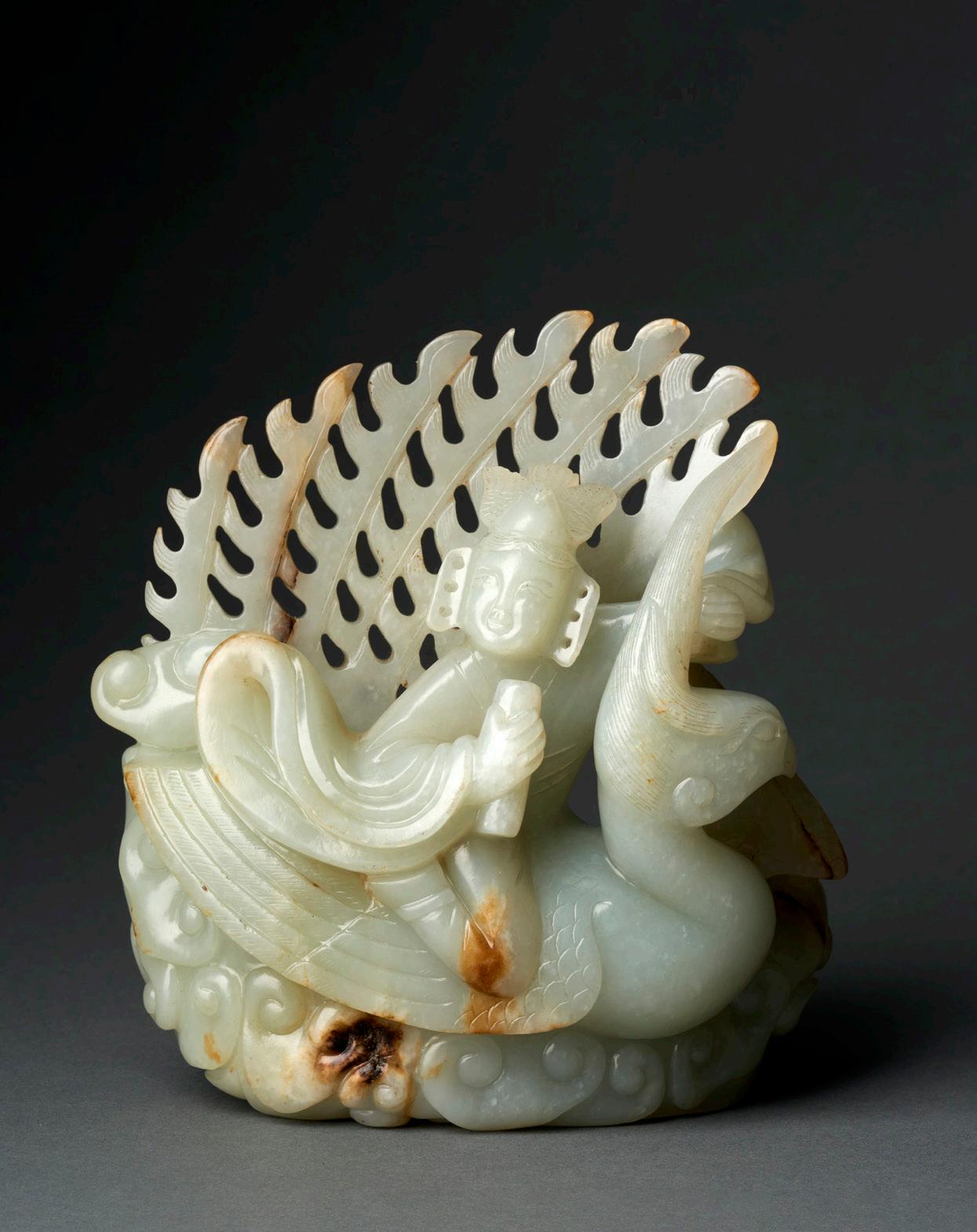
白玉雕「麻姑乘鳳」擺件
類似鳳凰形玉髮飾見: 2015 年 3 月 19 日紐約佳士 得拍賣,第 619 號拍品;另見 James C. Y. Watt 編 《西雅圖美術館藏中國玉器》, 1989 年,頁 63 , 編號 37
A CHINESE WHITE JADE CARVING OF A DOG, QING DYNASTY, 18TH CENTURY OR EARLIER
The reclining hound is carved with its head resting between the outstretched front legs. Its spine and folds on either side of the body are articulated with delicate lines and ridges ending to the rear with a softly coiled tail curled to one side above one leg, and the other leg tucked beneath the body.
Only a small number of jade carvings depicting hounds in this posture are known, typically dated between the Tang and Ming dynasties. A related example, carved from yellow and black jade with a raised head, comes from the Dr. Arthur Sackler Collection and is attributed to the Tang dynasty. It featured Chinese Jades Throughout the Ages, an exhibition held at the Victoria and Albert Museum in 1975 (no. 204), organized by The Arts Council of Great Britain and the Oriental Ceramic Society. Another yellow jade hound, formerly in the Joan Barrow, Lord and Lady Cunliffe, and Mary and George Bloch Collections, was most recently catalogued as Yuan/Ming dynasty. It is illustrated in Dr. Newton’s Zoo, Bluett & Sons, London, 1981 (no. 22), and was later sold at Sotheby’s Hong Kong, 23 October 2005, lot 20. A white jade hound in a similar posture, dated to the Ming dynasty or earlier, was sold at Christie’s Hong Kong on 27 April 1997,
lot 584. A russet jade male hound from the W.P. Chung Collection, dated to the Song dynasty, was exhibited in Chinese Jade Carving (1983, no. 136), jointly presented by the Min Chiu Society and the Hong Kong Museum of Art. Another Song-dynasty example, showing a hound turning its head toward its haunches, is illustrated by Jessica Rawson in “Chinese Jade from the Neolithic to the Qing” (1995, p. 336, no. 26:10), where she notes that such jade hounds may have been worn as symbols of hunting prowess.
14cm long
$4,000-6,000
清 十八世紀或更早 白玉臥犬雕件
犬首伏於前腿之間,脊背與身側褶紋刻劃細緻,尾 部柔和盤曲於一側,一腿收於身下 此姿態玉犬雕件極為罕見,常見於唐至明代。類似 器見: Arthur Sackler 舊藏黃黑玉犬,唐代,展於 1975 年英國維多利亞與亞伯特博物館《歷代中國玉 器展》,編號 204 長 14 公分

A VERY RARE AND FINE CHINESE WHITE JADE CARVING OF A FOREIGNER RIDING A HORSE, MING DYNASTY (1368-1644) OR EARLIER
The foreigner is shown wearing a cap and a longsleeved robe, and sitting astride a horse. Representations of foreigners in jade are seen as early as the Tang dynasty, such as the seated musician carved on a jade plaque in the Museum of Far Eastern Antiquities, Stockholm, illustrated by Desmond Gure, “Selected Examples from the Jade Exhibition at Stockholm, 1963; A Comparative Study”, B.M.F.E.A., vol. 36, 1964, p. 142, pl. 22, fig. 4. Also illustrated and dated Tang, pl. 22, figs. 5a and b, is a small jade figure of a foreigner shown seated as he holds a large jar in his extended hands. Depictions of foreign figures on horseback are exceptionally rare in jade carvings. For related examples, see a jade carving of a foreigner riding an elephant, Bonhams Hong Kong, 30 May 2017, lot 65; and a foreigner with a dog from the same sale, lot 64. Additionally, for a standing jade figure of a foreigner, see Sotheby’s Hong Kong, 28 February 2023, lot 3018; also see Christie’s New York, 21 Sep 2023, lot 812.
W.Y. Thomas Kwok 遺藏,198 0年代初購於&# 39321;港
7.5cm high; 7.5cm wide $5,000-7,000

番人戴帽,著長袍,騎於馬背之上。 玉器中描繪番人形象可追溯至唐代,如斯德哥 爾摩遠東古物博物館藏玉珮上坐奏樂番人,見 Desmond Gure 編《斯德哥爾摩玉器展選例比較研 究》, 1964 年,第 36 卷,頁 142 ,圖版 22 ,圖 4 。 騎馬番人玉雕極為罕見,類似器見: 2017 年 5 月 30 日香港邦瀚斯拍賣,第 65 號(騎象番人);同場 第 64 號(番人與犬);另見 2023 年 2 月 28 日香港蘇 富比拍賣,第 3018 號(站立番人); 2023 年 9 月 21 日紐約佳士得拍賣,第 812 號。

A CHINESE PALE CELADON JADE “LINGZHI AND BATS” BRUSH WASHER, QING DYNASTY, 18TH CENTURY
The deeply hollowed vessel is shaped as a large lingzhi head borne on a gnarled branch, surrounded by smaller lingzhi fungi, with five bats carved in high relief across the top and sides. The original fitted zitan stand is finely carved with four bats and lingzhi motifs, echoing the design of the vessel. It’s with a fitted box.
A much smaller washer (11.5cm wide) of similar lingzhi form, but without bats, was sold at Christie’s London, 8 November 2011, lot 116.
W.Y. Thomas Kwok 17cm wide; 8cm high $6,000-8,000
清 十八世紀 青白玉「靈芝福壽」筆洗 器形取大靈芝頭,枝幹盤曲,周圍環繞小靈芝,器 身高浮雕五隻蝙蝠,寓意「五福捧壽」。原配紫檀 座雕四蝠與靈芝紋,與器物設計相呼應,並附盒。 類似但無蝠紋之小型靈芝形筆洗(寬 11.5 公分) 見: 2011 年 11 月 8 日倫敦佳士得拍賣,第 116 號拍 品。
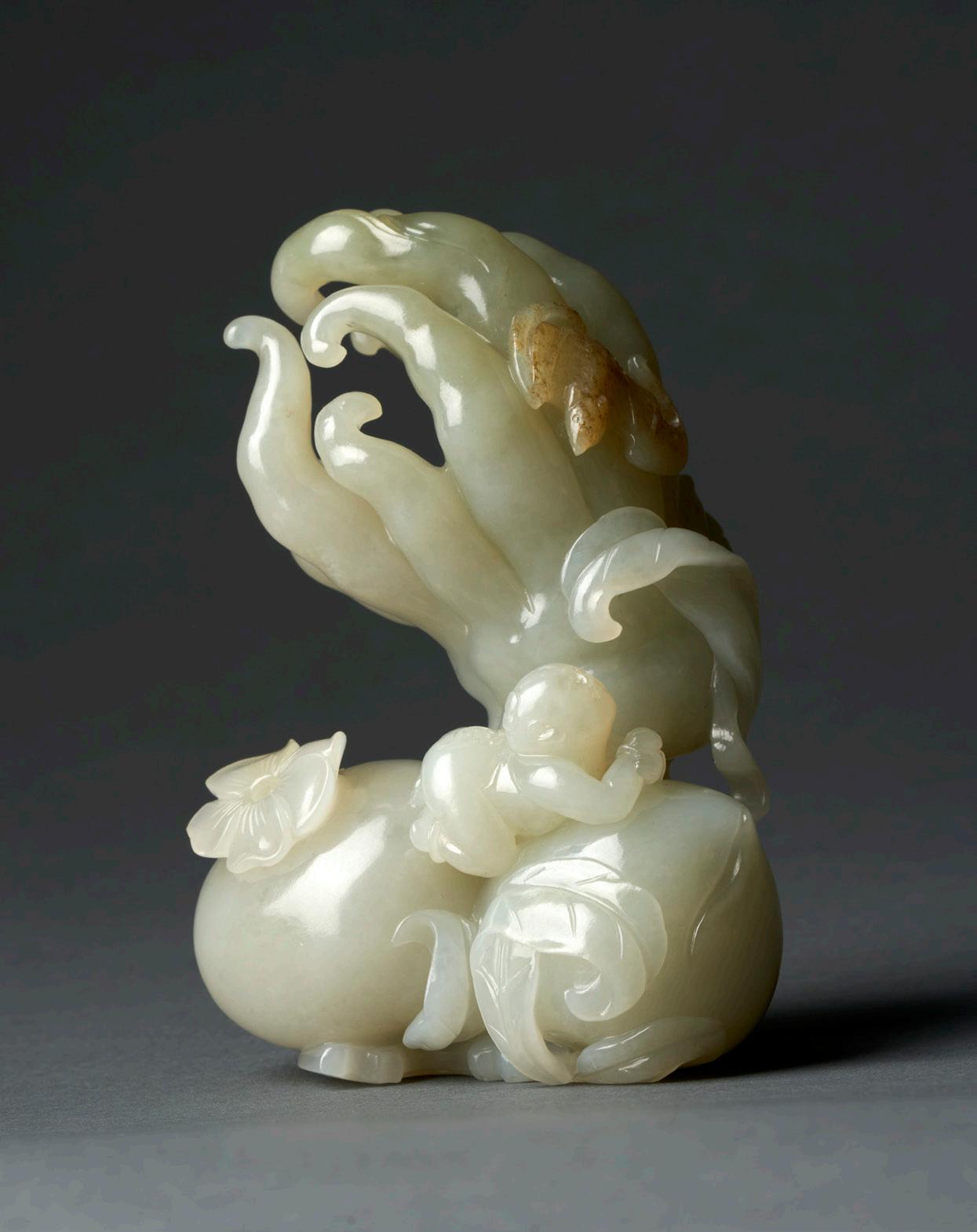
195 A VERY FINE PALE WHITE JADE “SANDUO AND BOY” GROUP, QING DYNASTY, 18TH CENTURY
Finely carved with a Buddha’s hand citron and a bat, alongside a pomegranate and a peach, with a small boy playfully resting atop the fruits.
Another jade carved “sanduo” group, see Christie’s London, 9 May 2017, lot 61.
W.Y. Thomas Kwok 10cm high; 7cm wide $5,000-7,000
清 十八世紀 白玉「三多與童子」雕件
雕佛手、蝙蝠、石榴與壽桃,童子嬉戲其上,寓 意:多子多福多壽
類似器見:2017年5月9日倫敦佳士得拍賣,第 61號拍品
A CHINESE CARVED WHITE JADE PHOENIX WASHER, QING DYNASTY, QIANLONG PERIOD (1736 - 1795)
The circular censer is carved resting on four flaring feet with two carved phoenix handles with loose rings to the sides. It’s with a fitted box.
A similar example with butterfly handles, see Bonhams London, 17 May 2012, lot 18. 15.5cm wide; 5cm high $3,000-5,000
清乾隆 白玉雕雙鳳耳洗
圓形器身,底部四足外撇,兩側飾鳳凰耳並配活 環,附盒。
類似器見: 2012 年 5 月 17 日倫敦邦瀚斯拍賣,第 18 號拍品(蝶耳例)
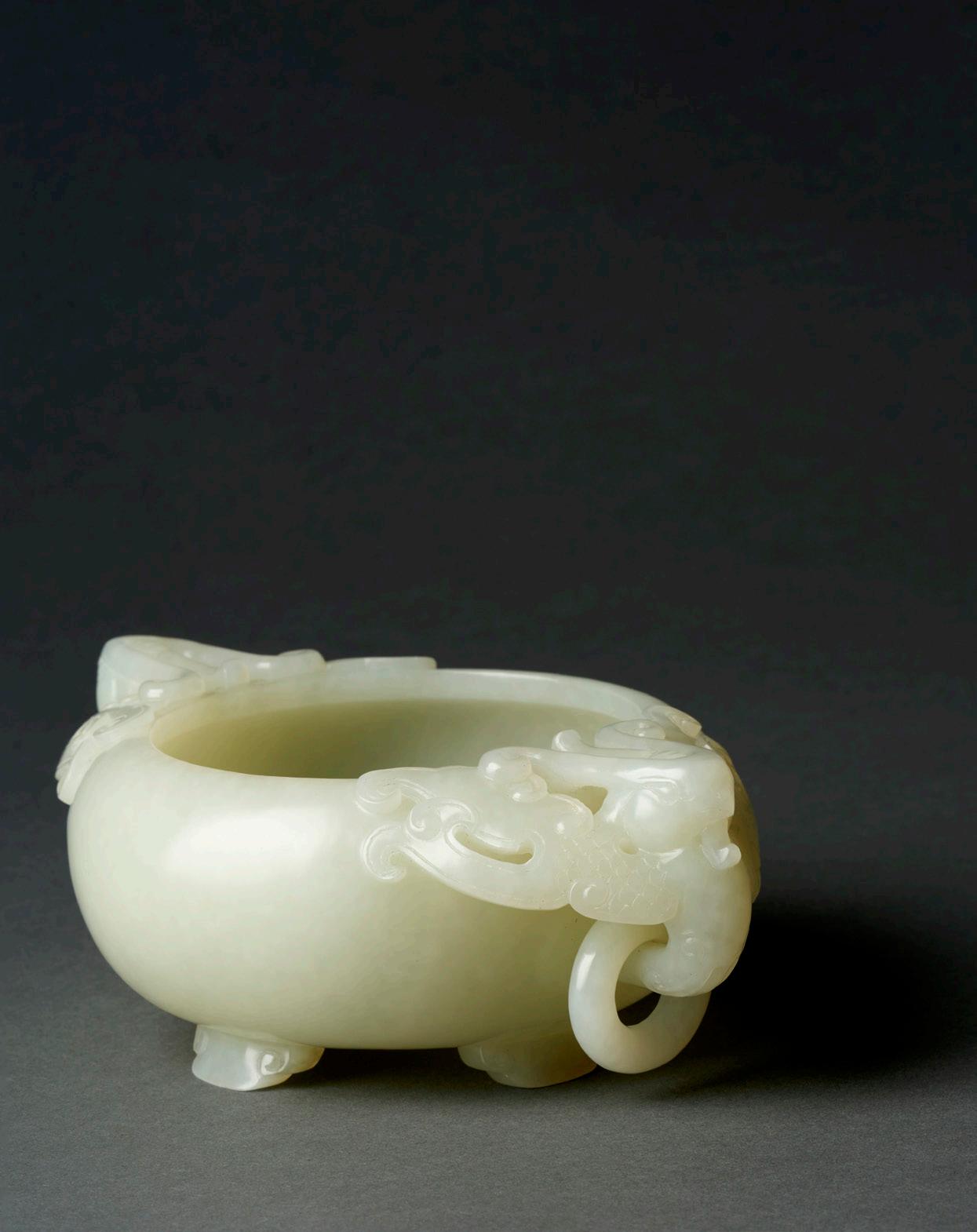
197 AN IMPERIAL CHINESE INCISED AND GILT SPINACH GREEN JADE “IMPERIALLY COMPOSED RECORD OF TEN COMPLETE VICTORIES” PLAQUE, QIANLONG PERIOD (1736 - 1795)
This jade plaque is made of Hetian green jade, inscribed with the full text of the Imperially Composed Record of Ten Complete Military Victories (Yuzhi Shiquan Ji), comprising a total of 724 characters. Each line contains thirty-seven characters, written in the formal Guange script style in meticulous, elegant calligraphy. The text is shallowly incised and then gilded. The carving is executed with extraordinary precision, using the center of the brush stroke to render the characters with smoothness and delicacy, as if written directly onto the jade with a brush. The gilding remains well preserved. At the end of the inscription is the colophon: “Respectfully written by your servant Zheng Rui.” Based on its form, this jade plaque likely served as the central panel of a table screen. The jade used is of substantial size and exceptional quality-fine, lustrous, and uniformly colored, free
from cloudy inclusions or cracks. Even among the Qing palace collections of the Qianlong period preserved in the Palace Museum today, jade of such superior quality is exceedingly rare.
In the 24th year of Qianlong’s reign (1759), one of the Emperor’s most celebrated military achievementsthe pacification of the Dzungars-was completed.
As a result, Xinjiang, the source of Hetian jade, was brought under the direct control of the Qing government, and tribute jade from Hetian began to be sent in steady supply to Beijing. This provided Qianlong with new means to express his distinct aesthetic and imperial authority.
According to the Complete Archives of Qing Imperial Porcelain, Vol. 23, No. 72, a detailed inventory was recorded for Qianlong’s 85th birthday in 1794 (the 59th year of his reign), listing the tribute offerings from various princes, ministers, and regional governors. Among the gifts submitted by Zheng Rui on the first day of the eighth lunar month is an entry for a “Pair of Table Screens Inlaid with Jade Inscribed with the Record of Ten Complete Victories.” The jade screen offered in this auction is likely one of that very pair. According to archival
notes indicating it was “sent to Rehe,” it may have been lost overseas from the imperial summer retreat at Chengde (Rehe).
As for Zheng Rui, according to the Draft History of Qing - Biographies of Manchu and Han Officials, Vol. 24, he was of the Fuca clan, a Manchu of the Plain White Banner under the Imperial Household Department, and held in high regard by Emperor Qianlong (the Plain White Banner was one of the upper three banners directly under imperial command). In the 34th year of Qianlong’s reign, he was appointed Superintendent of Yuanmingyuan Garden; in the 43rd year, he became Superintendent of Weaving in Hangzhou; and in the 48th year, Salt Commissioner of the Lianghuai region. These were all lucrative and powerful posts responsible for sourcing luxury goods for the imperial household. With long-term oversight of key centers for the production of jade carvings and precious artifacts, such as Yangzhou, Suzhou, and Hangzhou, and enjoying ample wealth, Zheng Rui frequently presented opulent gifts to the emperor. In June of the 58th year of Qianlong’s reign (August 1793), while serving as Salt Commissioner of Changlu and Imperial Envoy, Zheng Rui-together with the Governor-General of Zhili-received the famous British diplomatic mission led by Lord Macartney in Tianjin. Zheng Rui escorted the delegation to the Chengde Summer Resort, where they were granted an audience with the Emperor. He was also involved in multiple rounds of negotiation with the British concerning the court rituals expected for their audience with Qianlong. With the Emperor’s final consent, the British envoy reluctantly performed a one-knee genuflection.
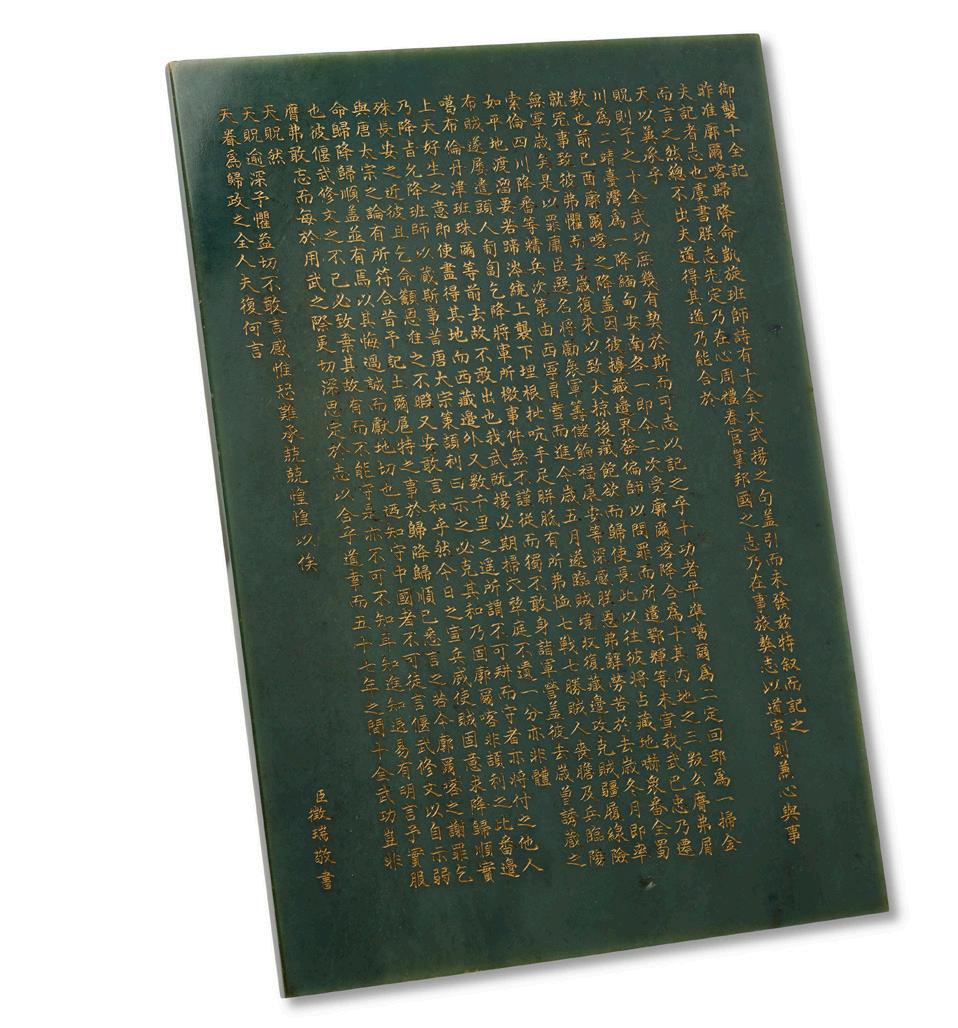
For an almost identical jade plaque, see Yongle Auction, Beijing, 20 June, 2024, lot 1774. 28.6cm high; 19.6cm wide
$6,000-9,000
清乾隆 「御製十全記」碧玉填金刻文屏心 以和田碧玉製成,刻御製《十全記》全文,共 724 字,每行 37 字,以館閣體書寫,筆法工整,刻文 淺浮並填金。 文末署「臣鄭瑞敬書」,推測此玉 珮為屏風中央主板。此件玉質碩大,色澤潤澤均 勻,無雜質或裂紋,品質極高。據《清宮瓷器檔案 全集》第二十三冊第七十二號記載,乾隆五十九年 ( 1794 年)鄭瑞進獻「碧玉刻十全記屏風一對」。 鄭瑞為滿洲正白旗人,歷任圓明園總管、杭州織 造、兩淮鹽政等要職
A FINE CHINESE WHITE JADE BAMBOOFORM BRUSH POT, BITONG, QING DYNASTY, 17TH/18TH CENTURY
The brush pot is finely carved with three hollow bamboo trunks, and branches of bamboo, pine, plum tree, a magpie and a bamboo shoot.
A smaller brush pot (8cm high) also with a bamboo form, see Sotheby’s London, 8 Dec. 2022, lot 261. 13cm high; 9cm wide
$4,000-6,000
清 十七/十八世紀 白玉竹節式筆筒 筆筒雕三節中空竹幹,並飾竹枝、松枝、梅花、 喜鵲與竹筍。
類似器見: 2022 年 12 月 8 日倫敦蘇富比拍賣,第 261 號拍品(尺寸較小)
199 A VERY RARE AND FINE CHINESE WHITE JADE PHURBA, QING DYNASTY, QIANLON PERIOD (1736 - 1795)
The handle of this jade phurba is finely carved with four faces of Mah¨¡k¨¡la, the wrathful deity, above two rows of lotus petals at the midsection. The blade is adorned with three entwined snakes.
The jade phurba is extremely rare. Judging from the exquisite craftsmanship and the quality of the white jade, it was most likely an imperial commission intended as a ritual object for a high-ranking Tibetan lama. Jade carvings of Tibetan ritual implements are exceptionally uncommon; for comparison, see a white jade vajra sold at Christie¡¯s Paris, 14 June 2023, lot 41, as well as a vajra and bell from the same sale, lot 42. 14.2cm long.
$4,000-6,000
清乾隆 白玉雕金剛杵
柄部雕四面大黑天像,下飾兩層蓮瓣,刃部纏繞 三條蛇紋。
此玉金剛杵極為罕見,工藝精湛,玉質上乘,推測 為清宮特製供高僧法器之用。
玉雕藏傳法器極為罕有,參見: 2023 年 6 月 14 日巴 黎佳士得拍賣,第 41 號白玉金剛杵;同場第 42 號拍 品金剛杵與法鈴
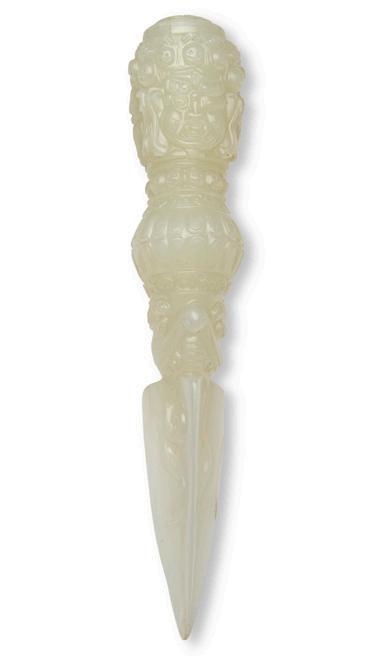
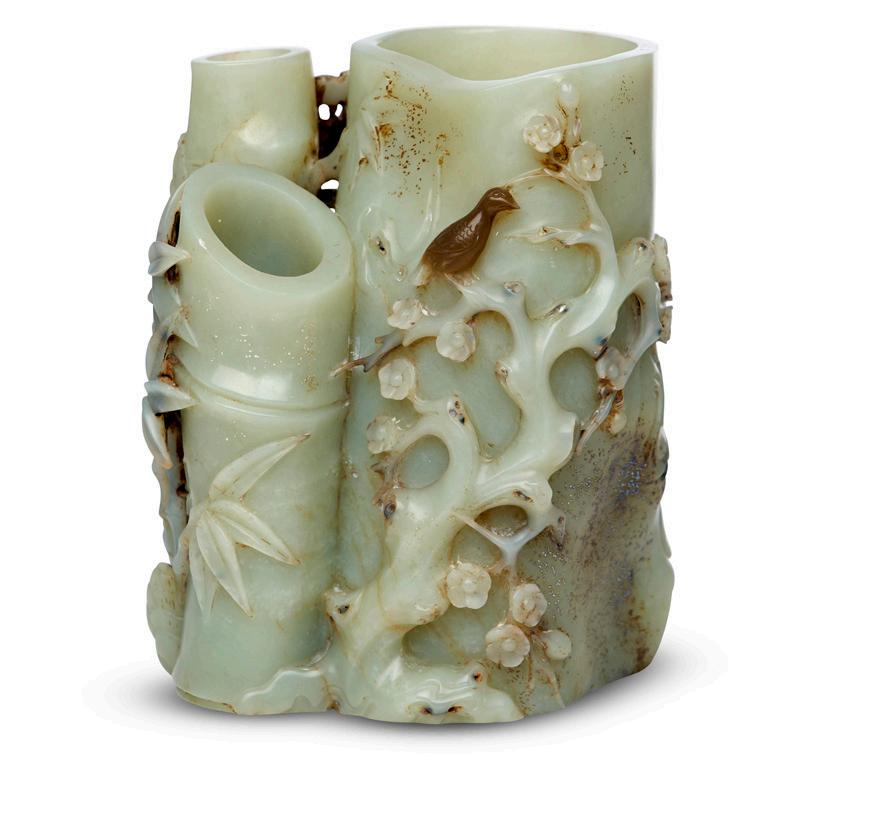
200
A CHINESE CELADON AND RUSSET JADE CARVING OF RECUMBENT BUFFALO, QING DYNASTY, 18TH CENTURY
The celadon jade is finely carved in the form of a recumbent horned buffalo. With a fitted box. Compare to a similar jade buffalo with a boy on its back, see 23 Sep 2022, lot 740. A smaller yellow jade example see Christie’s Hong Kong, 30 May 2023, lot 3046.
15cm wide; 5cm high
$3,000-5,000
清 十八世紀 青白玉帶皮臥水牛雕件 玉質青白帶褐皮,雕臥姿水牛,角形清晰,神態 安詳,配盒。
類似器見: 2022 年 9 月 23 日拍賣,第 740 ; 2023 年 5 月 30 日香港佳士得拍賣,第 3046 號。

201
A CHINESE WHITE AND RUSSET JADE BOULDER, QING DYNASTY, 18TH/19TH CENTURY
The boulder is finely carved on one side with a scholar on a horse in a mountain landscape. The reverse side further carved with rocks. The white jade with areas of enhanced russets. It’s with a carved fitted zitan stand and a fitted box.
9.1x6.5cm
$3,000-5,000
清 十八/十九世紀 白玉帶皮山子雕「馬上高士」圖 一面雕山中騎馬高士,背面雕岩石,白玉局部帶皮 色,配雕紫檀座及盒
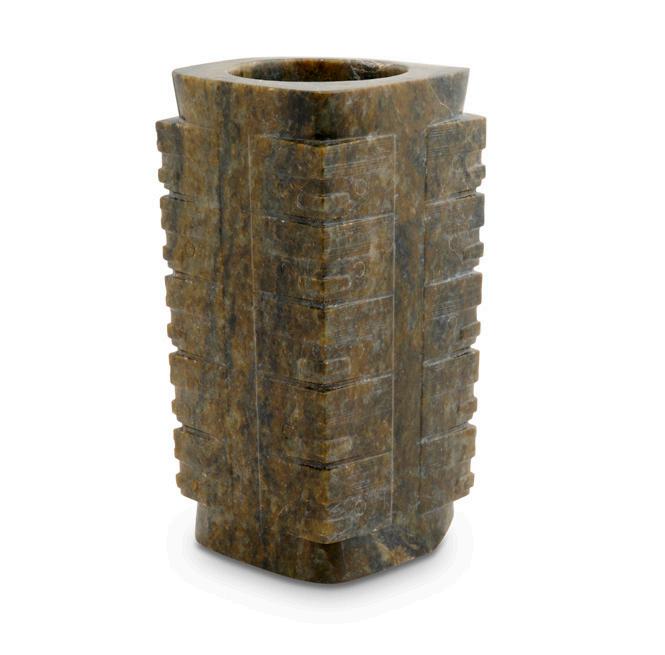
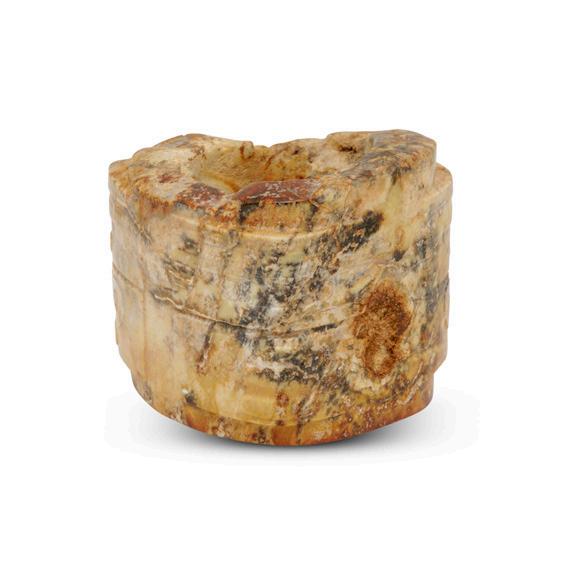
202
A CHINESE CELADON CARVED JADE CONG 15.3cm high
$3,000-5,000
青玉琮
203 A RARE CHINESE CARVED MOTTLED OPAQUE JADE CONG, POSSIBLY NEOLITHIC PERIOD, LIANGZHU CULTURE, 3RD MILLENIUM BC
6.5cm high
provenance
A private collection, NSW.
$2,000-3,000
或為新石器時代 良渚文化玉琮
源流:新南威爾士私人收藏
204
A CHINESE JADE DISC, BI, MID-WARRING STATES PERIOD, CIRCA 400-300 BC
The disc is carved on both sides with raised bosses in the form of comma spirals enclosing the central aperture within raised borders.
A slightly larger example (12.5cm diameter), sold at Christie’s Hong Kong, 3 Dec. 2021, lot 2725. 8.2cm diameter
$8,000-12,000
戰國中期 玉璧
205 A CHINESE MOTTLED CELADON JADE DISC, BI, POSSIBLY HAN DYNASTY (202 B.C.-220 A.D.)
11cm diameter
provenance
An important private collection, acquired from Hong Kong in the early 90s.
$1,500-2,500
或為漢 青玉璧
源流:重要私人收藏, 1990 年代初購自香港
206
A CHINESE OPAQUE MOTTLED JADE DISC, BI, NEOLITHIC PERIOD, 3RD MILLENIUM BC 10.5cm diameter
provenance
A private collection, VIC., acquired in Taipei in 1990s’.
$1,500-2,500
新石器時代 玉璧
207
A CHINESE YELLOW JADE DISC, NEOLITHIC PERIOD, 7000 B.C.-1700 B.C. TOGETHER WITH A CHINESE JADE BELT BUCKLE, SONG-YUAN DYNASTY, 13-14TH CENTURY
3.7cm diameter, belt buckle: 6.4cm long
provenance
An important private collection, acquired from Hong Kong in the late 80s.
$3,000-5,000
新石器時代 黃玉璧 及 宋/元 青白玉帶扣 源流:重要私人收藏,1980年代末購自香港
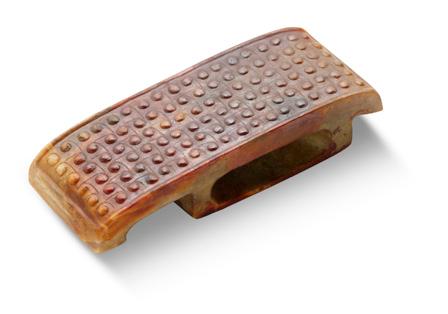
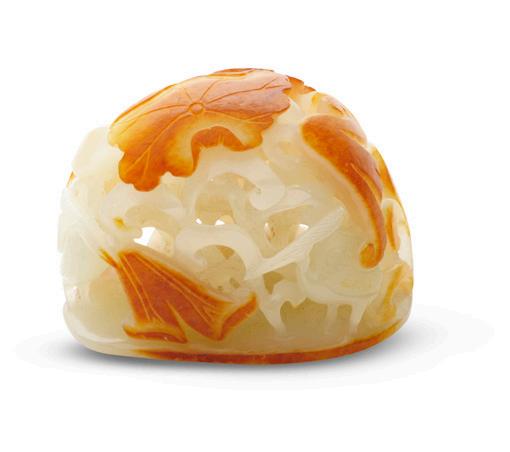
208
A CHINESE JADE ‘BOSSES’ SWORD SLIDE, WESTERN HAN DYNASTY (206 BC- 8 AD)
The sword slide is carved on the surface with rows of rounded bosses connected by incised lines. It’s with a fitted box.
5.5 long; 2cm wide
$3,000-5,000
西漢 玉劍珌
209 A CHINESE WHITE JADE BELT PLAQUE, TANG DYNASTY (618-907)
One side of the plaque is carved with a seated musician playing a hand drum.
provenance
A private scholar’s collection, acquired in Hong Kong in the early 80s.
5.2 X 4cm
$3,000-5,000
唐 白玉帶飾 一面雕坐姿樂人,擊手鼓
210
A CHINESE GREEN JADE CONG, MING DYNASTY (1368 - 1644) 10.5cm high
provenance
An old private collection, VIC., acquired in the early 90s.
$800-1,200
明 青玉琮
211
TWO CHINESE CARVED JADE ANIMALS, QING DYNASTY (1644 - 1911)
Comprising a jade carved rabbit and a jade carved pig.
5.2cm and 4cm long
provenance
An old private collection, VIC., acquired in the early 90s.
$300-500
清 玉雕兔與玉雕豬
212 A CHINESE WHITE AND RUSSET JADE OPENWORK CENSER COVER FINIAL, JIN/ YUAN DYNASTY, 12TH-14TH CENTURY
A similar white jade example see, Christie’s New York, 19 Sep 2013, lot 1134; also see Christie’s London, 7 Nov. 2012, lot 667 for a celadon and russet example. 6cm wide; 4.5cm high
$2,000-3,000
金 / 元 白玉帶皮鏤雕爐頂
類似白玉例見紐約佳士得,2013年9月19日,拍品1134 號;另見倫敦佳士得,2012年11月7日,拍品667號( 青白玉帶皮例)。
213
A COLLECTION OF FIVE CHINESE ARCHAIC JADE PENDANTS, WARRING STATES/HAN PERIOD, 3RD B.C./3RD A.D. Later strung into a necklace, with gold beads. Largest: 3.2cm high
$3,000-5,000
戰國至漢代 玉佩飾 五件一組
214
TWO WHITE JADE CARVED PLAQUES, QING DYNASTY (1644 - 1911)
larger one: 6.5 x 4cm
$600-800
清 白玉雕刻饰牌 兩件
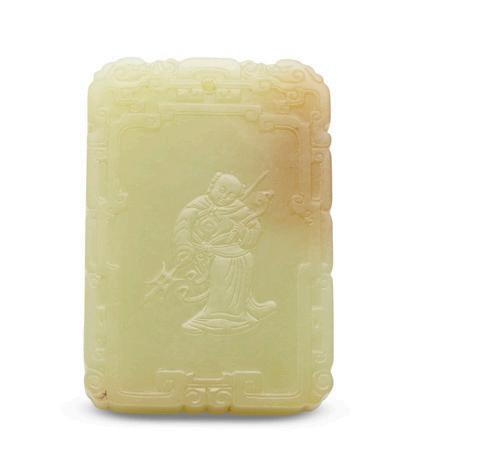
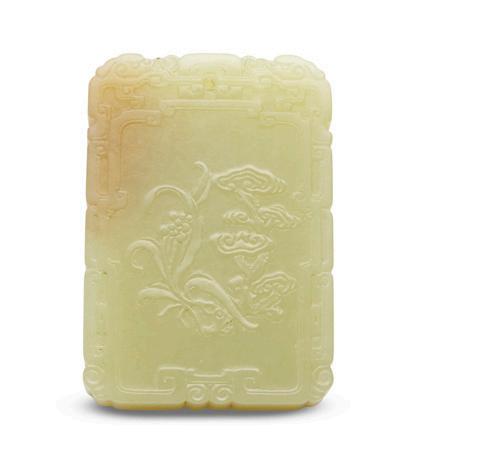
215
A CHINESE YELLOW JADE CARVED PLAQUE, QING DYNASTY (1644 -1911)
One side of the plaque is carved in low relief with a boy general holding a trident in the right hand and a ruyi sceptre in the left. The other side is with lingzhi fungus and orchids, conveying auspicious wishes. The stone is of an even pale greenish yellow tone. Similar yellow jade plaque, see Christie’s London, 8th Nov., 2016, lot 181; and Sotheby’s Hong Kong, 28th Nov., 2019, lot 674.
5.2 x 3.5cm
$3,000-5,000
清 黃玉雕人物花卉掛牌
一面童將持三叉戟與如意,一面靈芝蘭花寓意吉 祥,玉質瑩潤,呈栗黃色。
216
A CHINESE CARVED WHITE JADE PENDANT, QING DYNASTY (1644 - 1911)
5.6cm high
$800-1,200
清 白玉雕墜飾
217
A CHINESE WHITE JADE CARVED OPENWORK “SPRING WATER AND AUTUMN MOUNTAIN” PLAQUE JIN-YUAN DYNASTY (1115-1368)
4.5 x 3cm
$3,500-5,500
金/元 「春水秋山」白玉珮
玉質潔白細膩,鏤雕山水意境,構圖疏朗,為金元 時期玉雕藝術之佳例。
218
A CHINESE WHITE JADE SWORD FITTING, QING DYNASTY (1644 - 1911)
The sword slide is carved in low relief at one end with a stylised animal mask characterised by bushy eyebrows above a pair of large squarish eyes, the rest of the surface carved with double-C and heartshaped scrolls.
8.5 x 3cm
$1,000-2,000
清 白玉劍飾 一端浮雕獸面紋,眉毛濃密,雙目方大,其餘表面 雕雙C及心形卷草紋
219
TWO CHINESE WHITE JADE OPENWORK PENDANTS, QING DYNASTY (1644 - 1911)
8.3 x 5cm; 7.6 x 3.5cm
$800-1,200
清 白玉镂空掛件 一组两件
220
TWO CHINESE CELADON JADE CARVED ROUNDED PLAQUES, QING DYNASTY (1644 - 1911)
each with a fitted wood stand. Larger one: 7 x 6cm
provenance
An old private collection, VIC., acquired in the early 90s.
$600-800
清 青白玉圆形雕刻饰牌 兩件
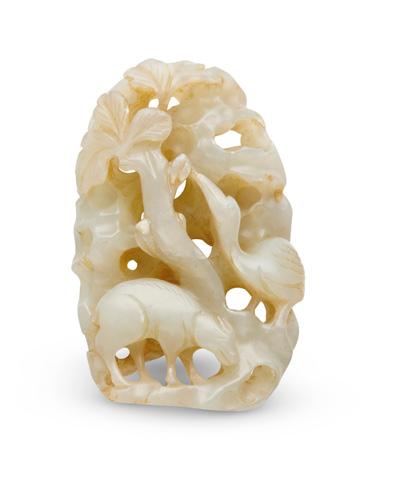
221
A CHINESE WHITE JADE CARVED QIN FORMED PLAQUE , QING DYNASTY (16441911)
13.5cm wide; 5cm high
$800-1,200
清 白玉雕琴形饰牌
222
A CHINESE CELADON WHITE AND RUSSET JADE CARVED OPENWORK “SPRING WATER AND AUTUMN MOUNTAIN” FINIAL, JIN/ YUAN DYNASTIES (1115-1368)
For a related finial with slightly less refined carving, see Christie’s London, 7 Nov. 2012, lot 667. 4.6 x 3.8cm
$5,000-7,000
金/元 青白玉「春水秋山」雕件
223
A CHINESE CARVED WHITE AND RUSSET JADE MOUNTAIN BOULDER, QING DYNASTY (1644 - 1911)
It is finely carved with a scholar and his attendant in a landscape scene. It’s with a fitted hardwood stand. 19.5cm wide; 13.5cm high
$6,000-8,000
清 白玉雕山水人物山子擺件
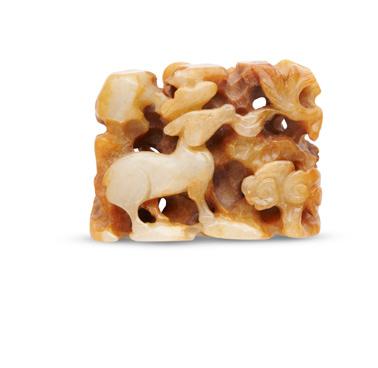
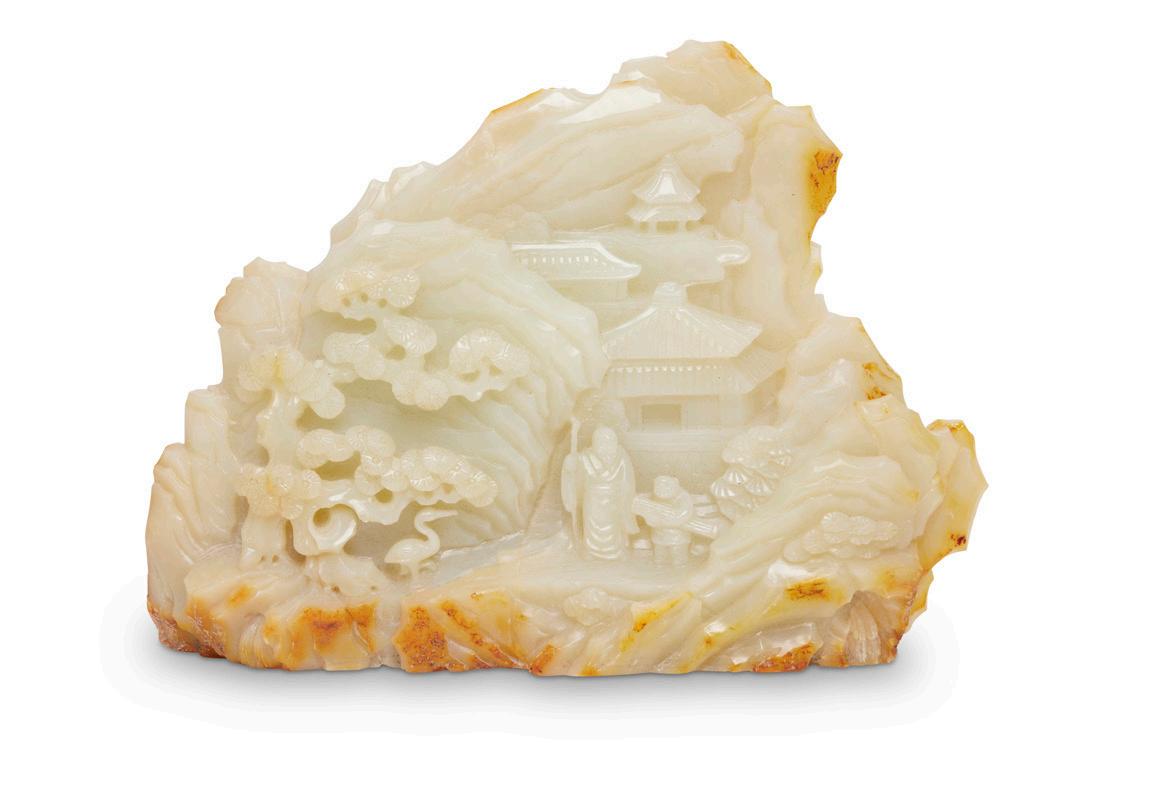
A LARGE AND FINE CHINESE WHITE JADE CARVED BRUSH POT, MID-QING DYNASTY, 18TH/19TH CENTURY
Carved from a single block of fine white jade, this brush pot is of cylindrical form with gently tapering sides, supported on a foot ring and set on a hardwood stand inlaid with silver wire. The stone is of pure, translucent quality, lustrous and unblemished. The exterior is finely carved in high relief with a continuous mountain landscape. Steep cliffs, trees, streams, and pavilions are depicted in lively detail, while figures of men, women, and children traverse winding paths, each animated with individuality and charm. The decoration encircles the vessel without beginning or end, creating an unbroken panoramic composition in the manner of tongjing shanshui (continuous landscape painting). It’s with a fitted hongmu stand. The stand inlaid with silver wire. Imperial jade carving of the Qing dynasty was distinguished by its abundant material, technical precision, and refined design. Supplied with the finest Hetian jade from Xinjiang, court workshops were able to achieve works of both elegance and grandeur. This brush pot, with its fluid lines, naturalistic detail, and vivid human presence, epitomises the highest standards of Qing jade craftsmanship and ranks as a masterpiece of the genre. 16.9cm high
provenance
An important private collection, VIC. $40,000-60,000
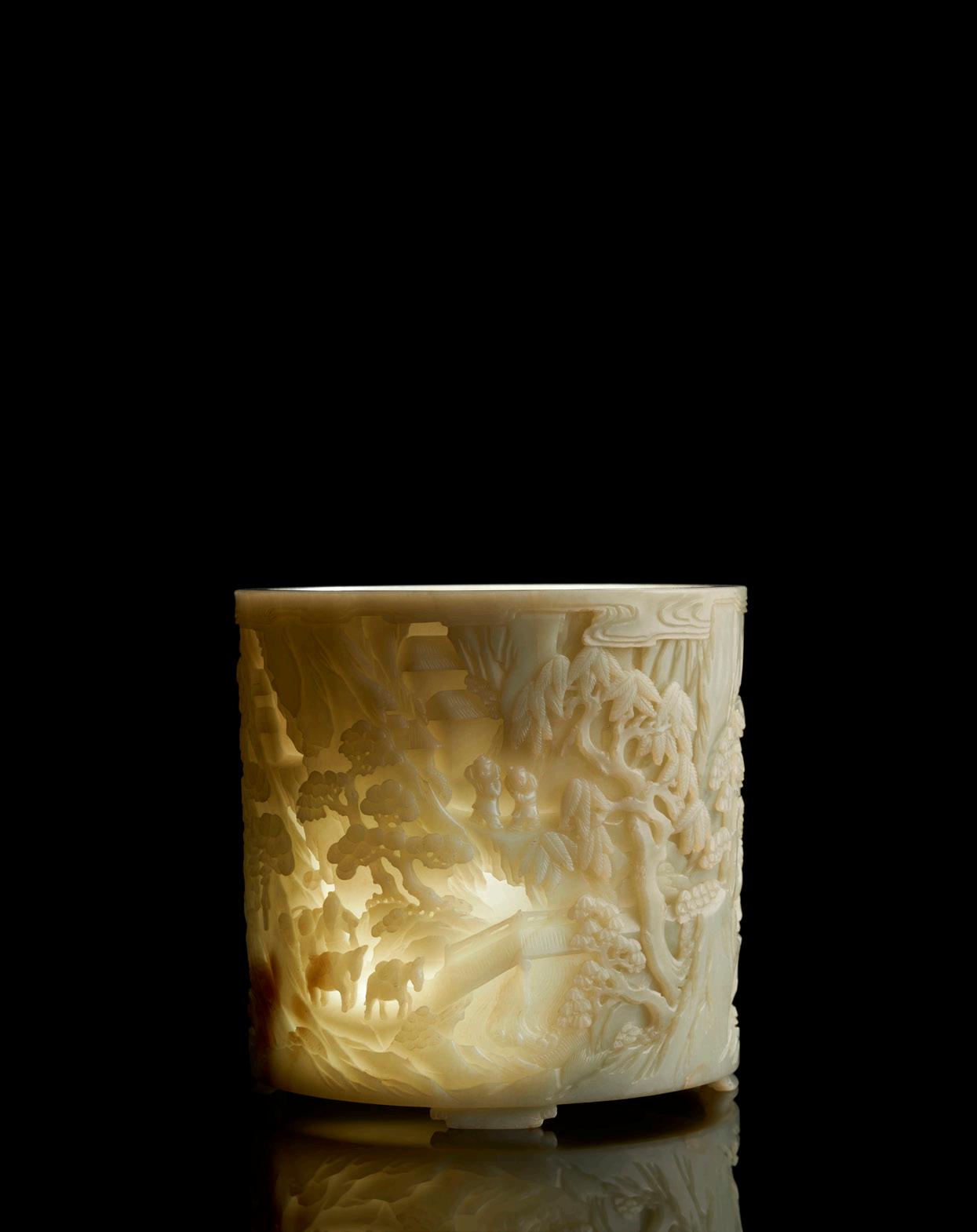
清中期 白玉雕大筆筒
此筆筒以整塊上乘白玉雕製,呈圓筒形,器身微微 收束,下承圈足,配紫檀木座,座面嵌飾銀絲。玉 質潔白通透,光澤柔潤,無瑕可見。
外壁高浮雕連綿山水景致,峭壁、林木、溪流、亭 閣細緻生動,人物男女老幼穿行於曲徑之中,神 態各異,栩栩如生。紋飾環繞器身,無始無終, 構成一幅通景山水畫卷。配紅木座,座面嵌飾鍍 金銀絲。
清代宮廷玉雕以料豐、工精、意雅著稱。新疆和 田玉供應充足,使得造辦處得以創作兼具典雅與 氣勢之佳作。此筆筒線條流暢,細節自然,人物 生動,堪為清代玉雕工藝之典範,實屬同類器物 中之上品。
225 A CHINESE YELLOWISH CELADON JADE CARVED CHILONG WASHER, MING DYNASTY (1368 - 1644) with a fitted box and huanghuali stand. 10cm wide
$2,000-3,000
明 黃玉螭龍紋洗 附黃花梨底座及盒
226
A CHINESE JADE CUP, MING DYNASTY (13681644)
A similar cup dated to Jin/Yuan, is illustrated in Forsyth and McElney, Jades from China, no. 262, p. 341. For a late Tang white ceramic cup of similar form and with a similar handle, which may have been the inspiration for this vessel, see Zhejiang Kaogu Jinhua, p. 209.
8.9cm wide
provenance
Roger Keverne Pty. Ltd. , London, 2013.
exhibitions
London, Roger Keverne Pty. Ltd, Winter, 2013. literature
Roger Keverne, Winter 2013, no 69.
$15,000-25,000
明 青白玉提油靈芝耳盃 出版著錄:
Forsyth與McElney《中國玉器》,編號262,頁341 ;
《Roger Keverne 冬季展》,2013年,編號69 源流:
Roger Keverne Pty. Ltd.,倫敦,2013年
227
A CHINESE WHITE AND BLACK JADE CARVING OF A BOY, MING DYNASTY (13681644)
The boy is carved holding a double gourd. 4.5cm
$800-1,200
明(1368–1644) 白玉提油雕童子抱葫蘆臥像
228
A GROUP OF THREE CHINESE JADE CARVINGS OF ANIMALS, QING DYNASTY (1644 - 1911)
largest: 5.8cm wide; 3.5cm high
$1,000-2,000
清 玉雕動物一组三件
229
A VERY FINE AND LARGE CHINESE WHITE JADE CARVED GOOSE, QIANLONG PERIOD (1736 - 1795)
With a carved fitted zitan stand. 13.9cm wide; 8.5cm high
provenance
An important private collection, VIC.
$6,000-8,000
清 乾隆 白玉雕臥鵝擺件
配紫檀底座
源流: 維州重要私人收藏。
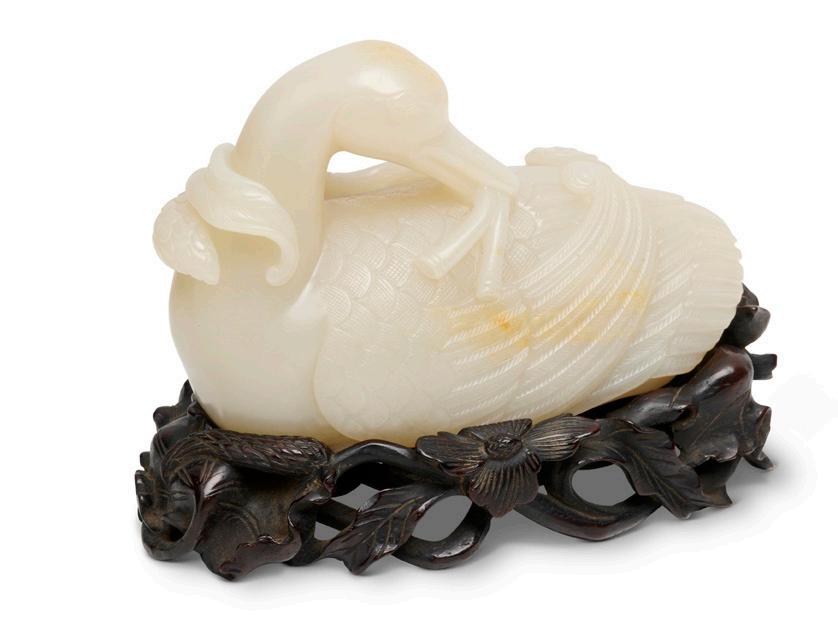
230 A FINE CHINESE CELADON WHITE JADE ARCHAISTIC WINE VESSEL, GONG, QING DYNASTY (1644 - 1911)
Of oval section, the shallow rounded sides carved in low relief with meandering scrolls issuing from a taotie mask below the broad spout and extending towards the dragon handle, the domed cover carved with a further taotie mask and surmounted by an animal knop, the rims incised with key-fred borders. A similar jade gong-form vessel, see Christie’s New York, 23 Sep 2022, lot 759. Another related example, also see Bonhams Hong Kong, 26 May 2013, lot 189. 17cm wide
provenance
Sotheby’s Sydney, 30/10/2019, lot 21. A private collection, SA.
$5,000-7,000
清 青白玉觥
源流:
2019年10月30日,悉尼蘇富比,拍品21;南澳私人 收藏。

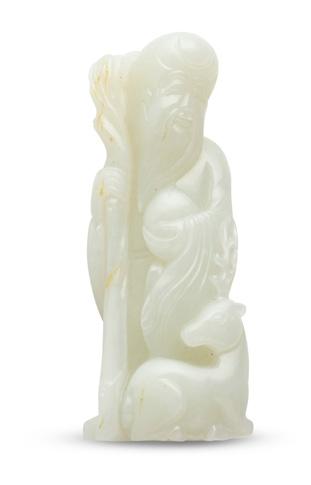
231
A LARGE AND FINE CHINESE CELADON AND DARK JADE GOOSE FORM WASHER, MING DYNASTY (1368 - 1644)
11.5 x 9.5cm
$6,000-8,000
明 白玉提油雕鵝形水盂
232
A CHINESE PALE WHITE JADE CARVED ROUNDED PLAQUE AND HARD WOOD TABLESCREEN, MID-QING DYNASTY, 18TH/19TH CENTURY
The jade plaque is decorated with scholars in a landscape scene.
26cm high; 17cm wide
$4,000-6,000
清中期 白玉雕圓形桌屏 配紅木架
此白玉圓形牌以山水人物為題,雕飾文人雅士於山
233
A CHINESE WHITE JADE FIGURE OF SHOULAO AND DEER, QING DYNASTY (1644 - 1911)
9.5cm high
provenance
Bonhams Sydney, 27-28 April, 2022, lot 124.
$2,000-3,000
清 白玉雕「壽老與鹿」
源流: 2022年4月27–28日,悉尼邦瀚斯,拍品124。
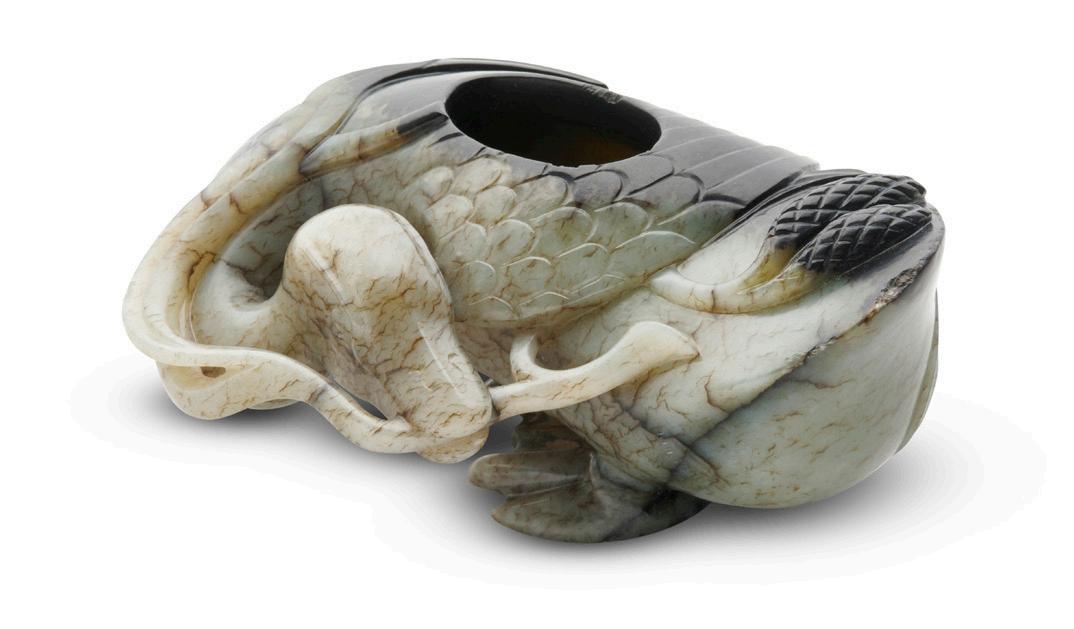
234
A CHINESE WHITE JADE HORSE, QING DYNASTY, QIANLONG PERIOD (1736 - 1795)
The horse is shown with legs tucked under the body and head turned backwards, the ridged backbone following the elegant curve of the body. The mane and tail are rendered with fine hair markings. It’s with a fitted wood stand.
A closely comparable, though slightly smaller example (6.8 cm long) from the Durrwin Tang Collection was sold at Bonhams Hong Kong, 27 November 2018, lot 135, for HKD 1,625,000 (approximately AUD 318,385). Another jade horse of similar grey tone and nearly identical posture, dated to the Ming dynasty, was offered at Christie¡¯s New York, 24 September 2021, lot 742. 8cm wide; 6cm high
provenance
A private collection, SA.
$1,000-2,000
清乾隆 白玉臥馬
玉馬作臥姿,四足收於身下,回首顧盼,脊背線條 流暢優雅,鬃尾刻劃細緻。配原裝木座。
源流:
南澳私人收藏
235
A CHINESE WHITE JADE CARVED LOTUS CUP, QING DYNASTY, 17TH CENTURY
10cm diameter
$1,500-2,500
清 十七世紀 白玉雕蓮花盃
236
A CHINESE CELADON WHITE JADE BRUSH, QING DYNASTY (1644 - 1911)
16.8cm wide
$2,500-3,500
清 青白玉毛筆
筆身以青白玉雕成,玉質溫潤,造型簡潔,為清代 文房用具之雅器。
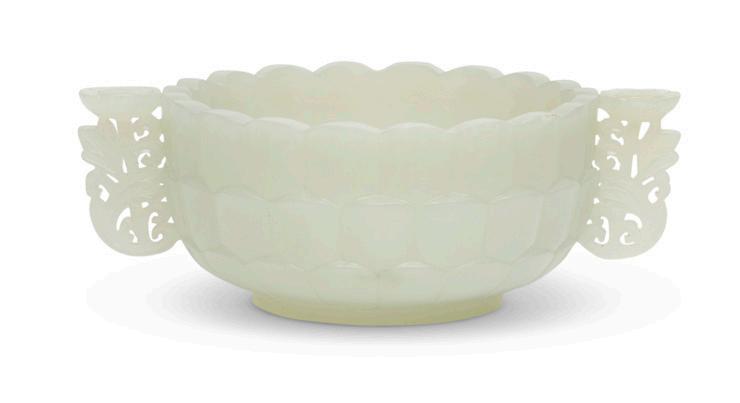

A Private Collection of Chinese Traditional Furniture and Scholar
Objects, ACT.
lots 237 – 256
A formative visit to the legendary connoisseur Wang Shixiang in the early 1990s set the tone for this collection. Inspired by Wang’s scholarship and exacting standards, the collector pursued works that embody historical truth in period, workmanship, and material. Each acquisition reflects a Ming–Qing aesthetic rooted in both function and display, where structure, joinery, and line are imbued with meaning.
Over nearly three decades, the collector travelled through China’s cabinetmaking heartlands, from the robust traditions of the North to the refined literati style of the South. Beyond the markets, she ventured into villages and households where furniture and techniques still survived, many now lost, building enduring relationships with dealers, artisans, and craftspeople across regions. This fieldwork informed a discerning eye, ensuring selections that carry both artistry and cultural resonance.
In parallel, the collector established an exclusive workshop, employing craftsmen trained in traditional disciplines and working largely with handmade tools handed down through generations. Conservation was approached with scholarly precision, using periodappropriate timbers, joinery, and finishes, while preserving patina, wear, and construction evidence. The result is a group of exceptional works, often of museum calibre, presented with both historical integrity and visual harmony. For collectors and institutions alike, this represents a rare opportunity to acquire furniture that unites artistic mastery with impeccable provenance and ethically guided preservation.
90年代初,一次对古典家具鉴藏家王世襄先生的拜访,成为了这批藏品故事的起点。
那次会面不仅是一次学术交流,更像是一场启蒙。在畅安先生深厚的学识和极高的审美标准影响下,藏家 踏上了乐此不疲的寻器之旅,希望找寻,收藏并保护那些真正符合历史时代、工艺水准与材质要求的古典 家具。
藏家所理解并珍爱的中国古典家具,并非只是单纯的陈设之美,而是明清家具中“形、制、用”兼备的深 意。它们结构严谨,榫卯精妙,线条之间皆有文脉相承。每一件收藏,都是一次对历史的考证,也是一次与 时代与匠心的对话。
在过去的三十年里,藏家走入了从南到北的许多村落与民居,寻找那些被时间遗忘的器物与传承技艺——许 多木工技法如今已濒临失传。她不仅想做一个藏家,更想做一个田野研究者。在与家俱古董商、木作师傅、 民间艺人的长年交流中,她得到了坚持下去的力量与热情。
在建立了一定规模的收藏后,藏家建立了一间私人的工坊,年复一年的资助承袭了精湛的传统木作技法的匠 人,沿用代代相传的手工工具,专注于明清古典家俱的修复与保护。藏家对“修”的理解,并非复旧如新, 而是“尊古而不造伪”:使用与原器相符的木材、榫卯结构及表面处理方式,最大限度地保留原有的包浆、 磨损与岁月痕迹,力求在保护之中还原其历史真实。
这些倾注了半生心力建立的收藏,得益于匠心与学识的结合,每一件古典家具的状态,都达到博物馆级的收 藏标准,呈现出审美与文化的和谐统一。每一件都具有独特的艺术造诣,和道德修复理念的支撑。
「榫卯结构,是中国明清古典家具的内核。榫卯,在岁月中,会松动,磨损,老化。
“一件没有被用心和正确的维护的家俱是没有任何价值的,它会自然消亡,不会再呈现出美感,也不会再被使用。在需要的 时候,须像古人一样,拆开每一个榫卯,仔细清理,修复,制榫,让它重新恢复稳定和坚固,让它可以一辈一辈的用下去, 传下去。值得收藏的明清家俱,记载的是一间屋内的故事和兴衰,它永远不会是一堆被扔在库房的朽木。”
不使用任何不符合时代的方式干预,不计较成本与时间,不添加主观的意志。克制的保护,可能是我们这个时代最难的坚 守。」-- from the curator

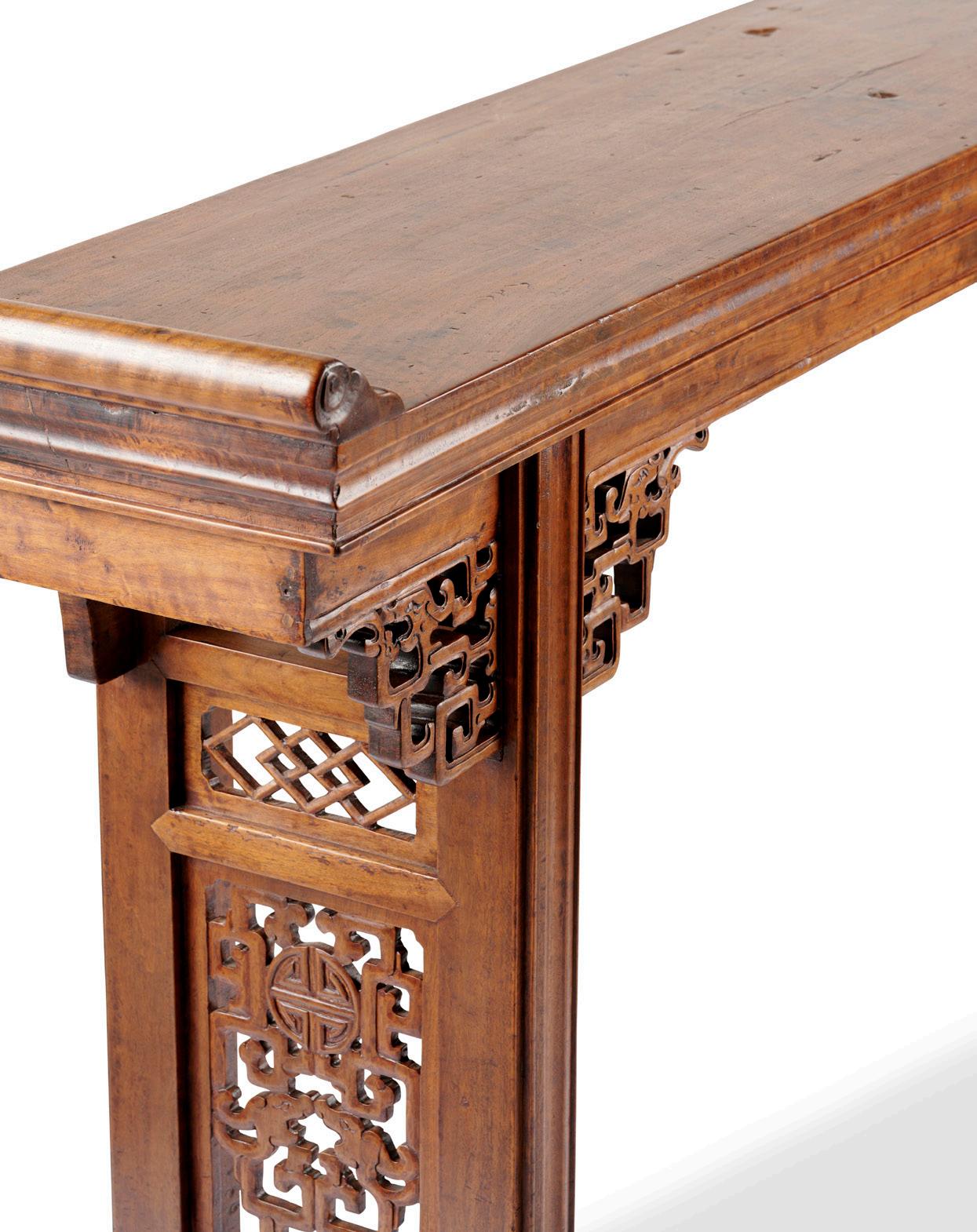
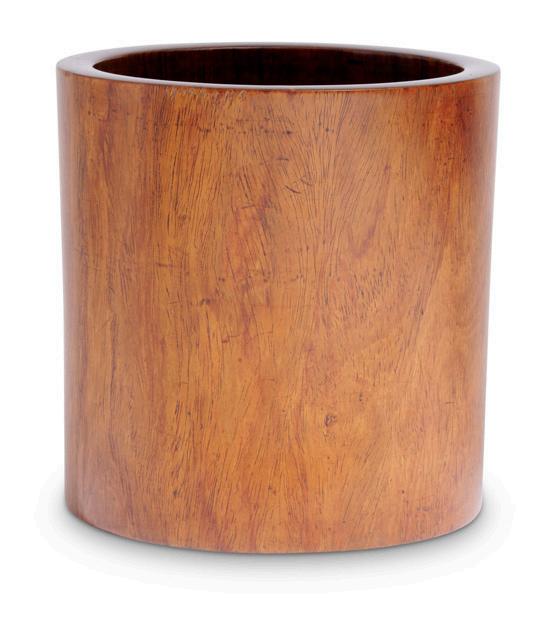
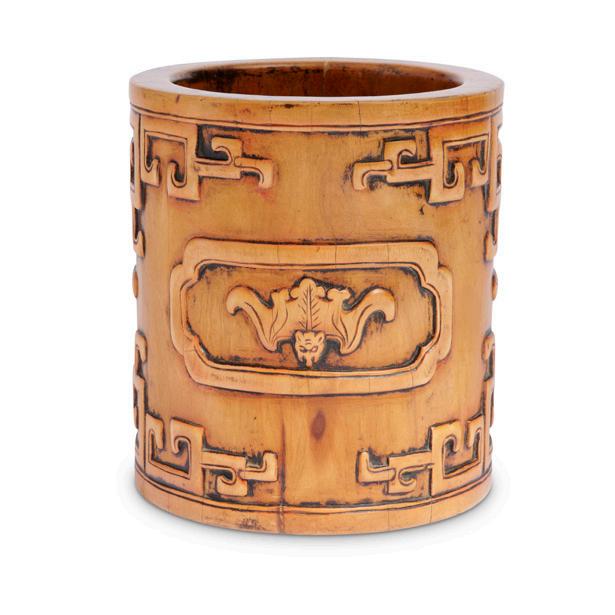
237
A CHINESE HUANGHUALI BRUSH POT, QING DYNASTY, 17TH/18TH CENTURY
Of cylindrical form with subtly tapering sides, the vessel is fashioned from a single section of richly figured huanghuali, the wood displaying a warm golden-brown tone with an attractive, natural grain. The surface has developed a soft, lustrous patina from age and handling. The base is neatly fitted with a circular plug. Such brushpots, prized for their elegant simplicity and the inherent beauty of the timber, were essential accoutrements on the scholar’s desk and remain highly sought after today. 16.2cm diameter, 16.4 high
provenance
A Private Collection of Chinese Traditional Furniture and Scholar Objects, ACT.
$6,000-8,000
清 十七/十八世紀 黃花梨筆筒
238 A LARGE CHINESE BOXWOOD (HUANGYANGMU) CARVED “BATS” BRUSH POT, QING DYNASTY, 18TH/19TH CENTURY
A finely carved boxwood brush pot of cylindrical form, the exterior decorated with intricate geometric patterns and a central motif depicting a stylized bat. The wood is of a caramel-brown. 14.6 cm diameter,16.6cm high
provenance
A Private Collection of Chinese Traditional Furniture and Scholar Objects, ACT.
$4,000-6,000
清 十八/十九世紀 黃楊木雕福壽紋筆筒
239
A LARGE CHINESE HUANGHUALI BRUSH POT, BITONG, QING DYNASTY, 17TH/18TH CENTURY
Well-proportioned and subtly tapering, the cylindrical vessel is turned from a single section of richly-figured huanghuali, the surface exhibiting a warm golden-brown tone and a soft, satiny patina from age and use. The mouth rim is cleanly finished; the underside fitted with a circular countersunk plug. Such generously scaled brushpots epitomise the Ming–Qing scholar’s ideal, admired for the timber’s lively grain and tactile presence.
A similar brushpot with a slighter larger size, sold at Christie’s Hong Kong, 30 May 2012, lot 4088. 19.2cm diameter, 18.6cm high
provenance
A Private Collection of Chinese Traditional Furniture and Scholar Objects, ACT.
$8,000-12,000
240
A CHINESE BOXWOOD CARVED FIGURE OF A STANDING LUOHAN, QING DYNASTY, 18TH/19TH CENTURY
32.5cm high
provenance
A Private Collection of Chinese Traditional Furniture and Scholar Objects, ACT.
$1,500-2,500
清 十八/十九世紀 黃楊木雕羅漢立像


241
A LARGE CHINESE HUANGHUALI DOCUMENT BOX, QING DYNASTY, 17TH/18TH CENTURY
The box is of rectangular form with huangtong mounts at the corners and bail handles on the sides, with a round two-part lock plate and cloud-form hasp on the front.
Similar example, see Christie’s New York, 16 Sep. 2016, lot 1216; also see Sotheby’s Hong Kong, 17 April 2024, lot 375.
41cm wide; 22.3cm deep; 17.5cm high
provenance
A Private Collection of Chinese Traditional Furniture and Scholar Objects, ACT.
$8,000-15,000
清 十七/十八世紀 黃花梨長方盒
242
A CHINESE HUANGHUALI DOCUMENT BOX, QING DYNASTY, 18TH CENTURY
The cover of the box inlaid to the top with ruyishaped mounts, and the front further set with a cloud-form hasp on a square back plate. The finely grained wood displays a rich patina and a deep, lustrous sheen.
Similar example see Sotheby’s New York, 21 Sep. 2023, lot 726.
30cm wide; 10.8cm high 16cm deep
provenance
A Private Collection of Chinese Traditional Furniture and Scholar Objects, ACT.
$4,000-6,000
清 十八世紀 黃花梨長方盒
243
A CHINESE WALNUT BRASS MIRROR TABLE SCREEN, QING DYNASTY, 18TH/19TH CENTURY
52.5cm high; 46.5cm wide; 23.5cm deep
provenance
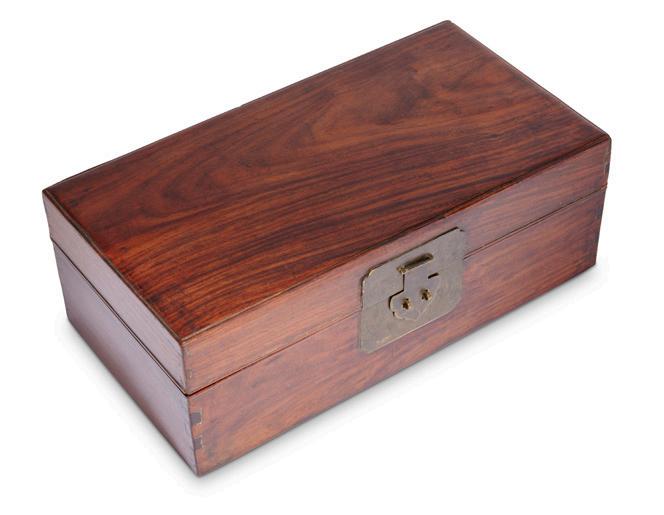
A Private Collection of Chinese Traditional Furniture and Scholar Objects, ACT.
$1,500-2,500
清 十八/十九世紀 胡桃木嵌銅鏡架
244
A RARE CHINESE HUANGHUALI SEAL CHEST GUANPIXIANG, LATE MING DYNASTY, 17TH CENTURY
The rectangular flat hinged top opening to a shallow tray and the two front panel doors fitted flush and opening to reveal the interior with three drawers, with attractive ruyi head and floriform fittings, a cloudshaped hasp, lock plate and vase-shaped pulls.
Similar example, see Christie’s New York, 18 Mar. 2015, lot 129.
29cm high; 29cm wide; 23cm deep
provenance
A Private Collection of Chinese Traditional Furniture and Scholar Objects, ACT.
$20,000-30,000
晚明 十七世紀 黃花梨官皮箱
245
A CHINESE JICHIMU SCALE BOX, QING DYNASTY, 18TH CENTURY
The rectangular box fitted with two drawers originally to house a scale and weights, and fitted with copper drawer pulls, cloud-shaped corner brackets and hardware, the wood finely figured and of a rich, dark tone.
See a slightly smaller (50 x 22 x14.5cm) jichimu document box with similar shape and metal fittings sold at Bonhams London, 9 Nov. 2017, lot 113. 45cm wide; 13cm high; 19.5cm deep
provenance
A Private Collection of Chinese Traditional Furniture and Scholar Objects, ACT.
$800-1,200
清 十八世紀 鸂鶒木稱盒
246
A CHINESE WALNUT MIRROR STAND, QING DYNASTY, 18TH/19TH CENTURY
31.7cm wide; 31.7cm deep; 36.5cm high
provenance
A Private Collection of Chinese Traditional Furniture and Scholar Objects, ACT.
$3,000-5,000
清 十八/十九世紀 胡桃木鏤空雕龍紋摺疊式鏡架
247
A CHINESE BOXWOOD INLAID IMMORTAL AND CHILD WALNUT TABLE SCREEN, QING DYNASTY (1644 - 1911)
49.5cm high; 36.7cm wide; 19.5cm deep
provenance
A Private Collection of Chinese Traditional Furniture and Scholar Objects, ACT.
$2,000-3,000
清 胡桃木嵌黃楊木桌屏
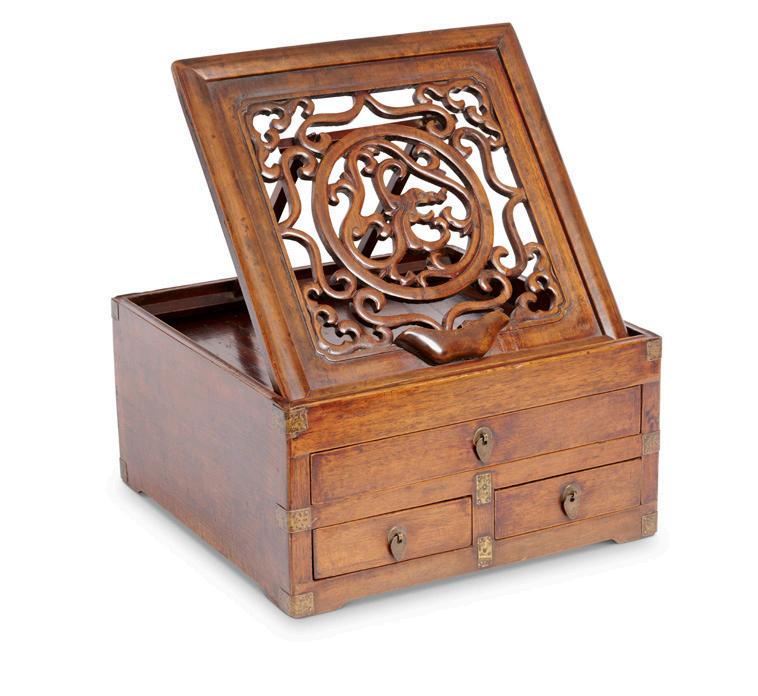

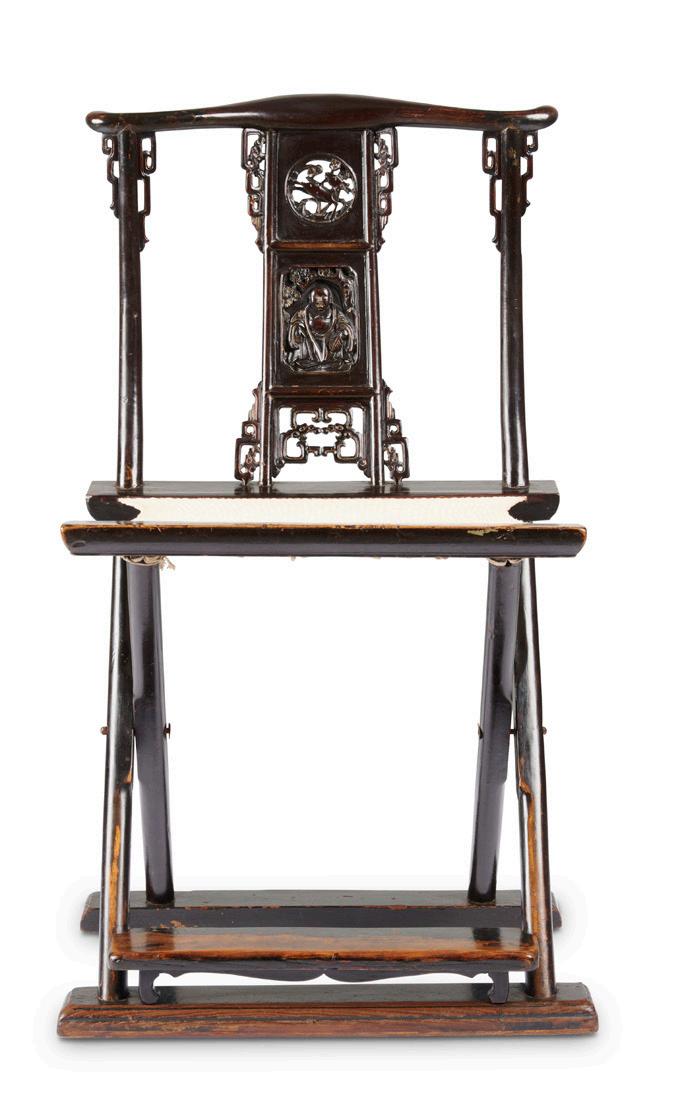
248
A CHINESE BLACK LACQUER AND CARVED FOLDING CHAIR, QING DYNASTY, 18TH/19TH CENTURY
Of portable X-form construction, this refined folding chair(jiaoyi) embodies the rank and mobility traditionally associated with scholarofficials, military commanders, and the elite. The gently curved rectangular crest rail recalls the Qing “official’s hat” chair, its authoritative profile distilled into a folding form.
The back splat is arranged in three sections rich with auspicious symbolism: above, a pierced roundel of deer amid plum blossoms, emblems of noble rank and renewal; the centre with a relief-carved Luohan (Arhat) holding a fan, signifying cultivated wisdom, within chrysanthemum foliage for longevity; and below, a Ruyi (“as-you-wish”) spandrel invoking felicity and fulfillment.
The seat is a later square-lattice cotton replacement, hand-woven in a dense matting technique. Footrest and stretchers show honest wear commensurate with age and use, while the black-lacquered frame retains its original finish and structural integrity.
Exemplifying literati seating, the chair was likely conceived for the itinerant scholar-official, combining dignity, comfort, and portability.
103cm high,56.5cm wide, 36.5cm deep
provenance
A Private Collection of Chinese Traditional Furniture and Scholar Objects, ACT.
$5,000-7,000
清 十八/十九 黑漆折疊扶手椅(交椅)。
便攜而尊,為士大夫、軍職與顯宦所用之雅座。搭 腦微曲作長方,襲清式官帽椅之威儀而化為折疊便 行之制。背板分三:上段鏤圓開光,鹿穿梅間,以 梅寓高潔長春,以鹿取「祿」與貴榮;中段浮雕羅 漢(阿羅漢)端坐執扇,扇徵清識儒雅,周飾菊 葉,寓延年長壽;下段券口鏤作如意,取稱心如 願、福祉綿長。
座面後配,以棉繩手工方格緻密編成;踏桿與諸枨 見時久磨痕,皆與年歲相稱。黑漆原裝猶存,框架 結體完固,風神不減。通幅兼具文房之雅與行旅之 便,當為仕宦旅次所用之具,足見中國文人士具之 典型氣象。
249
A CHINESE BLACK AND RED LACQUER OFFICIAL’S HAT CHAIR, QING DYNASTY 18TH/19TH CENTURY
Of classical official’s hat chair (guanmaoyi) form, the chair has a tall three-section back splat. The central inset with a red-lacquer relief of a scholar holding a lute on a donkey beneath a pine tree, an emblem of virtue, longevity, and scholarly reclusion. The upper and lower openwork motifs feature an upside-down bat and double dragons amid clouds respectively, alluding to arriving good fortune (fudao) and enduring blessings. A shaped apron, largely solid but accented with relief and openwork dragon motifs, anchors the plain seat and adds gravitas. Rooted in late-Ming structure, yet enriched with Qing decorative imagery, this piece blends bold narrative high relief and delicate openwork objects creating a vivid visual scene. The cinnabar lacquer enriches the chair with rare beauty and auspicious symbolism, reflecting material luxury. This chair would have stood in a principal reception hall as a sign of authority and cultivated taste. 103.5cm high; 58.5cm; 44cm
provenance
A Private Collection of Chinese Traditional Furniture and Scholar Objects, ACT.
$5,000-7,000
清 十八/十九世紀 清官帽椅 椅背高挑三截,中央嵌紅漆浮雕,高士抱琴騎驢行 松下,寓德行、壽祿與隱逸之旨,上、下兩段鏤空, 以倒掛蝙蝠與雲間雙龍為飾,取其諧音「福到」, 並寓長祉綿延。座下券口牙板牙板造形優美,以實 心為主,間飾浮雕及鏤空龍紋,既固座面,亦寓莊 重。此件作品結構承明末制法,兼融清代裝飾,高 浮雕與鏤空雕飾相映成趣,營造鮮活場景。朱漆更 增添華美與吉祥,彰顯材質珍貴奢華。此椅當置於 正廳,以彰顯權威與雅趣。
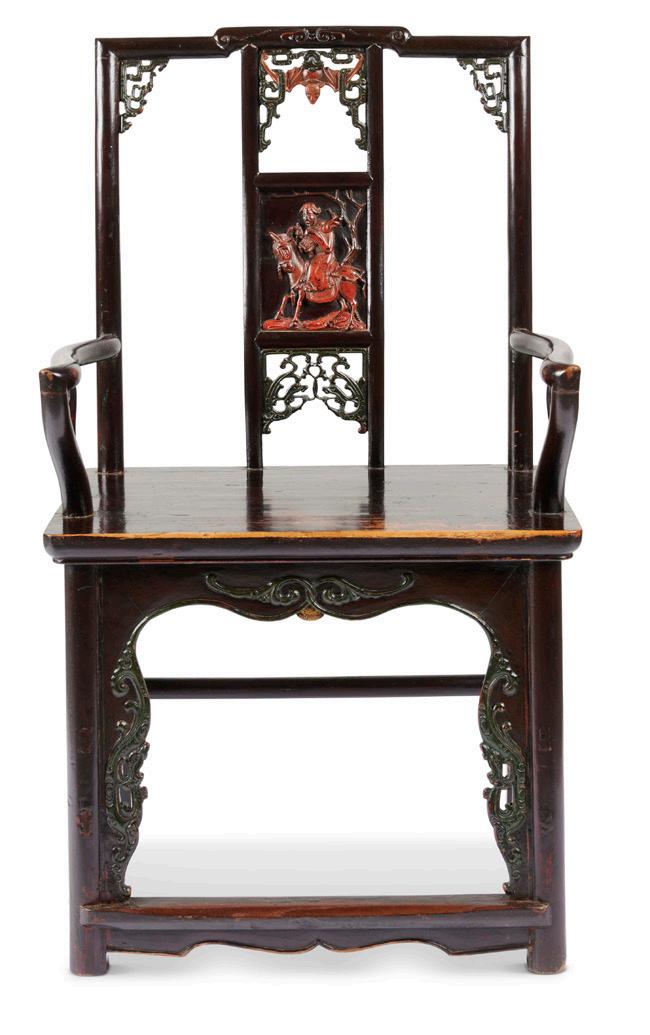
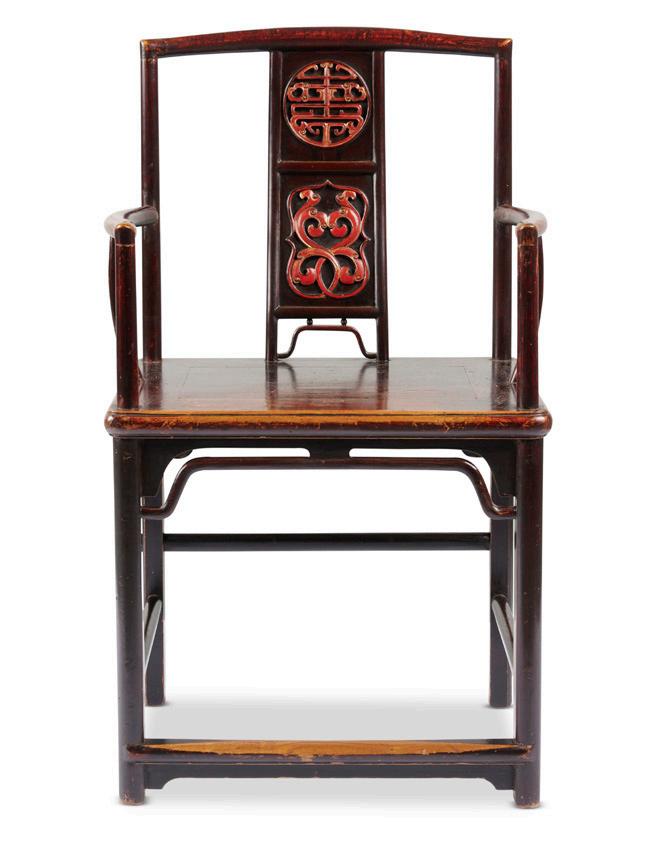
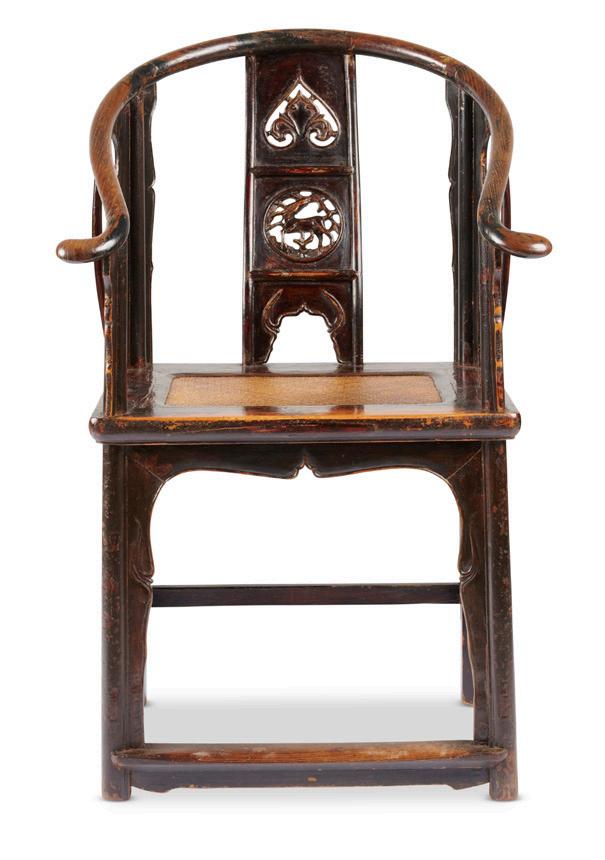
250
A CHINESE LACQUERED OFFICIAL’S HAT CHAIR, EARLY QING DYNASTY, 17TH/18TH CENTURY
This elegant armchair, known as guanmaoyi or “official’s hat chair,” reflects the refined proportions of late Ming design. The gently arched crest rail forms a yoke above a rectangular back splat, inlaid with a cinnabar lacquer medallion bearing the shou character and a ruyi-lingzhi (scroll panel, symbols of fulfilment, prosperity and immortality. The arched front stretcher (yueya xia ) echoes the lower curve of the back splat, uniting structure and ornament in a hallmark of Ming craftsmanship. Supported on four legs joined by stretchers, with arms carried on slender posts, the chair demonstrates a fine Ming example of seamless joinery and the restrained elegance associated with Shanxi lacquer traditions. The use of catalpa was favoured in Shanxi for lacquered furniture.
98cm high; 57.5cm wide; 43cm deep
A Private Collection of Chinese Traditional Furniture and Scholar Objects, ACT.
$5,000-7,000
清 十七/十八世紀 清官帽椅。
此件比例優雅嚴整,弧形搭腦微呈鞍狀,承方正椅 背;上部嵌朱漆壽字圓璽,中部飾如意靈芝卷草, 寓圓滿富貴、延年長生。前枨作月牙,呼應椅背下 緣之曲線,結構與裝飾相互呼應,承明代家具設計 雅範。四足以枨聯繫,兩側扶手挺立於纖巧柱上, 盡顯明代嚴謹榫卯與含蓄優雅之風格,尤與山西漆 工傳統相承。材質選用梓木,質地輕盈而堅韌,紋 理細膩柔和,極宜施漆並散發溫潤光澤,為明清時 期山西漆家具所喜用。
251 A CHINESE LACQUERED AND CARVED HORSESHOE-BACK ARMCHAIR (QUANYI)
QING DYNASTY, 18TH/19TH CENTURY
Elegantly balanced in profile and line, this horseshoeback chair (quanyi) is defined by a sweeping crest rail that terminates in gently out-swept handrests, carried on slender round uprights and a pair of subtly swelled intermediate posts that taper to meet the underside of the rail, an arrangement that imparts both visual cadence and structural refinement.
The back splat is organised in three sections rich with auspicious meaning: above, a heart-shaped cartouche enclosing a lingzhi emblem of immortality; at centre, a circular medallion of deer amid plum blossom, symbols of noble prosperity and renewal; and below, a shaped spandrel carved with the ruyi (“as-youwish”) motif, invoking felicity and fulfilment. The front apron rises to a central cusp and resolves into cloud-shouldered curves that taper toward the footrest, soft lines that visually lighten the seat, echo the circular crest rail, and accord with late-Ming to Qing taste.
The cane seat sits within a robust mitred-andmortised frame, braced beneath by a curved central stretcher. The present seat is a later replacement executed by traditional Chinese method: a supportive palm-fibre web is laced through drilled seat-rail holes and pinned tight, over which the surface is handcaned directly to the frame.
Uniting dignified restraint with measured ornamentation, the chair embodies the literati ideal of balanced simplicity. Prized by scholars and officials for its refined yet comfortable design. It stands as an eloquent synthesis of elegance, discipline, and daily use.
100cm high; 61.5cm wide; 41cm deep
provenance
A Private Collection of Chinese Traditional Furniture and Scholar Objects, ACT.
$3,000-5,000
清 十八/十九世紀 黑漆圈椅 椅搭腦和扶手呈馬蹄圈,手端微外展,下承圓材前 後柱。背板作三截,兼施浮雕與鏤空:上段心形券 口,中鋪靈芝一枝,寓意長生;中段圓團雕鹿梅, 取諧音“祿”位榮華與高潔長春;下段作如意頭券 口,徵稱心遂意之祥。前牙板中脊起尖峰,兩側雲 肩而下,趨向前踏桿。線勢婉和,化重為輕,上下 遙相呼應,合乎晚明及清代之審美。
現席為後配,仍循中式舊法:先以棕纖自座框鑽孔 穿引,內以小銷勒緊為承托底網;其上舖手編密 席。
此類座椅為士大夫所重,兼顧儀度與安適,可謂優 雅與日用之圓融。
252 A RARE PAIR OF CHINESE SHANXI TRIANGLE LACQUERED TABLES, QING DYNASTY 18TH/19TH CENTURY
Conceived as a modular pair for the reception hall or scholars’ studio, this pair of “matching tables” (duizhuo) epitomises the Qing fascination with modular arrangements. Stand singly as a corner display and, when joined, form a square plinth for paintings or objects. Of refined “four corners flush”( simianping) construction adapted to a triangular plan, the tops are enclosed by mitred triangular frames with floating panels. Pierced aprons, tenoned the full run into the frame, compose a continuous key-fret meander with ruyi-head turns, an archaistic
(??) protective border conveying renewal, steady fortune, and enduring stability. Square legs with fine bead descend to hoof feet (mati), a Ming - Qing dynasty hallmark that quietly grounds the table above. The warm elm shows lively grain and a wellhandled surface, with darker toning in the recesses heightening relief.
Designed to stand apart or unite, the pair balances literati restraint with auspicious imagery. Triangular modular tables are rare and structurally exacting, demanding sophisticated joinery to ensure stability and poise.
132cm long; 93cm; wide; 93cm deep; 85.5cm high
provenance
A Private Collection of Chinese Traditional Furniture and Scholar Objects, ACT.
$6,000-8,000
清 十八/十九世紀
配對角桌
此對配對角桌(對桌)構思為可組合成對之用,體 現清代在廳堂與書齋陳設中對模組化佈置的雅趣: 單件可作角落陳列之用,合併則成方形陳設臺座以 承托書畫與器物。通體採四面平之制並化為三角構 型,桌面以斜接三角框圍就,內嵌活芯板。四周鏤 空牙板通長榫入框架,連綿成回紋游走並以如意頭 轉折,具古意的「護界」寓意,傳達更新、恒祿與 安定之願。方材四足起細珠線,下承馬蹄足,為明 清雅製之標識,沉著穩固而不失清簡。榆木材色溫 潤、木理活絡,陰刻處存較深之舊漆色以強化層 次。設計可分置或合用,此對既守文人之克制,又 寓吉祥之意象。三角組合式桌案殊為罕見,結構要 求極為嚴謹,必賴精密榫卯,方能臻於穩健與端 雅。
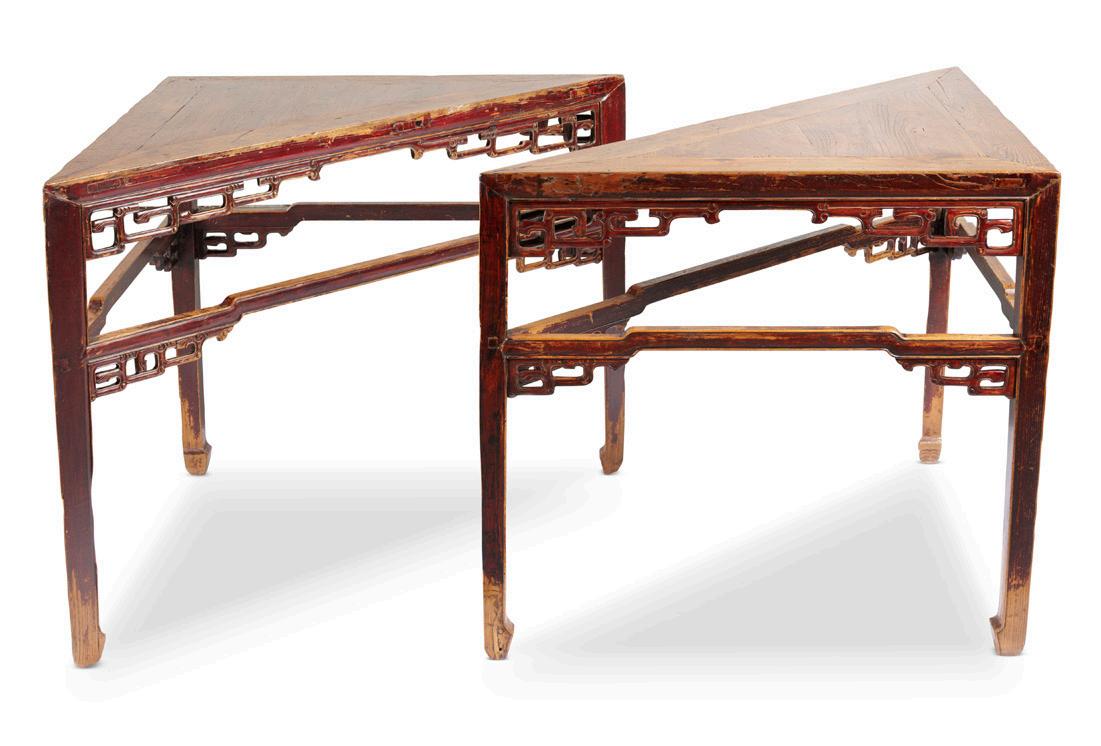
A PAIR OF CHINESE “DUOBAOGE” DISPLAY CABINETS FOR THE KANG, LATE QING TO REPUBLIC PERIOD, 19TH/EARLY 20TH CENTURY
Display cabinets (duobaoge) were essential furnishings in Chinese scholars’ studios, serving both aesthetic appreciation and spiritual delight. This miniature pair was conceived as tabletop or kang, display units.
The striking mass-void balance on the facade, with intimate display niches pierced by circular ‘moon gate’ apertures and foliate scrollwork, all intended for close viewing of meticulously arranged scholar’s objects (wenwan) such as snuff bottles, toggles, seals, and small vessels. The above beauty is further graced with refined beaded moulding and enhanced by the lively feathered grain of chicken-wing wood (jichimu). The central drawer is highlighted by a crisp foliate scrollwork frieze depicting interlaced tendrils and stylized blossoms, symbolizing continuous growth, renewal, and prosperity.
The excellent preservation of this pair demonstrates superior examples of literati furnishing, functional yet imbued with symbolic richness, embodying both the cultural refinement and material luxury of the Qing scholar’s environment. The survival of such a pair intact offer valuable insight into how Chinese scholarly furniture was originally conceived and employed within domestic settings. 95cm high; 49.8cm wide; 21.5cm deep
provenance
A Private Collection of Chinese Traditional Furniture and Scholar Objects, ACT.
$2,500-3,500
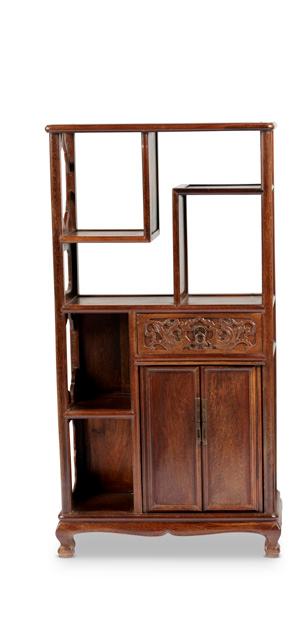
晚清 鸂鶒木多寶格小櫃(對)
多寶格乃文人書齋必備之器,既供美學品賞,亦為 精神愉悅。此微型成對者,設計為案頭或炕上陳設 之用。
正面虛實相間,層次分明,私密陳設龕以圓形月洞 門與花葉卷草紋透雕,皆為近距細賞精心排列文玩 之需,如鼻煙壺、佩件、印章、小器等物。上述之 美更以精細串珠線腳裝飾,並以雞翅木之活潑羽紋 增色。中央抽屜飾以清晰花葉卷草帶,描繪纏枝蔓 草與程式化花卉,象徵生生不息、更新與昌盛。 此對保存極佳,實為文人器具之上品典範 既具 實用功能,又蘊含豐富象徵,體現清代文人環境中 文化雅致與物質奢華之雙重品格。如此成對完整存 世,為理解中國文人傢具如何於居家環境中構思運 用提供珍貴洞見。
254
A PAIR OF CHINESE WALNUT CARVED LANTERNS, QING DYNASTY, 18TH/19TH CENTURY
Evoking the lineage of imperial palace lanterns, this finely matched pair translates courtly lighting traditions to the domestic interior with uncommon sophistication. Each rises from a substantial base to a tall, height-adjustable upright secured by wooden pegs, supporting a rectilinear lantern head executed in precise frame-and-panel joinery. The heads retain geometric lattice panels that lend structural clarity

and, when illuminated, cast a refined play of light and shadow, an effect prized in Qing-period settings. Pierced base spandrels with a tiered Ruyi-cloud and key-fret scheme, resolving in dragonhead terminals, bracing the corner while visually lightening the junction, encoding protection, prosperity, and poised strength.
Remarkable for their workmanship, fidelity to palace models, and outstanding state of preservation, the pair offers both historical insight and aesthetic poise. Surviving as an original set, rare in any corpus, constitute an exceptional opportunity for collectors seeking exemplary expressions of Chinese material culture.
171 x 38.5 x 30cm
$5,000-7,000
清落地方燈(對)。
承襲宮廷宮燈之系譜,此對精良相配之作以不凡格 調將廷儀之雅致移植於居室。自厚實鏤空雕座起 勢,上承高挑中柱,以木楔定位可調高度,頂托方 整燈匣,皆以嚴謹之框架—隔板榫卯構成。燈匣內 置幾何格心,結構明晰;用其點照,光影穿行其 間,呈現清雅韻致,為清代陳設所喜好。座部牙板 鏤空作如意雲紋與回紋,收於龍首如意頭,既加強 轉角受力,並使交界視覺更為清朗輕健,寓意護 持、祉福與端勁。
此對以工藝精湛、恪守宮廷範式與卓越保存見稱。 原配成對存世,於同類器物中殊為罕有,既資史 識,亦具風神,實為中國物質文化典範,藏家所不 可多得之選。

A CHINESE WALNUT SCROLL TABLE, QING DYNASTY, 18TH/19TH
This walnut scroll table exemplifies the refined decorative traditions of Qing dynasty furniture, and in particular, it demonstrates the sophistication through its deliberate use of contrasting spandrel treatments. The front aprons feature elaborate openwork carving with interlocking geometric motifs, while the reverse employs plain axe-head spandrels. This juxtaposition represents an unusual design philosophy where the craftsman intentionally balanced ornament with restraint, the openwork spandrels facing the viewer provide visual flourish, while the plain spandrels at the back maintain stability and structural clarity.
The front decoration includes pierced tiered ruyi-cloud and key-fret patterns terminating in dragonhead finials, motifs encoding protection, prosperity, and strength. The side panels feature a central shou (longevity) medallion surrounded by geometric scrollwork and stylized cloud scrolls (yunwen), representing the celestial realm and divine favour. The upper sections display lozenge lattice (lingxing) patterns configured as endless knots (panchanjie), their uninterrupted paths
symbolizing longevity, continuity, and protective auspices appropriate for scroll tables. The carving demonstrates remarkable precision, with the craftsman’s mastery of negative space creating dynamic light and shadow effects that animate the surface while maintaining structural integrity essential for a functional scroll table where scroll paintings are opened for appreciation or treasured objects displayed.
The plain axe-head spandrels embody the minimalist elegance admired in classical literati taste, emphasizing architectural strength.
The survival of these elaborate carved details attests to both original craftsmanship quality and careful preservation, making this piece a rare testament to China’s sophisticated furniture-making traditions and the use of rich symbolism.
199cm wide; 90cm high; 32.5cm deep
provenance
A Private Collection of Chinese Traditional Furniture and Scholar Objects, ACT.
$5,000-7,000
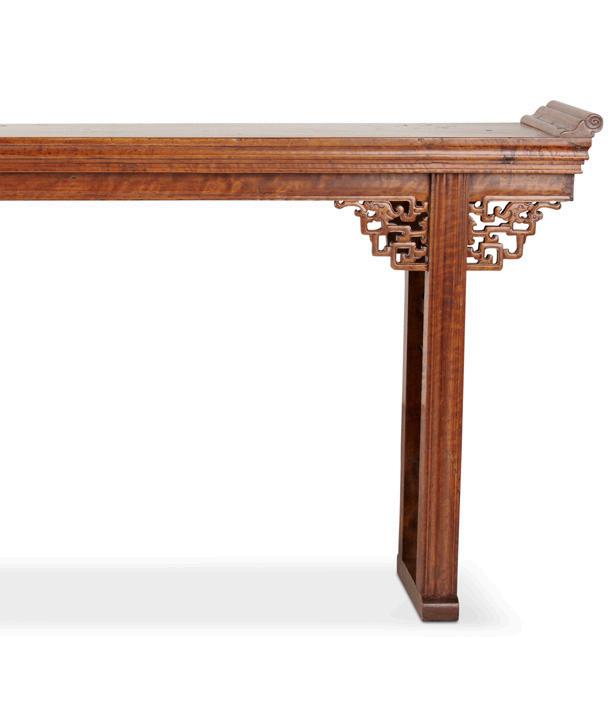
清十八/十九世紀 胡桃木畫案
此畫案典範清代傢具之精雅裝飾傳統,尤以其刻意 對比牙子處理手法展現工藝精湛。前牙板飾以精細 透雕,幾何紋飾相互交錯,而背面則用樸素斧劈牙 子。此對比體現非凡設計理念,匠人刻意平衡裝飾 與節制,面向觀者之透雕牙子提供視覺華彩,而背 面樸素牙子則保持穩固與結構清晰。
前面裝飾包括鏤空層疊如意雲紋及雷紋,終以龍首 收邊,此等紋樣寓護佑、昌盛、剛健之意。側板中 央飾壽字團花,周圍環以幾何卷草紋及程式化雲 紋,代表天界與神恩。上部呈菱形格紋,組構為盤 長結,其連綿不絕之路徑象徵長壽、延續及護佑之 祥瑞,誠為畫案應有之裝飾。雕工展現非凡精準, 匠人對負空間之駕馭創造光影動態效果,令表面生 動活潑,同時保持功用畫案所需之結構完整 此 乃展卷軸書畫以資賞玩或陳列珍玩之所。
樸素牙子體現古典文人品味所崇尚之簡約雅致,彰 顯建築力度。此等精細雕飾之存世,既證原初工藝 品質與悉心保存之功,使此器成為中華精湛傢具製 作傳統及豐富象徵運用之珍罕見證。


A LARGE CHINESE WALNUT FLOOR SCREEN WITH BOXWOOD INLAY QING DYNASTY, 18TH/19TH CENTURY
Standing at an imposing 326 centimetres, this monumental screen would have commanded attention in the most distinguished reception halls of Qing aristocracy, where such pieces served as both functional room dividers and displays of cultural refinement. The size and number of panels were adjusted according to the spatial requirements of each setting.
The primary decorative program centres on geometric latticework panels where calligraphy and paintings could be mounted on both sides for the appreciation of visitors. The principal panels below the lattice mounting space carry the core artistic program that echoes the interior’s refined ambience. On this set of screens, the principal panels are pierced with a continuous key-fret lattice (leiwen) centering a large seal-script shou character for longevity. By recessing the inner motif yinke, concave carving while keeping the outer frame proud yangke,
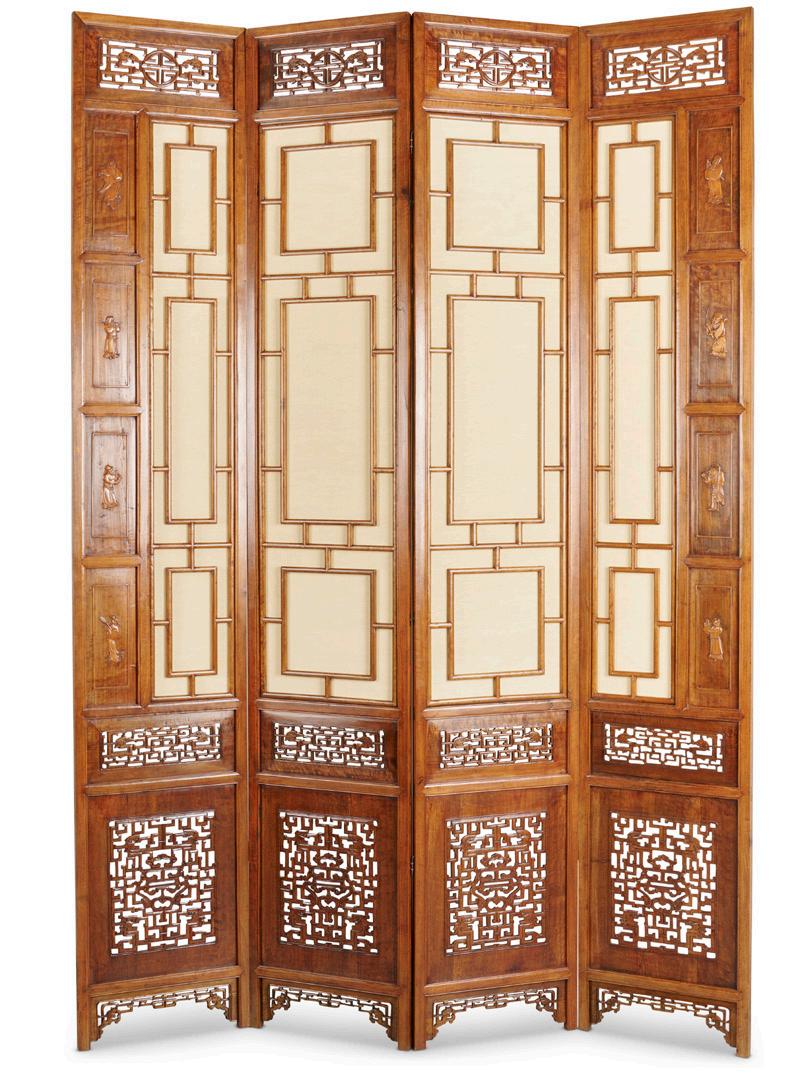
convex carving, the design echoes an inked seal impression, creating an effect both visually striking and appropriate to literati taste.
At cardinal points, archaistic kui-dragon (kui long) scrolls emerge from the meander pattern and curve back upon themselves, their ruyi-headed terminals folding into the grid, while the surrounding rails and apron reprise the key-fret motif with stepped, ruyitipped corners.
Together, this decorative program encodes longevity (shou), wish-fulfillment (ruyi), and the protective continuity of the thunder pattern, an auspicious ensemble long favoured for screens intended to preside over formal reception rooms. This decorative scheme is repeated on the smaller carved panels above and the bottom apron, executed with consistent carving techniques throughout.
The boxwood inserts on the end panels depicting the Eight Immortals (Ba Xian 八仙) represents one of the most beloved subjects in Chinese classical literature, opera, and decorative arts.
The exceptional preservation of the boxwood details, with their crisp definition and warm honey-coloured patination, indicates careful custodianship across generations. Such screens were treasured family heirlooms, often passed down through scholarly lineages who understood their cultural significance. 326cm high; 56.5cm wide; 5cm deep each panel provenance
A Private Collection of Chinese Traditional Furniture and Scholar Objects, ACT.
$7,000-9,000
清 十八/十九世紀 胡桃木嵌黃楊木落地屏風 此屏風高達三百二十六公分,巍然聳立,必於清代 權貴之顯赫廳堂中奪目生輝,此類器物既為實用之 隔屏,亦為文化雅致之展示。屏板大小與數量皆因 空間需求而調整,主要裝飾程式以幾何格屏為重, 其上可裝裱書畫於正反兩面,供來賓品賞。格屏下 方之主板承載核心藝術主題,與室內雅緻氛圍相呼 應。
此組屏風之主板飾以連續雷紋格屏,中央嵌大篆壽 字以祈長壽。內紋稍陷(陰刻),外框凸起(陽 刻),設計仿陽文印痕之效,既視覺醒目,又合文 人品味。四隅出夔龍卷雲由回紋中生發,末作如意 雲頭折入格欄;周框與下檐復以階式雷紋及如意角 收束。整體寓長壽(壽)、稱心(如意)與連綿護 佑(雷紋)之意,為主理廳堂者所素尚之吉題。此 裝飾程式於上方小鏤板與下裙板反覆呼應,全屏刀 法與層次前後一致。
組屏始末端板黃楊木嵌板所刻八仙,乃中華古典文 學、戲曲及裝飾藝術最為鍾愛之題材。黃楊木細節 保存極佳,輪廓清晰,呈溫潤蜜色包漿,足證世代 悉心看護。此類屏風乃傳家之寶,常於通曉其文化 意義之書香門第中代代相傳。是以全貌存至今日尤 為難得,足資觀照清代高階屏風工藝與審美之精 華。
257
A CHINESE HUANGHALI THREE-TIERED LUNCH BOX, LATE QING/REPUBLIC PERIOD, LATE 19TH / EARLY 20TH CENTURY
33cm high; 25cm wide; 14.5cm deep
$2,000-3,000
十九世紀末/二十世紀初 黃花梨三層提梁盒
258 A CHINESE ALOESWOOD CARVED TABLE SCREEN, QING DYNASTY (1644-1911)
The front is carved with a scene of spring plowing, while the back bears an imperial poem inscribed by Emperor Qianlong. It’s with a finely carved fitted wood stand.
24.5cm high
$1,000-2,000
清 「春耕圖」並御題詩 沉香插屏 屏面雕春耕場景,背面刻乾隆皇帝御題詩,配精雕 木座。
259 A CHINESE LARGE AND VERY FINE BAMBOO CARVED BRUSH POT, ZHONGQIAN MARK, QING DYNASTY (1644 - 1911)
Of bamboo form with a rich brown patina, the sides deeply carved in high relief with Su Shi and his companions on a moonlit boat journey at the Red Cliff, surrounded by soaring cliffs, ancient pines and turbulent waves. The rocky face bears an inscription of a Qianlong imperial poem, with the signature Zhongqian zhi.
Pu Zhongqian, active in the late Ming to early Qing period, was among the most celebrated bamboo carvers of his time. Admired by literati and nobles, and praised in works such as Zhang Dai’s Tao’an mengyi, his carvings display extraordinary skill and depth. This brush pot exemplifies his mastery of high relief and openwork, creating a vivid and dramatic scene of enduring literary resonance.
For bamboo brush pots also decorated with Night Excursion to the Red Cliff scene, in the Shanghai Museum is illustrated in Literati Spirit. Art of Chinese Bamboo Carving, Shanghai, 2001, p. 43 & 46, no. 11 & 13.
19cm high; 18.6cm diameter
provenance
A private scholar’s collection, Kyoto, Japan. $9,000-15,000
清 「仲謙製」款 竹雕「赤壁夜遊」筆筒 筆筒呈竹節形,色澤深棕,側面高浮雕蘇軾與友人 赤壁夜遊場景,環繞峭壁、古松與波濤。岩面刻乾 隆御製詩,署「仲謙製」。仲謙即蒲仲謙,明末清 初著名竹雕家,作品深受文人雅士推崇。
相似的例子,請參閱上海博物館藏 “ 竹雕赤壁夜遊 圖筆筒 ” ,《竹鏤文心 竹刻珍品特集》 P43 、 46 , No.11 、 13 。
源流: 日本京都學者私人收藏。

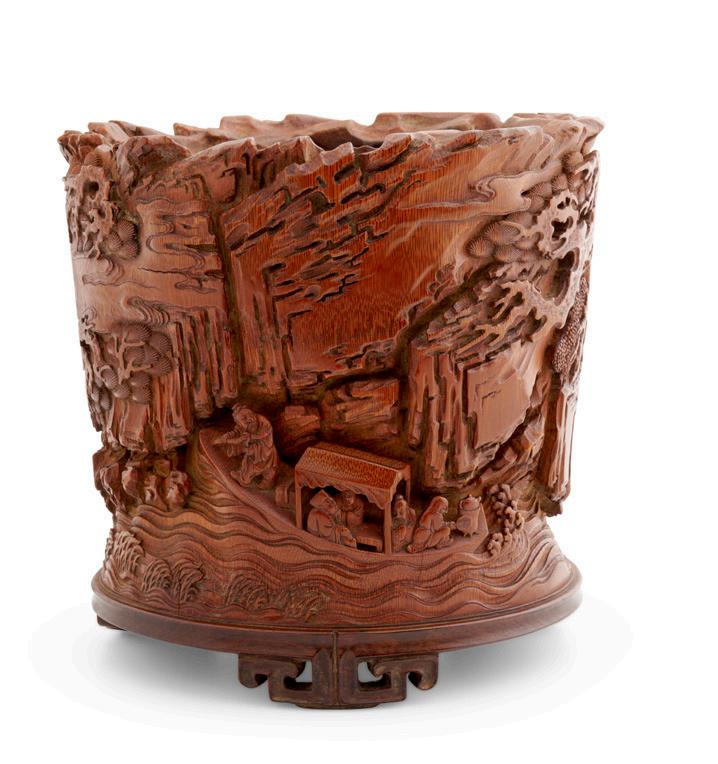


260 A CHINESE HONGMU DOCUMENT BOX, QING DYNASTY (1644 -1911)
31 x 16.5cm
$300-500
清 紅木长方盒
261 A CHINESE NANMU SCROLL FORMED STAND, JUAN SHU SHI XIAOJI, QING DYNASTY, 18TH CENTURY
It’s caved from a single pieces of well-figured nanmu, the rectangular outline flat surface rounding at the short sides and curving inward forming open scrolling supports.
The dramatic openwork scrolling required great skill from the carver and the ability to choose perfectly seasoned timber that would not be prone to either warping or cracking. Another nanmu stand with almost identical shape but in a smaller size (40.6 x 22.9 x 8.9cm) sold at Sotheby’s New York, 15th Mar. 2016, lot 60.
54 x 27.5 x 9.5cm
$5,000-7,000
清 十八世紀 楠木卷書式小几 以整塊紋理清晰之楠木雕製,兩端捲曲如書卷,鏤 空設計精巧,需極高工藝與選材眼光。類似尺寸較 小之例,見蘇富比紐約,2016年3月15日,拍品編 號60。
262
A CHINESE ZITAN FLOWER FORMED BOX AND COVER, QING DYNASTY (1644 - 1911)
With a Japanese wood box. 7.7cm diameter; 3cm high
$2,000-3,000
清 紫檀雕花型蓋盒
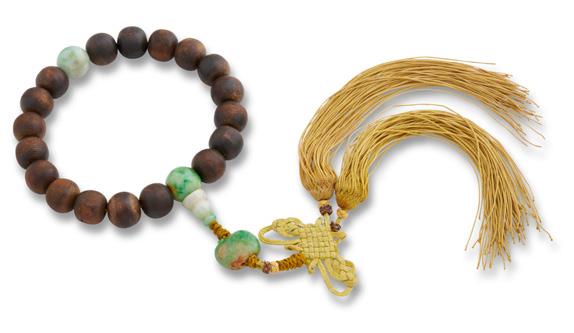
263 A CHINESE WHITE JADE INKSTONE, QING DYNASTY (1644 - 1911)
It’s with an original fitted huanghuali box and cover. Jade: 7cm long; 5cm wide; box: 8.3 x 6 x 2cm
$800-1,200
清 白玉硯 配原裝黃花梨盒蓋
264
A CHINESE ALOESWOOD ROSARY BRACELET, QING DYNASTY (1644 - 1911)
The rosary, shou chuan, is formed with eighteen aloeswood beads, one end with a double-gourd form bead suspending a jade pendant. It’s with a fitted box. 9.5cm diameter
$800-1,200
清 沉香十八子手串 配錫盒
此手串由十八顆沉香珠組成,一端配葫蘆形珠,懸 掛玉墜,配原裝盒。
265
A CHINESE ALOESWOOD ROSARY, LATE QING DYNASTY, 19TH/20TH CENTURY
With a fitted pewter box and cover, the base of the box with a Qianlong mark. A similar rosary, see Christie’s Hong Kong, 30 May 2024, lot 2934. 11.5cm diameter;
$2,500-3,500
清 十九/二十世紀 沉香手串 配錫盒 265

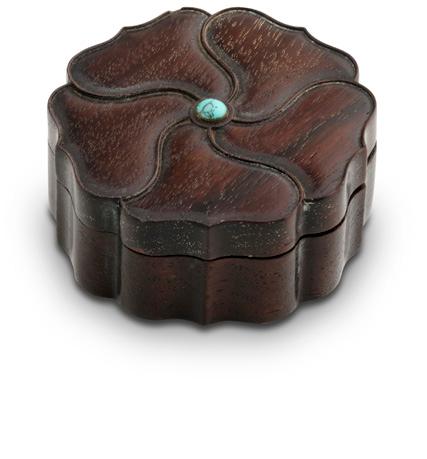
266
A GROUP OF FIVE CHINESE SCHOLAR OBJECTS
Comprising a bamboo carved arm rest, Wang Youdun mark; a jade carved ink stone, a jade carved square washer, a famille-rose ink stand and a bronze brush stand.
Bamboo arm rest: 19.3 x 10.5cm
$1,000-2,000
清或以後 文房用器 一组五件 包括竹雕臂擱「汪由敦」款、玉雕硯、玉雕方洗、 粉彩硯台及銅筆架
267 A CHINESE TIANHUANG SOAPSTONE CARVED SEAL, LATE QING/REPUBLIC PERIOD, EARLY 20TH CENTURY
The exterior is carved in low relief with a landscape scene featuring scholars in conversation. A “Hong Yi” mark is incised on the lower left of the front side. The seal face is carved with the characters 「人長 壽」, meaning “May one enjoy longevity.” 7.8cm high; weight: 98g
$5,000-7,000
清末 / 民國初年 田黃石雕印章 「弘一」款 外壁淺浮雕山水人物,正面左下刻「弘一」款。印 面刻「人長壽」四字,寓意延年益壽。
268 A CHINESE TIANHUANG CARVED LION SEAL, QING DYNASTY (1644 - 1911)
The knob is carved with a lion, inscribed on one side with “Qianlong Yihai Zeng Lu Zhuan”, translated “made by Zenglu of Qianlong Yihai (1775) year”. Zeng Lu also named Wang Ruizhang (1663 - 1761) who is a famous seal carver and poet from Nanhui, Shanghai, Wang Ruizhang was the founder of the Yunjian School and a disciple of Zhang Zhixi. Known for his elegant compositions and literati style, he carved seals for a living and authored several influential seal catalogues, leaving a lasting legacy in the development of Shanghai‘’s seal carving tradition. 4.6 x 4.6cm
$3,000-5,000
清乾隆 「乾隆乙亥曾麓篆」款 田黃石雕獅鈕印章 印鈕雕獅,一側刻「乾隆乙亥曾麓篆」。曾麓即王 睿章(1663–1761),上海南匯人,篆刻家、詩人, 為雲間派創始人,張芝溪弟子。其印風文雅,著錄 豐富,對上海印壇影響深遠。

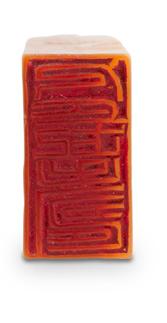
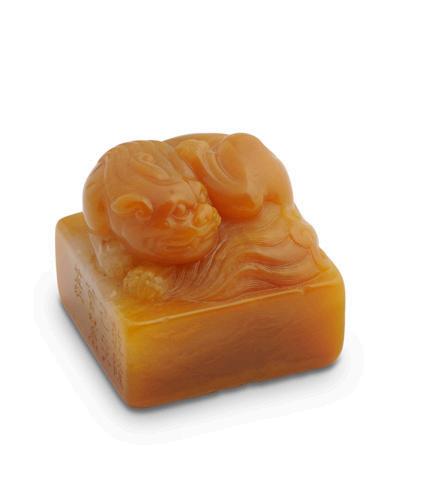


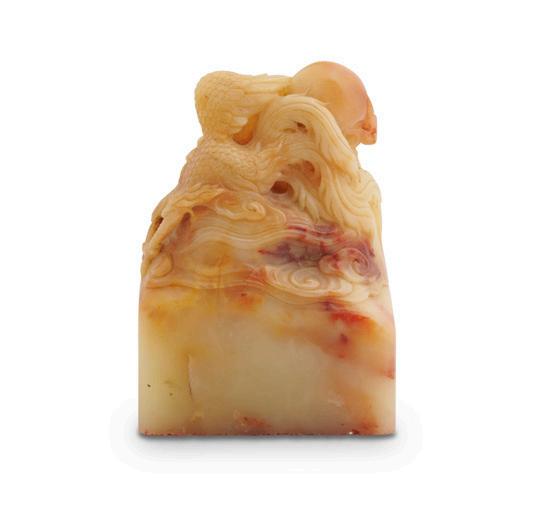

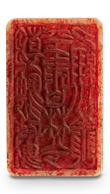
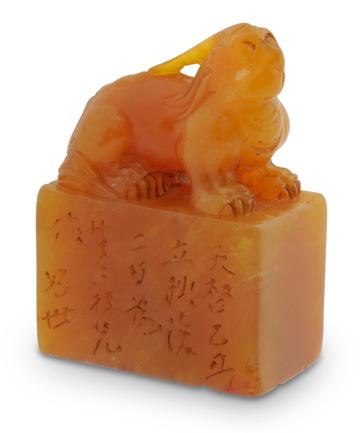
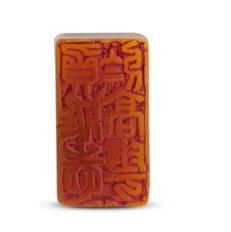
269 A CHINESE FURONG SOAPSTONE CARVED SEAL, REPUBLIC PERIOD, EARLY 20TH CENTURY
7.2cm high
$1,500-2,500
民國 芙蓉石雕印章
270 A CHINESE TIANHUANG SOAPSTONE CARVED SEAL, CHANGSHI MARK, DATED TO 1625
One side bears an inscription: Translated: “On the second day of the Beginning of Autumn, in the yichou year of the Tianqi reign (1625), made for Brother Du by Shengsheng, signed Changshi.” The seal face is carved in shallow relief with the phrase (Fu ya zhi yu gao yun), meaning “Carrying refined aspirations amidst the lofty clouds”.
Gui Changshi (1573 - 1644) is a poet, painter, calligrapher, and seal carver from Kunshan, Jiangsu. Grandson of Gui Youguang and father of Gui Zhuang. Known for his refined calligraphy, literati painting, and pioneering seal carving style that influenced the Zhejiang School. A key figure in late Ming cultural circles, he lived in reclusion and upheld loyalist ideals.
4.1cm high; weight: 35g.
provenance
A private collection of a scholar, Tokyo.
$2,000-3,000
明 天啟二年( 1625 年) 田黃壽山石雕印章「昌 世」款
一面刻銘:「天啟乙丑年立秋二日,為生生杜兄 作,昌世。」印面淺浮雕四字:「萬雅志於高 雲」。
昌世,即歸昌世( 1573 1644 ),江蘇昆山人,歸 有光之孫,歸莊之父。擅詩書畫印,書法清雅,畫 風文人,篆刻開創一派,影響浙派。晚明文化圈重 要人物,隱居不仕,秉持忠義。 源流: 東京學者私人收藏。
271
A CHINESE CARVED SMOKY ROCK-CRYSTAL BEGONIA-SHAPED WASHER, QING DYNASTY, 18TH/19TH CENTURY
17.4cm long; 9cm wide
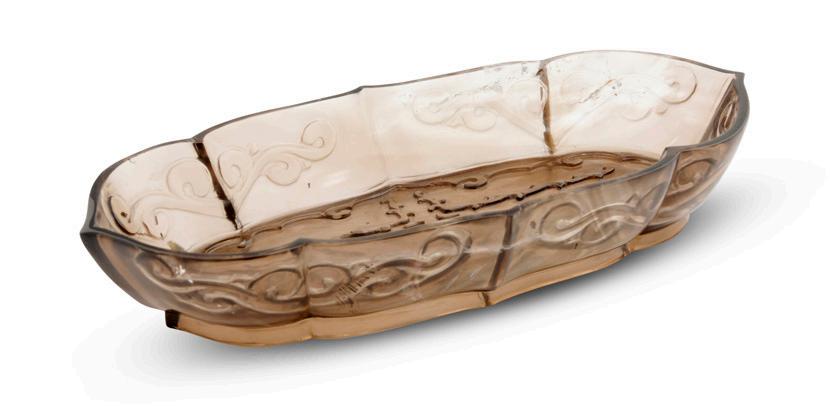
provenance
Raymond and Victoria Tregaskis Oriental Art, Sydney.
$3,000-5,000
清 十八/十九世紀 煙晶海棠式筆洗 以整塊煙水晶雕琢而成,器形仿海棠花瓣,晶瑩剔 透,線條流暢,為清代文房雅器。
源流:
Raymond and Victoria Tregaskis Oriental Art,悉 尼。
272
A VERY FINE CHINESE CARVED INKSTONE, QIANLONG MARK, DATED TO 1767
One side with moulded in relief with “Qianlong Xinmaonian Zhi” mark, the other side moulded in relief with “Neifu Zhencang” mark. 8.3 x 5cm
$1,000-2,000
清乾隆 「乾隆辛卯年製」、「內府珍藏」款 歙硯 一面浮雕「乾隆新卯年製」,另一面浮雕「內府珍 藏」。
273
A CHINESE BRONZE FIGURE OF A SCHOLAR, SONG/MING DYNASTY, 13TH/17TH CENTURY
A similar figure see, Sotheby’s New York, 19 March 2016, lot 271.
14.2cm high
$3,000-5,000
宋至明 青銅高士立像 類似器見:2016年3月19日紐約蘇富比拍賣,第271 號拍品
274
A VERY FINE CHINESE BRONZE AND SILVER INLAID DRAGON-HEAD BELT-HOOK, WARRING STATES PERIOD, 475 - 221 B.C.
The dragon head is very finely cast and inlaid, the body is finely inlaid with stylised dragon and phoenix. See “Adornment for Eternity, Status and Rank in Chinese Ornament”, Denver Art Museum, 1995, cat. no. 31, p112 for an almost identical example but inlaid in gold. A similar belt hook sold at Christie’s New York, 18 Mar 2021, lot 607.
17.5cm long
provenance
Mossgreen Asian Art, Nov./Dec., 2011, lot 134. $20,000-40,000
戰國 銅錯銀龍首帶鉤
龍首鑄造精細,鉤身錯銀飾以龍鳳紋,工藝卓越, 保存完好。
源流:
2011年11/12月,墨爾本Mossgreen亞洲藝術,拍品 134。
275
A CHINESE BRONZE VASE, HU, MING/QING DYNASTY, 17TH/18TH CENTURY
31cm high
provenance
A private collection, Sydney.
$1,000-2,000
明/清 十七世紀 青銅壺
276
A CHINESE SILVER AND GOLD-INLAID BRONZE VASE, HU, SONG/MING DYNASTY (960 -1644)
With a fitted wood stand. 7.5cm high
provenance
A private collection, VIC.
$5,000-7,000
宋至明 錯金銀饕餮紋青銅壺 配原裝木底座
源流:
維多利亞州私人收藏
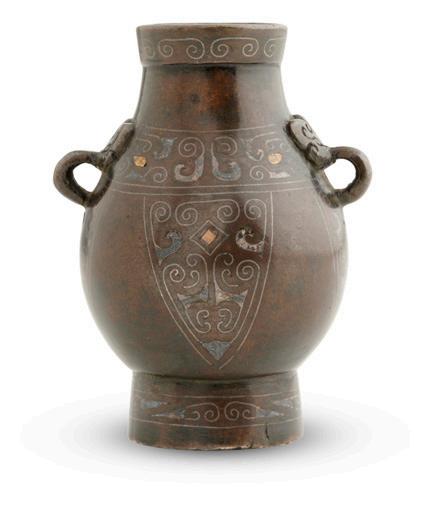
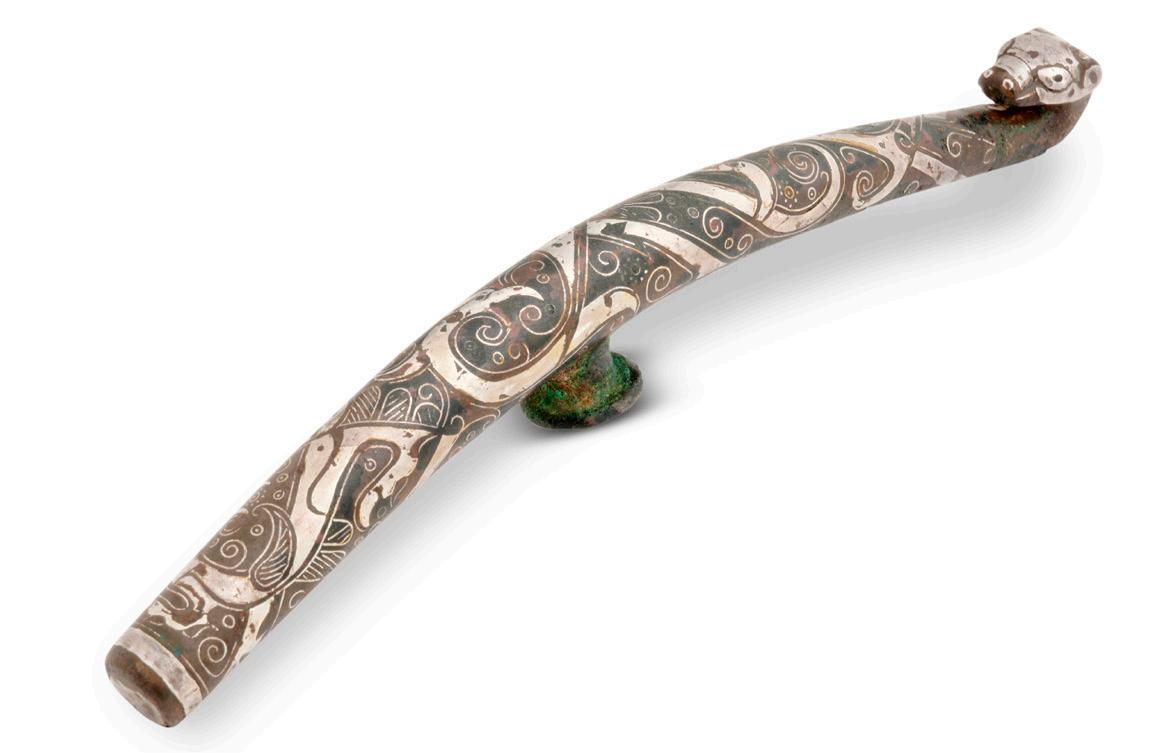
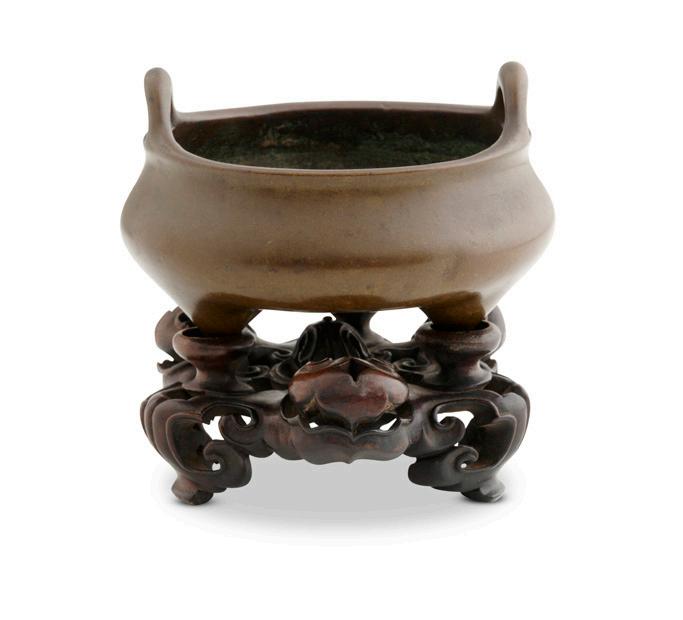

277
A CHINESE PARCEL GILT SILVER VASE AND COVER, POSSIBLY YUAN/MING DYNASTY OR LATER
The vase is decorated with flowering branches, grapevines, birds, and mythical beasts.
36cm high; weight: 987g
$6,000-8,000
元/明或以後 局部鎏金銀瓶連蓋
278
A CHINESE BRONZE CENSER, XUANDE MARK, 17TH/18TH CENTURY
The censer is finely cast with a pair of bixie handles, Xuande six-character cast mark to the base.
15cm wide; 7.5cm high
$2,000-3,000
十七 / 十八世紀 「大明宣德年製」款 銅螭耳香爐
279
A LARGE CHINESE BRONZE CENSER, XUANDE MARK,18TH CENTURY
With an old fitted carved wood stand. 40cm wide; 17cm high
provenance
An important private collection from an old Toorak family, thence by descent.
$3,000-5,000
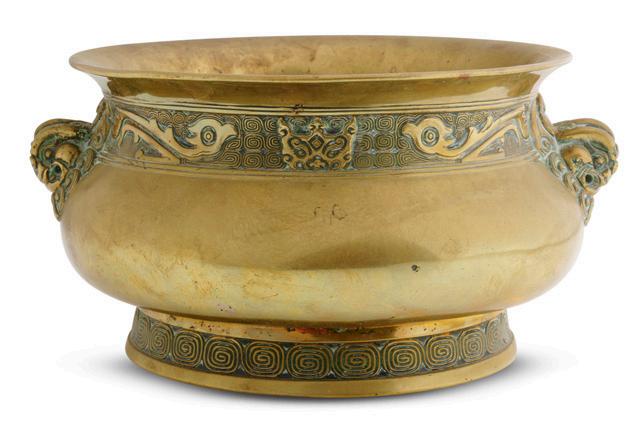

十七/十八世紀 「大明宣德年製」款 銅香爐 源流:
墨尔本图拉克重要老家族递藏。
280
A LARGE CHINESE BRONZE CENSER, XUANDE MARK, 17TH/18TH CENTURY
With an old wood stand. 29cm wide; 15.3cm high
provenance
An important private collection from an old Toorak family, thence by descent.
$2,000-3,000
十七世紀 「大明宣德年製」 款 獸首銅香爐
281
A CHINESE BRONZE TRIPOD CENSER WITH FITTED WOODEN STAND, XUANDE MARK, 17TH/18TH CENTURY
With a carved fitted wood stand.
12.2cm wide; 7.8cm high
$2,000-3,000
十七/十八世紀 宣德款 銅三足香爐 配木底座
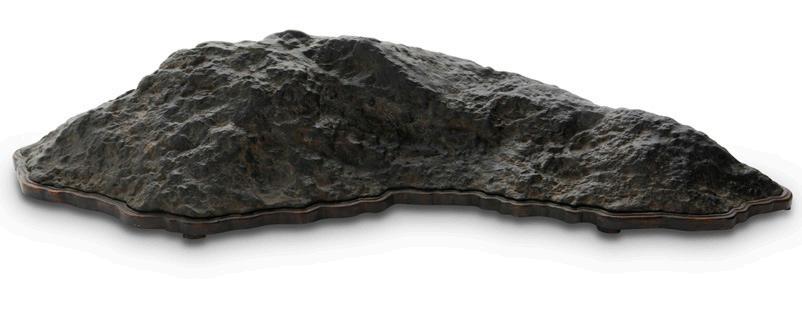
282
A CHINESE LINGBI SCHOLAR’S ROCK, LATE QING DYNASTY, LATE 19TH/EARLY 20TH CENTURY
50.5cm wide; 10.5cm high
$1,000-2,000
清末 靈璧石 文人賞石
283 A CHINESE YELLOW TAIHU SCHOLAR ROCK with fitted carved wood stand
53 x 33cm
$1,500-2,500
清 黄太湖石 文人賞石
284 A CHINESE TAIHU SCHOLAR ROCK
In an old stone square pot.
39cm high
$800-1,200
清 太湖石 文人賞石 置于旧石方盆中。
285 A LARGE CHINESE TAIHU SCHOLAR ROCK
83 x 52cm
$2,000-3,000
清 太湖石 文人賞石
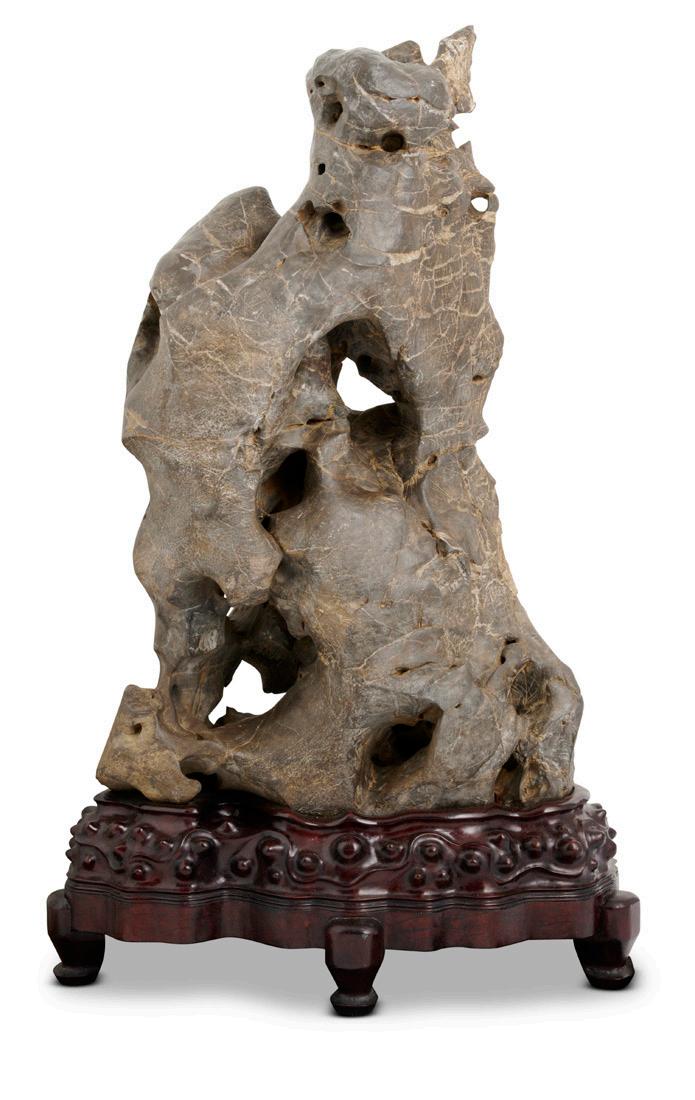
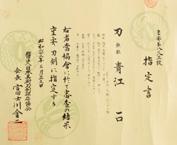
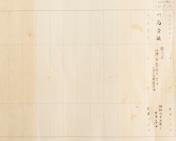
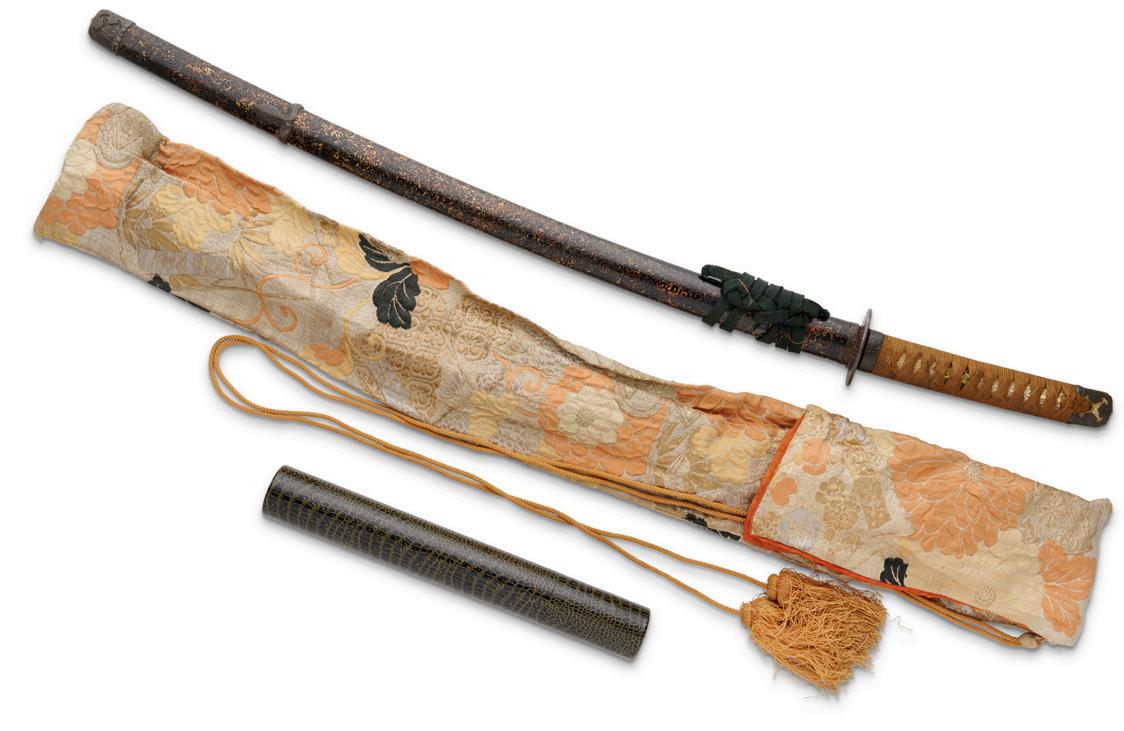
286
A JAPANESE KATANA ATTRIBUTED TO THE AOE SCHOOL, KAMAKURA/NAMBOKUCHO PERIOD, 14TH CENTURY, Unsigned, Designated Important Sword (Juyo Token), 25 March 1987 (Showa 62), 33rd Designation
A fine shinogi-zukuri katana with iori-mune and slender proportions, displaying a gentle curvature and a chu-kissaki. The hada is a well-textured itame with a slight mixture of mokume, over which a clear utsuri is visible.
The hamon is a calm suguha enlivened with small gunome, with ashi extending into the ha. The nie are fine and bright, imparting a misty quality (nioigachi). The boshi is a shallow notare, tending towards yakitsume-gokoro with a slight kaeri.
Both sides of the blade are carved with a bo-hi, running through to the tang. The nakago is o-suriage with a flat kirijiri end, three mekugi-ana, and no visible file marks.
The swordsmiths of Bitchu Province thrived under the region’s renowned iron production, a tradition sustained by abundant smelting sites. This blade, attributed to the late Kamakura period Aoe school, reflects the transition from earlier Ko-Aoe works towards a more refined style. The restrained suguha tempered line, suffused with nioi-gachi, exemplifies the elegant and highly polished workmanship characteristic of the Aoe tradition at its peak. Designated an Important Sword (Juyo Token) in 1987, this katana stands as an outstanding representative of the school’s late Kamakura output.
Accompanied by a certificate of registration as Juyo Token [Important Sword], no. 88 issued by the Nihon Bijutsu Token Hozon Kyokai [Society for the Preservation of the Japanese Art Sword], dated Showa 62 (1987).
Nagasa (blade length): 69.9 cm
Sori (curvature): 1.8 cm
Moto-haba (width at base): 2.7 cm
Saki-haba (width at tip): 1.8 cm
Kissaki length: 2.8 cm
Nakago (tang) length: 20.0 cm
Nakago curvature: approx. 0.1 cm
provenance
An important privation collection, Tasmania.
exhibitions
Samurai Gallery Australia, Cairns, QLD.
other notes
Important Sword Designation Certificate No. 88
Katana, unsigned, attributed to Aoe
Quantity: 1 piece
Measurements:
Length: 69.9 cm
Curvature: 1.8 cm
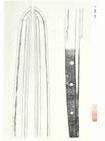
Description:
A shinogi-zukuri katana with iori-mune (peaked back), slightly narrow body, gentle curvature, and chu-kissaki (medium point).
Forging pattern (hada): itame with slight mokume mixture, with well-textured surface and clear utsuri (tempering shadow).
Temper pattern (hamon): chu-suguha with slight kogunome mixed in, ashi extending into the ha, bright ko-nie attached.
Tip (boshi): shallow notare, yakitsume-gokoro (nearly ending without turnback), with slight kaeri.
Carving (horimono): bo-hi (grooves) carved through on both sides.
Tang (nakago): o-suriage (greatly shortened), kirijiri (cut-off tip), three mekugi-ana (peg holes).
Based on the results of our examination, this sword is hereby designated as an Important Sword (Juyo Token).
Dated: March 25, 1987 (Showa 62)
The Society for the Preservation of Japanese Art Swords (NBTHK)
Chairman: Fujishiro Matsuo
$55,000-85,000
鎌倉 十四世紀 青江派作品(傳)日本武士刀 附:日本刀剑协会证书,重要日本武士刀,证书 号:88,1987年3月25日。
287
A PAIR OF JAPANESE BRONZE LARGE CENSERS AND COVERS ON STANDS, MEIJI PERIOD (1868-1912)
each 114.8cm high
provenance
A private collection, S.A.
$5,000-8,000
日本 明治時期 銅太平有象大香爐一對
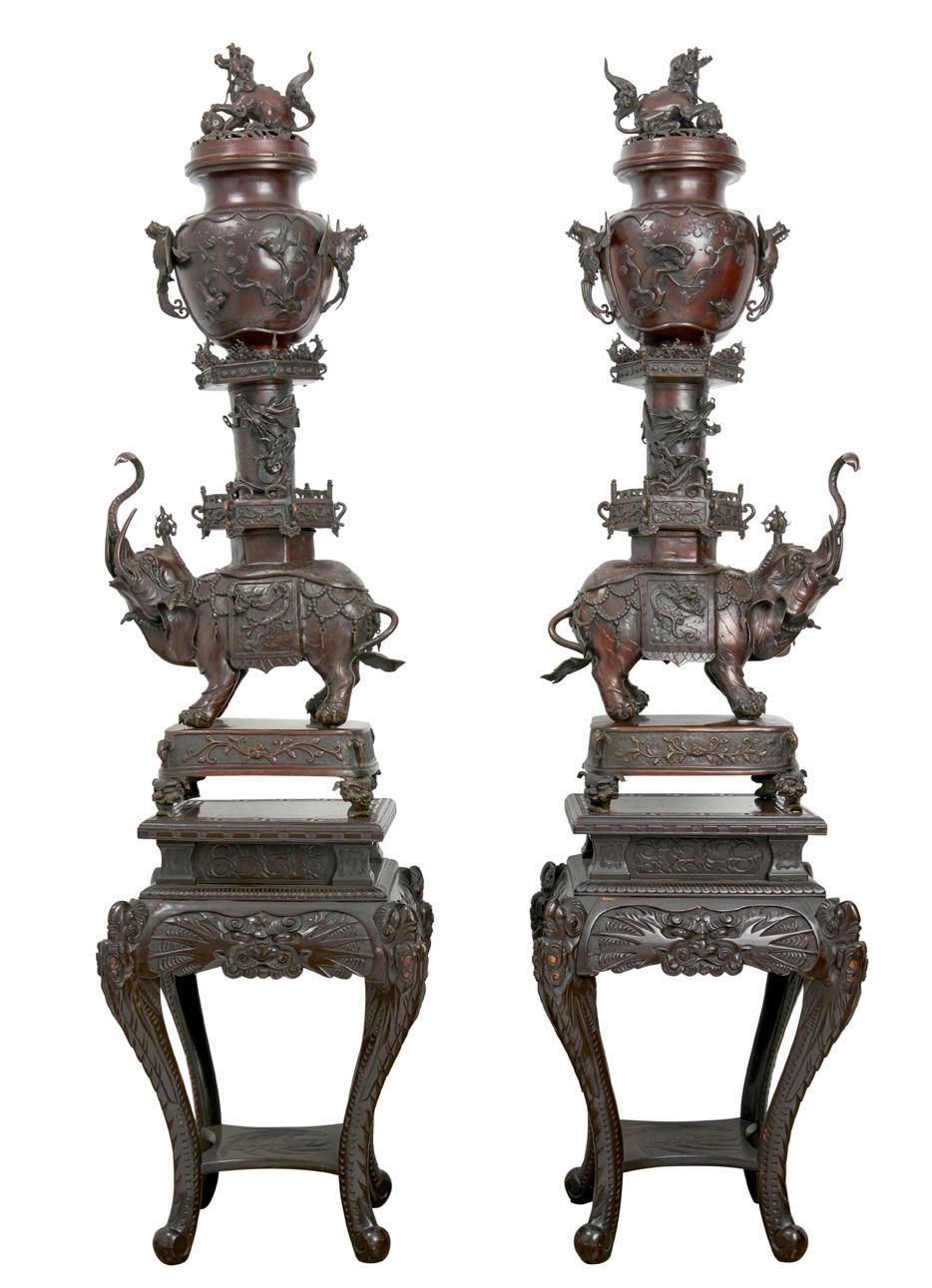

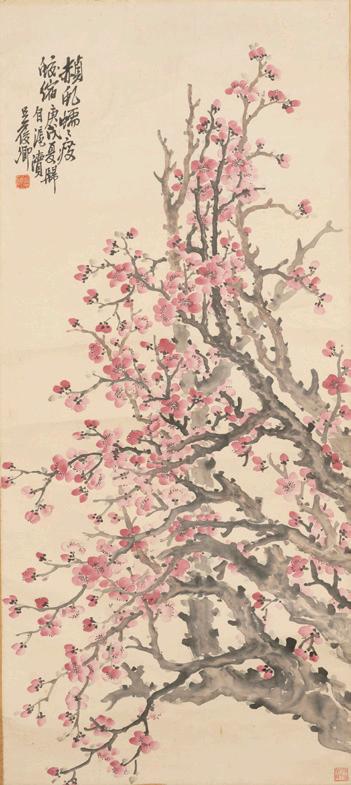
288
ATTRIBUTED TO JIANG TINGXI (1669 - 1732)
Bird and Flower
Ink and colour on silk, hanging scroll
Inscribed and signed Qingtongjushi, with three seals of the artist
Title-slip inscribed with two seals of the collector
196 x 45cm
provenance
Yan Chuqian (inscription on label)
Yan Chuqian (1900-1978) was a Chinese plant morphologist and educator. From 1929 to 1932 he pursued graduate studies in biology at the University of Chicago, where he received both his Master’s and Doctoral degrees. He later served as Professor at Beijing Normal University, Yunnan University, and Xiamen University. This scroll was possibly acquired during his tenure at Yunnan University.
$3,000-5,000
傳 蔣廷錫 花鳥設色絹本 立軸 款識:檀心罄口道家風,雅稱慈門十八公,掩映茶 花紅似錦,鴛班獨立許誰同。青桐居士。 鈐印:蔣廷錫印、朝朝染翰、青桐軒 題簽:(嚴楚江, 1900-1978 )蔣廷錫南沙畫屏, 六之一。一九五二年得於昆明。楚江。鈴印:君 白、嚴楚江印
源流:
嚴楚江(題簽)
嚴楚江( 1900-1978 ),中國植物形態學家、教育 家。 1929 年至 1932 年在於芝加哥大學攻讀生物學研 究生,獲得碩士、博士。曾任北京師範大學教授, 雲南大學教授,廈門大學教授。此卷或於其雲南大 學時期購於當地。
289
WU CHANGSHUO (1844 - 1927)
Plum Blossoms
Ink and colour on paper, mounted for framing
Inscribed and signed Wu Junqing, with one seal of the artist, and a collector’s seal
Dated gengxu year 1910
128 x 56.5cm
provenance
Formerly in the collection of Tianjin Cultural Relics Company (recorded in Guantang Bique catalogue). Guantang Bique, Beijing, 11 January 2017, lot 138. Beijing Ginza Auctions, Beijing, 19 December 2020, lot 258.
Formerly in the collection of Li Bowen, renowned Hong Kong collector and philanthropist.
$30,000-50,000
吳昌碩 山梅圖 設色紙本 鏡心 一九一零年作 款識:赪虯蠕蠕瘦蛟縮。庚戌 ( 1910 )夏歸自滬 瀆。吳俊卿。 鈐印:倉碩 藏印:(李博文)順德日升堂藏 源流:
天津市文物公司舊藏(观唐皕榷圖錄記載) 观唐皕榷,北京, 2017 年 1 月 11 日,拍品 138 號 北京銀座拍賣,北京, 2020 年 12 月 19 日,拍品 258 號 香港著名收藏家,慈善家李博文舊藏。
290
ATTRIBUTED TO PU RU (1896 - 1963) AND PU JINGQIU
Vase and Flowers
Ink and colour on paper, hanging scroll Inscribed and signed, with two red seals of the artists. Overall: 228.5 x 51.6cm ; Painting: 91.5 x 34.5cm
provenance
A private collection, Melbourne.
other notes
Pu Ru (1896-1963), a Manchu native of Beijing, was a modern master of Chinese painting. His fame in painting was such that he was paired with the Sichuan painter Zhang Daqian as “Zhang of the South and Pu of the North,” and likewise with Wu Hufan as “Wu of the South and Pu of the North.” Pu Ru styled himself Xin She and also adopted the sobriquets Xihuang Shangren (“Man of Xi Huang”) and Xishan Yishi (“Hermit of the Western Hills”). Born into the imperial family, he was a greatgrandson of Prince Gong Yixin, the sixth son of the Daoguang Emperor, and belonged to the Aisin Gioro clan.
Pu Jingqiu (dates unknown), also known by the sobriquet Song Ying, was a member of the Qing imperial clan and the younger sister of Pu Jin, commonly referred to as the “Fifteenth Aunt.” Along with Pu Ru and Pu Jin, she was an important painter of the Beijing-Tianjin school during the Republican period. She specialized in meticulous depictions of insects, particularly butterflies, executed in the gongbi style. Her works are admired for their graceful charm and lively spirit.
$8,000-12,000
傳溥儒 / 溥婧秋 設色紙本 立軸 款識:於雪齋兄慶视此古瓷心禽兄臨之鬆穎女史靖 秋輔花卉并題。西山逸士溥儒戲寫古瓷。
鈐印:溥儒之印;婧秋書畫 備註:
溥儒( 1896-1963 ),满族,北京人。现代国画大 师,曾以画名与蜀人张大千并称 “ 南张北溥 ” ;又 与吴湖帆并称 “ 南吴北溥 ” 。溥儒字心畲,又号羲 皇上人、西山逸士。出身皇室,他是道光皇帝第六 子恭亲王奕欣的次孙,姓爱新觉罗。 2 、溥靖秋( 生卒不详),号松颖,清宗室,乃溥伒之妹,人 称 “ 十五姑 ” 。与溥儒、溥伒等俱为民国京津画派 重要画家,擅工笔草虫,尤精于画蝶。作品韵致娴 静,生趣盎然。
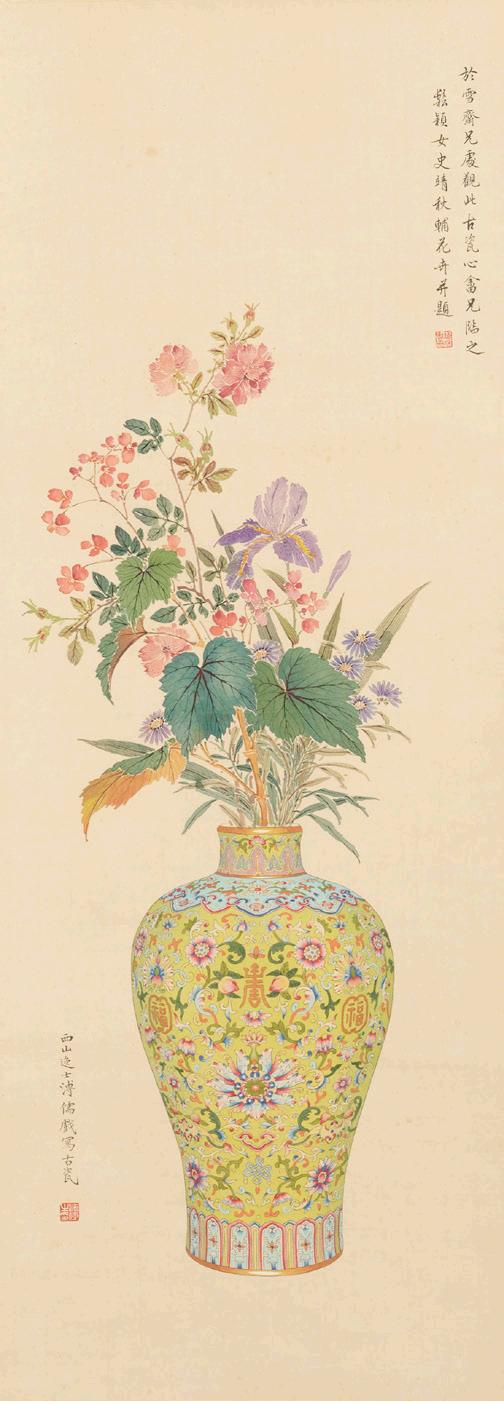
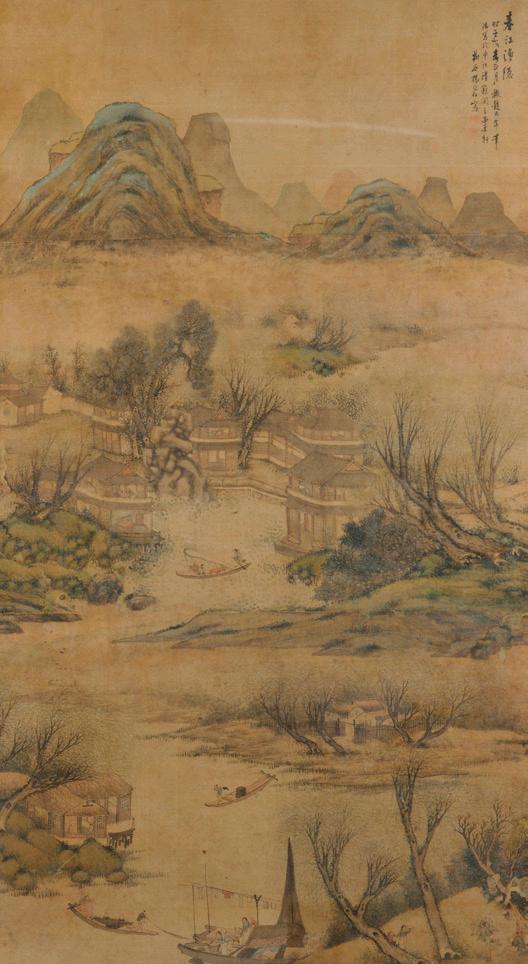
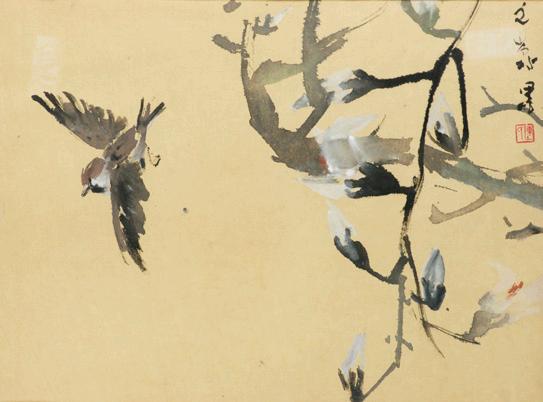
291
A LARGE CHINESE FRAMED INK AND COLOUR PAINTING BY YANG NIANBO, QING DYNASTY
Spring River Fishing Hermit
Hanging scroll, ink and color on silk, Inscribed, signed and two red seals of the artist. Painting of the same artist, ink and colour on paper, sold at Christie’s New York, 10 Sep. 2019, lot 34. 170 x 105cm (Overall with the frame); 138.3 x 76.5cm (painting)
$1,000-2,000
清 楊念伯 春江漁隱 設色絹本,立軸,帶框 題識,簽名,鈐印:楊念伯、柳谷
292
CHEN WEN HSI (SINGAPORE, 1906-1991) Sparrows and Bamboo Ink and colour on paper, framed Signed and one red seal of the artist.
53.5 x 43cm
provenance
East and West Art Gallery, Melbourne. A private collection, Melbourne.
$3,000-5,000
陳文希 (新加坡,1906-1991) 麻雀與竹 設色紙本 帶框 題識:文希水墨 鈐印:陳 源流: 墨爾本私人收藏,早年購自東西畫廊。
293
ATTRIBUTED TO DING FUZHI (1879 - 1949)
Summer Fruits
Ink and colour on paper, mounted fan, framed
Inscribed and signed He Lu, with five red seals
Dated Renwu year, April 1942
Overall: 63.5 x 38.5cm; Fan: 56 x 31cm
provenance
A private collection, Melbourne.
$2,500-3,500
傳丁輔之 設色紙本 扇面帶框 1942 年 4 月作 款識:寫出髯蘇好詩句,不教風味粲蠻鄉。壬午年 四月芒種節。鶴廬寫。
鈐印:輔之,輔之之印 等
294
GAO MADE (1917 - 2007)
The Peony Pavilion -Dream in the Garden Ink and colour on paper, framed
Inscribed and signed Made, with six read seals of the artist
Dated to Gengwu year, 1990.
Overall: 87.5 x 47.8cm; Painting: 65.5 x 25.5cm
provenance
A private collection, Melbourne.
$2,000-3,000
高马得 牡丹亭遊園驚夢 設色紙本 帶框 1990 年 春作
款識,鈐印。
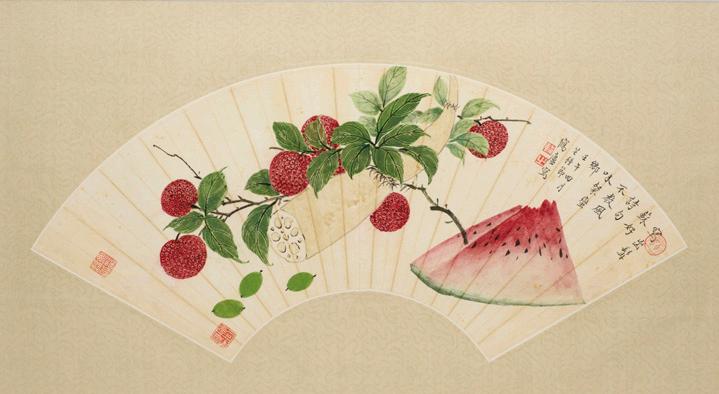
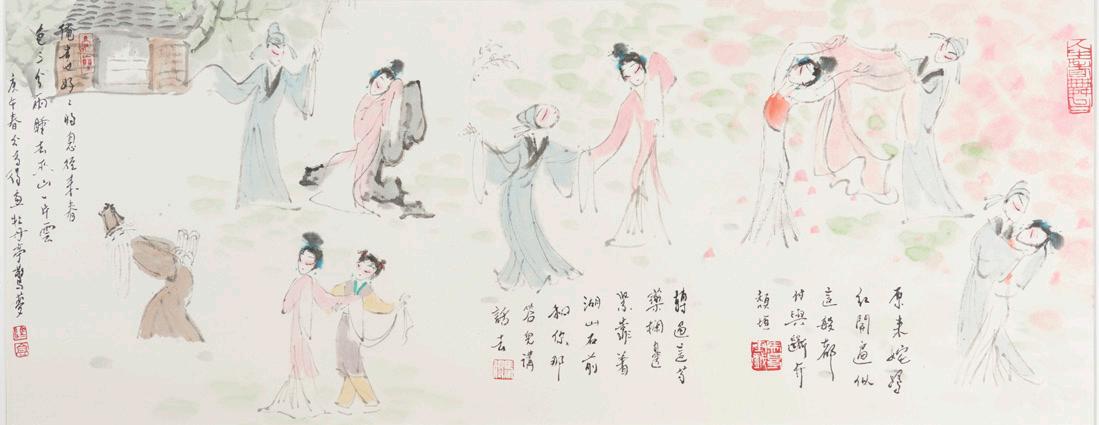

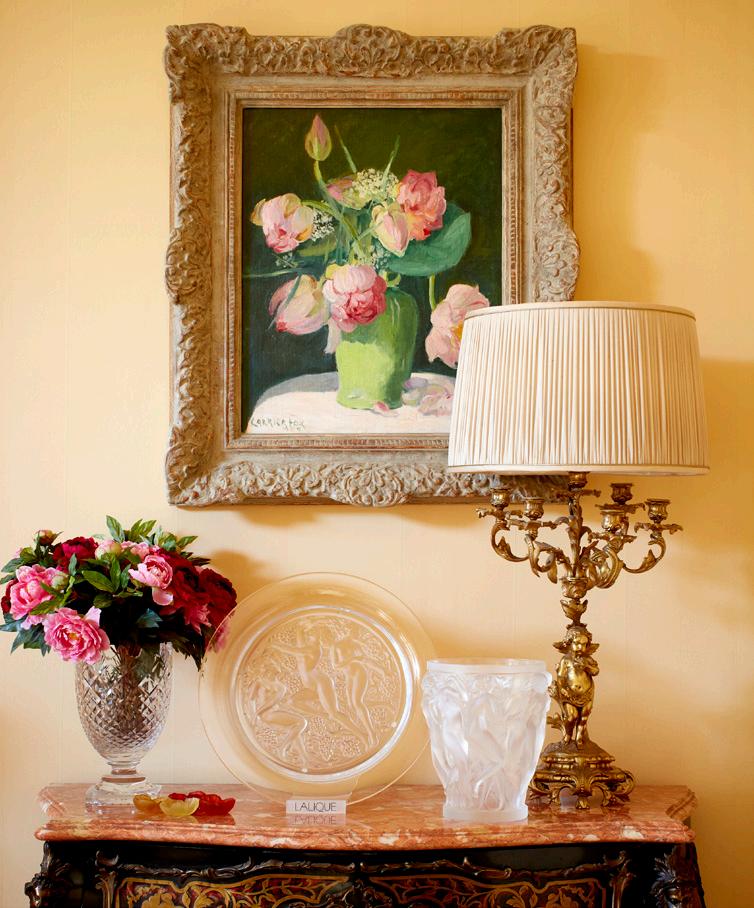
Conditions of Business / Summary
sPecial conditions of sale – jewellerY
Jewellery and watches offered by Leonard Joel are sometimes accompanied by an Independent valuation as stated in the catalogue. These valuations are conducted by registered valuers and are offered purely as independent opinions. Variation may be found as to the colour, clarity and size of stones described in these reports, consequently Leonard Joel does not guarantee these Independent Valuations. Where stones can be weighed accurately, weights will be provided. Weights of set stones are estimates only and are provided to the best of our technical ability. Gram weight on gold and other precious metals are also given as an approximation. Wristwatches and pocket watches are offered in there current condition and Leonard Joel does not guarantee that they are in working order. Items may be thoroughly inspected during the viewing period or by prior arrangement.
authenticitY certificates
As various manufacturers may not issue certificates of authenticity, Leonard Joel has no obligation to furnish a buyer with a certificate of authenticity from the manufacturer, except where specifically noted in the catalogue. Unless Leonard Joel is satisfied that it should cancel the sale in accordance with the Limited Warranty provided in the General Conditions of Business, the failure of a manufacturer to issue a certificate will not constitute grounds for cancellation of the sale.
gst
In the event that the vendor is registered for Goods & Services Tax (GST), the invoice to the buyer will provide a separate entry for the GST which is included in the purchase price. All Leonard Joel charges for services referred to in this catalogue are exclusive of GST. Overseas buyers may be entitled to a rebate for GST charged.
For further information contact: Ety Liong accounts@leonardjoel.com.au
adMission
Leonard Joel has the right at its sole discretion without assigning any reason therefore to refuse admission to the premises or attendance at any of its sales of any person.
coMMission (absentee) bids
Leonard Joel will execute absentee bids when instructed. Lots will be bought as cheaply as allowed by other bids and/or reserves.
telePhone bidding
Buyers interested in bidding by telephone should contact Leonard Joel as soon as possible. Please note that telephone bidding facilities are available on a first-come, first-served basis.
bidder registration
To recognise bidders during the sale all intending buyers are required to complete a Bidder Registration Form providing full photo identification and appropriate references if required before the Sale which will enable them to bid by way of a numbered paddle allocated to them.
buYer’s PreMiuM
There will be a buyer’s premium added to all purchases.The buyer’s premium will be calculated at the rate of 25% of the hammer price on each lot. This is inclusive of GST. The buyer’s premium is reflected by a reduction in the Seller’s Commission and is a common practice throughout Australia and overseas.
ProPertY subject to the artist resale roYaltY Lots with the § sign will be subject to payment of the Artist Resale Royalty in the event that the lot is sold for a hammer price of $1,000 or more. The Australian Resale Royalty is a flat rate of 5 percent (5%) levy on the hammer price (including GST). The Australian Resale Royalty is payable by the buyer in addition to the buyer’s premium plus applicable GST.
daMage
Any viewer who damages a Lot will be held liable for all damage caused and shall reimburse Leonard Joel for all costs and expenses relating to rectification of such damage.
title
Leonard Joel guarantees good title to all lots.
warranties and condition rePorts
Condition reports will be available for any lot upon request, subject to conditions.
estiMates
Estimates are a reflection of Leonard Joel’s opinion of the current market values, based on historic and current market realisations of similar lots. Estimates are inclusive of any GST, which may be applicable. Actual prices at this sale may fall short or exceed the estimates.
PaYMent
In any event accounts must be settled with Leonard Joel no later than 4pm two days after the auction. Attention is specifically drawn to condition 22 of the Buyer’s Conditions of Sale.
Payment may be made by way of cheque, most credit cards, eftpos or telegraphic transfer.
Please note: payments made by cheque are subject to a 5 day clearance before goods can be collected.
Credit card fees may apply.
Bank telegraph transfers should be directed to: account name: Leonard Joel Pty Ltd
address: Westpac Banking Corporation
150 Collins Street, Melbourne
VIC 3000 Australia
bsb: 033–364
account no: 942956
collection of lots
Purchased lots must be collected no later than two days after the auction; otherwise lots shall be moved to storage at the Buyer’s expense (see below). Lots are at the Buyer’s risk from the fall of the hammer. It is strongly advised that overseas and interstate purchasers and absentee bidders make their arrangements with Leonard Joel in advance of the Sale. Charges are outlined below and are quoted in Australian dollars.
reMoval and storage
Any lots not collected within two days after the auction, may be stored or resold at the Buyer’s expense.
reMoval charges
Each lot: $55
storage charges
Each lot: $33 per day
Protection of Movable cultural heritage act 1986 (PMch act)
Buyers should be aware of the PMCH Act which protects Australia’s heritage of movable cultural objects and supports foreign countries’ right to protect their heritage of movable cultural objects. The PMCH Act regulates the export of nationally significant heritage objects, it is not intended to restrict normal and legitimate trade in cultural property, and does not affect an individual’s right to own or sell objects, within Australia. The PMCH Act was enacted in response to the 1970 UNESCO Convention on the Means of Prohibiting the Illicit Import, Export and Transfer of Ownership of Cultural Property. It is the responsibility of the Buyer to ensure that the export of any lots purchased are not subject to, or in breach of, this Act.
Information about the PMCH Act, the Protection of Movable Cultural Heritage Regulations 1987 and the 1970 UNESCO Convention, can be found on the Department of the Environment, Water, Heritage and the Arts website at: www.environment.gov.au/heritage/movable/index
exPorting significant australian cultural heritage
The export of Australia’s significant cultural heritage is regulated under the Protection of Movable Cultural Heritage Act 1986 (PMCH Act.) It is not intended to restrict normal and legitimate trade in cultural property and does not affect an individual’s right to own or sell within Australia. The PMCH Act implements a system of export permits for certain heritage objects defined as ‘Australian protected objects’. More information is available on the Department of the Environment, Water Heritage and the Arts’ website: www.arts.gov.au/movable_heritage Enquiries can be made to the Cultural Property Section at the Department of the Environment, Water, Heritage and the Arts, T: 02 6274 1810 E: movable.heritage@environment.gov.au
cites regulations
It is the buyer’s sole responsibility to comply with all export and import regulations relating to your purchases and also to obtain any relevant export and/or import licences. The refusal of any import or export licences, any delay in obtaining such licences or any limitation on your ability to export a lot shall not permit the cancellation of the sale. Please note that all lots marked with the symbol * are subject to CITES regulations when exporting these items outside of Australia. Information about these regulations may be found at www.environment.gov.au/biodiversity/tradeuse/cites/index.html or may be requested from:
The Director International Wildlife Trade Department of Sustainability, Environment, Water, Population and Communities
GPO Box 787
CANBERRA ACT 2601
leonard hoMe deliverY
Purchases can be delivered to your door via Leonard Home Delivery. Please note this service is available in Melbourne (Select suburbs) only and is not available for Sydney auction purchases. For any enquiries about this service please contact delivery@ leonardjoel.com.au
recoMMended carriers
For recommended carriers please refer to our website.
This document has been produced to international environmental management standard ISO14001 by Ellikon Fine Printers, a certified green printing company.
Our Specialists
Managing Director & hea D
of iMportant collections
John Albrecht, BA LLB MBA
fine art
Wiebke Brix, Head of Art
Amanda North, Senior Art Specialist
Hannah Ryan, Senior Art Specialist, Manager of Specialty Auctions
Charlotte Barrett, Administrator and Registrar
Decorative arts
Chiara Curcio BA, Head of Department
David Parsons, Head of Private Estates and Valuations, Decorative Arts Specialist
Kyle Walker, Administrator and Coordinator
asian art
Luke Guan MLitt, Head of Department
Cenche Zoe, Curator & Senior Specialist
Kyle Walker, Administrator and Coordinator
sy Dney
Ronan Sulich, Senior Adviser
Madeleine Mackenzie BFA, BComm, MLitt, Head of Decorative Arts & Art
Ella Nail, Office Manager & Administrator
iMportant jewels
Hamish Sharma, Head of Department, Sydney
fine jewels & tiMepieces
Bethany McGougan, Head of Department, Melbourne
Patricia Kontos F.G.A.A., Senior Timepieces & Jewellery Specialist
Lauren Boustridge BSc, AJP, GG (GIA), Senior Specialist, Sydney
Phoebe East, Jewellery Assistant
Piper Jiang, Jewellery & Luxury Administrator
John D'Agata, Senior Jewellery Consultant
Henrietta Maiyah, Consultant
M o Dern Design
Rebecca Stormont, Specialist
Maya Loughnan, Assistant
luxury
Julia Gueller, Specialist
prints
Hannah Ryan, Senior Art Specialist
furniture
Natasha Berlizova, Manager
Angus McGougan, Assistant
Alex Sargeant, Assistant
Inigo Fleming, Assistant
Shawn Mitchell , Interiors Consultant
jewellery
Phoebe East, Manager
Anna Akacich, Assistant
art salon
Millie Lewis, Manager
Jane Goh, Assistant
objects & collectables
Dominic Kavanagh MFA, Manager
Kieran Grogan Carpenter, Assistant
valuations
David Parsons, Head of Private Estates and Valuations, Decorative Arts Specialist
Troy McKenzie, Head of Private Collections, Queensland
Anthony Hurl, Representative Specialist, South Australia
John Brans, Representative Specialist, Western Australia
accounts
Ety Liong, Finance Manager
Michelle Draper, Accounts Manager
Ninad Chouhan , Finance & Accounts Assistant
client services
Kim Clarke, Saleroom & Office Manager
Amelia Lewis, Client Services Liaison
Richard Grieve, Client Services Liaison
operations & logistics
David Price, Operations, Delivery & Logistics Manager
M arketing & co MM unications
Lucy Lewis, Marketing, Media, & Communications Manager
Kyle Walker, Marketing & Database Coordinator
photography
Paolo Cappelli, Senior Photographer & Videographer
Adam Obradovic, Photographer & Videographer
graphic Design
Maria Rossi

Melbourne 2 Oxley Road, Hawthorn, VIC 3122 03 9826 4333
sY dne Y
The Bond, 36-40 Queen Street, Woollahra, NSW 2025 02 9362 9045
brisbane 54 Vernon Terrace, Teneriffe, QLD 4005 0412 997 080
adelaide 429 Pulteney Street, Adelaide SA 5000 0419 838 841
Perth 0412 385 555
info@leonardjoel.com.au leonardjoel.com.au
